Organic Light-emitting Device
Kim; Mikyung ; et al.
U.S. patent application number 16/140200 was filed with the patent office on 2019-03-28 for organic light-emitting device. The applicant listed for this patent is Samsung Display Co., Ltd.. Invention is credited to Mikyung Kim, Kwanhee Lee, Jino Lim, Jihyun Seo, Seunggak Yang.
| Application Number | 20190097140 16/140200 |
| Document ID | / |
| Family ID | 63642911 |
| Filed Date | 2019-03-28 |
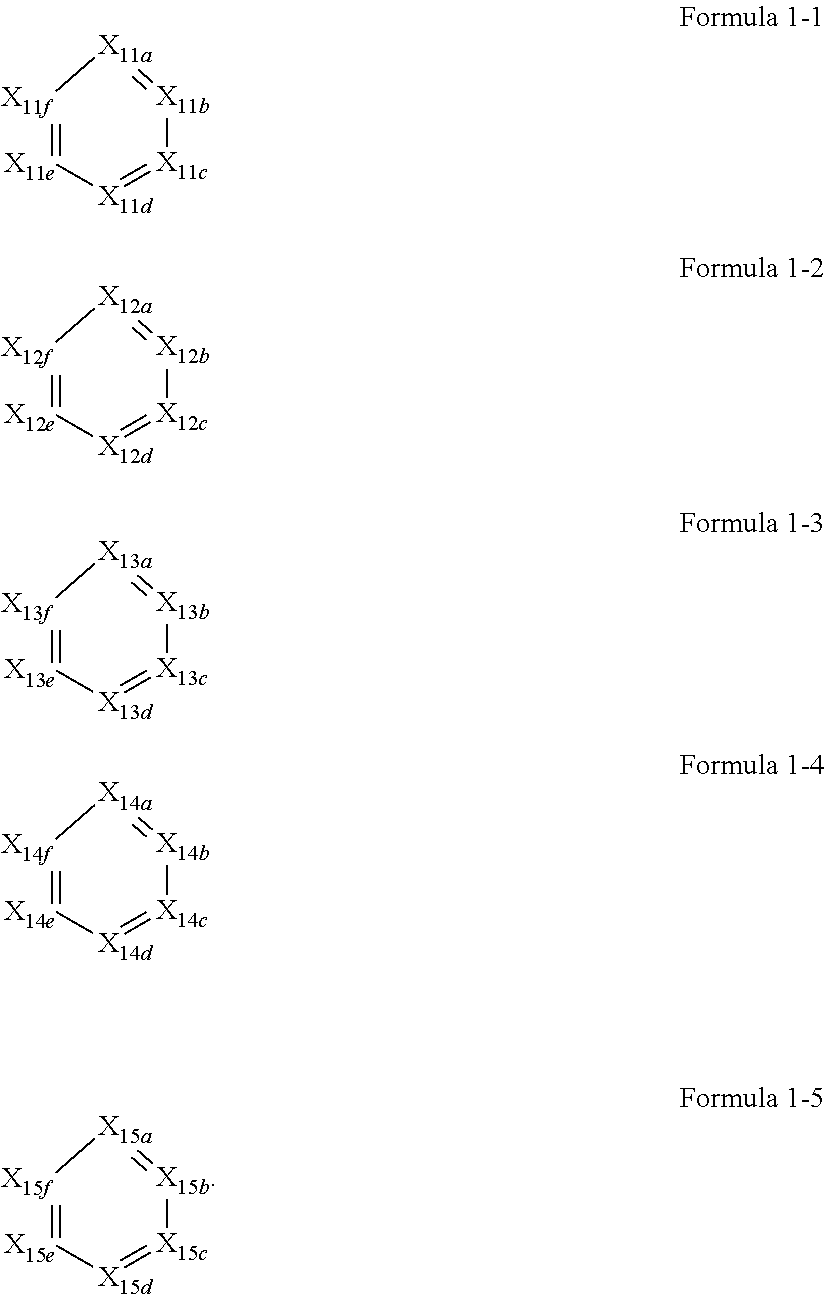
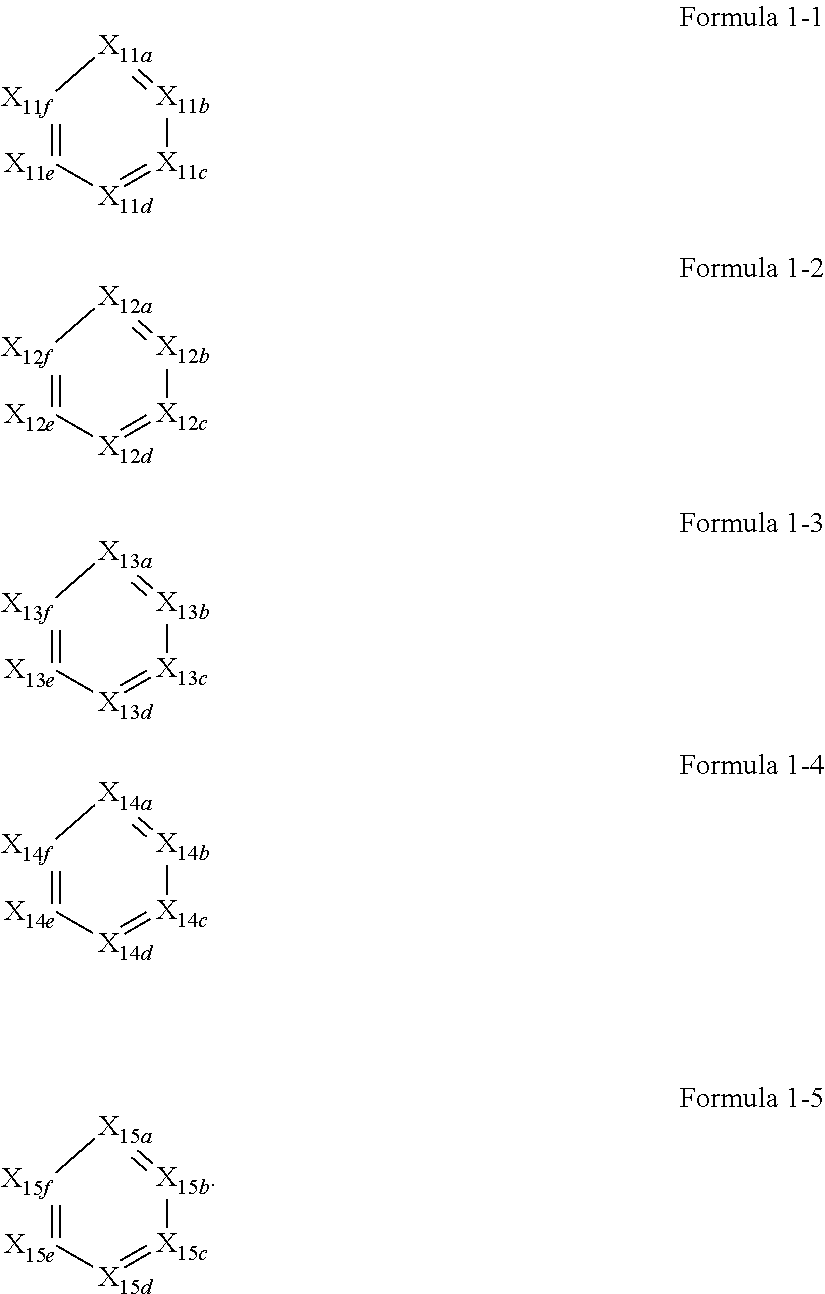

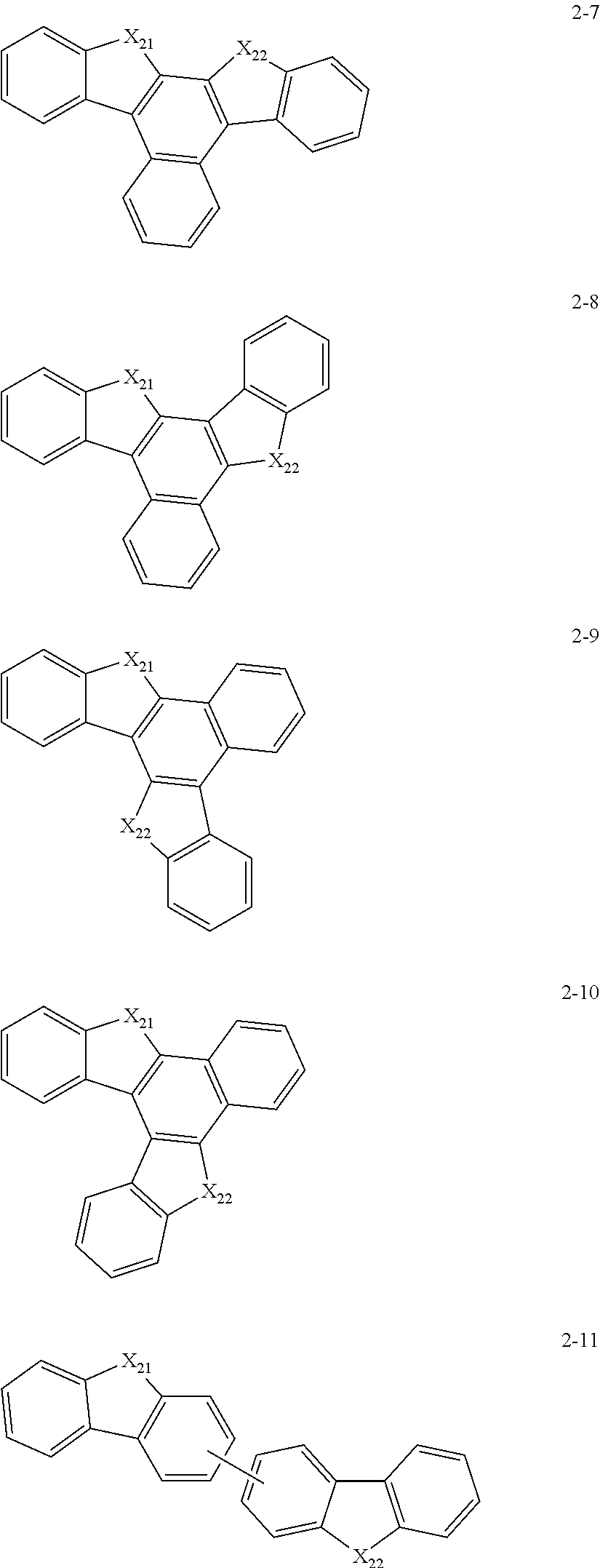
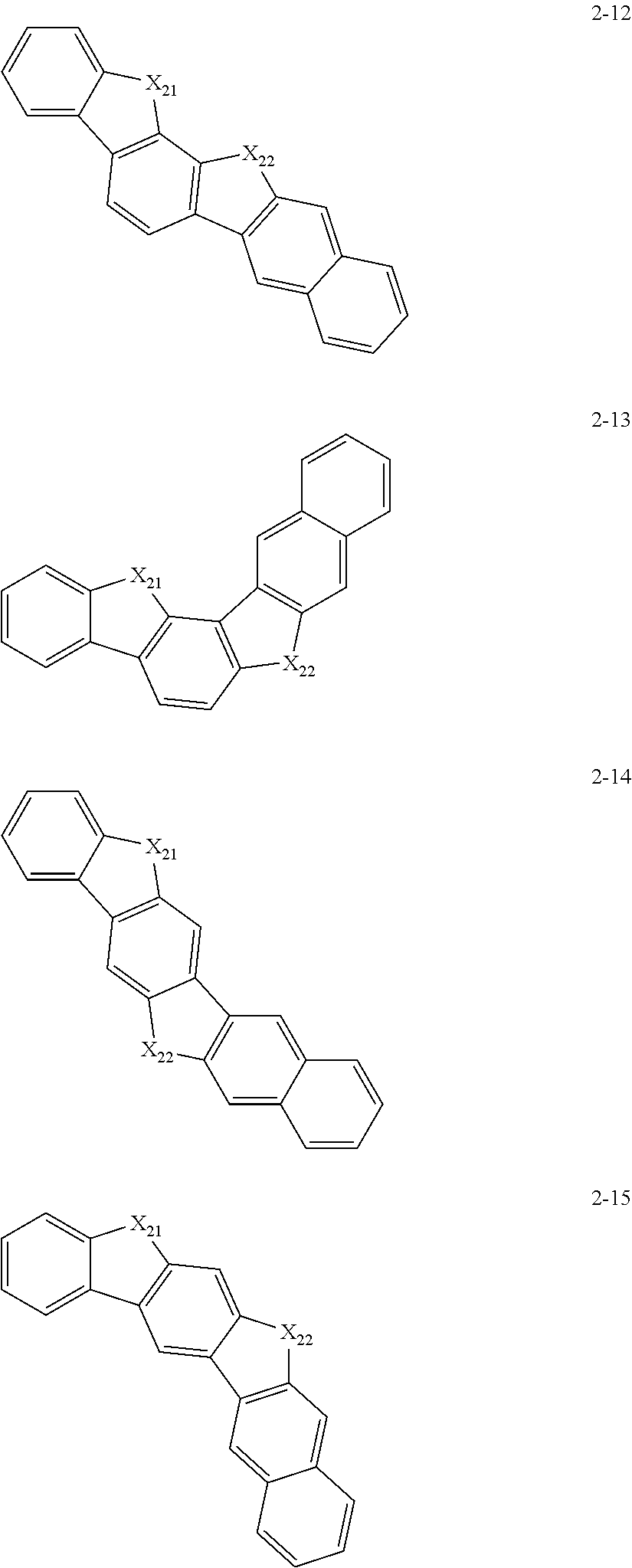
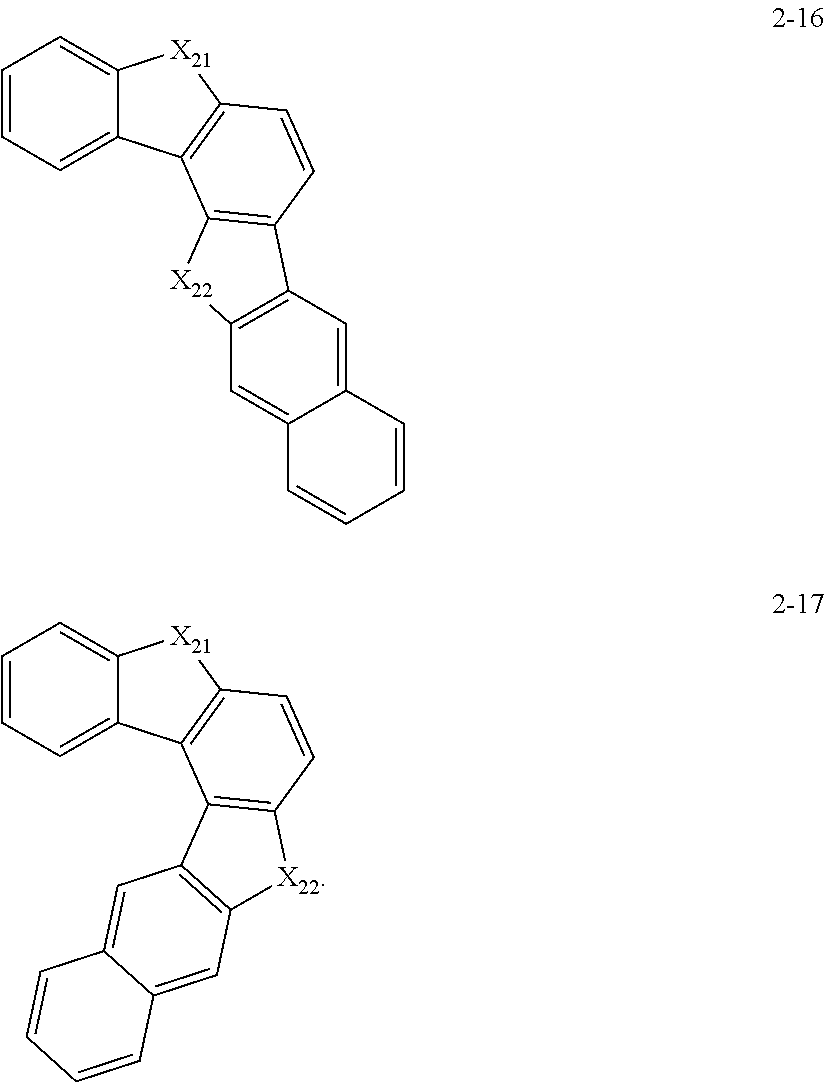

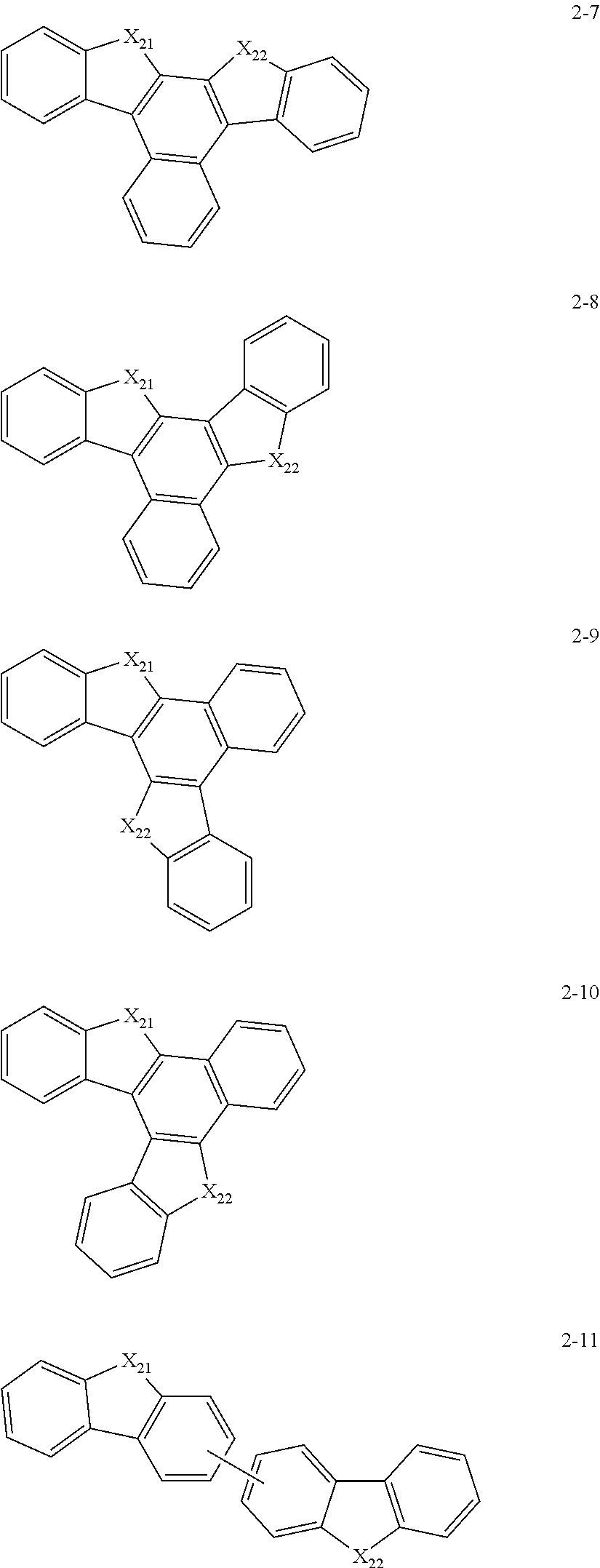
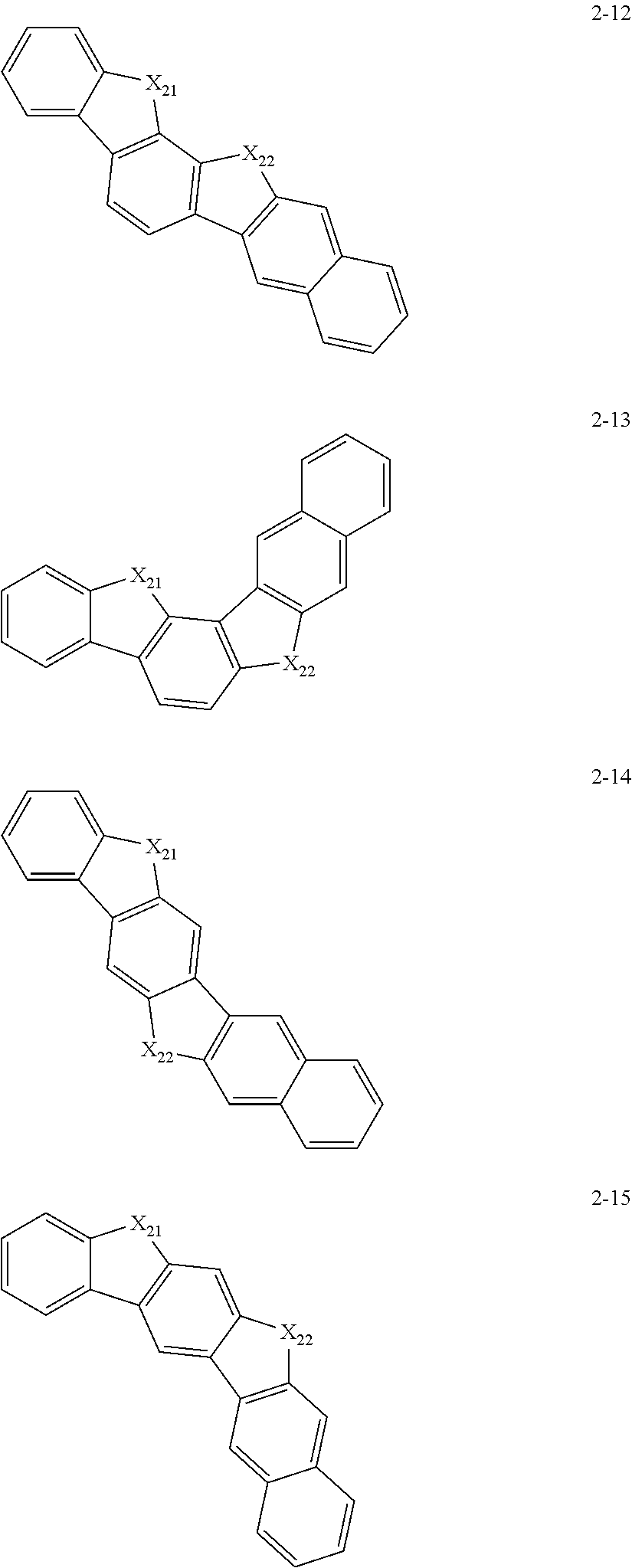
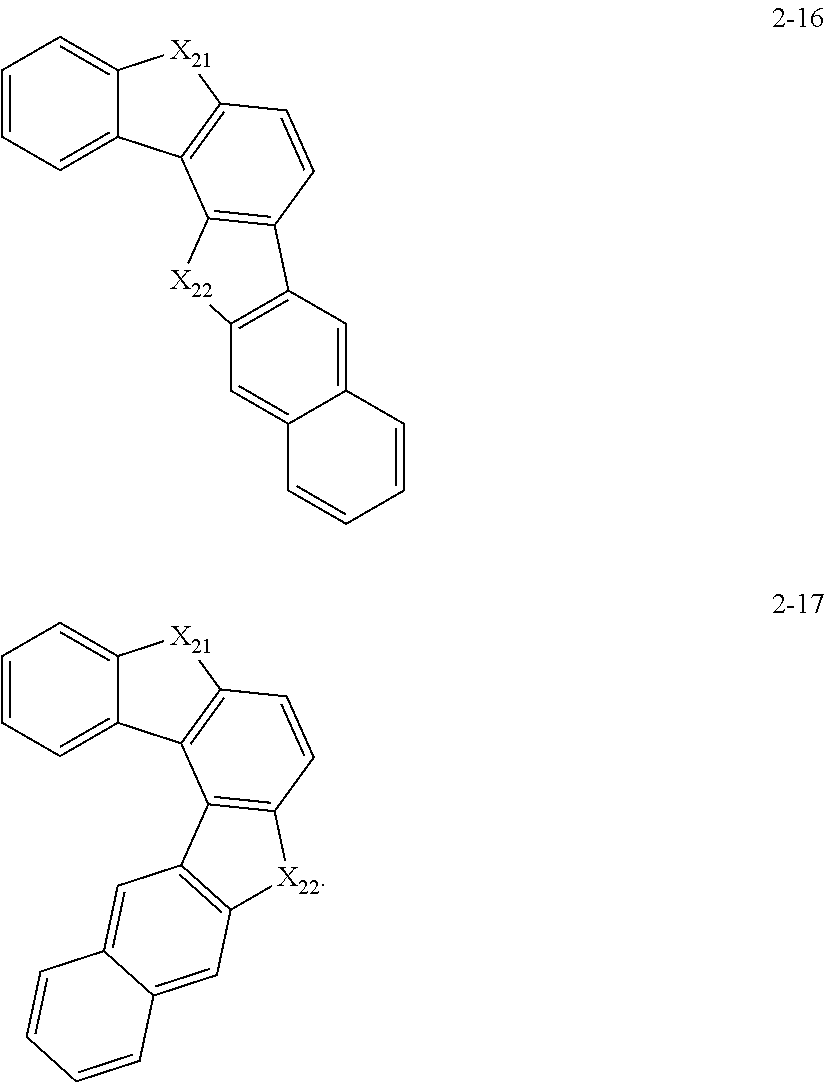

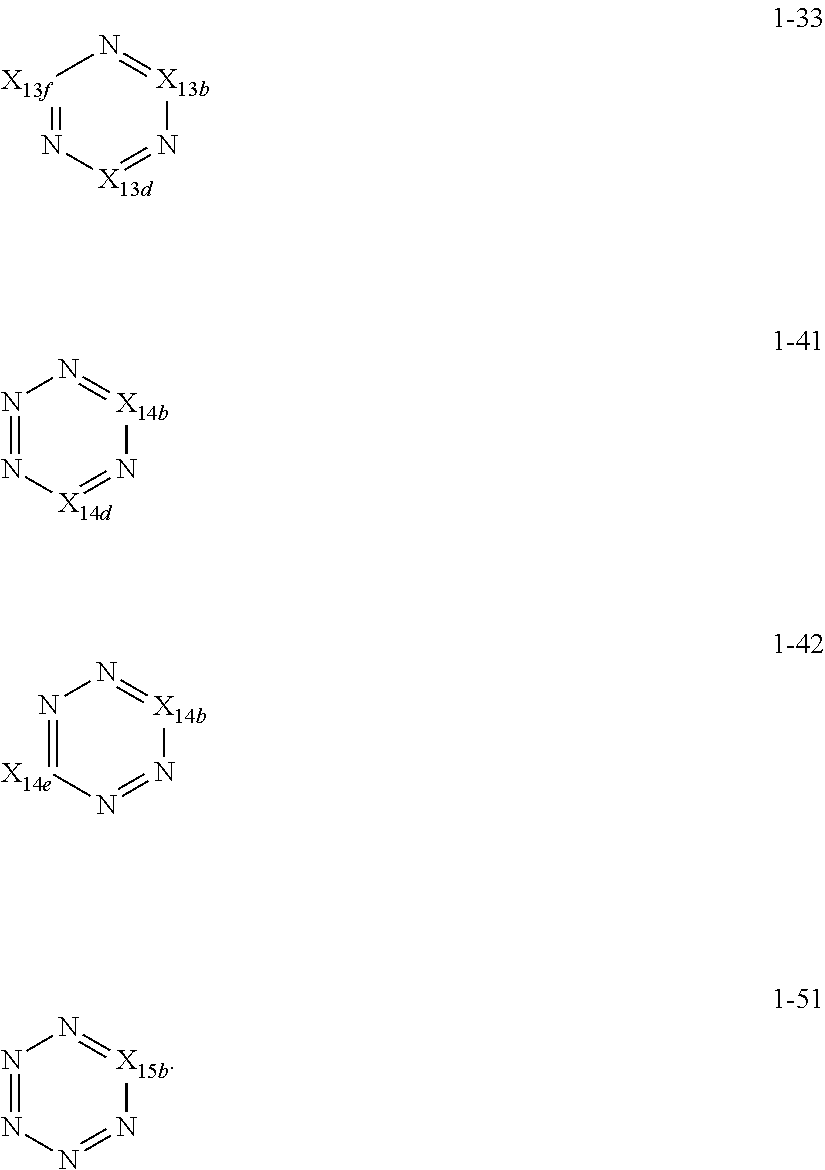
View All Diagrams
| United States Patent Application | 20190097140 |
| Kind Code | A1 |
| Kim; Mikyung ; et al. | March 28, 2019 |
ORGANIC LIGHT-EMITTING DEVICE
Abstract
An organic light-emitting device is provided. The organic light-emitting device includes: a first electrode; a second electrode; and an organic layer between the first electrode and the second electrode and including an emission layer, the organic layer including a first compound, a second compound, and a third compound. The first compound, the second compound, and the third compound are each independently an azine-based compound represented by one selected from Formulae 1-1 to 1-5, except for a case where the first compound, the second compound, and the third compound concurrently include an azine-based compound represented by Formula 1-3.
| Inventors: | Kim; Mikyung; (Yongin-si, KR) ; Seo; Jihyun; (Yongin-si, KR) ; Yang; Seunggak; (Yongin-si, KR) ; Lee; Kwanhee; (Yongin-si, KR) ; Lim; Jino; (Yongin-si, KR) | ||||||||||
| Applicant: |
|
||||||||||
|---|---|---|---|---|---|---|---|---|---|---|---|
| Family ID: | 63642911 | ||||||||||
| Appl. No.: | 16/140200 | ||||||||||
| Filed: | September 24, 2018 |
| Current U.S. Class: | 1/1 |
| Current CPC Class: | H01L 51/5024 20130101; H01L 51/5056 20130101; C07D 401/14 20130101; C07D 491/048 20130101; H01L 51/0072 20130101; H01L 51/0058 20130101; H01L 51/0073 20130101; C07D 213/06 20130101; C07D 403/14 20130101; H01L 51/5092 20130101; C07D 209/88 20130101; H01L 51/0071 20130101; C07D 251/24 20130101; H01L 51/5072 20130101; H01L 51/5221 20130101; C07D 401/04 20130101; C07D 333/76 20130101; H01L 51/5012 20130101; H01L 51/5096 20130101; C07D 239/26 20130101; C07D 401/12 20130101; C07D 235/18 20130101; H01L 51/0067 20130101; C07D 401/10 20130101; H01L 51/5206 20130101; C07D 471/04 20130101; H01L 51/0074 20130101; C07D 403/04 20130101; C07D 403/10 20130101; C07D 209/86 20130101; C07D 213/22 20130101; C07D 405/12 20130101; C07D 307/91 20130101; C07D 495/04 20130101; C07D 487/04 20130101 |
| International Class: | H01L 51/00 20060101 H01L051/00; H01L 51/50 20060101 H01L051/50; H01L 51/52 20060101 H01L051/52 |
Foreign Application Data
| Date | Code | Application Number |
|---|---|---|
| Sep 26, 2017 | KR | 10-2017-0124530 |
| Aug 10, 2018 | KR | 10-2018-0093994 |
Claims
1. An organic light-emitting device comprising: a first electrode; a second electrode; and an organic layer between the first electrode and the second electrode and comprising an emission layer, wherein the organic layer comprises a first compound, a second compound, and a third compound, and the first compound, the second compound, and the third compound are each independently an azine-based compound represented by one selected from Formulae 1-1 to 1-5, except for a case where the first compound, the second compound, and the third compound concurrently include an azine-based compound represented by Formula 1-3: ##STR00098## wherein, in Formulae 1-1 to 1-5, X.sub.11a is selected from N and C[(L.sub.11a).sub.a11a-R.sub.11a]; X.sub.11b is selected from N and C[(L.sub.11b).sub.a11b-R.sub.11b]; X.sub.11c is selected from N and C[(L.sub.11c).sub.a11c-R.sub.11c]; X.sub.11d is selected from N and C[(L.sub.11d).sub.a11d-R.sub.11d]; X.sub.11e is selected from N and C[(L.sub.11e).sub.a11e-R.sub.11e]; X.sub.11f is selected from N and C[(L.sub.11f).sub.a11f-R.sub.11f]; and one of X.sub.11a to X.sub.11f is N, X.sub.12a is selected from N and C[(L.sub.12a).sub.a12a-R.sub.12a]; X.sub.12b is selected from N and C[(L.sub.12b).sub.a12b-R.sub.12b]; X.sub.12c is selected from N and C[(L.sub.12c).sub.a12c-R.sub.12c]; X.sub.12d is selected from N and C[(L.sub.12d).sub.a12d-R.sub.12d]; X.sub.12e is selected from N and C[(L.sub.12e).sub.a12e-R.sub.12e]; X.sub.12f is selected from N and C[(L.sub.12f).sub.a12f-R.sub.12f]; and two of X.sub.12a to X.sub.12f are N, X.sub.13a is selected from N and C[(L.sub.13a).sub.a13a-R.sub.13a]; X.sub.13b is selected from N and C[(L.sub.13b).sub.a13b-R.sub.13b]; X.sub.13c is selected from N and C[(L.sub.13c).sub.a13c-R.sub.13c]; X.sub.13d is selected from N and C[(L.sub.13d).sub.a13d-R.sub.13d]; X.sub.13e is selected from N and C[(L.sub.13e).sub.a13e-R.sub.13e]; X.sub.13f is selected from N and C[(L.sub.13f).sub.a13f-R.sub.13f]; and three of X.sub.13a to X.sub.13f are N, X.sub.14a is selected from N and C[(L.sub.14a).sub.a14a-R.sub.14a]; X.sub.14b is selected from N and C[(L.sub.14b).sub.a14b-R.sub.14b]; X.sub.14c is selected from N and C[(L.sub.14c).sub.a14c-R.sub.14c]; X.sub.14d is selected from N and C[(L.sub.14d).sub.a14d-R.sub.14d]; X.sub.14e is selected from N and C[(L.sub.14e).sub.a14e-R.sub.14e]; X.sub.14f is selected from N and C[(L.sub.14f).sub.a14f-R.sub.14f]; and four of X.sub.14a to X.sub.14f are N, X.sub.15a is selected from N and C[(L.sub.15a).sub.a15a-R.sub.15a]; X.sub.15b is selected from N and C[(L.sub.15b).sub.a15b-R.sub.15b]; X.sub.15c is selected from N and C[(L.sub.15c).sub.a15c-R.sub.15c]; X.sub.15d is selected from N and C[(L.sub.15d).sub.a15d-R.sub.15d]; X.sub.15e is selected from N and C[(L.sub.15e).sub.a15e-R.sub.15e]; X.sub.15f is selected from N and C[(L.sub.15f).sub.a15f-R.sub.15f]; and five of X.sub.15a to X.sub.15f are N, L.sub.11a to L.sub.11f, L.sub.12a to L.sub.12f, L.sub.13a to L.sub.13f, L.sub.14a to L.sub.14f, and L.sub.15a to L.sub.15f are each independently selected from: a C.sub.3-C.sub.10 cycloalkenylene group, a C.sub.1-C.sub.10 heterocycloalkenylene group, a C.sub.6-C.sub.60 arylene group, a C.sub.1-C.sub.60 heteroarylene group, a divalent non-aromatic condensed polycyclic group, and a divalent non-aromatic condensed heteropolycyclic group; and a C.sub.3-C.sub.10 cycloalkenylene group, a C.sub.1-C.sub.10 heterocycloalkenylene group, a C.sub.6-C.sub.60 arylene group, a C.sub.1-C.sub.60 heteroarylene group, a divalent non-aromatic condensed polycyclic group, and a divalent non-aromatic condensed heteropolycyclic group, each substituted with at least one selected from deuterium, --F, --Cl, --Br, --I, a hydroxyl group, a cyano group, a nitro group, an amino group, an amidino group, a hydrazine group, a hydrazone group, a carboxylic acid group or a salt thereof, a sulfonic acid group or a salt thereof, a phosphoric acid group or a salt thereof, a C.sub.1-C.sub.20 alkyl group, a C.sub.1-C.sub.20 alkoxy group, a C.sub.3-C.sub.10 cycloalkyl group, a C.sub.1-C.sub.10 heterocycloalkyl group, a C.sub.3-C.sub.10 cycloalkenyl group, a C.sub.1-C.sub.10 heterocycloalkenyl group, a C.sub.6-C.sub.30 aryl group, a C.sub.6-C.sub.30 aryloxy group, a C.sub.6-C.sub.30 arylthio group, a C.sub.1-C.sub.30 heteroaryloxy group, a C.sub.1-C.sub.30 heteroarylthio group, a monovalent non-aromatic condensed polycyclic group, a monovalent non-aromatic condensed heteropolycyclic group, a pyrrolyl group, a thiophenyl group, a furanyl group, an imidazolyl group, a pyrazolyl group, a thiazolyl group, an isothiazolyl group, an oxazolyl group, an isoxazolyl group, a pyridinyl group, a pyrazinyl group, a pyrimidinyl group, a pyridazinyl group, an isoindolyl group, an indolyl group, an indazolyl group, a purinyl group, a quinolinyl group, an isoquinolinyl group, a benzoquinolinyl group, a phthalazinyl group, a naphthyridinyl group, a quinoxalinyl group, a quinazolinyl group, a cinnolinyl group, a carbazolyl group, a phenanthridinyl group, an acridinyl group, a phenanthrolinyl group, a phenazinyl group, a benzimidazolyl group, a benzofuranyl group, a benzothiophenyl group, an isobenzothiazolyl group, a benzoxazolyl group, an isobenzoxazolyl group, a triazolyl group, a tetrazolyl group, an oxadiazolyl group, a dibenzofuranyl group, a dibenzothiophenyl group, a benzocarbazolyl group, a dibenzocarbazolyl group, a thiadiazolyl group, and an imidazopyridinyl group, wherein L.sub.11a to L.sub.11f, L.sub.12a to L.sub.12f, L.sub.13a to L.sub.13f, L.sub.14a to L.sub.14f, and L.sub.15a to L.sub.15f are not each independently selected from: a triazinylene group; and a triazinylene group substituted with at least one selected from deuterium, --F, --Cl, --Br, --I, a hydroxyl group, a cyano group, a nitro group, an amino group, an amidino group, a hydrazine group, a hydrazone group, a carboxylic acid group or a salt thereof, a sulfonic acid group or a salt thereof, a phosphoric acid group or a salt thereof, a C.sub.1-C.sub.20 alkyl group, a C.sub.1-C.sub.20 alkoxy group, a C.sub.3-C.sub.10 cycloalkyl group, a C.sub.1-C.sub.10 heterocycloalkyl group, a C.sub.3-C.sub.10 cycloalkenyl group, a C.sub.1-C.sub.10 heterocycloalkenyl group, a C.sub.6-C.sub.30 aryl group, a C.sub.6-C.sub.30 aryloxy group, a C.sub.6-C.sub.30 arylthio group, a C.sub.1-C.sub.30 heteroaryloxy group, a C.sub.1-C.sub.30 heteroarylthio group, a monovalent non-aromatic condensed polycyclic group, a monovalent non-aromatic condensed heteropolycyclic group, a pyrrolyl group, a thiophenyl group, a furanyl group, an imidazolyl group, a pyrazolyl group, a thiazolyl group, an isothiazolyl group, an oxazolyl group, an isoxazolyl group, a pyridinyl group, a pyrazinyl group, a pyrimidinyl group, a pyridazinyl group, an isoindolyl group, an indolyl group, an indazolyl group, a purinyl group, a quinolinyl group, an isoquinolinyl group, a benzoquinolinyl group, a phthalazinyl group, a naphthyridinyl group, a quinoxalinyl group, a quinazolinyl group, a cinnolinyl group, a carbazolyl group, a phenanthridinyl group, an acridinyl group, a phenanthrolinyl group, a phenazinyl group, a benzimidazolyl group, a benzofuranyl group, a benzothiophenyl group, an isobenzothiazolyl group, a benzoxazolyl group, an isobenzoxazolyl group, a triazolyl group, a tetrazolyl group, an oxadiazolyl group, a dibenzofuranyl group, a dibenzothiophenyl group, a benzocarbazolyl group, a dibenzocarbazolyl group, a thiadiazolyl group, and an imidazopyridinyl group, a11a to a11f, a12a to a12f, a13a to a13f, a14a to a14f, and a15a to a15f are each independently selected from 0, 1, 2, 3, and 4, R.sub.11a to R.sub.11f, R.sub.12a to R.sub.12f, R.sub.13a to R.sub.13f, R.sub.14a to R.sub.14f, and R.sub.15a to R.sub.15f are each independently selected from: hydrogen, deuterium, --F, --Cl, --Br, --I, a methyl group, an ethyl group, an n-propyl group, an isopropyl group, an n-butyl group, an isobutyl group, a sec-butyl group, a tert-butyl group, a methoxy group, an ethoxy group, an n-propoxy group, an isopropoxy group, an n-butoxy group, an isobutoxy group, a sec-butoxy group, and a tert-butoxy group; a methyl group, an ethyl group, an n-propyl group, an isopropyl group, an n-butyl group, an isobutyl group, a sec-butyl group, and a tert-butyl group, each substituted with at least one selected from deuterium, --F, --Cl, --Br, and --I; a phenyl group, a biphenyl group, a terphenyl group, a naphthyl group, a fluorenyl group, a carbazolyl group, a dibenzofuranyl group, a dibenzothiophenyl group, a pyridinyl group, a pyrimidinyl group, a quinolinyl group, an isoquinolinyl group, a quinoxalinyl group, a quinazolinyl group, a benzofuropyridinyl group, a benzothienopyridinyl group, a benzofuropyrimidinyl group, a benzothienopyrimidinyl group, a monovalent non-aromatic condensed polycyclic group, and a monovalent non-aromatic condensed heteropolycyclic group; a phenyl group, a biphenyl group, a terphenyl group, a naphthyl group, a fluorenyl group, a carbazolyl group, a dibenzofuranyl group, a dibenzothiophenyl group, a pyridinyl group, a pyrimidinyl group, a quinolinyl group, an isoquinolinyl group, a quinoxalinyl group, a quinazolinyl group, a benzofuropyridinyl group, a benzothienopyridinyl group, a benzofuropyrimidinyl group, a benzothienopyrimidinyl group, a monovalent non-aromatic condensed polycyclic group, and a monovalent non-aromatic condensed heteropolycyclic group, each substituted with at least one selected from deuterium, --F, --Cl, --Br, --I, a methyl group, an ethyl group, an n-propyl group, an isopropyl group, an n-butyl group, an isobutyl group, a sec-butyl group, a tert-butyl group, a methoxy group, an ethoxy group, an n-propoxy group, an isopropoxy group, an n-butoxy group, an isobutoxy group, a sec-butoxy group, a tert-butoxy group, a phenyl group, a biphenyl group, a terphenyl group, a naphthyl group, a fluorenyl group, a carbazolyl group, a dibenzofuranyl group, a dibenzothiophenyl group, a pyridinyl group, a pyrimidinyl group, a quinolinyl group, an isoquinolinyl group, a quinoxalinyl group, a quinazolinyl group, a benzofuropyridinyl group, a benzothienopyridinyl group, a benzofuropyrimidinyl group, and a benzothienopyrimidinyl group; and a phenyl group, a biphenyl group, a terphenyl group, a naphthyl group, a fluorenyl group, a carbazolyl group, a dibenzofuranyl group, a dibenzothiophenyl group, a pyridinyl group, a pyrimidinyl group, a quinolinyl group, an isoquinolinyl group, a quinoxalinyl group, a quinazolinyl group, a benzofuropyridinyl group, a benzothienopyridinyl group, a benzofuropyrimidinyl group, a benzothienopyrimidinyl group, a monovalent non-aromatic condensed polycyclic group, and a monovalent non-aromatic condensed heteropolycyclic group, each substituted with at least one selected from a methyl group, an ethyl group, an n-propyl group, an isopropyl group, an n-butyl group, an isobutyl group, a sec-butyl group, a tert-butyl group, a phenyl group, a biphenyl group, a terphenyl group, a naphthyl group, a fluorenyl group, a carbazolyl group, a dibenzofuranyl group, a dibenzothiophenyl group, a pyridinyl group, a pyrimidinyl group, a quinolinyl group, an isoquinolinyl group, a quinoxalinyl group, a quinazolinyl group, a benzofuropyridinyl group, a benzothienopyridinyl group, a benzofuropyrimidinyl group, and a benzothienopyrimidinyl group that are each substituted with at least one selected from deuterium, --F, --Cl, --Br, and --I, and neighboring atoms of R.sub.11a to R.sub.11f, neighboring atoms of R.sub.12a to R.sub.12f, neighboring atoms of R.sub.13a to R.sub.13f, neighboring atoms of R.sub.14a to R.sub.14f, and/or neighboring atoms of R.sub.15a to R.sub.15f optionally form a saturated ring or an unsaturated ring.
2. The organic light-emitting device of claim 1, wherein: L.sub.11a to L.sub.11f, L.sub.12a to L.sub.12f, L.sub.13a to L.sub.13f, L.sub.14a to L.sub.14f, and L.sub.15a to L.sub.15f are each independently selected from: a phenylene group, a pentalenylene group, an indenylene group, a naphthylene group, an azulenylene group, a heptalenylene group, an indacenylene group, an acenaphthylene group, a fluorenylene group, a spiro-fluorenylene group, a benzofluorenylene group, a dibenzofluorenylene group, a phenalenylene group, a phenanthrenylene group, an anthracenylene group, a fluoranthenylene group, a triphenylenylene group, a pyrenylene group, a chrysenylene group, a naphthacenylene group, a picenylene group, a perylenylene group, a pentaphenylene group, a hexacenylene group, a pentacenylene group, a rubicenylene group, a coronenylene group, an ovalenylene group, a pyrrolylene group, a thiophenylene group, a furanylene group, an imidazolylene group, a pyrazolylene group, a thiazolylene group, an isothiazolylene group, an oxazolylene group, an isoxazolylene group, a pyridinylene group, a pyrazinylene group, a pyrimidinylene group, a pyridazinylene group, an isoindolylene group, an indolylene group, an indazolylene group, a purinylene group, a quinolinylene group, an isoquinolinylene group, a benzoquinolinylene group, a phthalazinylene group, a naphthyridinylene group, a quinoxalinylene group, a quinazolinylene group, a cinnolinylene group, a carbazolylene group, a phenanthridinylene group, an acridinylene group, a phenanthrolinylene group, a phenazinylene group, a benzimidazolylene group, a benzofuranylene group, a benzothiophenylene group, an isobenzothiazolylene group, a benzoxazolylene group, an isobenzoxazolylene group, a triazolylene group, a tetrazolylene group, an oxadiazolylene group, a dibenzofuranylene group, a dibenzothiophenylene group, a benzofuropyridinylene group, a benzothienopyridinylene group, a benzofuropyrimidinylene group, a benzothienopyrimidinylene group, a benzocarbazolylene group, and a dibenzocarbazolylene group; and a phenylene group, a pentalenylene group, an indenylene group, a naphthylene group, an azulenylene group, a heptalenylene group, an indacenylene group, an acenaphthylene group, a fluorenylene group, a spiro-fluorenylene group, a benzofluorenylene group, a dibenzofluorenylene group, a phenalenylene group, a phenanthrenylene group, an anthracenylene group, a fluoranthenylene group, a triphenylenylene group, a pyrenylene group, a chrysenylene group, a naphthacenylene group, a picenylene group, a perylenylene group, a pentaphenylene group, a hexacenylene group, a pentacenylene group, a rubicenylene group, a coronenylene group, an ovalenylene group, a pyrrolylene group, a thiophenylene group, a furanylene group, an imidazolylene group, a pyrazolylene group, a thiazolylene group, an isothiazolylene group, an oxazolylene group, an isoxazolylene group, a pyridinylene group, a pyrazinylene group, a pyrimidinylene group, a pyridazinylene group, an isoindolylene group, an indolylene group, an indazolylene group, a purinylene group, a quinolinylene group, an isoquinolinylene group, a benzoquinolinylene group, a phthalazinylene group, a naphthyridinylene group, a quinoxalinylene group, a quinazolinylene group, a cinnolinylene group, a carbazolylene group, a phenanthridinylene group, an acridinylene group, a phenanthrolinylene group, a phenazinylene group, a benzimidazolylene group, a benzofuranylene group, a benzothiophenylene group, an isobenzothiazolylene group, a benzoxazolylene group, an isobenzoxazolylene group, a triazolylene group, a tetrazolylene group, an oxadiazolylene group, a dibenzofuranylene group, a dibenzothiophenylene group, a benzofuropyridinylene group, a benzothienopyridinylene group, a benzofuropyrimidinylene group, a benzothienopyrimidinylene group, a benzocarbazolylene group, and a dibenzocarbazolylene group, each substituted with at least one selected from deuterium, --F, --Cl, --Br, --I, a hydroxyl group, a cyano group, a nitro group, an amino group, an amidino group, a hydrazine group, a hydrazone group, a carboxylic acid group or a salt thereof, a sulfonic acid group or a salt thereof, a phosphoric acid group or a salt thereof, a C.sub.1-C.sub.20 alkyl group, a C.sub.1-C.sub.20 alkoxy group, a cyclopentyl group, a cyclohexyl group, a cycloheptyl group, a cyclopentenyl group, a cyclohexenyl group, a phenyl group, a pentalenyl group, an indenyl group, a naphthyl group, an azulenyl group, a heptalenyl group, an indacenyl group, an acenaphthyl group, a fluorenyl group, a spiro-fluorenyl group, a benzofluorenyl group, a dibenzofluorenyl group, a phenalenyl group, a phenanthrenyl group, an anthracenyl group, a fluoranthenyl group, a triphenylenyl group, a pyrenyl group, a chrysenyl group, a naphthacenyl group, a picenyl group, a perylenyl group, a pentaphenyl group, a hexacenyl group, a pentacenyl group, a rubicenyl group, a coronenyl group, an ovalenyl group, a pyrrolyl group, a thiophenyl group, a furanyl group, an imidazolyl group, a pyrazolyl group, a thiazolyl group, an isothiazolyl group, an oxazolyl group, an isoxazolyl group, a pyridinyl group, a pyrazinyl group, a pyrimidinyl group, a pyridazinyl group, an isoindolyl group, an indolyl group, an indazolyl group, a purinyl group, a quinolinyl group, an isoquinolinyl group, a benzoquinolinyl group, a phthalazinyl group, a naphthyridinyl group, a quinoxalinyl group, a quinazolinyl group, a cinnolinyl group, a carbazolyl group, a phenanthridinyl group, an acridinyl group, a phenanthrolinyl group, a phenazinyl group, a benzimidazolyl group, a benzofuranyl group, a benzothiophenyl group, an isobenzothiazolyl group, a benzoxazolyl group, an isobenzoxazolyl group, a triazolyl group, a tetrazolyl group, an oxadiazolyl group, a dibenzofuranyl group, a dibenzothiophenyl group, a benzocarbazolyl group, a dibenzocarbazolyl group, a thiadiazolyl group, and an imidazopyridinyl group.
3. The organic light-emitting device of claim 1, wherein: R.sub.11a to R.sub.11f, R.sub.12a to R.sub.12f, R.sub.13a to R.sub.13f, R.sub.14a to R.sub.14f, and R.sub.15a to R.sub.15f are each independently selected from: hydrogen, deuterium, --F, --Cl, --Br, --I, a methyl group, an ethyl group, an n-propyl group, an isopropyl group, an n-butyl group, an isobutyl group, a sec-butyl group, a tert-butyl group, a methoxy group, an ethoxy group, an n-propoxy group, an isopropoxy group, an n-butoxy group, an isobutoxy group, a sec-butoxy group, and a tert-butoxy group; a methyl group, an ethyl group, an n-propyl group, an isopropyl group, an n-butyl group, an isobutyl group, a sec-butyl group, and a tert-butyl group, each substituted with at least one selected from deuterium, --F, --Cl, --Br, and --I; a phenyl group, a biphenyl group, a terphenyl group, a naphthyl group, a fluorenyl group, a carbazolyl group, a dibenzofuranyl group, a dibenzothiophenyl group, a pyridinyl group, a pyrimidinyl group, a quinolinyl group, an isoquinolinyl group, a quinoxalinyl group, a quinazolinyl group, a benzofuropyridinyl group, a benzothienopyridinyl group, a benzofuropyrimidinyl group, and a benzothienopyrimidinyl group; a phenyl group, a biphenyl group, a terphenyl group, a naphthyl group, a fluorenyl group, a carbazolyl group, a dibenzofuranyl group, a dibenzothiophenyl group, a pyridinyl group, a pyrimidinyl group, a quinolinyl group, an isoquinolinyl group, a quinoxalinyl group, a quinazolinyl group, a benzofuropyridinyl group, a benzothienopyridinyl group, a benzofuropyrimidinyl group, and a benzothienopyrimidinyl group, each substituted with at least one selected from deuterium, --F, --Cl, --Br, --I, a methyl group, an ethyl group, an n-propyl group, an isopropyl group, an n-butyl group, an isobutyl group, a sec-butyl group, a tert-butyl group, a methoxy group, an ethoxy group, an n-propoxy group, an isopropoxy group, an n-butoxy group, an isobutoxy group, a sec-butoxy group, a tert-butoxy group, a phenyl group, a biphenyl group, a terphenyl group, a naphthyl group, a fluorenyl group, a carbazolyl group, a dibenzofuranyl group, a dibenzothiophenyl group, a pyridinyl group, a pyrimidinyl group, a quinolinyl group, an isoquinolinyl group, a quinoxalinyl group, a quinazolinyl group, a benzofuropyridinyl group, a benzothienopyridinyl group, a benzofuropyrimidinyl group, and a benzothienopyrimidinyl group; a phenyl group, a biphenyl group, a terphenyl group, a naphthyl group, a fluorenyl group, a carbazolyl group, a dibenzofuranyl group, a dibenzothiophenyl group, a pyridinyl group, a pyrimidinyl group, a quinolinyl group, an isoquinolinyl group, a quinoxalinyl group, a quinazolinyl group, a benzofuropyridinyl group, a benzothienopyridinyl group, a benzofuropyrimidinyl group, and a benzothienopyrimidinyl group, each substituted with at least one selected from a methyl group, an ethyl group, an n-propyl group, an isopropyl group, an n-butyl group, an isobutyl group, a sec-butyl group, a tert-butyl group, a phenyl group, a biphenyl group, a terphenyl group, a naphthyl group, a fluorenyl group, a carbazolyl group, a dibenzofuranyl group, a dibenzothiophenyl group, a pyridinyl group, a pyrimidinyl group, a quinolinyl group, an isoquinolinyl group, a quinoxalinyl group, a quinazolinyl group, a benzofuropyridinyl group, a benzothienopyridinyl group, a benzofuropyrimidinyl group, and a benzothienopyrimidinyl group that are each substituted with at least one selected from deuterium, --F, --Cl, --Br, and --I; and a partial structure represented by one selected from Formulae 2-1 to 2-17: ##STR00099## ##STR00100## ##STR00101## wherein, in Formulae 2-1 to 2-17, X.sub.21 is selected from C(R.sub.21)(R.sub.22), N(R.sub.21), O, and S, X.sub.22 is selected from C(R.sub.23)(R.sub.24), N(R.sub.23), O, and S, R.sub.21 to R.sub.24 are each independently selected from: a methyl group, an ethyl group, an n-propyl group, an isopropyl group, an n-butyl group, an isobutyl group, a sec-butyl group, and a tert-butyl group; a methyl group, an ethyl group, an n-propyl group, an isopropyl group, an n-butyl group, an isobutyl group, a sec-butyl group, and a tert-butyl group, each substituted with at least one selected from deuterium, --F, --Cl, --Br, and --I; a phenyl group, a biphenyl group, a terphenyl group, a naphthyl group, a fluorenyl group, a carbazolyl group, a dibenzofuranyl group, a dibenzothiophenyl group, a pyridinyl group, a pyrimidinyl group, a quinolinyl group, an isoquinolinyl group, a quinoxalinyl group, a quinazolinyl group, a benzofuropyridinyl group, a benzothienopyridinyl group, a benzofuropyrimidinyl group, and a benzothienopyrimidinyl group; and a phenyl group, a biphenyl group, a terphenyl group, a naphthyl group, a fluorenyl group, a carbazolyl group, a dibenzofuranyl group, a dibenzothiophenyl group, a pyridinyl group, a pyrimidinyl group, a quinolinyl group, an isoquinolinyl group, a quinoxalinyl group, a quinazolinyl group, a benzofuropyridinyl group, a benzothienopyridinyl group, a benzofuropyrimidinyl group, and a benzothienopyrimidinyl group, each substituted with at least one selected from deuterium, --F, --Cl, --Br, --I, a methyl group, an ethyl group, an n-propyl group, an isopropyl group, an n-butyl group, an isobutyl group, a sec-butyl group, a tert-butyl group, a methoxy group, an ethoxy group, an n-propoxy group, an isopropoxy group, an n-butoxy group, an isobutoxy group, a sec-butoxy group, a tert-butoxy group, a phenyl group, a biphenyl group, a terphenyl group, a naphthyl group, a fluorenyl group, a carbazolyl group, a dibenzofuranyl group, a dibenzothiophenyl group, a pyridinyl group, a pyrimidinyl group, a quinolinyl group, an isoquinolinyl group, a quinoxalinyl group, a quinazolinyl group, a benzofuropyridinyl group, a benzothienopyridinyl group, a benzofuropyrimidinyl group, and a benzothienopyrimidinyl group, and one selected from a carbon atom and a nitrogen atom that constitute the partial structure represented by one selected from Formulae 2-1 to 2-17 is a binding site to a neighboring atom selected from Formula 1-1 to 1-5.
4. The organic light-emitting device of claim 1, wherein: R.sub.11a to R.sub.11f, R.sub.12a to R.sub.12f, R.sub.13a to R.sub.13f, R.sub.14a to R.sub.14f, and R.sub.15a to R.sub.15f are each independently selected from: hydrogen, deuterium, --F, --Cl, --Br, --I, a methyl group, an ethyl group, an n-propyl group, an isopropyl group, an n-butyl group, an isobutyl group, a sec-butyl group, and a tert-butyl group; a phenyl group, a biphenyl group, a terphenyl group, a naphthyl group, a fluorenyl group, a carbazolyl group, a dibenzofuranyl group, a dibenzothiophenyl group, a pyridinyl group, a pyrimidinyl group, a quinolinyl group, an isoquinolinyl group, a quinoxalinyl group, and a quinazolinyl group; a phenyl group, a biphenyl group, a terphenyl group, a naphthyl group, a fluorenyl group, a carbazolyl group, a dibenzofuranyl group, a dibenzothiophenyl group, a pyridinyl group, a pyrimidinyl group, a quinolinyl group, an isoquinolinyl group, a quinoxalinyl group, and a quinazolinyl group, each substituted with at least one selected from deuterium, --F, --Cl, --Br, --I, a methyl group, an ethyl group, an n-propyl group, an isopropyl group, an n-butyl group, an isobutyl group, a sec-butyl group, a tert-butyl group, a phenyl group, a biphenyl group, a terphenyl group, a naphthyl group, a fluorenyl group, a carbazolyl group, a dibenzofuranyl group, a dibenzothiophenyl group, a pyridinyl group, a pyrimidinyl group, a quinolinyl group, an isoquinolinyl group, a quinoxalinyl group, and a quinazolinyl group; and a partial structure represented by one selected from Formulae 2-1 to 2-17: ##STR00102## ##STR00103## ##STR00104## wherein, in Formulae 2-1 to 2-17, X.sub.21 is selected from C(R.sub.21)(R.sub.22), N(R.sub.21), O, and S, X.sub.22 is selected from C(R.sub.23)(R.sub.24), N(R.sub.23), O, and S, R.sub.21 to R.sub.24 are each independently selected from: a methyl group, an ethyl group, an n-propyl group, an isopropyl group, an n-butyl group, an isobutyl group, a sec-butyl group, and a tert-butyl group; a methyl group, an ethyl group, an n-propyl group, an isopropyl group, an n-butyl group, an isobutyl group, a sec-butyl group, and a tert-butyl group, each substituted with at least one selected from deuterium, --F, --Cl, --Br, and --I; and a phenyl group, a biphenyl group, a terphenyl group, a naphthyl group, a fluorenyl group, a carbazolyl group, a dibenzofuranyl group, a dibenzothiophenyl group, a pyridinyl group, a pyrimidinyl group, a quinolinyl group, an isoquinolinyl group, a quinoxalinyl group, and a quinazolinyl group, and one selected from a carbon atom and a nitrogen atom that constitute the partial structure represented by one selected from Formulae 2-1 to 2-17 is a binding site to a neighboring atom selected from Formula 1-1 to 1-5.
5. The organic light-emitting device of claim 1, wherein: the first compound, the second compound, and the third compound are each independently an azine-based compound represented by one selected from Formulae 1-11, 1-21 to 1-25, 1-31 to 1-33, 1-41, 1-42, and 1-51, except for a case where the first compound, the second compound, and the third compound concurrently include an azine-based compound respectively represented by one selected from Formulae 1-31 to 1-33: ##STR00105## ##STR00106## wherein, in Formulae 1-11, 1-21 to 1-25, 1-31 to 1-33, 1-41, 1-42, and 1-51, X.sub.11b to X.sub.11f are each independently defined the same as Formula 1-1, X.sub.12b to X.sub.12f are each independently defined the same as Formula 1-2, X.sub.13b to X.sub.13f are each independently defined the same as Formula 1-3, X.sub.14b, X.sub.14d, and X.sub.14e are each independently defined the same as Formula 1-4, X.sub.15b is defined the same as Formula 1-5, and R.sub.12g to R.sub.12j and R.sub.13g to R.sub.13j are each independently selected from: hydrogen, deuterium, --F, --Cl, --Br, --I, a methyl group, an ethyl group, an n-propyl group, an isopropyl group, an n-butyl group, an isobutyl group, a sec-butyl group, a tert-butyl group, a methoxy group, an ethoxy group, an n-propoxy group, an isopropoxy group, an n-butoxy group, an isobutoxy group, a sec-butoxy group, a tert-butoxy group, a phenyl group, a biphenyl group, a terphenyl group, a naphthyl group, a fluorenyl group, a carbazolyl group, a dibenzofuranyl group, a dibenzothiophenyl group, a pyridinyl group, a pyrimidinyl group, a quinolinyl group, an isoquinolinyl group, a quinoxalinyl group, a quinazolinyl group, a benzofuropyridinyl group, a benzothienopyridinyl group, a benzofuropyrimidinyl group, and a benzothienopyrimidinyl group; and a methyl group, an ethyl group, an n-propyl group, an isopropyl group, an n-butyl group, an isobutyl group, a sec-butyl group, a tert-butyl group, a phenyl group, a biphenyl group, a terphenyl group, a naphthyl group, a fluorenyl group, a carbazolyl group, a dibenzofuranyl group, a dibenzothiophenyl group, a pyridinyl group, a pyrimidinyl group, a quinolinyl group, an isoquinolinyl group, a quinoxalinyl group, a quinazolinyl group, a benzofuropyridinyl group, a benzothienopyridinyl group, a benzofuropyrimidinyl group, and a benzothienopyrimidinyl group, each substituted with at least one selected from deuterium, --F, --Cl, --Br, and --I.
6. The organic light-emitting device of claim 1, wherein: the first compound comprises a partial structure represented by one selected from Formulae 2-1 to 2-17: ##STR00107## ##STR00108## ##STR00109## wherein, in Formulae 2-1 to 2-17, X.sub.21 is selected from C(R.sub.21)(R.sub.22), N(R.sub.21), O, and S, X.sub.22 is selected from C(R.sub.23)(R.sub.24), N(R.sub.23), O, and S, R.sub.21 to R.sub.24 are each independently selected from: a methyl group, an ethyl group, an n-propyl group, an isopropyl group, an n-butyl group, an isobutyl group, a sec-butyl group, and a tert-butyl group; a methyl group, an ethyl group, an n-propyl group, an isopropyl group, an n-butyl group, an isobutyl group, a sec-butyl group, and a tert-butyl group, each substituted with at least one selected from deuterium, --F, --Cl, --Br, and --I; a phenyl group, a naphthyl group, a fluorenyl group, a carbazolyl group, a dibenzofuranyl group, a dibenzothiophenyl group, a pyridinyl group, a pyrimidinyl group, a quinolinyl group, an isoquinolinyl group, a quinoxalinyl group, a quinazolinyl group, a benzofuropyridinyl group, a benzothienopyridinyl group, a benzofuropyrimidinyl group, and a benzothienopyrimidinyl group; and a phenyl group, a biphenyl group, a terphenyl group, a naphthyl group, a fluorenyl group, a carbazolyl group, a dibenzofuranyl group, a dibenzothiophenyl group, a pyridinyl group, a pyrimidinyl group, a quinolinyl group, an isoquinolinyl group, a quinoxalinyl group, a quinazolinyl group, a benzofuropyridinyl group, a benzothienopyridinyl group, a benzofuropyrimidinyl group, and a benzothienopyrimidinyl group, each substituted with at least one selected from deuterium, --F, --Cl, --Br, --I, a methyl group, an ethyl group, an n-propyl group, an isopropyl group, an n-butyl group, an isobutyl group, a sec-butyl group, a tert-butyl group, a methoxy group, an ethoxy group, an n-propoxy group, an isopropoxy group, an n-butoxy group, an isobutoxy group, a sec-butoxy group, a tert-butoxy group, a phenyl group, a biphenyl group, a terphenyl group, a naphthyl group, a fluorenyl group, a carbazolyl group, a dibenzofuranyl group, a dibenzothiophenyl group, a pyridinyl group, a pyrimidinyl group, a quinolinyl group, an isoquinolinyl group, a quinoxalinyl group, a quinazolinyl group, a benzofuropyridinyl group, a benzothienopyridinyl group, a benzofuropyrimidinyl group, and a benzothienopyrimidinyl group, and one selected from a carbon atom and a nitrogen atom that constitute the partial structure represented by one selected from Formulae 2-1 to 2-17 is a binding site to a neighboring atom selected from Formula 1-1 to 1-5.
7. The organic light-emitting device of claim 1, wherein: the first compound is selected from Compounds H-1 to H-11, the second compound is selected from Compounds HB-1 to HB-3, and the third compound is selected from Compounds ET-1 and ET-2: ##STR00110## ##STR00111## ##STR00112## ##STR00113## ##STR00114##
8. The organic light-emitting device of claim 1, wherein: the first compound, the second compound, and the third compound are each independently an azine-based compound represented by one selected from Formulae 1-1 to 1-3.
9. The organic light-emitting device of claim 1, wherein: i) the first compound is an azine-based compound represented by one selected from Formulae 1-1 and 1-2, and the second compound and the third compound are each independently an azine-based compound represented by one selected from Formulae 1-2 and 1-3; ii) the second compound is an azine-based compound represented by one selected from Formulae 1-1 and 1-2, and the first compound and the third compound are each independently an azine-based compound represented by one selected from Formulae 1-2 and 1-3; or iii) the third compound is an azine-based compound represented by one selected from Formulae 1-1 and 1-2, and the first compound and the second compound are each independently an azine-based compound represented by one selected from Formulae 1-2 and 1-3.
10. The organic light-emitting device of claim 1, wherein: the organic layer comprises an electron transport region between the emission layer and the second electrode, the electron transport region comprises a buffer layer and an electron transport layer, the buffer layer is between the emission layer and the electron transport layer, the emission layer comprises the first compound, the buffer layer comprises the second compound, and the electron transport layer comprises the third compound.
11. The organic light-emitting device of claim 10, wherein: the emission layer is in direct contact with the buffer layer, and the buffer layer is in direct contact with the electron transport layer.
12. The organic light-emitting device of claim 1, wherein: the first electrode is an anode, and the second electrode is a cathode.
13. The organic light-emitting device of claim 1, wherein: the emission layer comprises an organometallic compound.
14. An organic light-emitting device comprising: a substrate divided into a first sub-pixel region, a second sub-pixel region, and a third sub-pixel region; a plurality of first electrodes respectively arranged in the first sub-pixel region, the second sub-pixel region, and the third sub-pixel region of the substrate; a second electrode facing the plurality of first electrodes; and an organic layer between the plurality of first electrodes and the second electrode and comprising an emission layer, wherein the organic layer comprises a first compound, a second compound, and a third compound, and the first compound, the second compound, and the third compound are each independently an azine-based compound represented by one selected from Formulae 1-1 to 1-5, except for a case where the first compound, the second compound, and the third compound concurrently include an azine-based compound represented by Formula 1-3: ##STR00115## wherein, in Formulae 1-1 to 1-5, X.sub.11a is selected from N and C[(L.sub.11a).sub.a11a-R.sub.11a]; X.sub.11b is selected from N and C[(L.sub.11b).sub.a11b-R.sub.11b]; X.sub.1 is selected from N and C[(L.sub.11c).sub.a11c-R.sub.11c]; X.sub.11d is selected from N and C[(L.sub.11d).sub.a11d-R.sub.11d]; X.sub.11e is selected from N and C[(L.sub.11e).sub.a11e-R.sub.11e]; X.sub.11f is selected from N and C[(L.sub.11f).sub.a11f-R.sub.11f]; and one of X.sub.11a to X.sub.11f is N, X.sub.12a is selected from N and C[(L.sub.12a).sub.a12a-R.sub.12a]; X.sub.12b is selected from N and C[(L.sub.12b).sub.a12b-R.sub.12b]; X.sub.12c is selected from N and C[(L.sub.12c).sub.a12c-R.sub.12c]; X.sub.12d is selected from N and C[(L.sub.12d).sub.a12d-R.sub.12d]; X.sub.12e is selected from N and C[(L.sub.12e).sub.a12e-R.sub.12e]; X.sub.12f is selected from N and C[(L.sub.12f).sub.a12f-R.sub.12f]; and two of X.sub.12a to X.sub.12f are each N, X.sub.13a is selected from N and C[(L.sub.13a).sub.a13a-R.sub.13a]; X.sub.13b is selected from N and C[(L.sub.13b).sub.a13b-R.sub.13b]; X.sub.13c is selected from N and C[(L.sub.13c).sub.a13c-R.sub.13c]; X.sub.13d is selected from N and C[(L.sub.13d).sub.a13d-R.sub.13d]; X.sub.13e is selected from N and C[(L.sub.13e).sub.a13e-R.sub.13e]; X.sub.13f is selected from N and C[(L.sub.13f).sub.a13f-R.sub.13f]; and three of X.sub.13a to X.sub.13f are each N, X.sub.14a is selected from N and C[(L.sub.14a).sub.a14a-R.sub.14a]; X.sub.14b is selected from N and C[(L.sub.14b).sub.a14b-R.sub.14b]; X.sub.14c is selected from N and C[(L.sub.14c).sub.a14c-R.sub.14c]; X.sub.14d is selected from N and C[(L.sub.14d).sub.a14d-R.sub.14d]; X.sub.14e is selected from N and C[(L.sub.14e).sub.a14e-R.sub.14e]; X.sub.14f is selected from N and C[(L.sub.14f).sub.a14f-R.sub.14f]; and four of X.sub.14a to X.sub.14f are each N, X.sub.15a is selected from N and C[(L.sub.15a).sub.a5a-R.sub.15a]; X.sub.15b is selected from N and C[(L.sub.15b).sub.a15b-R.sub.15b]; X.sub.15e is selected from N and C[(L.sub.15c).sub.a15c-R.sub.15c]; X.sub.15d is selected from N and C[(L.sub.15d).sub.a15d-R.sub.15d]; X.sub.15e is selected from N and C[(L.sub.15e).sub.a15e-R.sub.15e]; X.sub.15f is selected from N and C[(L.sub.15f).sub.a15f-R.sub.15f]; and five of X.sub.15a to X.sub.15f are each N, L.sub.11a to L.sub.11f, L.sub.12a to L.sub.12f, L.sub.13a to L.sub.13f, L.sub.14a to L.sub.14f, and L.sub.15a to L.sub.15f are each independently selected from: a C.sub.3-C.sub.10 cycloalkenylene group, a C.sub.1-C.sub.10 heterocycloalkenylene group, a C.sub.6-C.sub.60 arylene group, a C.sub.1-C.sub.60 heteroarylene group, a divalent non-aromatic condensed polycyclic group, and a divalent non-aromatic condensed heteropolycyclic group; and a C.sub.3-C.sub.10 cycloalkenylene group, a C.sub.1-C.sub.10 heterocycloalkenylene group, a C.sub.6-C.sub.60 arylene group, a C.sub.1-C.sub.60 heteroarylene group, a divalent non-aromatic condensed polycyclic group, and a divalent non-aromatic condensed heteropolycyclic group, each substituted with at least one selected from deuterium, --F, --Cl, --Br, --I, a hydroxyl group, a cyano group, a nitro group, an amino group, an amidino group, a hydrazine group, a hydrazone group, a carboxylic acid group or a salt thereof, a sulfonic acid group or a salt thereof, a phosphoric acid group or a salt thereof, a C.sub.1-C.sub.20 alkyl group, a C.sub.1-C.sub.20 alkoxy group, a C.sub.3-C.sub.10 cycloalkyl group, a C.sub.1-C.sub.10 heterocycloalkyl group, a C.sub.3-C.sub.10 cycloalkenyl group, a C.sub.1-C.sub.10 heterocycloalkenyl group, a C.sub.6-C.sub.30 aryl group, a C.sub.6-C.sub.30 aryloxy group, a C.sub.6-C.sub.30 arylthio group, a C.sub.1-C.sub.30 heteroaryloxy group, a C.sub.1-C.sub.30 heteroarylthio group, a monovalent non-aromatic condensed polycyclic group, a monovalent non-aromatic condensed heteropolycyclic group, a pyrrolyl group, a thiophenyl group, a furanyl group, an imidazolyl group, a pyrazolyl group, a thiazolyl group, an isothiazolyl group, an oxazolyl group, an isoxazolyl group, a pyridinyl group, a pyrazinyl group, a pyrimidinyl group, a pyridazinyl group, an isoindolyl group, an indolyl group, an indazolyl group, a purinyl group, a quinolinyl group, an isoquinolinyl group, a benzoquinolinyl group, a phthalazinyl group, a naphthyridinyl group, a quinoxalinyl group, a quinazolinyl group, a cinnolinyl group, a carbazolyl group, a phenanthridinyl group, an acridinyl group, a phenanthrolinyl group, a phenazinyl group, a benzimidazolyl group, a benzofuranyl group, a benzothiophenyl group, an isobenzothiazolyl group, a benzoxazolyl group, an isobenzoxazolyl group, a triazolyl group, a tetrazolyl group, an oxadiazolyl group, a dibenzofuranyl group, a dibenzothiophenyl group, a benzocarbazolyl group, a dibenzocarbazolyl group, a thiadiazolyl group, and an imidazopyridinyl group, wherein L.sub.11a to L.sub.11f, L.sub.12a to L.sub.12f, L.sub.13a to L.sub.13f, L.sub.14a to L.sub.14f, and L.sub.15a to L.sub.15f are not each independently selected from: a triazinylene group; and a triazinylene group substituted with at least one selected from: deuterium, --F, --Cl, --Br, --I, a hydroxyl group, a cyano group, a nitro group, an amino group, an amidino group, a hydrazine group, a hydrazone group, a carboxylic acid group or a salt thereof, a sulfonic acid group or a salt thereof, a phosphoric acid group or a salt thereof, a C.sub.1-C.sub.20 alkyl group, a C.sub.1-C.sub.20 alkoxy group, a C.sub.3-C.sub.10 cycloalkyl group, a C.sub.1-C.sub.10 heterocycloalkyl group, a C.sub.3-C.sub.10 cycloalkenyl group, a C.sub.1-C.sub.10 heterocycloalkenyl group, a C.sub.6-C.sub.30 aryl group, a C.sub.6-C.sub.30 aryloxy group, a C.sub.6-C.sub.30 arylthio group, a C.sub.1-C.sub.30 heteroaryloxy group, a C.sub.1-C.sub.30 heteroarylthio group, a monovalent non-aromatic condensed polycyclic group, a monovalent non-aromatic condensed heteropolycyclic group, a pyrrolyl group, a thiophenyl group, a furanyl group, an imidazolyl group, a pyrazolyl group, a thiazolyl group, an isothiazolyl group, an oxazolyl group, an isoxazolyl group, a pyridinyl group, a pyrazinyl group, a pyrimidinyl group, a pyridazinyl group, an isoindolyl group, an indolyl group, an indazolyl group, a purinyl group, a quinolinyl group, an isoquinolinyl group, a benzoquinolinyl group, a phthalazinyl group, a naphthyridinyl group, a quinoxalinyl group, a quinazolinyl group, a cinnolinyl group, a carbazolyl group, a phenanthridinyl group, an acridinyl group, a phenanthrolinyl group, a phenazinyl group, a benzimidazolyl group, a benzofuranyl group, a benzothiophenyl group, an isobenzothiazolyl group, a benzoxazolyl group, an isobenzoxazolyl group, a triazolyl group, a tetrazolyl group, an oxadiazolyl group, a dibenzofuranyl group, a dibenzothiophenyl group, a benzocarbazolyl group, a dibenzocarbazolyl group, a thiadiazolyl group, and an imidazopyridinyl group, a11a to a11f, a12a to a12f, a13a to a13f, a14a to a14f, and a15a to a15f are each independently selected from 0, 1, 2, 3, and 4, R.sub.11a to R.sub.11f, R.sub.12a to R.sub.12f, R.sub.13a to R.sub.13f, R.sub.14a to R.sub.14f, and R.sub.15a to R.sub.15f are each independently selected from: hydrogen, deuterium, --F, --Cl, --Br, --I, a methyl group, an ethyl group, an n-propyl group, an isopropyl group, an n-butyl group, an isobutyl group, a sec-butyl group, a tert-butyl group, a methoxy group, an ethoxy group, an n-propoxy group, an isopropoxy group, an n-butoxy group, an isobutoxy group, a sec-butoxy group, and a tert-butoxy group; a methyl group, an ethyl group, an n-propyl group, an isopropyl group, an n-butyl group, an isobutyl group, a sec-butyl group, and a tert-butyl group, each substituted with at least one selected from deuterium, --F, --Cl, --Br, and --I; a phenyl group, a biphenyl group, a terphenyl group, a naphthyl group, a fluorenyl group, a carbazolyl group, a dibenzofuranyl group, a dibenzothiophenyl group, a pyridinyl group, a pyrimidinyl group, a quinolinyl group, an isoquinolinyl group, a quinoxalinyl group, a quinazolinyl group, a benzofuropyridinyl group, a benzothienopyridinyl group, a benzofuropyrimidinyl group, a benzothienopyrimidinyl group, a monovalent non-aromatic condensed polycyclic group, and a monovalent non-aromatic condensed heteropolycyclic group; a phenyl group, a biphenyl group, a terphenyl group, a naphthyl group, a fluorenyl group, a carbazolyl group, a dibenzofuranyl group, a dibenzothiophenyl group, a pyridinyl group, a pyrimidinyl group, a quinolinyl group, an isoquinolinyl group, a quinoxalinyl group, a quinazolinyl group, a benzofuropyridinyl group, a benzothienopyridinyl group, a benzofuropyrimidinyl group, a benzothienopyrimidinyl group, a monovalent non-aromatic condensed polycyclic group, and a monovalent non-aromatic condensed heteropolycyclic group, each substituted with at least one selected from deuterium, --F, --Cl, --Br, --I, a methyl group, an ethyl group, an n-propyl group, an isopropyl group, an n-butyl group, an isobutyl group, a sec-butyl group, a tert-butyl group, a methoxy group, an ethoxy group, an n-propoxy group, an isopropoxy group, an n-butoxy group, an isobutoxy group, a sec-butoxy group, a tert-butoxy group, a phenyl group, a biphenyl group, a terphenyl group, a naphthyl group, a fluorenyl group, a carbazolyl group, a dibenzofuranyl group, a dibenzothiophenyl group, a pyridinyl group, a pyrimidinyl group, a quinolinyl group, an isoquinolinyl group, a quinoxalinyl group, a quinazolinyl group, a benzofuropyridinyl group, a benzothienopyridinyl group, a benzofuropyrimidinyl group, and a benzothienopyrimidinyl group; and a phenyl group, a biphenyl group, a terphenyl group, a naphthyl group, a fluorenyl group, a carbazolyl group, a dibenzofuranyl group, a dibenzothiophenyl group, a pyridinyl group, a pyrimidinyl group, a quinolinyl group, an isoquinolinyl group, a quinoxalinyl group, a quinazolinyl group, a benzofuropyridinyl group, a benzothienopyridinyl group, a benzofuropyrimidinyl group, a benzothienopyrimidinyl group, a monovalent non-aromatic condensed polycyclic group, and a monovalent non-aromatic condensed heteropolycyclic group, each substituted with at least one selected from a methyl group, an ethyl group, an n-propyl group, an isopropyl group, an n-butyl group, an isobutyl group, a sec-butyl group, a tert-butyl group, a phenyl group, a biphenyl group, a terphenyl group, a naphthyl group, a fluorenyl group, a carbazolyl group, a dibenzofuranyl group, a dibenzothiophenyl group, a pyridinyl group, a pyrimidinyl group, a quinolinyl group, an isoquinolinyl group, a quinoxalinyl group, a quinazolinyl group, a benzofuropyridinyl group, a benzothienopyridinyl group, a benzofuropyrimidinyl group, and a benzothienopyrimidinyl group that are each substituted with at least one selected from deuterium, --F, --Cl, --Br, and --I, and neighboring atoms of R.sub.11a to R.sub.11f, neighboring atoms of R.sub.12a to R.sub.12f, neighboring R.sub.13a to R.sub.13f, neighboring atoms of R.sub.14a to R.sub.14f, and/or neighboring atoms of R.sub.15a to R.sub.15f optionally form a saturated ring or an unsaturated ring.
15. The organic light-emitting device of claim 14, wherein: the first compound, the second compound, and the third compound are each independently an azine-based compound represented by one selected from Formulae 1-1 to 1-3.
16. The organic light-emitting device of claim 14, wherein: the organic layer comprises an electron transport region between the emission layer and the second electrode, the electron transport region comprises a buffer layer and an electron transport layer, the buffer layer is between the emission layer and the electron transport layer, the emission layer comprises the first compound, the buffer layer comprises the second compound, and the electron transport layer comprises the third compound.
17. The organic light-emitting device of claim 16, wherein: the emission layer is in direct contact with the buffer layer, and the buffer layer is in direct contact with the electron transport layer.
18. The organic light-emitting device of claim 14, wherein: each of the plurality of first electrodes is an anode, and the second electrode is a cathode.
19. The organic light-emitting device of claim 14, wherein: the emission layer comprises an organometallic compound.
20. The organic light-emitting device of claim 14, wherein: the emission layer comprises a first emission layer, a second emission layer, and a third emission layer respectively arranged in the first sub-pixel region, the second sub-pixel region, and the third sub-pixel region of the substrate, and at least one of the first emission layer and the second emission layer comprises the first compound and an organometallic compound.
Description
CROSS-REFERENCE TO RELATED APPLICATION(S)
[0001] This application claims priority to and the benefit of Korean Patent Application No. 10-2017-0124530, filed on Sep. 26, 2017, and Korean Patent Application No. 10-2018-0093994, filed on Aug. 10, 2018, in the Korean Intellectual Property Office, the entire content of each of which is incorporated herein by reference.
BACKGROUND
1. Field
[0002] One or more embodiments of the present disclosure relate to an organic light-emitting device.
2. Description of the Related Art
[0003] Organic light-emitting devices are self-emission devices that produce full-color images, and also have wide viewing angles, high contrast ratios, short response times, as well as excellent characteristics in terms of brightness, driving voltage, and response speed.
[0004] In an organic light-emitting device, a first electrode is arranged on a substrate, and a hole transport region, an emission layer, an electron transport region, and a second electrode are sequentially formed on the first electrode. Holes provided from the first electrode may move toward the emission layer through the hole transport region, and electrons provided from the second electrode may move toward the emission layer through the electron transport region. Carriers, such as the holes and the electrons, recombine in the emission layer to produce excitons. These excitons transit (e.g., transition or relax) from an excited state to a ground state, thereby generating light.
SUMMARY
[0005] Aspects of embodiments of the present disclosure provide an organic light-emitting device.
[0006] Additional aspects of embodiments will be set forth in part in the description which follows and, in part, will be apparent from the description, or may be learned by practice of the presented embodiments.
[0007] An aspect of an embodiment provides an organic light-emitting device including:
[0008] a first electrode;
[0009] a second electrode; and
[0010] an organic layer between the first electrode and the second electrode and including an emission layer,
[0011] wherein the organic layer includes a first compound, a second compound, and a third compound, and
[0012] the first compound, the second compound, and the third compound are each independently an azine-based compound represented by one selected from Formulae 1-1 to 1-5, except for a case where the first compound, the second compound, and the third compound concurrently (e.g., simultaneously) include an azine-based compound represented by Formula 1-3:
##STR00001##
[0013] In Formulae 1-1 to 1-5,
[0014] X.sub.11a may be selected from N and C[(L.sub.11a).sub.a11a-R.sub.11a]; X.sub.11b may be selected from N and C[(L.sub.11b).sub.a11b-R.sub.11b]; X.sub.11c may be selected from N and C[(L.sub.11c).sub.a11c-R.sub.11c]; X.sub.11d may be selected from N and C[(L.sub.11d).sub.a11d-R.sub.11d]; X.sub.11e may be selected from N and C[(L.sub.11e).sub.a11e-R.sub.11e]; X.sub.11f may be selected from N and C[(L.sub.11f).sub.a11f-R.sub.11f]; and one of X.sub.11a to X.sub.11f may be N,
[0015] X.sub.12a may be selected from N and C[(L.sub.12a).sub.a12a-R.sub.12a]; X.sub.12b may be selected from N and C[(L.sub.12b).sub.a12b-R.sub.12b]; X.sub.12c may be selected from N and C[(L.sub.12c).sub.a12c-R.sub.12c]; X.sub.12d may be selected from N and C[(L.sub.12d).sub.a12d-R.sub.12d]; X.sub.12e may be selected from N and C[(L.sub.12e).sub.a12e-R.sub.12e]; X.sub.12f may be selected from N and C[(L.sub.12f).sub.a12f-R.sub.12f]; and two of X.sub.12a to X.sub.12f may each be N,
[0016] X.sub.13a may be selected from N and C[(L.sub.13a).sub.a13a-R.sub.13a]; X.sub.13b may be selected from N and C[(L.sub.13b).sub.a13b-R.sub.13b]; X.sub.13c may be selected from N and C[(L.sub.13c).sub.a13c-R.sub.13c]; X.sub.13d may be selected from N and C[(L.sub.13d).sub.a13d-R.sub.13d]; X.sub.13e may be selected from N and C[(L.sub.13e).sub.a13e-R.sub.13e]; X.sub.13f may be selected from N and C[(L.sub.13f).sub.a13f-R.sub.13f]; and three of X.sub.13a to X.sub.13f may each be N,
[0017] X.sub.14a may be selected from N and C[(L.sub.14a).sub.a14a-R.sub.14a]; X.sub.14b may be selected from N and C[(L.sub.14b).sub.a14b-R.sub.14b]; X.sub.14c may be selected from N and C[(L.sub.14c).sub.a14c-R.sub.14c]; X.sub.14d may be selected from N and C[(L.sub.14d).sub.a14d-R.sub.14d]; X.sub.14e may be selected from N and C[(L.sub.14e).sub.a14e-R.sub.14e]; X.sub.14f may be selected from N and C[(L.sub.14f).sub.a14f-R.sub.14f]; and four of X.sub.14a to X.sub.14f may each be N,
[0018] X.sub.15a may be selected from N and C[(L.sub.15a).sub.a15a-R.sub.15a]; X.sub.15b may be selected from N and C[(L.sub.15b).sub.a15b-R.sub.15b]; X.sub.15e may be selected from N and C[(L.sub.15c).sub.a15c-R.sub.15c]; X.sub.15d may be selected from N and C[(L.sub.15d).sub.a15d-R.sub.15d]; X.sub.15e may be selected from N and C[(L.sub.15e).sub.a15e-R.sub.15e]; X.sub.15f may be selected from N and C[(L.sub.15f).sub.a15f-R.sub.15f]; and five of X.sub.15a to X.sub.15f may each be N,
[0019] L.sub.11a to L.sub.11f, L.sub.12a to L.sub.12f, L.sub.13a to L.sub.13f, L.sub.14a to L.sub.14f, and L.sub.15a to L.sub.15f may each independently be selected from:
[0020] a C.sub.3-C.sub.10 cycloalkenylene group, a C.sub.1-C.sub.10 heterocycloalkenylene group, a C.sub.6-C.sub.60 arylene group, a C.sub.1-C.sub.60 heteroarylene group, a divalent non-aromatic condensed polycyclic group, and a divalent non-aromatic condensed heteropolycyclic group; and
[0021] a C.sub.3-C.sub.10 cycloalkenylene group, a C.sub.1-C.sub.10 heterocycloalkenylene group, a C.sub.6-C.sub.60 arylene group, a C.sub.1-C.sub.60 heteroarylene group, a divalent non-aromatic condensed polycyclic group, and a divalent non-aromatic condensed heteropolycyclic group, each substituted with at least one selected from deuterium, --F, --Cl, --Br, --I, a hydroxyl group, a cyano group, a nitro group, an amino group, an amidino group, a hydrazine group, a hydrazone group, a carboxylic acid group or a salt thereof, a sulfonic acid group or a salt thereof, a phosphoric acid group or a salt thereof, a C.sub.1-C.sub.20 alkyl group, a C.sub.1-C.sub.20 alkoxy group, a C.sub.3-C.sub.10 cycloalkyl group, a C.sub.1-C.sub.10 heterocycloalkyl group, a C.sub.3-C.sub.10 cycloalkenyl group, a C.sub.1-C.sub.10 heterocycloalkenyl group, a C.sub.6-C.sub.30 aryl group, a C.sub.6-C.sub.30 aryloxy group, a C.sub.6-C.sub.30 arylthio group, a C.sub.1-C.sub.30 heteroaryloxy group, a C.sub.1-C.sub.30 heteroarylthio group, a monovalent non-aromatic condensed polycyclic group, a monovalent non-aromatic condensed heteropolycyclic group, a pyrrolyl group, a thiophenyl group, a furanyl group, an imidazolyl group, a pyrazolyl group, a thiazolyl group, an isothiazolyl group, an oxazolyl group, an isoxazolyl group, a pyridinyl group, a pyrazinyl group, a pyrimidinyl group, a pyridazinyl group, an isoindolyl group, an indolyl group, an indazolyl group, a purinyl group, a quinolinyl group, an isoquinolinyl group, a benzoquinolinyl group, a phthalazinyl group, a naphthyridinyl group, a quinoxalinyl group, a quinazolinyl group, a cinnolinyl group, a carbazolyl group, a phenanthridinyl group, an acridinyl group, a phenanthrolinyl group, a phenazinyl group, a benzimidazolyl group, a benzofuranyl group, a benzothiophenyl group, an isobenzothiazolyl group, a benzoxazolyl group, an isobenzoxazolyl group, a triazolyl group, a tetrazolyl group, an oxadiazolyl group, a dibenzofuranyl group, a dibenzothiophenyl group, a benzocarbazolyl group, a dibenzocarbazolyl group, a thiadiazolyl group, and an imidazopyridinyl group,
[0022] wherein L.sub.11a to L.sub.11f, L.sub.12a to L.sub.12f, L.sub.13a to L.sub.13f, L.sub.14a to L.sub.14f, and L.sub.15a to L.sub.15f are not each independently selected from:
[0023] a triazinylene group; and
[0024] a triazinylene group substituted with at least one selected from deuterium, --F, --Cl, --Br, --I, a hydroxyl group, a cyano group, a nitro group, an amino group, an amidino group, a hydrazine group, a hydrazone group, a carboxylic acid group or a salt thereof, a sulfonic acid group or a salt thereof, a phosphoric acid group or a salt thereof, a C.sub.1-C.sub.20 alkyl group, a C.sub.1-C.sub.20 alkoxy group, a C.sub.3-C.sub.10 cycloalkyl group, a C.sub.1-C.sub.10 heterocycloalkyl group, a C.sub.3-C.sub.10 cycloalkenyl group, a C.sub.1-C.sub.10 heterocycloalkenyl group, a C.sub.6-C.sub.30 aryl group, a C.sub.6-C.sub.30 aryloxy group, a C.sub.6-C.sub.30 arylthio group, a C.sub.1-C.sub.30 heteroaryloxy group, a C.sub.1-C.sub.30 heteroarylthio group, a monovalent non-aromatic condensed polycyclic group, a monovalent non-aromatic condensed heteropolycyclic group, a pyrrolyl group, a thiophenyl group, a furanyl group, an imidazolyl group, a pyrazolyl group, a thiazolyl group, an isothiazolyl group, an oxazolyl group, an isoxazolyl group, a pyridinyl group, a pyrazinyl group, a pyrimidinyl group, a pyridazinyl group, an isoindolyl group, an indolyl group, an indazolyl group, a purinyl group, a quinolinyl group, an isoquinolinyl group, a benzoquinolinyl group, a phthalazinyl group, a naphthyridinyl group, a quinoxalinyl group, a quinazolinyl group, a cinnolinyl group, a carbazolyl group, a phenanthridinyl group, an acridinyl group, a phenanthrolinyl group, a phenazinyl group, a benzimidazolyl group, a benzofuranyl group, a benzothiophenyl group, an isobenzothiazolyl group, a benzoxazolyl group, an isobenzoxazolyl group, a triazolyl group, a tetrazolyl group, an oxadiazolyl group, a dibenzofuranyl group, a dibenzothiophenyl group, a benzocarbazolyl group, a dibenzocarbazolyl group, a thiadiazolyl group, and an imidazopyridinyl group,
[0025] a11a to a11f, a12a to a12f, a13a to a13f, a14a to a14f, and a15a to a15f may each independently be selected from 0, 1, 2, 3, and 4,
[0026] R.sub.11a to R.sub.11f, R.sub.12a to R.sub.12f, R.sub.13a to R.sub.13f, R.sub.14a to R.sub.14f, and R.sub.15a to R.sub.15f may each independently be selected from:
[0027] hydrogen, deuterium, --F, --Cl, --Br, --I, a methyl group, an ethyl group, an n-propyl group, an isopropyl group, an n-butyl group, an isobutyl group, a sec-butyl group, a tert-butyl group, a methoxy group, an ethoxy group, an n-propoxy group, an isopropoxy group, an n-butoxy group, an isobutoxy group, a sec-butoxy group, and a tert-butoxy group;
[0028] a methyl group, an ethyl group, an n-propyl group, an isopropyl group, an n-butyl group, an isobutyl group, a sec-butyl group, and a tert-butyl group, each substituted with at least one selected from deuterium, --F, --Cl, --Br, and --I;
[0029] a phenyl group, a biphenyl group, a terphenyl group, a naphthyl group, a fluorenyl group, a carbazolyl group, a dibenzofuranyl group, a dibenzothiophenyl group, a pyridinyl group, a pyrimidinyl group, a quinolinyl group, an isoquinolinyl group, a quinoxalinyl group, a quinazolinyl group, a benzofuropyridinyl group, a benzothienopyridinyl group, a benzofuropyrimidinyl group, a benzothienopyrimidinyl group, a monovalent non-aromatic condensed polycyclic group, and a monovalent non-aromatic condensed heteropolycyclic group;
[0030] a phenyl group, a biphenyl group, a terphenyl group, a naphthyl group, a fluorenyl group, a carbazolyl group, a dibenzofuranyl group, a dibenzothiophenyl group, a pyridinyl group, a pyrimidinyl group, a quinolinyl group, an isoquinolinyl group, a quinoxalinyl group, a quinazolinyl group, a benzofuropyridinyl group, a benzothienopyridinyl group, a benzofuropyrimidinyl group, a benzothienopyrimidinyl group, a monovalent non-aromatic condensed polycyclic group, and a monovalent non-aromatic condensed heteropolycyclic group, each substituted with at least one selected from deuterium, --F, --Cl, --Br, --I, a methyl group, an ethyl group, an n-propyl group, an isopropyl group, an n-butyl group, an isobutyl group, a sec-butyl group, a tert-butyl group, a methoxy group, an ethoxy group, an n-propoxy group, an isopropoxy group, an n-butoxy group, an isobutoxy group, a sec-butoxy group, a tert-butoxy group, a phenyl group, a biphenyl group, a terphenyl group, a naphthyl group, a fluorenyl group, a carbazolyl group, a dibenzofuranyl group, a dibenzothiophenyl group, a pyridinyl group, a pyrimidinyl group, a quinolinyl group, an isoquinolinyl group, a quinoxalinyl group, a quinazolinyl group, a benzofuropyridinyl group, a benzothienopyridinyl group, a benzofuropyrimidinyl group, and a benzothienopyrimidinyl group; and
[0031] a phenyl group, a biphenyl group, a terphenyl group, a naphthyl group, a fluorenyl group, a carbazolyl group, a dibenzofuranyl group, a dibenzothiophenyl group, a pyridinyl group, a pyrimidinyl group, a quinolinyl group, an isoquinolinyl group, a quinoxalinyl group, a quinazolinyl group, a benzofuropyridinyl group, a benzothienopyridinyl group, a benzofuropyrimidinyl group, a benzothienopyrimidinyl group, a monovalent non-aromatic condensed polycyclic group, and a monovalent non-aromatic condensed heteropolycyclic group, each substituted with at least one selected from a methyl group, an ethyl group, an n-propyl group, an isopropyl group, an n-butyl group, an isobutyl group, a sec-butyl group, a tert-butyl group, a phenyl group, a biphenyl group, a terphenyl group, a naphthyl group, a fluorenyl group, a carbazolyl group, a dibenzofuranyl group, a dibenzothiophenyl group, a pyridinyl group, a pyrimidinyl group, a quinolinyl group, an isoquinolinyl group, a quinoxalinyl group, a quinazolinyl group, a benzofuropyridinyl group, a benzothienopyridinyl group, a benzofuropyrimidinyl group, and a benzothienopyrimidinyl group that are each substituted with at least one selected from deuterium, --F, --Cl, --Br, and --I, and
[0032] neighboring atoms of R.sub.11a to R.sub.11f, neighboring atoms of R.sub.12a to R.sub.12f, neighboring R.sub.13a to R.sub.13f, neighboring atoms of R.sub.14a to R.sub.14f, and/or neighboring atoms of R.sub.15a to R.sub.15f may optionally form a saturated ring or an unsaturated ring.
[0033] Another aspect of an embodiment provides an organic light-emitting device including:
[0034] a substrate divided into a first sub-pixel region, a second sub-pixel region, and a third sub-pixel region;
[0035] a plurality of first electrodes respectively arranged in the first sub-pixel region, the second sub-pixel region, and the third sub-pixel region of the substrate;
[0036] a second electrode facing the plurality of first electrodes; and
[0037] an organic layer between the plurality of first electrodes and the second electrode and including an emission layer,
[0038] wherein the organic layer includes a first compound, a second compound, and a third compound,
[0039] the first compound, the second compound, and the third compound are each independently an azine-based compound represented by one selected from Formulae 1-1 to 1-5, except for a case where the first compound, the second compound, and the third compound concurrently (e.g., simultaneously) include an azine-based compound represented by Formula 1-3.
BRIEF DESCRIPTION OF THE DRAWINGS
[0040] These and/or other aspects of embodiments will become apparent and more readily appreciated from the following description of the embodiments, taken in conjunction with the accompanying drawings in which:
[0041] FIG. 1 is a schematic cross-sectional view of an organic light-emitting device according to an embodiment;
[0042] FIG. 2 is a schematic cross-sectional view of an organic light-emitting device according to another embodiment;
[0043] FIG. 3 is a schematic cross-sectional view of an organic light-emitting device according to another embodiment; and
[0044] FIG. 4 is a schematic cross-sectional view of an organic light-emitting device according to another embodiment.
DETAILED DESCRIPTION
[0045] The present disclosure will now be described more fully with reference to embodiments. The subject matter of the disclosure may, however, be embodied in many different forms and should not be construed as being limited to the embodiments set forth herein; rather, these embodiments are provided so that this disclosure will be thorough and complete, and will fully convey the concept of the disclosure to those skilled in the art. Features of the subject matter of the present disclosure, and how to achieve them, will become apparent by reference to the embodiments that will be described in more detail herein below, together with the accompanying drawings. The subject matter of the present disclosure may, however, be embodied in many different forms and should not be limited to the embodiments.
[0046] Hereinafter, embodiments are described in more detail by referring to the attached drawings, and in the drawings, like reference numerals denote like elements, and a redundant explanation thereof will not be repeated herein.
[0047] As used herein, the singular forms "a," "an" and "the" are intended to include the plural forms as well, unless the context clearly indicates otherwise.
[0048] It will be further understood that the terms "comprises" and/or "comprising" used herein specify the presence of stated features or components, but do not preclude the presence or addition of one or more other features or components.
[0049] It will be understood that when a layer, region, or component is referred to as being "on" or "onto" another layer, region, or component, it may be directly or indirectly formed on the other layer, region, or component. For example, intervening layers, regions, or components may be present.
[0050] Sizes of components in the drawings may be exaggerated for convenience of explanation. In other words, since sizes and thicknesses of components in the drawings may be arbitrarily illustrated for convenience of explanation, the following embodiments of the present disclosure are not essentially limited thereto.
[0051] An organic light-emitting device according to an embodiment may include a first electrode; a second electrode; and an organic layer between the first electrode and the second electrode and including an emission layer, wherein the organic layer may include a first compound, a second compound, and a third compound, and the first compound, the second compound, and the third compound may each independently be an azine-based compound represented by one selected from Formulae 1-1 to 1-5, except for a case where the first compound, the second compound, and the third compound concurrently (e.g., simultaneously) include an azine-based compound represented by Formula 1-3 (e.g., only one or two selected from the first compound, the second compound, and the third compound is represented by Formula 1-3):
##STR00002##
[0052] In Formula 1-1, X.sub.11a may be selected from N and C[(L.sub.11a).sub.a11a-R.sub.11a]; X.sub.11b may be selected from N and C[(L.sub.11b).sub.a11b-R.sub.11b]; X.sub.11c may be selected from N and C[(L.sub.11c).sub.a11c-R.sub.11c]; X.sub.11d may be selected from N and C[(L.sub.11d).sub.a11d-R.sub.11d]; X.sub.11e may be selected from N and C[(L.sub.11e).sub.a11e-R.sub.11e]; X.sub.11f may be selected from N and C[(L.sub.11f).sub.a11f-R.sub.11f]; and one of X.sub.11a to X.sub.11f may be N. L.sub.11a to L.sub.11f, a11a to a11f, and R.sub.11a to R.sub.11f may each independently be the same as described below.
[0053] In Formula 1-2, X.sub.12a may be selected from N and C[(L.sub.12a).sub.a12a-R.sub.12a]; X.sub.12b may be selected from N and C[(L.sub.12b).sub.a12b-R.sub.12b]; X.sub.12c may be selected from N and C[(L.sub.12c).sub.a12c-R.sub.12c]; X.sub.12d may be selected from N and C[(L.sub.12d).sub.a12d-R.sub.12d]; X.sub.12e may be selected from N and C[(L.sub.12e).sub.a12e-R.sub.12e]; X.sub.12f may be selected from N and C[(L.sub.12f).sub.a12f-R.sub.12f]; and two of X.sub.12a to X.sub.12f may be N. L.sub.12a to L.sub.12f, a12a to a12f, and R.sub.12a to R.sub.12f may each independently be the same as described below.
[0054] In Formula 1-3, X.sub.13a may be selected from N and C[(L.sub.13a).sub.a13a-R.sub.13a]; X.sub.13b may be selected from N and C[(L.sub.13b).sub.a13b-R.sub.13b]; X.sub.13c may be selected from N and C[(L.sub.13c).sub.a13c-R.sub.13c]; X.sub.13d may be selected from N and C[(L.sub.13d).sub.a13d-R.sub.13d]; X.sub.13e may be selected from N and C[(L.sub.13e).sub.a13e-R.sub.13e]; X.sub.13f may be selected from N and C[(L.sub.13f).sub.a13f-R.sub.13f]; and three of X.sub.13a to X.sub.13f may be N. L.sub.13a to L.sub.13f, a13a to a13f, and R.sub.13a to R.sub.13f may each independently be the same as described below.
[0055] In Formula 1-4, X.sub.14a may be selected from N and C[(L.sub.14a).sub.a14a-R.sub.14a]; X.sub.14b may be selected from N and C[(L.sub.14b).sub.a14b-R.sub.14b]; X.sub.14c may be selected from N and C[(L.sub.14c).sub.a14c-R.sub.14c]; X.sub.14d may be selected from N and C[(L.sub.14d).sub.a14d-R.sub.14d]; X.sub.14e may be selected from N and C[(L.sub.14e).sub.a14e-R.sub.14e]; X.sub.14f may be selected from N and C[(L.sub.14f).sub.a14f-R.sub.14f]; and four of X.sub.14a to X.sub.14f may be N. L.sub.14a to L.sub.14f, a14a to a14f, and R.sub.14a to R.sub.14f may each independently be the same as described below.
[0056] In Formula 1-5, X.sub.15a may be selected from N and C[(L.sub.15a).sub.a15a-R.sub.15a]; X.sub.15b may be selected from N and C[(L.sub.15b).sub.a15b-R.sub.15b]; X.sub.15e may be selected from N and C[(L.sub.15c).sub.a15c-R.sub.150]; X.sub.15d may be selected from N and C[(L.sub.15d).sub.a15d-R.sub.15d]; X.sub.15e may be selected from N and C[(L.sub.15e).sub.a15e-R.sub.15e]; X.sub.15f may be selected from N and C[(L.sub.15f).sub.a15f-R.sub.15f]; and five of X.sub.15a to X.sub.15f may be N. L.sub.15a to L.sub.15f, a15a to a15f, and R.sub.15a to R.sub.15f may each independently be the same as described below.
[0057] In Formulae 1-1 to 1-5, L.sub.11a to L.sub.11f, L.sub.12a to L.sub.12f, L.sub.13a to L.sub.13f, L.sub.14a to L.sub.14f, and L.sub.15a to L.sub.15f may each independently be selected from:
[0058] a C.sub.3-C.sub.10 cycloalkenylene group, a C.sub.1-C.sub.10 heterocycloalkenylene group, a C.sub.6-C.sub.60 arylene group, a C.sub.1-C.sub.60 heteroarylene group, a divalent non-aromatic condensed polycyclic group, and a divalent non-aromatic condensed heteropolycyclic group; and
[0059] a C.sub.3-C.sub.10 cycloalkenylene group, a C.sub.1-C.sub.10 heterocycloalkenylene group, a C.sub.6-C.sub.60 arylene group, a C.sub.1-C.sub.60 heteroarylene group, a divalent non-aromatic condensed polycyclic group, and a divalent non-aromatic condensed heteropolycyclic group, each substituted with at least one selected from deuterium, --F, --Cl, --Br, --I, a hydroxyl group, a cyano group, a nitro group, an amino group, an amidino group, a hydrazine group, a hydrazone group, a carboxylic acid group or a salt thereof, a sulfonic acid group or a salt thereof, a phosphoric acid group or a salt thereof, a C.sub.1-C.sub.20 alkyl group, a C.sub.1-C.sub.20 alkoxy group, a C.sub.3-C.sub.10 cycloalkyl group, a C.sub.1-C.sub.10 heterocycloalkyl group, a C.sub.3-C.sub.10 cycloalkenyl group, a C.sub.1-C.sub.10 heterocycloalkenyl group, a C.sub.6-C.sub.30 aryl group, a C.sub.6-C.sub.30 aryloxy group, a C.sub.6-C.sub.30 arylthio group, a C.sub.1-C.sub.30 heteroaryloxy group, a C.sub.1-C.sub.30 heteroarylthio group, a monovalent non-aromatic condensed polycyclic group, a monovalent non-aromatic condensed heteropolycyclic group, a pyrrolyl group, a thiophenyl group, a furanyl group, an imidazolyl group, a pyrazolyl group, a thiazolyl group, an isothiazolyl group, an oxazolyl group, an isoxazolyl group, a pyridinyl group, a pyrazinyl group, a pyrimidinyl group, a pyridazinyl group, an isoindolyl group, an indolyl group, an indazolyl group, a purinyl group, a quinolinyl group, an isoquinolinyl group, a benzoquinolinyl group, a phthalazinyl group, a naphthyridinyl group, a quinoxalinyl group, a quinazolinyl group, a cinnolinyl group, a carbazolyl group, a phenanthridinyl group, an acridinyl group, a phenanthrolinyl group, a phenazinyl group, a benzimidazolyl group, a benzofuranyl group, a benzothiophenyl group, an isobenzothiazolyl group, a benzoxazolyl group, an isobenzoxazolyl group, a triazolyl group, a tetrazolyl group, an oxadiazolyl group, a dibenzofuranyl group, a dibenzothiophenyl group, a benzocarbazolyl group, a dibenzocarbazolyl group, a thiadiazolyl group, and an imidazopyridinyl group, and
[0060] a triazinylene group may be selected from L.sub.11a to L.sub.11f, L.sub.12a to L.sub.12f, L.sub.13a to L.sub.13f, L.sub.14a to L.sub.14f, and L.sub.15a to L.sub.15f may each independently be selected from a triazinylene group and deuterium, --F, --Cl, --Br, --I, a hydroxyl group, a cyano group, a nitro group, an amino group, an amidino group, a hydrazine group, a hydrazone group, a carboxylic acid group or a salt thereof, a sulfonic acid group or a salt thereof, a phosphoric acid group or a salt thereof, a C.sub.1-C.sub.20 alkyl group, a C.sub.1-C.sub.20 alkoxy group, a C.sub.3-C.sub.10 cycloalkyl group, a C.sub.1-C.sub.10 heterocycloalkyl group, a C.sub.3-C.sub.10 cycloalkenyl group, a C.sub.1-C.sub.10 heterocycloalkenyl group, a C.sub.6-C.sub.30 aryl group, a C.sub.6-C.sub.30 aryloxy group, a C.sub.6-C.sub.30 arylthio group, a C.sub.1-C.sub.30 heteroaryloxy group, a C.sub.1-C.sub.30 heteroarylthio group, a monovalent non-aromatic condensed polycyclic group, a monovalent non-aromatic condensed heteropolycyclic group, a pyrrolyl group, a thiophenyl group, a furanyl group, an imidazolyl group, a pyrazolyl group, a thiazolyl group, an isothiazolyl group, an oxazolyl group, an isoxazolyl group, a pyridinyl group, a pyrazinyl group, a pyrimidinyl group, a pyridazinyl group, an isoindolyl group, an indolyl group, an indazolyl group, a purinyl group, a quinolinyl group, an isoquinolinyl group, a benzoquinolinyl group, a phthalazinyl group, a naphthyridinyl group, a quinoxalinyl group, a quinazolinyl group, a cinnolinyl group, a carbazolyl group, a phenanthridinyl group, an acridinyl group, a phenanthrolinyl group, a phenazinyl group, a benzimidazolyl group, a benzofuranyl group, a benzothiophenyl group, an isobenzothiazolyl group, a benzoxazolyl group, an isobenzoxazolyl group, a triazolyl group, a tetrazolyl group, an oxadiazolyl group, a dibenzofuranyl group, a dibenzothiophenyl group, a benzocarbazolyl group, a dibenzocarbazolyl group, a thiadiazolyl group, and an imidazopyridinyl group.
[0061] For example, in Formulae 1-1 to 1-5, L.sub.11a to L.sub.11f, L.sub.12a to L.sub.12f, L.sub.13a to L.sub.13f, L.sub.14a to L.sub.14f, and L.sub.15a to L.sub.15f may each independently be selected from:
[0062] a phenylene group, a pentalenylene group, an indenylene group, a naphthylene group, an azulenylene group, a heptalenylene group, an indacenylene group, an acenaphthylene group, a fluorenylene group, a spiro-fluorenylene group, a benzofluorenylene group, a dibenzofluorenylene group, a phenalenylene group, a phenanthrenylene group, an anthracenylene group, a fluoranthenylene group, a triphenylenylene group, a pyrenylene group, a chrysenylene group, a naphthacenylene group, a picenylene group, a perylenylene group, a pentaphenylene group, a hexacenylene group, a pentacenylene group, a rubicenylene group, a coronenylene group, an ovalenylene group, a pyrrolylene group, a thiophenylene group, a furanylene group, an imidazolylene group, a pyrazolylene group, a thiazolylene group, an isothiazolylene group, an oxazolylene group, an isoxazolylene group, a pyridinylene group, a pyrazinylene group, a pyrimidinylene group, a pyridazinylene group, an isoindolylene group, an indolylene group, an indazolylene group, a purinylene group, a quinolinylene group, an isoquinolinylene group, a benzoquinolinylene group, a phthalazinylene group, a naphthyridinylene group, a quinoxalinylene group, a quinazolinylene group, a cinnolinylene group, a carbazolylene group, a phenanthridinylene group, an acridinylene group, a phenanthrolinylene group, a phenazinylene group, a benzimidazolylene group, a benzofuranylene group, a benzothiophenylene group, an isobenzothiazolylene group, a benzoxazolylene group, an isobenzoxazolylene group, a triazolylene group, a tetrazolylene group, an oxadiazolylene group, a dibenzofuranylene group, a dibenzothiophenylene group, a benzofuropyridinylene group, a benzothienopyridinylene group, a benzofuropyrimidinylene group, a benzothienopyrimidinylene group, a benzocarbazolylene group, and a dibenzocarbazolylene group; and
[0063] a phenylene group, a pentalenylene group, an indenylene group, a naphthylene group, an azulenylene group, a heptalenylene group, an indacenylene group, an acenaphthylene group, a fluorenylene group, a spiro-fluorenylene group, a benzofluorenylene group, a dibenzofluorenylene group, a phenalenylene group, a phenanthrenylene group, an anthracenylene group, a fluoranthenylene group, a triphenylenylene group, a pyrenylene group, a chrysenylene group, a naphthacenylene group, a picenylene group, a perylenylene group, a pentaphenylene group, a hexacenylene group, a pentacenylene group, a rubicenylene group, a coronenylene group, an ovalenylene group, a pyrrolylene group, a thiophenylene group, a furanylene group, an imidazolylene group, a pyrazolylene group, a thiazolylene group, an isothiazolylene group, an oxazolylene group, an isoxazolylene group, a pyridinylene group, a pyrazinylene group, a pyrimidinylene group, a pyridazinylene group, an isoindolylene group, an indolylene group, an indazolylene group, a purinylene group, a quinolinylene group, an isoquinolinylene group, a benzoquinolinylene group, a phthalazinylene group, a naphthyridinylene group, a quinoxalinylene group, a quinazolinylene group, a cinnolinylene group, a carbazolylene group, a phenanthridinylene group, an acridinylene group, a phenanthrolinylene group, a phenazinylene group, a benzimidazolylene group, a benzofuranylene group, a benzothiophenylene group, an isobenzothiazolylene group, a benzoxazolylene group, an isobenzoxazolylene group, a triazolylene group, a tetrazolylene group, an oxadiazolylene group, a dibenzofuranylene group, a dibenzothiophenylene group, a benzofuropyridinylene group, a benzothienopyridinylene group, a benzofuropyrimidinylene group, a benzothienopyrimidinylene group, a benzocarbazolylene group, and a dibenzocarbazolylene group, each substituted with at least one selected from deuterium, --F, --Cl, --Br, --I, a hydroxyl group, a cyano group, a nitro group, an amino group, an amidino group, a hydrazine group, a hydrazone group, a carboxylic acid group or a salt thereof, a sulfonic acid group or a salt thereof, a phosphoric acid group or a salt thereof, a C.sub.1-C.sub.20 alkyl group, a C.sub.1-C.sub.20 alkoxy group, a cyclopentyl group, a cyclohexyl group, a cycloheptyl group, a cyclopentenyl group, a cyclohexenyl group, a phenyl group, a pentalenyl group, an indenyl group, a naphthyl group, an azulenyl group, a heptalenyl group, an indacenyl group, an acenaphthyl group, a fluorenyl group, a spiro-fluorenyl group, a benzofluorenyl group, a dibenzofluorenyl group, a phenalenyl group, a phenanthrenyl group, an anthracenyl group, a fluoranthenyl group, a triphenylenyl group, a pyrenyl group, a chrysenyl group, a naphthacenyl group, a picenyl group, a perylenyl group, a pentaphenyl group, a hexacenyl group, a pentacenyl group, a rubicenyl group, a coronenyl group, an ovalenyl group, a pyrrolyl group, a thiophenyl group, a furanyl group, an imidazolyl group, a pyrazolyl group, a thiazolyl group, an isothiazolyl group, an oxazolyl group, an isoxazolyl group, a pyridinyl group, a pyrazinyl group, a pyrimidinyl group, a pyridazinyl group, an isoindolyl group, an indolyl group, an indazolyl group, a purinyl group, a quinolinyl group, an isoquinolinyl group, a benzoquinolinyl group, a phthalazinyl group, a naphthyridinyl group, a quinoxalinyl group, a quinazolinyl group, a cinnolinyl group, a carbazolyl group, a phenanthridinyl group, an acridinyl group, a phenanthrolinyl group, a phenazinyl group, a benzimidazolyl group, a benzofuranyl group, a benzothiophenyl group, an isobenzothiazolyl group, a benzoxazolyl group, an isobenzoxazolyl group, a triazolyl group, a tetrazolyl group, an oxadiazolyl group, a dibenzofuranyl group, a dibenzothiophenyl group, a benzocarbazolyl group, a dibenzocarbazolyl group, a thiadiazolyl group, and an imidazopyridinyl group, but embodiments of the present disclosure are not limited thereto.
[0064] In one embodiment, in Formulae 1-1 to 1-5, L.sub.11a to L.sub.11f, L.sub.12a to L.sub.12f, L.sub.13a to L.sub.13f, L.sub.14a to L.sub.14f, and L.sub.15a to L.sub.5f may each independently be selected from:
[0065] a phenylene group, a naphthylene group, a fluorenylene group, a phenanthrenylene group, an anthracenylene group, a triphenylenylene group, a pyrrolylene group, a thiophenylene group, a furanylene group, a pyridinylene group, a pyrazinylene group, a pyrimidinylene group, an indolylene group, a quinolinylene group, an isoquinolinylene group, a benzoquinolinylene group, a naphthyridinylene group, a quinoxalinylene group, a quinazolinylene group, a cinnolinylene group, a carbazolylene group, a phenanthridinylene group, a benzimidazolylene group, a benzofuranylene group, a benzothiophenylene group, a triazolylene group, a dibenzofuranylene group, a dibenzothiophenylene group, a benzofuropyridinylene group, a benzothienopyridinylene group, a benzofuropyrimidinylene group and a benzothienopyrimidinylene group; and
[0066] a phenylene group, a naphthylene group, a fluorenylene group, a phenanthrenylene group, an anthracenylene group, a triphenylenylene group, a pyrrolylene group, a thiophenylene group, a furanylene group, a pyridinylene group, a pyrazinylene group, a pyrimidinylene group, an indolylene group, a quinolinylene group, an isoquinolinylene group, a benzoquinolinylene group, a naphthyridinylene group, a quinoxalinylene group, a quinazolinylene group, a cinnolinylene group, a carbazolylene group, a phenanthridinylene group, a benzimidazolylene group, a benzofuranylene group, a benzothiophenylene group, a triazolylene group, a dibenzofuranylene group, a dibenzothiophenylene group, a benzofuropyridinylene group, a benzothienopyridinylene group, a benzofuropyrimidinylene group, and a benzothienopyrimidinylene group, each substituted with at least one selected from hydrogen, deuterium, --F, --Cl, --Br, --I, a hydroxyl group, a cyano group, a nitro group, an amino group, an amidino group, a hydrazine group, a hydrazone group, a carboxyl group or a salt thereof, a sulfonic acid group or a salt thereof, a phosphoric acid group or a salt thereof, a C.sub.1-C.sub.20 alkyl group, a C.sub.1-C.sub.20 alkoxy group, a phenyl group, a naphthyl group, a fluorenyl group, a spiro-fluorenyl group, a benzofluorenyl group, a dibenzofluorenyl group, a phenanthrenyl group, an anthracenyl group, a pyrenyl group, a chrysenyl group, a pyridinyl group, a pyrazinyl group, a pyrimidinyl group, a pyridazinyl group, a quinolinyl group, an isoquinolinyl group, a quinoxalinyl group, a quinazolinyl group, and a carbazolyl group, but embodiments of the present disclosure are not limited thereto.
[0067] In Formulae 1-1 to 1-5, a11a to a11f, a12a to a12f, a13a to a13f, a14a to a14f, and a15a to a15f may each independently be selected from 0, 1, 2, 3, and 4. In Formulae 1-1 to 1-5, when a11a to a11f, a12a to a12f, a13a to a13f, a14a to a14f, and a15a to a15f are each 0, (L.sub.11a).sub.a11a to (L.sub.11f).sub.a11f, (L.sub.12a).sub.a12a to (L.sub.12f).sub.a12f, (L.sub.13a).sub.a13a to (L.sub.13f).sub.a13f to (L.sub.14a).sub.a14a to (L.sub.14f).sub.a14f, and (L.sub.15a).sub.a15a to (L.sub.15f).sub.a15f may each be a single bond. When a11a to a11f, a12a to a12f, a13a to a13f, a14a to a14f, and a15a to a15f are each two or more, a plurality of L.sub.11a to L.sub.11f, L.sub.12a to L.sub.12f, L.sub.13a to L.sub.13f, L.sub.14a to L.sub.14f, and L.sub.15a to L.sub.15f may be identical to or different from each other.
[0068] For example, in Formulae 1-1 to 1-5, a11a to a11f, a12a to a12f, a13a to a13f, a14a to a14f, and a15a to a15f may each independently be selected from 0, 1, and 2, but embodiments of the present disclosure are not limited thereto.
[0069] In Formulae 1-1 to 1-5, R.sub.11a to R.sub.11f, R.sub.12a to R.sub.12f, R.sub.13a to R.sub.13f, R.sub.14a to R.sub.14f, and R.sub.15a to R.sub.15f may each independently be selected from:
[0070] hydrogen, deuterium, --F, --Cl, --Br, --I, a methyl group, an ethyl group, an n-propyl group, an isopropyl group, an n-butyl group, an isobutyl group, a sec-butyl group, a tert-butyl group, a methoxy group, an ethoxy group, an n-propoxy group, an isopropoxy group, an n-butoxy group, an isobutoxy group, a sec-butoxy group, and a tert-butoxy group;
[0071] a methyl group, an ethyl group, an n-propyl group, an isopropyl group, an n-butyl group, an isobutyl group, a sec-butyl group, and a tert-butyl group, each substituted with at least one selected from deuterium, --F, --Cl, --Br, and --I;
[0072] a phenyl group, a biphenyl group, a terphenyl group, a naphthyl group, a fluorenyl group, a carbazolyl group, a dibenzofuranyl group, a dibenzothiophenyl group, a pyridinyl group, a pyrimidinyl group, a quinolinyl group, an isoquinolinyl group, a quinoxalinyl group, a quinazolinyl group, a benzofuropyridinyl group, a benzothienopyridinyl group, a benzofuropyrimidinyl group, a benzothienopyrimidinyl group, a monovalent non-aromatic condensed polycyclic group, and a monovalent non-aromatic condensed heteropolycyclic group;
[0073] a phenyl group, a biphenyl group, a terphenyl group, a naphthyl group, a fluorenyl group, a carbazolyl group, a dibenzofuranyl group, a dibenzothiophenyl group, a pyridinyl group, a pyrimidinyl group, a quinolinyl group, an isoquinolinyl group, a quinoxalinyl group, a quinazolinyl group, a benzofuropyridinyl group, a benzothienopyridinyl group, a benzofuropyrimidinyl group, a benzothienopyrimidinyl group, a monovalent non-aromatic condensed polycyclic group, and a monovalent non-aromatic condensed heteropolycyclic group, each substituted with at least one selected from deuterium, --F, --Cl, --Br, --I, a methyl group, an ethyl group, an n-propyl group, an isopropyl group, an n-butyl group, an isobutyl group, a sec-butyl group, a tert-butyl group, a methoxy group, an ethoxy group, an n-propoxy group, an isopropoxy group, an n-butoxy group, an isobutoxy group, a sec-butoxy group, a tert-butoxy group, a phenyl group, a biphenyl group, a terphenyl group, a naphthyl group, a fluorenyl group, a carbazolyl group, a dibenzofuranyl group, a dibenzothiophenyl group, a pyridinyl group, a pyrimidinyl group, a quinolinyl group, an isoquinolinyl group, a quinoxalinyl group, a quinazolinyl group, a benzofuropyridinyl group, a benzothienopyridinyl group, a benzofuropyrimidinyl group, and a benzothienopyrimidinyl group; and
[0074] a phenyl group, a biphenyl group, a terphenyl group, a naphthyl group, a fluorenyl group, a carbazolyl group, a dibenzofuranyl group, a dibenzothiophenyl group, a pyridinyl group, a pyrimidinyl group, a quinolinyl group, an isoquinolinyl group, a quinoxalinyl group, a quinazolinyl group, a benzofuropyridinyl group, a benzothienopyridinyl group, a benzofuropyrimidinyl group, a benzothienopyrimidinyl group, a monovalent non-aromatic condensed polycyclic group, and a monovalent non-aromatic condensed heteropolycyclic group, each substituted with at least one selected from a methyl group, an ethyl group, an n-propyl group, an isopropyl group, an n-butyl group, an isobutyl group, a sec-butyl group, a tert-butyl group, a phenyl group, a biphenyl group, a terphenyl group, a naphthyl group, a fluorenyl group, a carbazolyl group, a dibenzofuranyl group, a dibenzothiophenyl group, a pyridinyl group, a pyrimidinyl group, a quinolinyl group, an isoquinolinyl group, a quinoxalinyl group, a quinazolinyl group, a benzofuropyridinyl group, a benzothienopyridinyl group, a benzofuropyrimidinyl group, and a benzothienopyrimidinyl group that are each substituted with at least one selected from deuterium, --F, --Cl, --Br, and --I, and
[0075] neighboring atoms of R.sub.11a to R.sub.11l, neighboring atoms of R.sub.12a to R.sub.12f, neighboring R.sub.13a to R.sub.13f, neighboring atoms of R.sub.14a to R.sub.14f, and/or atoms of neighboring R.sub.15a to R.sub.15f may optionally form a saturated ring or an unsaturated ring.
[0076] For example, in Formulae 1-1 to 1-5, R.sub.11a to R.sub.11f, R.sub.12a to R.sub.12f, R.sub.13a to R.sub.13f, R.sub.14a to R.sub.14f, and R.sub.15a to R.sub.15f may each independently be selected from:
[0077] hydrogen, deuterium, --F, --Cl, --Br, --I, a methyl group, an ethyl group, an n-propyl group, an isopropyl group, an n-butyl group, an isobutyl group, a sec-butyl group, a tert-butyl group, a methoxy group, an ethoxy group, an n-propoxy group, an isopropoxy group, an n-butoxy group, an isobutoxy group, a sec-butoxy group, and a tert-butoxy group;
[0078] a methyl group, an ethyl group, an n-propyl group, an isopropyl group, an n-butyl group, an isobutyl group, a sec-butyl group, and a tert-butyl group, each substituted with at least one selected from deuterium, --F, --Cl, --Br and --I;
[0079] a phenyl group, a biphenyl group, a terphenyl group, a naphthyl group, a fluorenyl group, a carbazolyl group, a dibenzofuranyl group, a dibenzothiophenyl group, a pyridinyl group, a pyrimidinyl group, a quinolinyl group, an isoquinolinyl group, a quinoxalinyl group, a quinazolinyl group, a benzofuropyridinyl group, a benzothienopyridinyl group, a benzofuropyrimidinyl group and a benzothienopyrimidinyl group;
[0080] a phenyl group, a biphenyl group, a terphenyl group, a naphthyl group, a fluorenyl group, a carbazolyl group, a dibenzofuranyl group, a dibenzothiophenyl group, a pyridinyl group, a pyrimidinyl group, a quinolinyl group, an isoquinolinyl group, a quinoxalinyl group, a quinazolinyl group, a benzofuropyridinyl group, a benzothienopyridinyl group, a benzofuropyrimidinyl group and a benzothienopyrimidinyl group, each substituted with at least one selected from deuterium, --F, --Cl, --Br, --I, a methyl group, an ethyl group, an n-propyl group, an isopropyl group, an n-butyl group, an isobutyl group, a sec-butyl group, a tert-butyl group, a methoxy group, an ethoxy group, an n-propoxy group, an isopropoxy group, an n-butoxy group, an isobutoxy group, a sec-butoxy group, a tert-butoxy group, a phenyl group, a biphenyl group, a terphenyl group, a naphthyl group, a fluorenyl group, a carbazolyl group, a dibenzofuranyl group, a dibenzothiophenyl group, a pyridinyl group, a pyrimidinyl group, a quinolinyl group, an isoquinolinyl group, a quinoxalinyl group, a quinazolinyl group, a benzofuropyridinyl group, a benzothienopyridinyl group, a benzofuropyrimidinyl group, and a benzothienopyrimidinyl group;
[0081] a phenyl group, a biphenyl group, a terphenyl group, a naphthyl group, a fluorenyl group, a carbazolyl group, a dibenzofuranyl group, a dibenzothiophenyl group, a pyridinyl group, a pyrimidinyl group, a quinolinyl group, an isoquinolinyl group, a quinoxalinyl group, a quinazolinyl group, a benzofuropyridinyl group, a benzothienopyridinyl group, a benzofuropyrimidinyl group and a benzothienopyrimidinyl group, each substituted with at least one selected from a methyl group, an ethyl group, an n-propyl group, an isopropyl group, an n-butyl group, an isobutyl group, a sec-butyl group, a tert-butyl group, a phenyl group, a biphenyl group, a terphenyl group, a naphthyl group, a fluorenyl group, a carbazolyl group, a dibenzofuranyl group, a dibenzothiophenyl group, a pyridinyl group, a pyrimidinyl group, a quinolinyl group, an isoquinolinyl group, a quinoxalinyl group, a quinazolinyl group, a benzofuropyridinyl group, a benzothienopyridinyl group, a benzofuropyrimidinyl group and a benzothienopyrimidinyl group that are each substituted with at least one selected from deuterium, --F, --Cl, --Br, and --I; and
[0082] a partial structure represented by one selected from Formulae 2-1 to 2-17, but embodiments of the present disclosure are not limited thereto:
##STR00003## ##STR00004## ##STR00005## ##STR00006##
[0083] In Formulae 2-1 to 2-17,
[0084] X.sub.21 may be selected from C(R.sub.21)(R.sub.22), N(R.sub.21), O, and S,
[0085] X.sub.22 may be selected from C(R.sub.23)(R.sub.24), N(R.sub.23), O, and S,
[0086] R.sub.21 to R.sub.24 may each independently be selected from:
[0087] a methyl group, an ethyl group, an n-propyl group, an isopropyl group, an n-butyl group, an isobutyl group, a sec-butyl group, and a tert-butyl group;
[0088] a methyl group, an ethyl group, an n-propyl group, an isopropyl group, an n-butyl group, an isobutyl group, a sec-butyl group, and a tert-butyl group, each substituted with at least one selected from deuterium, --F, --Cl, --Br, and --I;
[0089] a phenyl group, a biphenyl group, a terphenyl group, a naphthyl group, a fluorenyl group, a carbazolyl group, a dibenzofuranyl group, a dibenzothiophenyl group, a pyridinyl group, a pyrimidinyl group, a quinolinyl group, an isoquinolinyl group, a quinoxalinyl group, a quinazolinyl group, a benzofuropyridinyl group, a benzothienopyridinyl group, a benzofuropyrimidinyl group and a benzothienopyrimidinyl group; and
[0090] a phenyl group, a biphenyl group, a terphenyl group, a naphthyl group, a fluorenyl group, a carbazolyl group, a dibenzofuranyl group, a dibenzothiophenyl group, a pyridinyl group, a pyrimidinyl group, a quinolinyl group, an isoquinolinyl group, a quinoxalinyl group, a quinazolinyl group, a benzofuropyridinyl group, a benzothienopyridinyl group, a benzofuropyrimidinyl group, and a benzothienopyrimidinyl group, each substituted with at least one selected from deuterium, --F, --Cl, --Br, --I, a methyl group, an ethyl group, an n-propyl group, an isopropyl group, an n-butyl group, an isobutyl group, a sec-butyl group, a tert-butyl group, a methoxy group, an ethoxy group, an n-propoxy group, an isopropoxy group, an n-butoxy group, an isobutoxy group, a sec-butoxy group, a tert-butoxy group, a phenyl group, a biphenyl group, a terphenyl group, a naphthyl group, a fluorenyl group, a carbazolyl group, a dibenzofuranyl group, a dibenzothiophenyl group, a pyridinyl group, a pyrimidinyl group, a quinolinyl group, an isoquinolinyl group, a quinoxalinyl group, a quinazolinyl group, a benzofuropyridinyl group, a benzothienopyridinyl group, a benzofuropyrimidinyl group and a benzothienopyrimidinyl group, and
[0091] one selected from a carbon atom and a nitrogen atom that constitute a partial structure represented by one selected from Formulae 2-1 to 2-17 indicates a binding site to (e.g., is chemically bonded to) a neighboring atom (e.g., a neighboring atom selected from Formula 1-1 to 1-5).
[0092] In the specification, the term "a compound is represented by a partial structure" and/or "a compound includes a partial structure" as used herein refers to a case where a compound includes a substituent (for example, a monovalent or divalent substituent) having the partial structure, or a case where the partial structure further includes an additional substituent. For example, in some embodiments, the compounds described herein may include the partial structure as a substituent (noting that the partial structure may be further substituted), where the partial structure is chemically bonded to the remaining portion of the compound (e.g., is chemically bonded to a neighboring atom selected from Formula 1-1 to 1-5) through a carbon atom or nitrogen atom of the partial structure.
[0093] In one embodiment, in Formulae 1-1 to 1-5, R.sub.11a to R.sub.11f, R.sub.12a to R.sub.12f, R.sub.13a to R.sub.13f, R.sub.14a to R.sub.14f, and R.sub.15a to R.sub.15f may each independently be selected from:
[0094] hydrogen, deuterium, --F, --Cl, --Br, --I, a methyl group, an ethyl group, an n-propyl group, an isopropyl group, an n-butyl group, an isobutyl group, a sec-butyl group, and a tert-butyl group;
[0095] a phenyl group, a biphenyl group, a terphenyl group, a naphthyl group, a fluorenyl group, a carbazolyl group, a dibenzofuranyl group, a dibenzothiophenyl group, a pyridinyl group, a pyrimidinyl group, a quinolinyl group, an isoquinolinyl group, a quinoxalinyl group, and a quinazolinyl group;
[0096] a phenyl group, a biphenyl group, a terphenyl group, a naphthyl group, a fluorenyl group, a carbazolyl group, a dibenzofuranyl group, a dibenzothiophenyl group, a pyridinyl group, a pyrimidinyl group, a quinolinyl group, an isoquinolinyl group, a quinoxalinyl group, and a quinazolinyl group, each substituted with at least one selected from deuterium, --F, --Cl, --Br, --I, a methyl group, an ethyl group, an n-propyl group, an isopropyl group, an n-butyl group, an isobutyl group, a sec-butyl group, a tert-butyl group, a phenyl group, a biphenyl group, a terphenyl group, a naphthyl group, a fluorenyl group, a carbazolyl group, a dibenzofuranyl group, a dibenzothiophenyl group, a pyridinyl group, a pyrimidinyl group, a quinolinyl group, an isoquinolinyl group, a quinoxalinyl group, and a quinazolinyl group; and
[0097] a partial structure represented by one selected from Formulae 2-1 to 2-17, but embodiments of the present disclosure are not limited thereto:
##STR00007## ##STR00008## ##STR00009## ##STR00010##
[0098] In Formulae 2-1 to 2-17,
[0099] X.sub.21 may be selected from C(R.sub.21)(R.sub.22), N(R.sub.21), O, and S,
[0100] X.sub.22 may be selected from C(R.sub.23)(R.sub.24), N(R.sub.23), O, and S,
[0101] R.sub.21 to R.sub.24 may each independently be selected from:
[0102] a methyl group, an ethyl group, an n-propyl group, an isopropyl group, an n-butyl group, an isobutyl group, a sec-butyl group, and a tert-butyl group;
[0103] a methyl group, an ethyl group, an n-propyl group, an isopropyl group, an n-butyl group, an isobutyl group, a sec-butyl group, and a tert-butyl group, each substituted with at least one selected from deuterium, --F, --Cl, --Br, and --I; and
[0104] a phenyl group, a biphenyl group, a terphenyl group, a naphthyl group, a fluorenyl group, a carbazolyl group, a dibenzofuranyl group, a dibenzothiophenyl group, a pyridinyl group, a pyrimidinyl group, a quinolinyl group, an isoquinolinyl group, a quinoxalinyl group, and a quinazolinyl group, and
[0105] one selected from a carbon atom and a nitrogen atom that constitute a partial structure represented by one selected from Formulae 2-1 to 2-17 indicates a binding site to (e.g., is chemically bonded to) a neighboring atom (e.g., a neighboring atom selected from Formula 1-1 to 1-5).
[0106] In one embodiment, the first compound, the second compound, and the third compound may each independently be an azine-based compound represented by one selected from Formulae 1-11, 1-21 to 1-25, 1-31 to 1-33, 1-41, 1-42, and 1-51, except for a case where the first compound, the second compound, and the third compound concurrently (e.g., simultaneously) include an azine-based compound represented by one selected from Formulae 1-31 to 1-33 (e.g., only one or two selected from the first compound, the second compound, and the third compound is represented by one selected from Formulae 1-31 to 1-33):
##STR00011## ##STR00012##
[0107] In Formulae 1-11, 1-21 to 1-25, 1-31 to 1-33, 1-41, 1-42, and 1-51,
[0108] X.sub.11b to X.sub.11f may each independently be defined the same as Formula 1-1,
[0109] X.sub.12b to X.sub.12f may each independently be defined the same as Formula 1-2,
[0110] X.sub.13b to X.sub.13f may each independently be defined the same as Formula 1-3,
[0111] X.sub.14b, X.sub.14d, and X.sub.14e may each independently be defined the same as Formula 1-4,
[0112] X.sub.15b may be defined the same as Formula 1-5, and
[0113] R.sub.12g to R.sub.12j and R.sub.13g to R.sub.13j may each independently be selected from:
[0114] hydrogen, deuterium, --F, --Cl, --Br, --I, a methyl group, an ethyl group, an n-propyl group, an isopropyl group, an n-butyl group, an isobutyl group, a sec-butyl group, a tert-butyl group, a methoxy group, an ethoxy group, an n-propoxy group, an isopropoxy group, an n-butoxy group, an isobutoxy group, a sec-butoxy group, a tert-butoxy group, a phenyl group, a biphenyl group, a terphenyl group, a naphthyl group, a fluorenyl group, a carbazolyl group, a dibenzofuranyl group, a dibenzothiophenyl group, a pyridinyl group, a pyrimidinyl group, a quinolinyl group, an isoquinolinyl group, a quinoxalinyl group, a quinazolinyl group, a benzofuropyridinyl group, a benzothienopyridinyl group, a benzofuropyrimidinyl group, and a benzothienopyrimidinyl group; and
[0115] a methyl group, an ethyl group, an n-propyl group, an isopropyl group, an n-butyl group, an isobutyl group, a sec-butyl group, a tert-butyl group, a phenyl group, a biphenyl group, a terphenyl group, a naphthyl group, a fluorenyl group, a carbazolyl group, a dibenzofuranyl group, a dibenzothiophenyl group, a pyridinyl group, a pyrimidinyl group, a quinolinyl group, an isoquinolinyl group, a quinoxalinyl group, a quinazolinyl group, a benzofuropyridinyl group, a benzothienopyridinyl group, a benzofuropyrimidinyl group, and a benzothienopyrimidinyl group that are each substituted with at least one selected from deuterium, --F, --Cl, --Br, and --I.
[0116] In one embodiment, the first compound may further include a partial structure represented by one selected form Formulae 2-1 to 2-17, but embodiments of the present disclosure are not limited thereto:
##STR00013## ##STR00014## ##STR00015## ##STR00016##
[0117] In Formulae 2-1 to 2-17,
[0118] X.sub.21 may be selected from C(R.sub.21)(R.sub.22), N(R.sub.21), O, and S,
[0119] X.sub.22 may be selected from C(R.sub.23)(R.sub.24), N(R.sub.23), O, and S,
[0120] R.sub.21 to R.sub.24 may each independently be selected from:
[0121] a methyl group, an ethyl group, an n-propyl group, an isopropyl group, an n-butyl group, an isobutyl group, a sec-butyl group, and a tert-butyl group;
[0122] a methyl group, an ethyl group, an n-propyl group, an isopropyl group, an n-butyl group, an isobutyl group, a sec-butyl group, and a tert-butyl group, each substituted with at least one selected from deuterium, --F, --Cl, --Br, and --I;
[0123] a phenyl group, a naphthyl group, a fluorenyl group, a carbazolyl group, a dibenzofuranyl group, a dibenzothiophenyl group, a pyridinyl group, a pyrimidinyl group, a quinolinyl group, an isoquinolinyl group, a quinoxalinyl group, a quinazolinyl group, a benzofuropyridinyl group, a benzothienopyridinyl group, a benzofuropyrimidinyl group and a benzothienopyrimidinyl group; and
[0124] a phenyl group, a biphenyl group, a terphenyl group, a naphthyl group, a fluorenyl group, a carbazolyl group, a dibenzofuranyl group, a dibenzothiophenyl group, a pyridinyl group, a pyrimidinyl group, a quinolinyl group, an isoquinolinyl group, a quinoxalinyl group, a quinazolinyl group, a benzofuropyridinyl group, a benzothienopyridinyl group, a benzofuropyrimidinyl group, and a benzothienopyrimidinyl group, each substituted with at least one selected from deuterium, --F, --Cl, --Br, --I, a methyl group, an ethyl group, an n-propyl group, an isopropyl group, an n-butyl group, an isobutyl group, a sec-butyl group, a tert-butyl group, a methoxy group, an ethoxy group, an n-propoxy group, an isopropoxy group, an n-butoxy group, an isobutoxy group, a sec-butoxy group, a tert-butoxy group, a phenyl group, a biphenyl group, a terphenyl group, a naphthyl group, a fluorenyl group, a carbazolyl group, a dibenzofuranyl group, a dibenzothiophenyl group, a pyridinyl group, a pyrimidinyl group, a quinolinyl group, an isoquinolinyl group, a quinoxalinyl group, a quinazolinyl group, a benzofuropyridinyl group, a benzothienopyridinyl group, a benzofuropyrimidinyl group and a benzothienopyrimidinyl group, and
[0125] one selected from a carbon atom and a nitrogen atom that constitute a partial structure represented by one selected from Formulae 2-1 to 2-17 indicates a binding site to (e.g., is chemically bonded to) a neighboring atom:
##STR00017## ##STR00018## ##STR00019## ##STR00020##
[0126] In one embodiment, the second compound may be selected from Compounds HB-1 to HB-3, but embodiments of the present disclosure are not limited thereto:
##STR00021##
[0127] In one embodiment, the third compound may be selected from Compounds ET-1 and ET-2, but embodiments of the present disclosure are not limited thereto:
##STR00022##
[0128] In one embodiment, the first compound, the second compound, and the third compound may each independently be an azine-based compound represented by one selected from Formulae 1-1 to 1-3, except for a case where the first compound, the second compound, and the third compound concurrently (e.g., simultaneously) include an azine-based compound represented by Formula 1-3 (e.g., only one or two selected from the first compound, the second compound, and the third compound is represented by Formula 1-3). In more detail, when the first compound, the second compound, and the third compound concurrently (e.g., simultaneously) include an azine-based compound represented by Formula 1-3, an organic light-emitting device requiring great electron transportability more than necessary may be provided, and in this regard, the lifespan of such an organic light-emitting device may be shortened.
[0129] For example, the first compound may be an azine-based compound represented by one selected from Formulae 1-1 and 1-2, and the second compound and the third compound may each independently be an azine-based compound represented by one selected from Formulae 1-2 and 1-3, but embodiments of the present disclosure are not limited thereto.
[0130] In one embodiment, the second compound may be an azine-based compound represented by one selected from Formulae 1-1 and 1-2, and the first compound and the third compound may each independently be an azine-based compound represented by one selected from Formulae 1-2 and 1-3, but embodiments of the present disclosure are not limited thereto.
[0131] In one embodiment, the third compound may be an azine-based compound represented by one selected from Formulae 1-1 and 1-2, and the first compound and the second compound may each independently be an azine-based compound represented by one selected from Formulae 1-2 and 1-3, but embodiments of the present disclosure are not limited thereto.
[0132] In one embodiment, the first compound, the second compound, and the third compound may be different from each other.
[0133] In one embodiment, the organic layer may include an electron transport region disposed between the emission layer and the second electrode, the electron transport region may include a buffer layer and an electron transport layer, the buffer layer may be disposed between the emission layer and the electron transport layer, the emission layer may include the first compound, the buffer layer may include the second compound, and the electron transport layer may include the third compound, but embodiments of the present disclosure are not limited thereto.
[0134] For example, the emission layer may directly contact the buffer layer, and the buffer layer may directly contact the electron transport layer, but embodiments of the present disclosure are not limited thereto.
[0135] In one embodiment, the first electrode may be an anode, and the second electrode may be a cathode.
[0136] In one embodiment, the emission layer may include an organometallic compound.
[0137] For example, the organometallic compound may emit phosphorescence (e.g., may phosphoresce), but embodiments of the present disclosure are not limited thereto.
[0138] In more detail, the organometallic compound may be represented by Formula 401:
##STR00023##
[0139] In Formulae 401 and 402,
[0140] M may be selected from iridium (Ir), platinum (Pt), palladium (Pd), osmium (Os), titanium (Ti), zirconium (Zr), hafnium (Hf), europium (Eu), terbium (Tb), rhodium (Rh), and thulium (Tm),
[0141] L.sub.401 may be selected from ligands represented by Formula 402, and xc1 may be 1, 2, or 3, wherein, when xc1 is two or more, two or more L.sub.401(s) may be identical to or different from each other,
[0142] L.sub.402 may be an organic ligand, and xc2 may be an integer from 0 to 4, wherein, when xc2 is two or more, two or more L.sub.402(s) may be identical to or different from each other,
[0143] X.sub.401 to X.sub.404 may each independently be nitrogen or carbon,
[0144] X.sub.401 and X.sub.403 may be linked via a single bond or a double bond, and X.sub.402 and X.sub.404 may be linked via a single bond or a double bond,
[0145] A.sub.401 and A.sub.402 may each independently be selected from a C.sub.5-C.sub.60 carbocyclic group or a C.sub.1-C.sub.60 heterocyclic group,
[0146] X.sub.405 may be a single bond, *--O--*', *--S--*', *--C(.dbd.O)--*', *--N(Q.sub.411)-*', *--C(Q.sub.411)(Q.sub.412)-*', *--C(Q.sub.411)=C(Q.sub.412)-*', *--C(Q.sub.411)=*', or *.dbd.C(Q.sub.411)=.sup.*', wherein Q.sub.411 and Q.sub.412 may each independently be hydrogen, deuterium, a C.sub.1-C.sub.20 alkyl group, a C.sub.1-C.sub.20 alkoxy group, a phenyl group, a biphenyl group, a terphenyl group or a naphthyl group,
[0147] X.sub.406 may be a single bond, O, or S,
[0148] R.sub.401 and R.sub.402 may each independently be selected from hydrogen, deuterium, --F, --Cl, --Br, --I, a hydroxyl group, a cyano group, a nitro group, an amidino group, a hydrazino group, a hydrazono group, a substituted or unsubstituted C.sub.1-C.sub.20 alkyl group, a substituted or unsubstituted C.sub.1-C.sub.20 alkoxy group, a substituted or unsubstituted C.sub.3-C.sub.10 cycloalkyl group, a substituted or unsubstituted C.sub.1-C.sub.10 heterocycloalkyl group, a substituted or unsubstituted C.sub.3-C.sub.10 cycloalkenyl group, a substituted or unsubstituted C.sub.1-C.sub.10 heterocycloalkenyl group, a substituted or unsubstituted C.sub.6-C.sub.60 aryl group, a substituted or unsubstituted C.sub.6-C.sub.60 aryloxy group, a substituted or unsubstituted C.sub.6-C.sub.60 arylthio group, a substituted or unsubstituted C.sub.1-C.sub.60 heteroaryl group, a substituted or unsubstituted monovalent non-aromatic condensed polycyclic group, and a substituted or unsubstituted monovalent non-aromatic condensed heteropolycyclic group, --Si(Q.sub.401)(Q.sub.402)(Q.sub.403), --N(Q.sub.401)(Q.sub.402), --B(Q.sub.401)(Q.sub.402), --C(.dbd.O)(Q.sub.401), --S(.dbd.O).sub.2(Q.sub.401), and --P(.dbd.O)(Q.sub.401)(Q.sub.402), wherein Q.sub.401 to Q.sub.403 may each independently be selected from a C.sub.1-C.sub.10 alkyl group, a C.sub.1-C.sub.10 alkoxy group, a C.sub.6-C.sub.20 aryl group, and a C.sub.1-C.sub.20 heteroaryl group,
[0149] xc11 and xc12 may each independently be an integer from 0 to 10, and
[0150] * and *' in Formula 402 each indicate a binding site to M in Formula 401.
[0151] In one embodiment, A.sub.401 and A.sub.402 in Formula 402 may each independently be selected from a benzene group, a naphthalene group, a fluorene group, a spiro-bifluorene group, an indene group, a pyrrole group, a thiophene group, a furan group, an imidazole group, a pyrazole group, a thiazole group, an isothiazole group, an oxazole group, an isoxazole group, a pyridine group, a pyrazine group, a pyrimidine group, a pyridazine group, a quinoline group, an isoquinoline group, a benzoquinoline group, a quinoxaline group, a quinazoline group, a carbazole group, a benzimidazole group, a benzofuran group, a benzothiophene group, an isobenzothiophene group, a benzoxazole group, an isobenzoxazole group, a triazole group, a tetrazole group, an oxadiazole group, a triazine group, a dibenzofuran group, and a dibenzothiophene group.
[0152] In one or more embodiments, in Formula 402, i) X.sub.401 may be nitrogen, and X.sub.402 may be carbon, or ii) X.sub.401 and X.sub.402 may each be nitrogen concurrently (e.g., at the same time).
[0153] In one or more embodiments, in Formula 402, R.sub.401 and R.sub.402 may each independently be selected from:
[0154] hydrogen, deuterium, --F, --Cl, --Br, --I, a hydroxyl group, a cyano group, a nitro group, an amidino group, a hydrazino group, a hydrazono group, a C.sub.1-C.sub.20 alkyl group, and a C.sub.1-C.sub.20 alkoxy group;
[0155] a C.sub.1-C.sub.20 alkyl group and a C.sub.1-C.sub.20 alkoxy group, each substituted with at least one selected from deuterium, --F, --Cl, --Br, --I, a hydroxyl group, a cyano group, a nitro group, an amidino group, a hydrazino group, a hydrazono group, a phenyl group, a naphthyl group, a cyclopentyl group, a cyclohexyl group, an adamantanyl group, a norbornanyl group, and a norbornenyl group;
[0156] a cyclopentyl group, a cyclohexyl group, an adamantanyl group, a norbornanyl group, a norbornenyl group, a phenyl group, a biphenyl group, a terphenyl group, a naphthyl group, a fluorenyl group, a pyridinyl group, a pyrazinyl group, a pyrimidinyl group, a pyridazinyl group, a triazinyl group, a quinolinyl group, an isoquinolinyl group, a quinoxalinyl group, a quinazolinyl group, a carbazolyl group, a dibenzofuranyl group, and a dibenzothiophenyl group;
[0157] a cyclopentyl group, a cyclohexyl group, an adamantanyl group, a norbornanyl group, a norbornenyl group a phenyl group, a biphenyl group, a terphenyl group, a naphthyl group, a fluorenyl group, a pyridinyl group, a pyrazinyl group, a pyrimidinyl group, a pyridazinyl group, a triazinyl group, a quinolinyl group, an isoquinolinyl group, a quinoxalinyl group, a quinazolinyl group, a carbazolyl group, a dibenzofuranyl group, and a dibenzothiophenyl group, each substituted with at least one selected from deuterium, --F, --Cl, --Br, --I, a hydroxyl group, a cyano group, a nitro group, an amidino group, a hydrazino group, a hydrazono group, a C.sub.1-C.sub.20 alkyl group, a C.sub.1-C.sub.20 alkoxy group, a cyclopentyl group, a cyclohexyl group, an adamantanyl group, a norbornanyl group, a norbornenyl group, a phenyl group, a biphenyl group, a terphenyl group, a naphthyl group, a fluorenyl group, a pyridinyl group, a pyrazinyl group, a pyrimidinyl group, a pyridazinyl group, a triazinyl group, a quinolinyl group, an isoquinolinyl group, a quinoxalinyl group, a quinazolinyl group, a carbazolyl group, a dibenzofuranyl group, and a dibenzothiophenyl group; and
[0158] --Si(Q.sub.401)(Q.sub.402)(Q.sub.403), --N(Q.sub.401)(Q.sub.402), --B(Q.sub.401)(Q.sub.402), --C(.dbd.O)(Q.sub.401), --S(.dbd.O).sub.2(Q.sub.401), and --P(.dbd.O)(Q.sub.401)(Q.sub.402), and
[0159] Q.sub.401 to Q.sub.403 may each independently be selected from a C.sub.1-C.sub.10 alkyl group, a C.sub.1-C.sub.10 alkoxy group, a phenyl group, a biphenyl group, and a naphthyl group, but embodiments of the present disclosure are not limited thereto.
[0160] In one or more embodiments, when xc1 in Formula 401 is two or more, two A.sub.401(s) in two or more L.sub.401(s) may optionally be linked via X.sub.407, which is a linking group, or two A.sub.402(s) in two or more L.sub.401(s) may optionally be linked via X.sub.408, which is a linking group (see Compounds PD1 to PD4 and PD7). X.sub.407 and X.sub.408 may each independently be a single bond, *--O--*', *--S--*', *--C(.dbd.O)--*', *--N(Q.sub.413)-*', *--C(Q.sub.413)(Q.sub.414)-*', or *--C(Q.sub.413)=C(Q.sub.414)-*' (wherein Q.sub.413 and Q.sub.414 may each independently be hydrogen, deuterium, a C.sub.1-C.sub.20 alkyl group, a C.sub.1-C.sub.20 alkoxy group, a phenyl group, a biphenyl group, a terphenyl group, or a naphthyl group), but embodiments of the present disclosure are not limited thereto.
[0161] In Formula 401, L.sub.402 may be a monovalent, divalent, or trivalent organic ligand. For example, L.sub.402 may be selected from halogen, diketone (for example, acetylacetonate), carboxylic acid (for example, picolinate), --C(.dbd.O), isonitrile, --CN, and phosphorus (for example, phosphine, or phosphite), but embodiments of the present disclosure are not limited thereto.
[0162] In one or more embodiments, the phosphorescent dopant may be selected from, for example, Compounds PD1 to PD27, but embodiments of the present disclosure are not limited thereto:
##STR00024## ##STR00025## ##STR00026## ##STR00027## ##STR00028## ##STR00029##
[0163] Another aspect of an embodiment provides an organic light-emitting device including:
[0164] a substrate divided into a first sub-pixel region, a second sub-pixel region, and a third sub-pixel region;
[0165] a plurality of first electrodes respectively arranged in the first sub-pixel region, the second sub-pixel region, and the third sub-pixel region;
[0166] a second electrode facing the plurality of first electrodes; and
[0167] an organic layer between the plurality of first electrodes and the second electrode and including an emission layer,
[0168] wherein the organic layer includes a first compound, a second compound, and a third compound, and
[0169] the first compound, the second compound, and the third compound are each independently an azine-based compound represented by one selected from Formulae 1-1 to 1-5, except for a case where the first compound, the second compound, and the third compound concurrently (e.g., simultaneously) include an azine-based compound represented by Formula 1-3 (e.g., only one or two selected from the first compound, the second compound, and the third compound is represented by Formula 1-3). The azine-based compound represented by one selected from Formulae 1-1 to 1-5 may be the same as described above.
[0170] In one embodiment, the first compound, the second compound, and the third compound may each independently be an azine-based compound represented by one selected from Formulae 1-1 to 1-3, where only one or two selected from the first compound, the second compound, and the third compound is represented by Formula 1-3, but embodiments of the present disclosure are not limited thereto.
[0171] In one embodiment, the organic layer may include an electron transport region disposed between the emission layer and the second electrode; the electron transport region may include a buffer layer and an electron transport layer; the buffer layer may be disposed between the emission layer and the electron transport layer; the emission layer may include the first compound; the buffer layer may include the second compound; and the electron transport layer may include the third compound, but embodiments of the present disclosure are not limited thereto.
[0172] For example, the emission layer may directly contact the buffer layer, and the buffer layer may directly contact the electron transport layer, but embodiments of the present disclosure are not limited thereto.
[0173] In one embodiment, the plurality of first electrodes may be an anode, and the second electrode may be a cathode, but embodiments of the present disclosure are not limited thereto.
[0174] In one embodiment, the emission layer may include an organometallic compound.
[0175] For example, the organometallic compound may emit phosphorescence (e.g., may phosphoresce), but embodiments of the present disclosure are not limited thereto.
[0176] For example, the organometallic compound may be represented by Formula 401. The organometallic compound represented by Formula 401 may be the same as described above.
[0177] In one embodiment, the emission layer may include a first emission layer, a second emission layer, and a third emission layer respectively arranged in the first sub-pixel region, the second sub-pixel region, and the third sub-pixel region of the substrate, and at least one of the first emission layer and the second emission layer may include the first compound and the organometallic compound, but embodiments of the present disclosure are not limited thereto.
[0178] For example, the first emission layer may emit red light, the second emission layer may emit green light, and the third emission layer may emit blue light, but embodiments of the present disclosure are not limited thereto.
[0179] In one embodiment, the first compound, the second compound, and the third compound may be different from each other.
[0180] Since the organic light-emitting device includes the first compound, the second compound, and the third compound, an organic light-emitting device having a low driving voltage and high efficiency may be provided. For example, the organic light-emitting device excludes a case where the first compound, the second compound, and the third compound concurrently (e.g., simultaneously) include a triazine moiety. Therefore, an organic light-emitting device having a long lifespan may be provided.
[0181] The term "an organic layer" used herein refers to a single layer and/or a plurality of layers disposed between the first electrode and the second electrode of an organic light-emitting device. A material included in the "organic layer" is not limited to an organic material.
Description of FIG. 1
[0182] FIG. 1 is a schematic cross-sectional view of an organic light-emitting device 10 according to an embodiment. The organic light-emitting device 10 includes a first electrode 110, an organic layer 150, and a second electrode 190.
[0183] Hereinafter, the structure of the organic light-emitting device 10 according to an embodiment and a method of manufacturing the organic light-emitting device 10 will be described in connection with FIG. 1.
Description of First Electrode 110
[0184] In FIG. 1, a substrate may be additionally disposed under the first electrode 110 or above the second electrode 190. The substrate may be a glass substrate or a plastic substrate, each having excellent mechanical strength, thermal stability, transparency, surface smoothness, ease of handling, and water resistance.
[0185] The first electrode 110 may be formed by depositing or sputtering a material for forming the first electrode 110 on the substrate. When the first electrode 110 is an anode, the material for forming a first electrode may be selected from materials with a high work function to facilitate hole injection.
[0186] The first electrode 110 may be a reflective electrode, a semi-transmissive electrode, or a transmissive electrode. When the first electrode 110 is a transmissive electrode, a material for forming a first electrode may be selected from indium tin oxide (ITO), indium zinc oxide (IZO), tin oxide (SnO.sub.2), zinc oxide (ZnO), and any combinations thereof, but embodiments of the present disclosure are not limited thereto. In one or more embodiments, when the first electrode 110 is a semi-transmissive electrode or a reflectable electrode, a material for forming a first electrode may be selected from magnesium (Mg), silver (Ag), aluminum (Al), aluminum-lithium (Al--Li), calcium (Ca), magnesium-indium (Mg--In), magnesium-silver (Mg--Ag), and any combinations thereof, but embodiments of the present disclosure are not limited thereto
[0187] The first electrode 110 may have a single-layered structure, or a multi-layered structure including two or more layers. For example, the first electrode 110 may have a three-layered structure of ITO/Ag/ITO, but the structure of the first electrode 110 is not limited thereto.
Organic Layer 150
[0188] The organic layer 150 is disposed on the first electrode 110. The organic layer 150 may include an emission layer.
[0189] The organic layer 150 may further include a hole transport region between the first electrode 110 and the emission layer, and an electron transport region between the emission layer and the second electrode 190.
Hole Transport Region in Organic Layer 150
[0190] The hole transport region may have i) a single-layered structure including a single layer including a single material, ii) a single-layered structure including a single layer including a plurality of different materials, or iii) a multi-layered structure having a plurality of layers including a plurality of different materials.
[0191] The hole transport region may include at least one layer selected from a hole injection layer, a hole transport layer, an emission auxiliary layer, and an electron blocking layer.
[0192] For example, the hole transport region may have a single-layered structure including a single layer including a plurality of different materials, or a multi-layered structure having a hole injection layer/hole transport layer structure, a hole injection layer/hole transport layer/emission auxiliary layer structure, a hole injection layer/emission auxiliary layer structure, a hole transport layer/emission auxiliary layer structure, or a hole injection layer/hole transport layer/electron blocking layer structure, wherein for each structure, constituting layers are sequentially stacked from the first electrode 110 in this stated order, but the structure of the hole transport region is not limited thereto.
[0193] The hole transport region may include at least one selected from m-MTDATA, TDATA, 2-TNATA, NPB(NPD), P-NPB, TPD, Spiro-TPD, Spiro-NPB, methylated-NPB, TAPC, HMTPD, 4,4',4''-tris(N-carbazolyl)triphenylamine (TCTA), polyaniline/dodecylbenzenesulfonic acid (PANI/DBSA), poly(3,4-ethylenedioxythiophene)/poly(4-styrenesulfonate) (PEDOT/PSS), polyaniline/camphor sulfonic acid (PANI/CSA), polyaniline/poly(4-styrenesulfonate) (PANI/PSS), a compound represented by Formula 201, and a compound represented by Formula 202:
##STR00030## ##STR00031## ##STR00032## ##STR00033##
[0194] In Formulae 201 and 202,
[0195] L.sub.201 to L.sub.204 may each independently be selected from a substituted or unsubstituted C.sub.3-C.sub.10 cycloalkylene group, a substituted or unsubstituted C.sub.1-C.sub.10 heterocycloalkylene group, a substituted or unsubstituted C.sub.3-C.sub.10 cycloalkenylene group, a substituted or unsubstituted C.sub.1-C.sub.10 heterocycloalkenylene group, a substituted or unsubstituted C.sub.6-C.sub.60 arylene group, a substituted or unsubstituted C.sub.1-C.sub.60 heteroarylene group, a substituted or unsubstituted divalent non-aromatic condensed polycyclic group, and a substituted or unsubstituted divalent non-aromatic condensed heteropolycyclic group,
[0196] L.sub.205 may be selected from *--O--*', *--S--*', *--N(Q.sub.201)-*', a substituted or unsubstituted C.sub.1-C.sub.20 alkylene group, a substituted or unsubstituted C.sub.2-C.sub.20 alkenylene group, a substituted or unsubstituted C.sub.3-C.sub.10 cycloalkylene group, a substituted or unsubstituted C.sub.1-C.sub.10 heterocycloalkylene group, a substituted or unsubstituted C.sub.3-C.sub.10 cycloalkenylene group, a substituted or unsubstituted C.sub.1-C.sub.10 heterocycloalkenylene group, a substituted or unsubstituted C.sub.6-C.sub.60 arylene group, a substituted or unsubstituted C.sub.1-C.sub.60 heteroarylene group, a substituted or unsubstituted divalent non-aromatic condensed polycyclic group, and a substituted or unsubstituted divalent non-aromatic condensed heteropolycyclic group,
[0197] xa1 to xa4 may each independently be an integer from 0 to 3,
[0198] xa5 may be an integer from 1 to 10,
[0199] R.sub.201 to R.sub.204 and Q.sub.201 may each independently be selected from a substituted or unsubstituted C.sub.3-C.sub.10 cycloalkyl group, a substituted or unsubstituted C.sub.1-C.sub.10 heterocycloalkyl group, a substituted or unsubstituted C.sub.3-C.sub.10 cycloalkenyl group, a substituted or unsubstituted C.sub.1-C.sub.10 heterocycloalkenyl group, a substituted or unsubstituted C.sub.6-C.sub.60 aryl group, a substituted or unsubstituted C.sub.6-C.sub.60 aryloxy group, a substituted or unsubstituted C.sub.6-C.sub.60 arylthio group, a substituted or unsubstituted C.sub.1-C.sub.60 heteroaryl group, a substituted or unsubstituted monovalent non-aromatic condensed polycyclic group, and a substituted or unsubstituted monovalent non-aromatic condensed heteropolycyclic group.
[0200] For example, in Formula 202, R.sub.201 and R.sub.202 may optionally be linked each other via a single bond, a dimethyl-methylene group, or a diphenyl-methylene group, and R.sub.203 and R.sub.204 may optionally be linked each other via a single bond, a dimethyl-methylene group, or a diphenyl-methylene group.
[0201] In one embodiment, in Formulae 201 and 202,
[0202] L.sub.201 to L.sub.205 may each independently be selected from:
[0203] a phenylene group, a pentalenylene group, an indenylene group, a naphthylene group, an azulenylene group, a heptalenylene group, an indacenylene group, an acenaphthylene group, a fluorenylene group, a spiro-bifluorenylene group, a benzofluorenylene group, a dibenzofluorenylene group, a phenalenylene group, a phenanthrenylene group, an anthracenylene group, a fluoranthenylene group, a triphenylenylene group, a pyrenylene group, a chrysenylene group, a naphthacenylene group, a picenylene group, a perylenylene group, a pentaphenylene group, a hexacenylene group, a pentacenylene group, a rubicenylene group, a coronenylene group, an ovalenylene group, a thiophenylene group, a furanylene group, a carbazolylene group, an indolylene group, an isoindolylene group, a benzofuranylene group, a benzothiophenylene group, a dibenzofuranylene group, a dibenzothiophenylene group, a benzocarbazolylene group, a dibenzocarbazolylene group, a dibenzosilolylene group, and a pyridinylene group; and
[0204] a phenylene group, a pentalenylene group, an indenylene group, a naphthylene group, an azulenylene group, a heptalenylene group, an indacenylene group, an acenaphthylene group, a fluorenylene group, a spiro-bifluorenylene group, a benzofluorenylene group, a dibenzofluorenylene group, a phenalenylene group, a phenanthrenylene group, an anthracenylene group, a fluoranthenylene group, a triphenylenylene group, a pyrenylene group, a chrysenylene group, a naphthacenylene group, a picenylene group, a perylenylene group, a pentaphenylene group, a hexacenylene group, a pentacenylene group, a rubicenylene group, a coronenylene group, an ovalenylene group, a thiophenylene group, a furanylene group, a carbazolylene group, an indolylene group, an isoindolylene group, a benzofuranylene group, a benzothiophenylene group, a dibenzofuranylene group, a dibenzothiophenylene group, a benzocarbazolylene group, a dibenzocarbazolylene group, a dibenzosilolylene group, and a pyridinylene group, each substituted with at least one selected from deuterium, --F, --Cl, --Br, --I, a hydroxyl group, a cyano group, a nitro group, an amidino group, a hydrazino group, a hydrazono group, a C.sub.1-C.sub.20 alkyl group, a C.sub.1-C.sub.20 alkoxy group, a cyclopentyl group, a cyclohexyl group, a cycloheptyl group, a cyclopentenyl group, a cyclohexenyl group, a phenyl group, a biphenyl group, a terphenyl group, a phenyl group substituted with a C.sub.1-C.sub.10 alkyl group, a phenyl group substituted with --F, a pentalenyl group, an indenyl group, a naphthyl group, an azulenyl group, a heptalenyl group, an indacenyl group, an acenaphthyl group, a fluorenyl group, a spiro-bifluorenyl group, a benzofluorenyl group, a dibenzofluorenyl group, a phenalenyl group, a phenanthrenyl group, an anthracenyl group, a fluoranthenyl group, a triphenylenyl group, a pyrenyl group, a chrysenyl group, a naphthacenyl group, a picenyl group, a perylenyl group, a pentaphenyl group, a hexacenyl group, a pentacenyl group, a rubicenyl group, a coronenyl group, an ovalenyl group, a thiophenyl group, a furanyl group, a carbazolyl group, an indolyl group, an isoindolyl group, a benzofuranyl group, a benzothiophenyl group, a dibenzofuranyl group, a dibenzothiophenyl group, a benzocarbazolyl group, a dibenzocarbazolyl group, a dibenzosilolyl group, a pyridinyl group, --Si(Q.sub.31)(Q.sub.32)(Q.sub.33), and --N(Q.sub.31)(Q.sub.32), and
[0205] Q.sub.31 to Q.sub.33 may each independently be selected from a C.sub.1-C.sub.10 alkyl group, a C.sub.1-C.sub.10 alkoxy group, a phenyl group, a biphenyl group, a terphenyl group, and a naphthyl group.
[0206] In one or more embodiments, xa1 to xa4 may each independently be 0, 1, or 2.
[0207] In one or more embodiments, xa5 may be 1, 2, 3, or 4.
[0208] In one or more embodiments, R.sub.201 to R.sub.204 and Q.sub.201 may each independently be selected from:
[0209] a phenyl group, a biphenyl group, a terphenyl group, a pentalenyl group, an indenyl group, a naphthyl group, an azulenyl group, a heptalenyl group, an indacenyl group, an acenaphthyl group, a fluorenyl group, a spiro-bifluorenyl group, a benzofluorenyl group, a dibenzofluorenyl group, a phenalenyl group, a phenanthrenyl group, an anthracenyl group, a fluoranthenyl group, a triphenylenyl group, a pyrenyl group, a chrysenyl group, a naphthacenyl group, a picenyl group, a perylenyl group, a pentaphenyl group, a hexacenyl group, a pentacenyl group, a rubicenyl group, a coronenyl group, an ovalenyl group, a thiophenyl group, a furanyl group, a carbazolyl group, an indolyl group, an isoindolyl group, a benzofuranyl group, a benzothiophenyl group, a dibenzofuranyl group, a dibenzothiophenyl group, a benzocarbazolyl group, a dibenzocarbazolyl group, a dibenzosilolyl group, and a pyridinyl group; and
[0210] a phenyl group, a biphenyl group, a terphenyl group, a pentalenyl group, an indenyl group, a naphthyl group, an azulenyl group, a heptalenyl group, an indacenyl group, an acenaphthyl group, a fluorenyl group, a spiro-bifluorenyl group, a benzofluorenyl group, a dibenzofluorenyl group, a phenalenyl group, a phenanthrenyl group, an anthracenyl group, a fluoranthenyl group, a triphenylenyl group, a pyrenyl group, a chrysenyl group, a naphthacenyl group, a picenyl group, a perylenyl group, a pentaphenyl group, a hexacenyl group, a pentacenyl group, a rubicenyl group, a coronenyl group, an ovalenyl group, a thiophenyl group, a furanyl group, a carbazolyl group, an indolyl group, an isoindolyl group, a benzofuranyl group, a benzothiophenyl group, a dibenzofuranyl group, a dibenzothiophenyl group, a benzocarbazolyl group, a dibenzocarbazolyl group, a dibenzosilolyl group, and a pyridinyl group, each substituted with at least one selected from deuterium, --F, --Cl, --Br, --I, a hydroxyl group, a cyano group, a nitro group, an amidino group, a hydrazino group, a hydrazono group, a C.sub.1-C.sub.20 alkyl group, a C.sub.1-C.sub.20 alkoxy group, a cyclopentyl group, a cyclohexyl group, a cycloheptyl group, a cyclopentenyl group, a cyclohexenyl group, a phenyl group, a biphenyl group, a terphenyl group, a phenyl group substituted with a C.sub.1-C.sub.10 alkyl group, a phenyl group substituted with --F, a pentalenyl group, an indenyl group, a naphthyl group, an azulenyl group, a heptalenyl group, an indacenyl group, an acenaphthyl group, a fluorenyl group, a spiro-bifluorenyl group, a benzofluorenyl group, a dibenzofluorenyl group, a phenalenyl group, a phenanthrenyl group, an anthracenyl group, a fluoranthenyl group, a triphenylenyl group, a pyrenyl group, a chrysenyl group, a naphthacenyl group, a picenyl group, a perylenyl group, a pentaphenyl group, a hexacenyl group, a pentacenyl group, a rubicenyl group, a coronenyl group, an ovalenyl group, a thiophenyl group, a furanyl group, a carbazolyl group, an indolyl group, an isoindolyl group, a benzofuranyl group, a benzothiophenyl group, a dibenzofuranyl group, a dibenzothiophenyl group, a benzocarbazolyl group, a dibenzocarbazolyl group, a dibenzosilolyl group, a pyridinyl group, --Si(Q.sub.31)(Q.sub.32)(Q.sub.33), and --N(Q.sub.31)(Q.sub.32), and
[0211] Q.sub.31 to Q.sub.33 may be the same as described above
[0212] In one or more embodiments, at least one selected from R.sub.201 to R.sub.203 in Formula 201 may each independently be selected from:
[0213] a fluorenyl group, a spiro-bifluorenyl group, a carbazolyl group, a dibenzofuranyl group, and a dibenzothiophenyl group; and
[0214] a fluorenyl group, a spiro-bifluorenyl group, a carbazolyl group, a dibenzofuranyl group, and a dibenzothiophenyl group, each substituted with at least one selected from deuterium, --F, --Cl, --Br, --I, a hydroxyl group, a cyano group, a nitro group, an amidino group, a hydrazino group, a hydrazono group, a C.sub.1-C.sub.20 alkyl group, a C.sub.1-C.sub.20 alkoxy group, a cyclopentyl group, a cyclohexyl group, a cycloheptyl group, a cyclopentenyl group, a cyclohexenyl group, a phenyl group, a biphenyl group, a terphenyl group, a phenyl group substituted with a C.sub.1-C.sub.10 alkyl group, a phenyl group substituted with --F, a naphthyl group, a fluorenyl group, a spiro-bifluorenyl group, a carbazolyl group, a dibenzofuranyl group, and a dibenzothiophenyl group, but embodiments of the present disclosure are not limited thereto.
[0215] In one or more embodiments, in Formula 202, i) R.sub.201 and R.sub.202 may be linked each other via a single bond, and/or ii) R.sub.203 and R.sub.204 may be linked each other via a single bond.
[0216] In one or more embodiments, in Formula 202, at least one selected from R.sub.201 to R.sub.204 may be selected from:
[0217] a carbazolyl group; and
[0218] a carbazolyl group substituted with at least one selected from deuterium, --F, --Cl, --Br, --I, a hydroxyl group, a cyano group, a nitro group, an amidino group, a hydrazino group, a hydrazono group, a C.sub.1-C.sub.20 alkyl group, a C.sub.1-C.sub.20 alkoxy group, a cyclopentyl group, a cyclohexyl group, a cycloheptyl group, a cyclopentenyl group, a cyclohexenyl group, a phenyl group, a biphenyl group, a terphenyl group, a phenyl group substituted with a C.sub.1-C.sub.10 alkyl group, a phenyl group substituted with --F, a naphthyl group, a fluorenyl group, a spiro-bifluorenyl group, a carbazolyl group, a dibenzofuranyl group, and a dibenzothiophenyl group, but embodiments of the present disclosure are not limited thereto.
[0219] The compound represented by Formula 201 may be represented by Formula 201A:
##STR00034##
[0220] For example, the compound represented by Formula 201 may be represented by Formula 201A, but embodiments of the present disclosure are not limited thereto:
##STR00035##
[0221] In one embodiment, the compound represented by Formula 201 may be represented by Formula 201A(1), but embodiments of the present disclosure are not limited thereto:
##STR00036##
[0222] In one embodiment, the compound represented by Formula 202 may be represented by Formula 202A:
##STR00037##
[0223] In one or more embodiments, the compound represented by Formula 202 may be represented by Formula 202A-1:
##STR00038##
[0224] In Formulae 201A, 201A(1), 201A-1, 202A, and 202A-1,
[0225] L.sub.201 to L.sub.203, xa1 to xa3, xa5, and R.sub.202 to R.sub.204 may each independently be the same as described above,
[0226] R.sub.211 and R.sub.212 may each independently be the same as described in connection with R.sub.203,
[0227] R.sub.213 to R.sub.217 may each independently be selected from hydrogen, deuterium, --F, --Cl, --Br, --I, a hydroxyl group, a cyano group, a nitro group, an amidino group, a hydrazino group, a hydrazono group, a C.sub.1-C.sub.20 alkyl group, a C.sub.1-C.sub.20 alkoxy group, a cyclopentyl group, a cyclohexyl group, a cycloheptyl group, a cyclopentenyl group, a cyclohexenyl group, a phenyl group, a biphenyl group, a terphenyl group, a phenyl group substituted with a C.sub.1-C.sub.10 alkyl group, a phenyl group substituted with --F, a pentalenyl group, an indenyl group, a naphthyl group, an azulenyl group, a heptalenyl group, an indacenyl group, an acenaphthyl group, a fluorenyl group, a spiro-bifluorenyl group, a benzofluorenyl group, a dibenzofluorenyl group, a phenalenyl group, a phenanthrenyl group, an anthracenyl group, a fluoranthenyl group, a triphenylenyl group, a pyrenyl group, a chrysenyl group, a naphthacenyl group, a picenyl group, a perylenyl group, a pentaphenyl group, a hexacenyl group, a pentacenyl group, a rubicenyl group, a coronenyl group, an ovalenyl group, a thiophenyl group, a furanyl group, a carbazolyl group, an indolyl group, an isoindolyl group, a benzofuranyl group, a benzothiophenyl group, a dibenzofuranyl group, a dibenzothiophenyl group, a benzocarbazolyl group, a dibenzocarbazolyl group, a dibenzosilolyl group, and a pyridinyl group.
[0228] The hole transport region may include at least one compound selected from Compounds HT1 to HT40, but embodiments of the present disclosure are not limited thereto:
##STR00039## ##STR00040## ##STR00041## ##STR00042## ##STR00043## ##STR00044## ##STR00045## ##STR00046## ##STR00047## ##STR00048##
[0229] A thickness of the hole transport region may be in a range of about 100 .ANG. to about 10,000 .ANG., for example, about 100 .ANG. to about 1,000 .ANG.. When hole transport region includes at least one selected from a hole injection layer and a hole transport layer, a thickness of the hole injection layer may be in a range of about 100 .ANG. to about 9,000 .ANG., for example, about 100 .ANG. to about 1,000 .ANG., and a thickness of the hole transport layer may be in a range of about 50 .ANG. to about 2,000 .ANG., for example, about 100 .ANG. to about 1,500 .ANG.. When the thicknesses of the hole transport region, the hole injection layer, and the hole transport layer are within the foregoing ranges, suitable or satisfactory hole transporting characteristics may be obtained without a substantial increase in driving voltage.
[0230] The emission auxiliary layer may increase light-emission efficiency by compensating for an optical resonance distance according to the wavelength of light emitted by an emission layer, and the electron blocking layer may block the flow of electrons from an electron transport region. The emission auxiliary layer and the electron blocking layer may include the materials as described above.
p-Dopant
[0231] The hole transport region may further include, in addition to these materials, a charge-generation material for the improvement of conductive properties. The charge-generation material may be homogeneously or non-homogeneously dispersed in the hole transport region.
[0232] The charge-generation material may be, for example, a p-dopant.
[0233] In one embodiment, a lowest unoccupied molecular orbital (LUMO) energy level of the p-dopant may be -3.5 eV or less.
[0234] The p-dopant may include at least one selected from a quinone derivative, a metal oxide, and a cyano group-containing compound, but embodiments of the present disclosure are not limited thereto.
[0235] For example, the p-dopant may include at least one selected from:
[0236] a quinone derivative, such as tetracyanoquinodimethane (TCNQ) or 2,3,5,6-tetrafluoro-7,7,8,8-tetracyanoquinodimethane (F4-TCNQ);
[0237] a metal oxide, such as tungsten oxide or molybdenum oxide;
[0238] 1,4,5,8,9,12-hexaazatriphenylene-hexacarbonitrile (HAT-CN); and
[0239] a compound represented by Formula 221:
[0240] but embodiments of the present disclosure are not limited thereto:
##STR00049##
[0241] In Formula 221,
[0242] R.sub.221 to R.sub.223 may each independently be selected from a substituted or unsubstituted C.sub.3-C.sub.10 cycloalkyl group, a substituted or unsubstituted C.sub.1-C.sub.10 heterocycloalkyl group, a substituted or unsubstituted C.sub.3-C.sub.10 cycloalkenyl group, a substituted or unsubstituted C.sub.1-C.sub.10 heterocycloalkenyl group, a substituted or unsubstituted C.sub.6-C.sub.60 aryl group, a substituted or unsubstituted C.sub.1-C.sub.60 heteroaryl group, a substituted or unsubstituted monovalent non-aromatic condensed polycyclic group, and a substituted or unsubstituted monovalent non-aromatic condensed heteropolycyclic group, wherein at least one selected from R.sub.221 to R.sub.223 includes at least one substituent selected from a cyano group, --F, --Cl, --Br, --I, a C.sub.1-C.sub.20 alkyl group substituted with --F, a C.sub.1-C.sub.20 alkyl group substituted with --Cl, a C.sub.1-C.sub.20 alkyl group substituted with --Br, and a C.sub.1-C.sub.20 alkyl group substituted with --I.
Emission Layer in Organic Layer 150
[0243] When the organic light-emitting device 10 is a full-color organic light-emitting device, the emission layer may be patterned into a red emission layer, a green emission layer, or a blue emission layer, according to a sub-pixel. In one or more embodiments, the emission layer may have a stacked structure of two or more layers selected from a red emission layer, a green emission layer, and a blue emission layer, in which the two or more layers contact each other or are separated from each other. In one or more embodiments, the emission layer may include two or more materials selected from a red light-emitting material, a green light-emitting material, and a blue light-emitting material, in which the two or more materials are mixed with each other in a single layer to emit white light.
[0244] The emission layer may include a host and a dopant. The dopant may include at least one selected from a phosphorescent dopant and a fluorescent dopant.
[0245] An amount of the dopant in the emission layer may be, in general, in a range of about 0.01 parts by weight to about 15 parts by weight based on 100 parts by weight of the host, but is not limited thereto.
[0246] A thickness of the emission layer may be in a range of about 100 .ANG. to about 1,000 .ANG., for example, about 200 .ANG. to about 600 .ANG.. When the thickness of the emission layer is within the foregoing range, excellent light-emission characteristics may be obtained without a substantial increase in driving voltage.
Host in Emission Layer
[0247] The host may be the first compound. In one or more embodiments, the host may further include a compound represented by Formula 301 below.
[Ar.sub.301].sub.xb11-[(L.sub.301).sub.xb1-R.sub.301].sub.xb21. Formula 301
[0248] In Formula 301,
[0249] Ar.sub.301 may be a substituted or unsubstituted C.sub.5-C.sub.60 carbocyclic group or a substituted or unsubstituted C.sub.1-C.sub.60 heterocyclic group,
[0250] xb11 may be 1, 2, or 3,
[0251] L.sub.301 may be selected from a substituted or unsubstituted C.sub.3-C.sub.10 cycloalkylene group, a substituted or unsubstituted C.sub.1-C.sub.10 heterocycloalkylene group, a substituted or unsubstituted C.sub.3-C.sub.10 cycloalkenylene group, a substituted or unsubstituted C.sub.1-C.sub.10 heterocycloalkenylene group, a substituted or unsubstituted C.sub.6-C.sub.60 arylene group, a substituted or unsubstituted C.sub.1-C.sub.60 heteroarylene group, a substituted or unsubstituted divalent non-aromatic condensed polycyclic group, and a substituted or unsubstituted divalent non-aromatic condensed heteropolycyclic group,
[0252] xb1 may be an integer from 0 to 5,
[0253] R.sub.301 may be selected from deuterium, --F, --Cl, --Br, --I, a hydroxyl group, a cyano group, a nitro group, an amidino group, a hydrazino group, a hydrazono group, a substituted or unsubstituted C.sub.1-C.sub.60 alkyl group, a substituted or unsubstituted C.sub.2-C.sub.60 alkenyl group, a substituted or unsubstituted C.sub.2-C.sub.60 alkynyl group, a substituted or unsubstituted C.sub.1-C.sub.60 alkoxy group, a substituted or unsubstituted C.sub.3-C.sub.10 cycloalkyl group, a substituted or unsubstituted C.sub.1-C.sub.10 heterocycloalkyl group, a substituted or unsubstituted C.sub.3-C.sub.10 cycloalkenyl group, a substituted or unsubstituted C.sub.1-C.sub.10 heterocycloalkenyl group, a substituted or unsubstituted C.sub.6-C.sub.60 aryl group, a substituted or unsubstituted C.sub.6-C.sub.60 aryloxy group, a substituted or unsubstituted C.sub.6-C.sub.60 arylthio group, a substituted or unsubstituted C.sub.1-C.sub.60 heteroaryl group, a substituted or unsubstituted monovalent non-aromatic condensed polycyclic group, a substituted or unsubstituted monovalent non-aromatic condensed heteropolycyclic group, --Si(Q.sub.301)(Q.sub.302)(Q.sub.303), --N(Q.sub.301)(Q.sub.302), --B(Q.sub.301)(Q.sub.302), --C(.dbd.O)(Q.sub.301), --S(.dbd.O).sub.2(Q.sub.301), and --P(.dbd.O)(Q.sub.301)(Q.sub.302),
[0254] xb21 may be an integer from 1 to 5,
[0255] Q.sub.301 to Q.sub.303 may each independently be selected from a C.sub.1-C.sub.10 alkyl group, a C.sub.1-C.sub.10 alkoxy group, a phenyl group, a biphenyl group, a terphenyl group, and a naphthyl group, but embodiments of the present disclosure are not limited thereto.
[0256] In one embodiment, Ar.sub.301 in Formula 301 may be selected from:
[0257] a naphthalene group, a fluorene group, a spiro-bifluorene group, a benzofluorene group, a dibenzofluorene group, a phenalene group, a phenanthrene group, an anthracene group, a fluoranthene group, a triphenylene group, a pyrene group, a chrysene group, a naphthacene group, a picene group, a perylene group, a pentaphene group, an indenoanthracene group, a dibenzofuran group, and a dibenzothiophene group; and
[0258] a naphthalene group, a fluorene group, a spiro-bifluorene group, a benzofluorene group, a dibenzofluorene group, a phenalene group, a phenanthrene group, an anthracene group, a fluoranthene group, a triphenylene group, a pyrene group, a chrysene group, a naphthacene group, a picene group, a perylene group, a pentaphene group, an indenoanthracene group, a dibenzofuran group, and a dibenzothiophene group, each substituted with at least one selected from deuterium, --F, --Cl, --Br, --I, a hydroxyl group, a cyano group, a nitro group, an amidino group, a hydrazino group, a hydrazono group, a C.sub.1-C.sub.20 alkyl group, a C.sub.1-C.sub.20 alkoxy group, a phenyl group, a biphenyl group, a terphenyl group, a naphthyl group, --Si(Q.sub.31)(Q.sub.32)(Q.sub.33), --N(Q.sub.31)(Q.sub.32), --B(Q.sub.31)(Q.sub.32), --C(.dbd.O)(Q.sub.31), --S(.dbd.O).sub.2(Q.sub.31), and --P(.dbd.O)(Q.sub.31)(Q.sub.32), and
[0259] Q.sub.31 to Q.sub.33 may each independently be selected from a C.sub.1-C.sub.10 alkyl group, a C.sub.1-C.sub.10 alkoxy group, a phenyl group, a biphenyl group, a terphenyl group, and a naphthyl group, but embodiments of the present disclosure are not limited thereto.
[0260] In Formula 301, when xb11 is two or more, two or more Ar.sub.301(s) may be linked each other via a single bond.
[0261] In one or more embodiments, the compound represented by Formula 301 may be represented by Formula 301-1 or 301-2:
##STR00050##
[0262] In Formulae 301-1 to 301-2,
[0263] A.sub.301 to A.sub.304 may each independently be selected from a benzene group, a naphthalene group, a phenanthrene group, a fluoranthene group, a triphenylene group, a pyrene group, a chrysene group, a pyridine group, a pyrimidine group, an indene group, a fluorene group, a spiro-bifluorene group, a benzofluorene group, a dibenzofluorene group, an indole group, a carbazole group, a benzocarbazole group, a dibenzocarbazole group, a furan group, a benzofuran group, a dibenzofuran group, a naphthofuran group, a benzonaphthofuran group, a dinaphthofuran group, a thiophene group, a benzothiophene group, a dibenzothiophene group, a naphthothiophene group, a benzonaphthothiophene group, and dinaphthothiophene group,
[0264] X.sub.301 may be O, S, or N-[(L.sub.304).sub.xb4-R.sub.304],
[0265] R.sub.311 to R.sub.314 may each independently be selected from hydrogen, deuterium, --F, --Cl, --Br, --I, a hydroxyl group, a cyano group, a nitro group, an amidino group, a hydrazino group, a hydrazono group, a C.sub.1-C.sub.20 alkyl group, a C.sub.1-C.sub.20 alkoxy group, a phenyl group, a biphenyl group, a terphenyl group, a naphthyl group --Si(Q.sub.31)(Q.sub.32)(Q.sub.33), --N(Q.sub.31)(Q.sub.32), --B(Q.sub.31)(Q.sub.32), --C(.dbd.O)(Q.sub.31), --S(.dbd.O).sub.2(Q.sub.31), and --P(.dbd.O)(Q.sub.31)(Q.sub.32),
[0266] xb22 and xb23 may each independently be 0, 1, or 2,
[0267] L.sub.301, xb1, R.sub.301, and Q.sub.31 to Q.sub.33 may each independently be the same as described above,
[0268] L.sub.302 to L.sub.304 may each independently be the same as described in connection with L.sub.301,
[0269] xb2 to xb4 may each independently be the same as described in connection with xb1, and
[0270] R.sub.302 to R.sub.304 may each independently be the same as described in connection with R.sub.301.
[0271] For example, in Formulae 301, 301-1, and 301-2, L.sub.301 to L.sub.304 may each independently be selected from:
[0272] a phenylene group, a naphthylene group, a fluorenylene group, a spiro-bifluorenylene group, a benzofluorenylene group, a dibenzofluorenylene group, a phenanthrenylene group, an anthracenylene group, a fluoranthenylene group, a triphenylenylene group, a pyrenylene group, a chrysenylene group, a perylenylene group, a pentaphenylene group, a hexacenylene group, a pentacenylene group, a thiophenylene group, a furanylene group, a carbazolylene group, an indolylene group, an isoindolylene group, a benzofuranylene group, a benzothiophenylene group, a dibenzofuranylene group, a dibenzothiophenylene group, a benzocarbazolylene group, a dibenzocarbazolylene group, a dibenzosilolylene group, a pyridinylene group, an imidazolylene group, a pyrazolylene group, a thiazolylene group, an isothiazolylene group, an oxazolylene group, an isoxazolylene group, a thiadiazolylene group, an oxadiazolylene group, a pyrazinylene group, a pyrimidinylene group, a pyridazinylene group, a triazinylene group, a quinolinylene group, an isoquinolinylene group, a benzoquinolinylene group, a phthalazinylene group, a naphthyridinylene group, a quinoxalinylene group, a quinazolinylene group, a cinnolinylene group, a phenanthridinylene group, an acridinylene group, a phenanthrolinylene group, a phenazinylene group, a benzimidazolylene group, an isobenzothiazolylene group, a benzoxazolylene group, an isobenzoxazolylene group, a triazolylene group, a tetrazolylene group, an imidazopyridinylene group, an imidazopyrimidinylene group, and an azacarbazolylene group; and
[0273] a phenylene group, a naphthylene group, a fluorenylene group, a spiro-bifluorenylene group, a benzofluorenylene group, a dibenzofluorenylene group, a phenanthrenylene group, an anthracenylene group, a fluoranthenylene group, a triphenylenylene group, a pyrenylene group, a chrysenylene group, a perylenylene group, a pentaphenylene group, a hexacenylene group, a pentacenylene group, a thiophenylene group, a furanylene group, a carbazolylene group, an indolylene group, an isoindolylene group, a benzofuranylene group, a benzothiophenylene group, a dibenzofuranylene group, a dibenzothiophenylene group, a benzocarbazolylene group, a dibenzocarbazolylene group, a dibenzosilolylene group, a pyridinylene group, an imidazolylene group, a pyrazolylene group, a thiazolylene group, an isothiazolylene group, an oxazolylene group, an isoxazolylene group, a thiadiazolylene group, an oxadiazolylene group, a pyrazinylene group, a pyrimidinylene group, a pyridazinylene group, a triazinylene group, a quinolinylene group, an isoquinolinylene group, a benzoquinolinylene group, a phthalazinylene group, a naphthyridinylene group, a quinoxalinylene group, a quinazolinylene group, a cinnolinylene group, a phenanthridinylene group, an acridinylene group, a phenanthrolinylene group, a phenazinylene group, a benzimidazolylene group, an isobenzothiazolylene group, a benzoxazolylene group, an isobenzoxazolylene group, a triazolylene group, a tetrazolylene group, an imidazopyridinylene group, an imidazopyrimidinylene group, and an azacarbazolylene group, each substituted with at least one selected from deuterium, --F, --Cl, --Br, --I, a hydroxyl group, a cyano group, a nitro group, an amidino group, a hydrazino group, a hydrazono group, a C.sub.1-C.sub.20 alkyl group, a C.sub.1-C.sub.20 alkoxy group, a phenyl group, a biphenyl group, a terphenyl group, a naphthyl group, a fluorenyl group, a spiro-bifluorenyl group, a benzofluorenyl group, a dibenzofluorenyl group, a phenanthrenyl group, an anthracenyl group, a fluoranthenyl group, a triphenylenyl group, a pyrenyl group, a chrysenyl group, a perylenyl group, a pentaphenyl group, a hexacenyl group, a pentacenyl group, a thiophenyl group, a furanyl group, a carbazolyl group, an indolyl group, an isoindolyl group, a benzofuranyl group, a benzothiophenyl group, a dibenzofuranyl group, a dibenzothiophenyl group, a benzocarbazolyl group, a dibenzocarbazolyl group, a dibenzosilolyl group, a pyridinyl group, an imidazolyl group, a pyrazolyl group, a thiazolyl group, an isothiazolyl group, an oxazolyl group, an isoxazolyl group, a thiadiazolyl group, an oxadiazolyl group, a pyrazinyl group, a pyrimidinyl group, a pyridazinyl group, a triazinyl group, a quinolinyl group, an isoquinolinyl group, a benzoquinolinyl group, a phthalazinyl group, a naphthyridinyl group, a quinoxalinyl group, a quinazolinyl group, a cinnolinyl group, a phenanthridinyl group, an acridinyl group, a phenanthrolinyl group, a phenazinyl group, a benzimidazolyl group, an isobenzothiazolyl group, a benzoxazolyl group, an isobenzoxazolyl group, a triazolyl group, a tetrazolyl group, an imidazopyridinyl group, an imidazopyrimidinyl group, an azacarbazolyl group, --Si(Q.sub.31)(Q.sub.32)(Q.sub.33), --N(Q.sub.31)(Q.sub.32), --B(Q.sub.31)(Q.sub.32), --C(.dbd.O)(Q.sub.31), --S(.dbd.O).sub.2(Q.sub.31), and --P(.dbd.O)(Q.sub.31)(Q.sub.32), and
[0274] Q.sub.31 to Q.sub.33 may each independently be the same as described above.
[0275] In one embodiment, in Formulae 301, 301-1, and 301-2, R.sub.301 to R.sub.304 may each independently be selected from:
[0276] a phenyl group, a biphenyl group, a terphenyl group, a naphthyl group, a fluorenyl group, a spiro-bifluorenyl group, a benzofluorenyl group, a dibenzofluorenyl group, a phenanthrenyl group, an anthracenyl group, a fluoranthenyl group, a triphenylenyl group, a pyrenyl group, a chrysenyl group, a perylenyl group, a pentaphenyl group, a hexacenyl group, a pentacenyl group, a thiophenyl group, a furanyl group, a carbazolyl group, an indolyl group, an isoindolyl group, a benzofuranyl group, a benzothiophenyl group, a dibenzofuranyl group, a dibenzothiophenyl group, a benzocarbazolyl group, a dibenzocarbazolyl group, a dibenzosilolyl group, a pyridinyl group, an imidazolyl group, a pyrazolyl group, a thiazolyl group, an isothiazolyl group, an oxazolyl group, an isoxazolyl group, a thiadiazolyl group, an oxadiazolyl group, a pyrazinyl group, a pyrimidinyl group, a pyridazinyl group, a triazinyl group, a quinolinyl group, an isoquinolinyl group, a benzoquinolinyl group, a phthalazinyl group, a naphthyridinyl group, a quinoxalinyl group, a quinazolinyl group, a cinnolinyl group, a phenanthridinyl group, an acridinyl group, a phenanthrolinyl group, a phenazinyl group, a benzimidazolyl group, an isobenzothiazolyl group, a benzoxazolyl group, an isobenzoxazolyl group, a triazolyl group, a tetrazolyl group, an imidazopyridinyl group, an imidazopyrimidinyl group, and an azacarbazolyl group; and
[0277] a phenyl group, a biphenyl group, a terphenyl group, a naphthyl group, a fluorenyl group, a spiro-bifluorenyl group, a benzofluorenyl group, a dibenzofluorenyl group, a phenanthrenyl group, an anthracenyl group, a fluoranthenyl group, a triphenylenyl group, a pyrenyl group, a chrysenyl group, a perylenyl group, a pentaphenyl group, a hexacenyl group, a pentacenyl group, a thiophenyl group, a furanyl group, a carbazolyl group, an indolyl group, an isoindolyl group, a benzofuranyl group, a benzothiophenyl group, a dibenzofuranyl group, a dibenzothiophenyl group, a benzocarbazolyl group, a dibenzocarbazolyl group, a dibenzosilolyl group, a pyridinyl group, an imidazolyl group, a pyrazolyl group, a thiazolyl group, an isothiazolyl group, an oxazolyl group, an isoxazolyl group, a thiadiazolyl group, an oxadiazolyl group, a pyrazinyl group, a pyrimidinyl group, a pyridazinyl group, a triazinyl group, a quinolinyl group, an isoquinolinyl group, a benzoquinolinyl group, a phthalazinyl group, a naphthyridinyl group, a quinoxalinyl group, a quinazolinyl group, a cinnolinyl group, a phenanthridinyl group, an acridinyl group, a phenanthrolinyl group, a phenazinyl group, a benzimidazolyl group, an isobenzothiazolyl group, a benzoxazolyl group, an isobenzoxazolyl group, a triazolyl group, a tetrazolyl group, an imidazopyridinyl group, an imidazopyrimidinyl group, and an azacarbazolyl group, each substituted with at least one selected from deuterium, --F, --Cl, --Br, --I, a hydroxyl group, a cyano group, a nitro group, an amidino group, a hydrazino group, a hydrazono group, a C.sub.1-C.sub.20 alkyl group, a C.sub.1-C.sub.20 alkoxy group, a phenyl group, a biphenyl group, a terphenyl group, a naphthyl group, a fluorenyl group, a spiro-bifluorenyl group, a benzofluorenyl group, a dibenzofluorenyl group, a phenanthrenyl group, an anthracenyl group, a fluoranthenyl group, a triphenylenyl group, a pyrenyl group, a chrysenyl group, a perylenyl group, a pentaphenyl group, a hexacenyl group, a pentacenyl group, a thiophenyl group, a furanyl group, a carbazolyl group, an indolyl group, an isoindolyl group, a benzofuranyl group, a benzothiophenyl group, a dibenzofuranyl group, a dibenzothiophenyl group, a benzocarbazolyl group, a dibenzocarbazolyl group, a dibenzosilolyl group, a pyridinyl group, an imidazolyl group, a pyrazolyl group, a thiazolyl group, an isothiazolyl group, an oxazolyl group, an isoxazolyl group, a thiadiazolyl group, an oxadiazolyl group, a pyrazinyl group, a pyrimidinyl group, a pyridazinyl group, a triazinyl group, a quinolinyl group, an isoquinolinyl group, a benzoquinolinyl group, a phthalazinyl group, a naphthyridinyl group, a quinoxalinyl group, a quinazolinyl group, a cinnolinyl group, a phenanthridinyl group, an acridinyl group, a phenanthrolinyl group, a phenazinyl group, a benzimidazolyl group, an isobenzothiazolyl group, a benzoxazolyl group, an isobenzoxazolyl group, a triazolyl group, a tetrazolyl group, an imidazopyridinyl group, an imidazopyrimidinyl group, an azacarbazolyl group, --Si(Q.sub.31)(Q.sub.32)(Q.sub.33), --N(Q.sub.31)(Q.sub.32), --B(Q.sub.31)(Q.sub.32), --C(.dbd.O)(Q.sub.31), --S(.dbd.O).sub.2(Q.sub.31), and --P(.dbd.O)(Q.sub.31)(Q.sub.32), and
[0278] Q.sub.31 to Q.sub.33 may each independently be the same as described above.
[0279] In one embodiment, the host may further include an alkaline earth metal complex. For example, the host may be selected from a Be complex (for example, Compound H55), a Mg complex, and a Zn complex.
[0280] The host may be further include at least one selected from (9,10-di(2-naphthyl)anthracene (ADN), 2-methyl-9,10-bis(naphthalen-2-yl)anthracene (MADN), 9,10-di-(2-naphthyl)-2-t-butyl-anthracene (TBADN), 4,4'-bis(N-carbazolyl)-1,1'-biphenyl (CBP), 1,3-di-9-carbazolylbenzene (mCP), 1,3,5-tri(carbazol-9-yl)benzene (TCP), bis(4-(9H-carbazol-9-yl)phenyl)diphenylsilane (BCPDS), 4-(1-(4-(diphenylamino)phenyl)cyclohexyl)phenyl)diphenyl-phosphine oxide (POPCPA), and Compounds H1 to H55, but embodiments of the present disclosure are not limited thereto:
##STR00051## ##STR00052## ##STR00053## ##STR00054## ##STR00055## ##STR00056## ##STR00057## ##STR00058## ##STR00059## ##STR00060## ##STR00061## ##STR00062## ##STR00063## ##STR00064## ##STR00065## ##STR00066##
Fluorescent Dopant in Emission Layer
[0281] The fluorescent dopant may include an arylamine compound or a styrylamine compound.
[0282] The fluorescent dopant may include a compound represented by Formula 501:
##STR00067##
[0283] In Formula 501,
[0284] Ar.sub.501 may be a substituted or unsubstituted C.sub.5-C.sub.60 carbocyclic group or a substituted or unsubstituted C.sub.1-C.sub.60 heterocyclic group,
[0285] L.sub.501 to L.sub.503 may each independently be selected from a substituted or unsubstituted C.sub.3-C.sub.10 cycloalkylene group, a substituted or unsubstituted C.sub.1-C.sub.10 heterocycloalkylene group, a substituted or unsubstituted C.sub.3-C.sub.10 cycloalkenylene group, a substituted or unsubstituted C.sub.1-C.sub.10 heterocycloalkenylene group, a substituted or unsubstituted C.sub.6-C.sub.60 arylene group, a substituted or unsubstituted C.sub.1-C.sub.60 heteroarylene group, a substituted or unsubstituted divalent non-aromatic condensed polycyclic group, and a substituted or unsubstituted divalent non-aromatic condensed heteropolycyclic group,
[0286] xd1 to xd3 may each independently be an integer from 0 to 3,
[0287] R.sub.501 and R.sub.502 may each independently be selected from a substituted or unsubstituted C.sub.3-C.sub.10 cycloalkyl group, a substituted or unsubstituted C.sub.1-C.sub.10 heterocycloalkyl group, a substituted or unsubstituted C.sub.3-C.sub.10 cycloalkenyl group, a substituted or unsubstituted C.sub.1-C.sub.10 heterocycloalkenyl group, a substituted or unsubstituted C.sub.6-C.sub.60 aryl group, a substituted or unsubstituted C.sub.6-C.sub.60 aryloxy group, a substituted or unsubstituted C.sub.6-C.sub.60 arylthio group, a substituted or unsubstituted C.sub.1-C.sub.60 heteroaryl group, a substituted or unsubstituted monovalent non-aromatic condensed polycyclic group, and a substituted or unsubstituted monovalent non-aromatic condensed heteropolycyclic group, and
[0288] xd4 may be an integer from 1 to 6.
[0289] In one embodiment, Ar.sub.501 in Formula 501 may be selected from:
[0290] a naphthalene group, a heptalene group, a fluorene group, a spiro-bifluorene group, a benzofluorene group, a dibenzofluorene group, a phenalene group, a phenanthrene group, an anthracene group, a fluoranthene group, a triphenylene group, a pyrene group, a chrysene group, a naphthacene group, a picene group, a perylene group, a pentaphene group, an indenoanthracene group, and an indenophenanthrene group; and
[0291] a naphthalene group, a heptalene group, a fluorene group, a spiro-bifluorene group, a benzofluorene group, a dibenzofluorene group, a phenalene group, a phenanthrene group, an anthracene group, a fluoranthene group, a triphenylene group, a pyrene group, a chrysene group, a naphthacene group, a picene group, a perylene group, a pentaphene group, an indenoanthracene group, and an indenophenanthrene group, each substituted with at least one selected from deuterium, --F, --Cl, --Br, --I, a hydroxyl group, a cyano group, a nitro group, an amidino group, a hydrazino group, a hydrazono group, a C.sub.1-C.sub.20 alkyl group, a C.sub.1-C.sub.20 alkoxy group, a phenyl group, a biphenyl group, a terphenyl group, and a naphthyl group.
[0292] In one or more embodiments, L.sub.501 to L.sub.503 in Formula 501 may each independently be selected from:
[0293] a phenylene group, a naphthylene group, a fluorenylene group, a spiro-bifluorenylene group, a benzofluorenylene group, a dibenzofluorenylene group, a phenanthrenylene group, an anthracenylene group, a fluoranthenylene group, a triphenylenylene group, a pyrenylene group, a chrysenylene group, a perylenylene group, a pentaphenylene group, a hexacenylene group, a pentacenylene group, a thiophenylene group, a furanylene group, a carbazolylene group, an indolylene group, an isoindolylene group, a benzofuranylene group, a benzothiophenylene group, a dibenzofuranylene group, a dibenzothiophenylene group, a benzocarbazolylene group, a dibenzocarbazolylene group, a dibenzosilolylene group, a pyridinylene group; and
[0294] a phenylene group, a naphthylene group, a fluorenylene group, a spiro-bifluorenylene group, a benzofluorenylene group, a dibenzofluorenylene group, a phenanthrenylene group, an anthracenylene group, a fluoranthenylene group, a triphenylenylene group, a pyrenylene group, a chrysenylene group, a perylenylene group, a pentaphenylene group, a hexacenylene group, a pentacenylene group, a thiophenylene group, a furanylene group, a carbazolylene group, an indolylene group, an isoindolylene group, a benzofuranylene group, a benzothiophenylene group, a dibenzofuranylene group, a dibenzothiophenylene group, a benzocarbazolylene group, a dibenzocarbazolylene group, a dibenzosilolylene group, and a pyridinylene group, each substituted with at least one selected from deuterium, --F, --Cl, --Br, --I, a hydroxyl group, a cyano group, a nitro group, an amidino group, a hydrazino group, a hydrazono group, a C.sub.1-C.sub.20 alkyl group, a C.sub.1-C.sub.20 alkoxy group, a phenyl group, a biphenyl group, a terphenyl group, a naphthyl group, a fluorenyl group, a spiro-bifluorenyl group, a benzofluorenyl group, a dibenzofluorenyl group, a phenanthrenyl group, an anthracenyl group, a fluoranthenyl group, a triphenylenyl group, a pyrenyl group, a chrysenyl group, a perylenyl group, a pentaphenyl group, a hexacenyl group, a pentacenyl group, a thiophenyl group, a furanyl group, a carbazolyl group, an indolyl group, an isoindolyl group, a benzofuranyl group, a benzothiophenyl group, a dibenzofuranyl group, a dibenzothiophenyl group, a benzocarbazolyl group, a dibenzocarbazolyl group, a dibenzosilolyl group, and a pyridinyl group.
[0295] In one or more embodiments, R.sub.501 and R.sub.502 in Formula 501 may each independently be selected from:
[0296] a phenyl group, a biphenyl group, a terphenyl group, a naphthyl group, a fluorenyl group, a spiro-bifluorenyl group, a benzofluorenyl group, a dibenzofluorenyl group, a phenanthrenyl group, an anthracenyl group, a fluoranthenyl group, a triphenylenyl group, a pyrenyl group, a chrysenyl group, a perylenyl group, a pentaphenyl group, a hexacenyl group, a pentacenyl group, a thiophenyl group, a furanyl group, a carbazolyl group, an indolyl group, an isoindolyl group, a benzofuranyl group, a benzothiophenyl group, a dibenzofuranyl group, a dibenzothiophenyl group, a benzocarbazolyl group, a dibenzocarbazolyl group, a dibenzosilolyl group, and a pyridinyl group; and
[0297] a phenyl group, a biphenyl group, a terphenyl group, a naphthyl group, a fluorenyl group, a spiro-bifluorenyl group, a benzofluorenyl group, a dibenzofluorenyl group, a phenanthrenyl group, an anthracenyl group, a fluoranthenyl group, a triphenylenyl group, a pyrenyl group, a chrysenyl group, a perylenyl group, a pentaphenyl group, a hexacenyl group, a pentacenyl group, a thiophenyl group, a furanyl group, a carbazolyl group, an indolyl group, an isoindolyl group, a benzofuranyl group, a benzothiophenyl group, a dibenzofuranyl group, a dibenzothiophenyl group, a benzocarbazolyl group, a dibenzocarbazolyl group, a dibenzosilolyl group, and a pyridinyl group, each substituted with at least one selected from deuterium, --F, --Cl, --Br, --I, a hydroxyl group, a cyano group, a nitro group, an amidino group, a hydrazino group, a hydrazono group, a C.sub.1-C.sub.20 alkyl group, a C.sub.1-C.sub.20 alkoxy group, a phenyl group, a biphenyl group, a terphenyl group, a naphthyl group, a fluorenyl group, a spiro-bifluorenyl group, a benzofluorenyl group, a dibenzofluorenyl group, a phenanthrenyl group, an anthracenyl group, a fluoranthenyl group, a triphenylenyl group, a pyrenyl group, a chrysenyl group, a perylenyl group, a pentaphenyl group, a hexacenyl group, a pentacenyl group, a thiophenyl group, a furanyl group, a carbazolyl group, an indolyl group, an isoindolyl group, a benzofuranyl group, a benzothiophenyl group, a dibenzofuranyl group, a dibenzothiophenyl group, a benzocarbazolyl group, a dibenzocarbazolyl group, a dibenzosilolyl group, a pyridinyl group, and --Si(Q.sub.31)(Q.sub.32)(Q.sub.33), and
[0298] Q.sub.31 to Q.sub.33 may each independently be selected from a C.sub.1-C.sub.10 alkyl group, a C.sub.1-C.sub.10 alkoxy group, a phenyl group, a biphenyl group, a terphenyl group, and a naphthyl group.
[0299] In one or more embodiments, xd4 in Formula 501 may be 2, but embodiments of the present disclosure are not limited thereto.
[0300] For example, the fluorescent dopant may be selected from Compounds FD1 to FD22:
##STR00068## ##STR00069## ##STR00070## ##STR00071## ##STR00072## ##STR00073##
[0301] In one or more embodiments, the fluorescent dopant may be selected from the following compounds, but embodiments of the present disclosure are not limited thereto:
##STR00074##
Electron Transport Region in Organic Layer 150
[0302] The electron transport region may have i) a single-layered structure including a single layer including a single material, ii) a single-layered structure including a single layer including a plurality of different materials, or iii) a multi-layered structure having a plurality of layers including a plurality of different materials.
[0303] The electron transport region may include at least one selected from a buffer layer, a hole blocking layer, an electron control layer, an electron transport layer, and an electron injection layer, but embodiments of the present disclosure are not limited thereto.
[0304] For example, the electron transport region may have an electron transport layer/electron injection layer structure, a hole blocking layer/electron transport layer/electron injection layer structure, an electron control layer/electron transport layer/electron injection layer structure, or a buffer layer/electron transport layer/electron injection layer structure, wherein for each structure, constituting layers are sequentially stacked from an emission layer. However, embodiments of the structure of the electron transport region are not limited thereto.
[0305] The electron transport region (for example, a buffer layer, a hole blocking layer, an electron control layer, or an electron transport layer in the electron transport region) may include a metal-free compound containing at least one .pi. electron-depleted nitrogen-containing ring.
[0306] The term ".pi. electron-depleted nitrogen-containing ring," as used herein, indicates a C.sub.1-C.sub.60 heterocyclic group having at least one *--N=*' moiety as a ring-forming moiety.
[0307] For example, the ".pi.-electron-depleted nitrogen-containing ring" may be i) a 5-membered to 7-membered heteromonocyclic group having at least one *--N=*' moiety, ii) a heteropolycyclic group in which two or more 5-membered to 7-membered heteromonocyclic groups each having at least one *--N=*' moiety are condensed with each other (e.g., combined together), or iii) a heteropolycyclic group in which at least one of 5-membered to 7-membered heteromonocyclic groups, each having at least one *--N=*' moiety, is condensed with (e.g., combined with) at least one C.sub.5-C.sub.60 carbocyclic group.
[0308] Examples of the .pi. electron-depleted nitrogen-containing ring include an imidazole, a pyrazole, a thiazole, an isothiazole, an oxazole, an isoxazole, a pyridine, a pyrazine, a pyrimidine, a pyridazine, indazole, a purine, a quinoline, an isoquinoline, a benzoquinoline, a phthalazine, a naphthyridine, a quinoxaline, a quinazoline, a cinnoline, a phenanthridine, an acridine, phenanthroline, phenazine, a benzimidazole, an isobenzothiazole, a benzoxazole, an isobenzoxazole, a triazole, a tetrazole, an oxadiazole, a triazine, thiadiazole, an imidazopyridine, an imidazopyrimidine, and an azacarbazole, but embodiments of the present disclosure are not limited thereto.
[0309] For example, the electron transport region may include a compound represented by Formula 601:
[Ar.sub.601].sub.xe11-[(L.sub.601).sub.xe1-R.sub.601].sub.xe21. Formula 601
[0310] In Formula 601,
[0311] Ar.sub.601 may be a substituted or unsubstituted C.sub.5-C.sub.60 carbocyclic group or a substituted or unsubstituted C.sub.1-C.sub.60 heterocyclic group,
[0312] xe11 may be 1, 2, or 3,
[0313] L.sub.601 may be selected from a substituted or unsubstituted C.sub.3-C.sub.10 cycloalkylene group, a substituted or unsubstituted C.sub.1-C.sub.10 heterocycloalkylene group, a substituted or unsubstituted C.sub.3-C.sub.10 cycloalkenylene group, a substituted or unsubstituted C.sub.1-C.sub.10 heterocycloalkenylene group, a substituted or unsubstituted C.sub.6-C.sub.60 arylene group, a substituted or unsubstituted C.sub.1-C.sub.60 heteroarylene group, a substituted or unsubstituted divalent non-aromatic condensed polycyclic group, and a substituted or unsubstituted divalent non-aromatic condensed heteropolycyclic group,
[0314] xe1 may be an integer from 0 to 5,
[0315] R.sub.601 may be selected from a substituted or unsubstituted C.sub.3-C.sub.10 cycloalkyl group, a substituted or unsubstituted C.sub.1-C.sub.10 heterocycloalkyl group, a substituted or unsubstituted C.sub.3-C.sub.10 cycloalkenyl group, a substituted or unsubstituted C.sub.1-C.sub.10 heterocycloalkenyl group, a substituted or unsubstituted C.sub.6-C.sub.60 aryl group, a substituted or unsubstituted C.sub.6-C.sub.60 aryloxy group, a substituted or unsubstituted C.sub.6-C.sub.60 arylthio group, a substituted or unsubstituted C.sub.1-C.sub.60 heteroaryl group, a substituted or unsubstituted monovalent non-aromatic condensed polycyclic group, a substituted or unsubstituted monovalent non-aromatic condensed heteropolycyclic group, --Si(Q.sub.601)(Q.sub.602)(Q.sub.603), --C(.dbd.O)(Q.sub.601), --S(.dbd.O).sub.2(Q.sub.601), and --P(.dbd.O)(Q.sub.601)(Q.sub.602), and
[0316] Q.sub.601 to Q.sub.603 may each independently be a C.sub.1-C.sub.10 alkyl group, a C.sub.1-C.sub.10 alkoxy group, a phenyl group, a biphenyl group, a terphenyl group, or a naphthyl group, and
[0317] xe21 may be an integer from 1 to 5.
[0318] In one embodiment, at least one of Ar.sub.601(s) in the number of xe11 and R.sub.601(s) in the number of xe21 may include the .pi. electron-depleted nitrogen-containing ring.
[0319] In one embodiment, ring Ar.sub.601 in Formula 601 may be selected from:
[0320] a benzene group, a naphthalene group, a fluorene group, a spiro-bifluorene group, a benzofluorene group, a dibenzofluorene group, a phenalene group, a phenanthrene group, an anthracene group, a fluoranthene group, a triphenylene group, a pyrene group, a chrysene group, a naphthacene group, a picene group, a perylene group, a pentaphene group, an indenoanthracene group, a dibenzofuran group, a 20, dibenzothiophene group, a carbazole group, an imidazole group, a pyrazole group, a thiazole group, an isothiazole group, an oxazole group, an isoxazole group, a pyridine group, a pyrazine group, a pyrimidine group, a pyridazine group, an indazole group, a purine group, a quinoline group, an isoquinoline group, a benzoquinoline group, a phthalazine group, a naphthyridine group, a quinoxaline group, a quinazoline group, a cinnoline group, a phenanthridine group, an acridine group, a phenanthroline group, a phenazine group, a benzimidazole group, an isobenzothiazole group, a benzoxazole group, an isobenzoxazole group, a triazole group, a tetrazole group, an oxadiazole group, a triazine group, a thiadiazole group, an imidazopyridine group, an imidazopyrimidine group, and an azacarbazole group; and
[0321] a benzene group, a naphthalene group, a fluorene group, a spiro-bifluorene group, a benzofluorene group, a dibenzofluorene group, a phenalene group, a phenanthrene group, an anthracene group, a fluoranthene group, a triphenylene group, a pyrene group, a chrysene group, a naphthacene group, a picene group, a perylene group, a pentaphene group, an indenoanthracene group, a dibenzofuran group, a dibenzothiophene group, a carbazole group, an imidazole group, a pyrazole group, a thiazole group, an isothiazole group, an oxazole group, an isoxazole group, a pyridine group, a pyrazine group, a pyrimidine group, a pyridazine group, an indazole group, a purine group, a quinoline group, an isoquinoline group, a benzoquinoline group, a phthalazine group, a naphthyridine group, a quinoxaline group, a quinazoline group, a cinnoline group, a phenanthridine group, an acridine group, a phenanthroline group, a phenazine group, a benzimidazole group, an isobenzothiazole group, a benzoxazole group, an isobenzoxazole group, a triazole group, a tetrazole group, an oxadiazole group, a triazine group, a thiadiazole group, an imidazopyridine group, an imidazopyrimidine group, and an azacarbazole group, each substituted with at least one selected from deuterium, --F, --Cl, --Br, --I, a hydroxyl group, a cyano group, a nitro group, an amidino group, a hydrazino group, a hydrazono group, a C.sub.1-C.sub.20 alkyl group, a C.sub.1-C.sub.20 alkoxy group, a phenyl group, a biphenyl group, a terphenyl group, a naphthyl group, --Si(Q.sub.31)(Q.sub.32)(Q.sub.33), --S(.dbd.O).sub.2(Q.sub.31), and --P(.dbd.O)(Q.sub.31)(Q.sub.32), and
[0322] Q.sub.31 to Q.sub.33 may each independently be selected from a C.sub.1-C.sub.10 alkyl group, a C.sub.1-C.sub.10 alkoxy group, a phenyl group, a biphenyl group, a terphenyl group, and a naphthyl group.
[0323] When xe11 in Formula 601 is two or more, two or more Ar.sub.601(s) may be linked via a single bond.
[0324] In one or more embodiments, Ar.sub.601 in Formula 601 may be an anthracene group.
[0325] In one or more embodiments, a compound represented by Formula 601 may be represented by Formula 601-1:
##STR00075##
[0326] In Formula 601-1,
[0327] X.sub.614 may be N or C(R.sub.614), X.sub.615 may be N or C(R.sub.615), X.sub.616 may be N or C(R.sub.616), and at least one selected from X.sub.614 to X.sub.616 may be N,
[0328] L.sub.611 to L.sub.613 may each independently be the same as described in connection with L.sub.601,
[0329] xe611 to xe613 may each independently be the same as described in connection with xe1,
[0330] R.sub.611 to R.sub.613 may each independently be the same as described in connection with R.sub.601,
[0331] R.sub.614 to R.sub.616 may each independently be selected from hydrogen, deuterium, --F, --Cl, --Br, --I, a hydroxyl group, a cyano group, a nitro group, an amidino group, a hydrazino group, a hydrazono group, a C.sub.1-C.sub.20 alkyl group, a C.sub.1-C.sub.20 alkoxy group, a phenyl group, a biphenyl group, a terphenyl group, and a naphthyl group.
[0332] In one embodiment, L.sub.601 and L.sub.611 to L.sub.613 in Formulae 601 and 601-1 may each independently be selected from:
[0333] a phenylene group, a naphthylene group, a fluorenylene group, a spiro-bifluorenylene group, a benzofluorenylene group, a dibenzofluorenylene group, a phenanthrenylene group, an anthracenylene group, a fluoranthenylene group, a triphenylenylene group, a pyrenylene group, a chrysenylene group, a perylenylene group, a pentaphenylene group, a hexacenylene group, a pentacenylene group, a thiophenylene group, a furanylene group, a carbazolylene group, an indolylene group, an isoindolylene group, a benzofuranylene group, a benzothiophenylene group, a dibenzofuranylene group, a dibenzothiophenylene group, a benzocarbazolylene group, a dibenzocarbazolylene group, a dibenzosilolylene group, a pyridinylene group, an imidazolylene group, a pyrazolylene group, a thiazolylene group, an isothiazolylene group, an oxazolylene group, an isoxazolylene group, a thiadiazolylene group, an oxadiazolylene group, a pyrazinylene group, a pyrimidinylene group, a pyridazinylene group, a triazinylene group, a quinolinylene group, an isoquinolinylene group, a benzoquinolinylene group, a phthalazinylene group, a naphthyridinylene group, a quinoxalinylene group, a quinazolinylene group, a cinnolinylene group, a phenanthridinylene group, an acridinylene group, a phenanthrolinylene group, a phenazinylene group, a benzimidazolylene group, an isobenzothiazolylene group, a benzoxazolylene group, an isobenzoxazolylene group, a triazolylene group, a tetrazolylene group, an imidazopyridinylene group, an imidazopyrimidinylene group, and an azacarbazolylene group; and
[0334] a phenylene group, a naphthylene group, a fluorenylene group, a spiro-bifluorenylene group, a benzofluorenylene group, a dibenzofluorenylene group, a phenanthrenylene group, an anthracenylene group, a fluoranthenylene group, a triphenylenylene group, a pyrenylene group, a chrysenylene group, a perylenylene group, a pentaphenylene group, a hexacenylene group, a pentacenylene group, a thiophenylene group, a furanylene group, a carbazolylene group, an indolylene group, an isoindolylene group, a benzofuranylene group, a benzothiophenylene group, a dibenzofuranylene group, a dibenzothiophenylene group, a benzocarbazolylene group, a dibenzocarbazolylene group, a dibenzosilolylene group, a pyridinylene group, an imidazolylene group, a pyrazolylene group, a thiazolylene group, an isothiazolylene group, an oxazolylene group, an isoxazolylene group, a thiadiazolylene group, an oxadiazolylene group, a pyrazinylene group, a pyrimidinylene group, a pyridazinylene group, a triazinylene group, a quinolinylene group, an isoquinolinylene group, a benzoquinolinylene group, a phthalazinylene group, a naphthyridinylene group, a quinoxalinylene group, a quinazolinylene group, a cinnolinylene group, a phenanthridinylene group, an acridinylene group, a phenanthrolinylene group, a phenazinylene group, a benzimidazolylene group, an isobenzothiazolylene group, a benzoxazolylene group, an isobenzoxazolylene group, a triazolylene group, a tetrazolylene group, an imidazopyridinylene group, an imidazopyrimidinylene group, and an azacarbazolylene group, each substituted with at least one selected from deuterium, --F, --Cl, --Br, --I, a hydroxyl group, a cyano group, a nitro group, an amidino group, a hydrazino group, a hydrazono group, a C.sub.1-C.sub.20 alkyl group, a C.sub.1-C.sub.20 alkoxy group, a phenyl group, a biphenyl group, a terphenyl group, a naphthyl group, a fluorenyl group, a spiro-bifluorenyl group, a benzofluorenyl group, a dibenzofluorenyl group, a phenanthrenyl group, an anthracenyl group, a fluoranthenyl group, a triphenylenyl group, a pyrenyl group, a chrysenyl group, a perylenyl group, a pentaphenyl group, a hexacenyl group, a pentacenyl group, a thiophenyl group, a furanyl group, a carbazolyl group, an indolyl group, an isoindolyl group, a benzofuranyl group, a benzothiophenyl group, a dibenzofuranyl group, a dibenzothiophenyl group, a benzocarbazolyl group, a dibenzocarbazolyl group, a dibenzosilolyl group, a pyridinyl group, an imidazolyl group, a pyrazolyl group, a thiazolyl group, an isothiazolyl group, an oxazolyl group, an isoxazolyl group, a thiadiazolyl group, an oxadiazolyl group, a pyrazinyl group, a pyrimidinyl group, a pyridazinyl group, a triazinyl group, a quinolinyl group, an isoquinolinyl group, a benzoquinolinyl group, a phthalazinyl group, a naphthyridinyl group, a quinoxalinyl group, a quinazolinyl group, a cinnolinyl group, a phenanthridinyl group, an acridinyl group, a phenanthrolinyl group, a phenazinyl group, a benzimidazolyl group, an isobenzothiazolyl group, a benzoxazolyl group, an isobenzoxazolyl group, a triazolyl group, a tetrazolyl group, an imidazopyridinyl group, an imidazopyrimidinyl group, and an azacarbazolyl group, but embodiments of the present disclosure are not limited thereto.
[0335] In one or more embodiments, xe1 and xe611 to xe613 in Formulae 601 and 601-1 may each independently be 0, 1, or 2.
[0336] In one or more embodiments, R.sub.601 and R.sub.611 to R.sub.613 in Formulae 601 and 601-1 may each independently be selected from:
[0337] a phenyl group, a biphenyl group, a terphenyl group, a naphthyl group, a fluorenyl group, a spiro-bifluorenyl group, a benzofluorenyl group, a dibenzofluorenyl group, a phenanthrenyl group, an anthracenyl group, a fluoranthenyl group, a triphenylenyl group, a pyrenyl group, a chrysenyl group, a perylenyl group, a pentaphenyl group, a hexacenyl group, a pentacenyl group, a thiophenyl group, a furanyl group, a carbazolyl group, an indolyl group, an isoindolyl group, a benzofuranyl group, a benzothiophenyl group, a dibenzofuranyl group, a dibenzothiophenyl group, a benzocarbazolyl group, a dibenzocarbazolyl group, a dibenzosilolyl group, a pyridinyl group, an imidazolyl group, a pyrazolyl group, a thiazolyl group, an isothiazolyl group, an oxazolyl group, an isoxazolyl group, a thiadiazolyl group, an oxadiazolyl group, a pyrazinyl group, a pyrimidinyl group, a pyridazinyl group, a triazinyl group, a quinolinyl group, an isoquinolinyl group, a benzoquinolinyl group, a phthalazinyl group, a naphthyridinyl group, a quinoxalinyl group, a quinazolinyl group, a cinnolinyl group, a phenanthridinyl group, an acridinyl group, a phenanthrolinyl group, a phenazinyl group, a benzimidazolyl group, an isobenzothiazolyl group, a benzoxazolyl group, an isobenzoxazolyl group, a triazolyl group, a tetrazolyl group, an imidazopyridinyl group, an imidazopyrimidinyl group, and an azacarbazolyl group;
[0338] a phenyl group, a biphenyl group, a terphenyl group, a naphthyl group, a fluorenyl group, a spiro-bifluorenyl group, a benzofluorenyl group, a dibenzofluorenyl group, a phenanthrenyl group, an anthracenyl group, a fluoranthenyl group, a triphenylenyl group, a pyrenyl group, a chrysenyl group, a perylenyl group, a pentaphenyl group, a hexacenyl group, a pentacenyl group, a thiophenyl group, a furanyl group, a carbazolyl group, an indolyl group, an isoindolyl group, a benzofuranyl group, a benzothiophenyl group, a dibenzofuranyl group, a dibenzothiophenyl group, a benzocarbazolyl group, a dibenzocarbazolyl group, a dibenzosilolyl group, a pyridinyl group, an imidazolyl group, a pyrazolyl group, a thiazolyl group, an isothiazolyl group, an oxazolyl group, an isoxazolyl group, a thiadiazolyl group, an oxadiazolyl group, a pyrazinyl group, a pyrimidinyl group, a pyridazinyl group, a triazinyl group, a quinolinyl group, an isoquinolinyl group, a benzoquinolinyl group, a phthalazinyl group, a naphthyridinyl group, a quinoxalinyl group, a quinazolinyl group, a cinnolinyl group, a phenanthridinyl group, an acridinyl group, a phenanthrolinyl group, a phenazinyl group, a benzimidazolyl group, an isobenzothiazolyl group, a benzoxazolyl group, an isobenzoxazolyl group, a triazolyl group, a tetrazolyl group, an imidazopyridinyl group, an imidazopyrimidinyl group, and an azacarbazolyl group, each substituted with at least one selected from deuterium, --F, --Cl, --Br, --I, a hydroxyl group, a cyano group, a nitro group, an amidino group, a hydrazino group, a hydrazono group, a C.sub.1-C.sub.20 alkyl group, a C.sub.1-C.sub.20 alkoxy group, a phenyl group, a biphenyl group, a terphenyl group, a naphthyl group, a fluorenyl group, a spiro-bifluorenyl group, a benzofluorenyl group, a dibenzofluorenyl group, a phenanthrenyl group, an anthracenyl group, a fluoranthenyl group, a triphenylenyl group, a pyrenyl group, a chrysenyl group, a perylenyl group, a pentaphenyl group, a hexacenyl group, a pentacenyl group, a thiophenyl group, a furanyl group, a carbazolyl group, an indolyl group, an isoindolyl group, a benzofuranyl group, a benzothiophenyl group, a dibenzofuranyl group, a dibenzothiophenyl group, a benzocarbazolyl group, a dibenzocarbazolyl group, a dibenzosilolyl group, a pyridinyl group, an imidazolyl group, a pyrazolyl group, a thiazolyl group, an isothiazolyl group, an oxazolyl group, an isoxazolyl group, a thiadiazolyl group, an oxadiazolyl group, a pyrazinyl group, a pyrimidinyl group, a pyridazinyl group, a triazinyl group, a quinolinyl group, an isoquinolinyl group, a benzoquinolinyl group, a phthalazinyl group, a naphthyridinyl group, a quinoxalinyl group, a quinazolinyl group, a cinnolinyl group, a phenanthridinyl group, an acridinyl group, a phenanthrolinyl group, a phenazinyl group, a benzimidazolyl group, an isobenzothiazolyl group, a benzoxazolyl group, an isobenzoxazolyl group, a triazolyl group, a tetrazolyl group, an imidazopyridinyl group, an imidazopyrimidinyl group, and an azacarbazolyl group; and
[0339] --S(.dbd.O).sub.2(Q.sub.601) and --P(.dbd.O)(Q.sub.601)(Q.sub.602), and
[0340] Q.sub.601 and Q.sub.602 may each independently be the same as described above.
[0341] The electron transport region may include, in addition to the second compound and the third compound, at least one compound selected from Compounds ET1 to ET36, but embodiments of the present disclosure are not limited thereto:
##STR00076## ##STR00077## ##STR00078## ##STR00079## ##STR00080## ##STR00081## ##STR00082## ##STR00083## ##STR00084## ##STR00085## ##STR00086##
[0342] In one or more embodiments, the electron transport region may include at least one selected from 2,9-dimethyl-4,7-diphenyl-1,10-phenanthroline (BCP), 4,7-diphenyl-1,10-phenanthroline (Bphen), Alq.sub.3, BAlq, 3-(biphenyl-4-yl)-5-(4-tert-butylphenyl)-4-phenyl-4H-1,2,4-triazole (TAZ), NTAZ, and diphenyl(4-(triphenysilyl)phenyl)phosphine oxide (TSPO1):
##STR00087##
[0343] The thickness of the buffer layer, the hole blocking layer, or the electron controlling layer may each independently be in a range of about 20 .ANG. to about 1,000 .ANG., for example, about 30 .ANG. to about 300 .ANG.. When the thicknesses of the buffer layer, the hole blocking layer, and the electron control layer are within the foregoing ranges, the electron blocking layer may have excellent electron blocking characteristics or electron control characteristics without a substantial increase in driving voltage.
[0344] A thickness of the hole transport layer may be in a range of about 100 .ANG. to about 1,000 .ANG., for example, about 150 .ANG. to about 500 .ANG.. When the thickness of the electron transport layer is within the range described above, the electron transport layer may have suitable or satisfactory electron transport characteristics without a substantial increase in driving voltage.
[0345] The electron transport region (for example, the electron transport layer in the electron transport region) may further include, in addition to the materials described above, a metal-containing material.
[0346] The metal-containing material may include at least one selected from alkali metal complex and alkaline earth-metal complex. The alkali metal complex may include a metal ion selected from a Li ion, a Na ion, a K ion, a Rb ion, and a Cs ion, and the alkaline earth-metal complex may include a metal ion selected from a Be ion, a Mg ion, a Ca ion, a Sr ion, and a Ba ion. A ligand coordinated with the metal ion of the alkali metal complex or the alkaline earth-metal complex may be selected from a hydroxy quinoline, a hydroxy isoquinoline, a hydroxy benzoquinoline, a hydroxy acridine, a hydroxy phenanthridine, a hydroxy phenylan oxazole, a hydroxy phenylthiazole, a hydroxy diphenylan oxadiazole, a hydroxy diphenylthiadiazol, a hydroxy phenylpyridine, a hydroxy phenylbenzimidazole, a hydroxy phenylbenzothiazole, a bipyridine, a phenanthroline, and a cyclopentadiene, but embodiments of the present disclosure are not limited thereto.
[0347] For example, the metal-containing material may include a Li complex. The Li complex may include, for example, Compound ET-D1 (lithium quinolate, LiQ) or ET-D2:
##STR00088##
[0348] The electron transport region may include an electron injection layer that facilitates injection of electrons from the second electrode 190. The electron injection layer may directly contact the second electrode 190.
[0349] The electron injection layer may have i) a single-layered structure including a single layer including a single material, ii) a single-layered structure including a single layer including a plurality of different materials, or iii) a multi-layered structure having a plurality of layers including a plurality of different materials.
[0350] The electron injection layer may include an alkali metal, an alkaline earth metal, a rare earth metal, an alkali metal compound, an alkaline earth-metal compound, a rare earth metal compound, an alkali metal complex, an alkaline earth-metal complex, a rare earth metal complex, or any combinations thereof.
[0351] The alkali metal may be selected from Li, Na, K, Rb, and Cs. In one embodiment, the alkali metal may be Li, Na, or Cs. In one or more embodiments, the alkali metal may be Li or Cs, but embodiments of the present disclosure are not limited thereto.
[0352] The alkaline earth metal may be selected from Mg, Ca, Sr, and Ba.
[0353] The rare earth metal may be selected from Sc, Y, Ce, Tb, Yb, and Gd.
[0354] The alkali metal compound, the alkaline earth-metal compound, and the rare earth metal compound may be selected from oxides and halides (for example, fluorides, chlorides, bromides, or iodides) of the alkali metal, the alkaline earth-metal, and the rare earth metal.
[0355] The alkali metal compound may be selected from alkali metal oxides, such as Li.sub.2O, Cs.sub.2O, or K.sub.2O, and alkali metal halides, such as LiF, NaF, CsF, KF, LiI, NaI, CsI, KI, or RbI. In one embodiment, the alkali metal compound may be selected from LiF, Li.sub.2O, NaF, LiI, NaI, CsI, and KI, but embodiments of the present disclosure are not limited thereto.
[0356] The alkaline earth-metal compound may be selected from alkaline earth-metal oxides, such as BaO, SrO, CaO, Ba.sub.xSr.sub.1-xO (0<x<1), or Ba.sub.xCa.sub.1-xO (0<x<1). In one embodiment, the alkaline earth-metal compound may be selected from BaO, SrO, and CaO, but embodiments of the present disclosure are not limited thereto.
[0357] The rare earth metal compound may be selected from YbF3, ScF.sub.3, ScO.sub.3, Y.sub.2O.sub.3, Ce.sub.2O.sub.3, GdF.sub.3, and TbF.sub.3. In one embodiment, the rare earth metal compound may be selected from YbF3, ScF3, TbF.sub.3, Ybl.sub.3, Scl.sub.3, and Tbl.sub.3, but embodiments of the present disclosure are not limited thereto.
[0358] The alkali metal complex, the alkaline earth-metal complex, and the rare earth metal complex may include an ion of alkali metal, alkaline earth-metal, and rare earth metal as described above, and a ligand coordinated with a metal ion of the alkali metal complex, the alkaline earth-metal complex, or the rare earth metal complex may be selected from hydroxy quinoline, hydroxy isoquinoline, hydroxy benzoquinoline, hydroxy acridine, hydroxy phenanthridine, hydroxy phenylan oxazole, hydroxy phenylthiazole, hydroxy diphenylan oxadiazole, hydroxy diphenylthiadiazol, hydroxy phenylpyridine, hydroxy phenylbenzimidazole, hydroxy phenylbenzothiazole, bipyridine, phenanthroline, and cyclopentadiene, but embodiments of the present disclosure are not limited thereto.
[0359] The electron injection layer may consist of an alkali metal, an alkaline earth metal, a rare earth metal, an alkali metal compound, an alkaline earth-metal compound, a rare earth metal compound, an alkali metal complex, an alkaline earth-metal complex, a rare earth metal complex, or any combinations thereof, as described above. In one or more embodiments, the electron injection layer may further include an organic material. When the electron injection layer further includes an organic material, an alkali metal, an alkaline earth metal, a rare earth metal, an alkali metal compound, an alkaline earth-metal compound, a rare earth metal compound, an alkali metal complex, an alkaline earth-metal complex, a rare earth metal complex, or any combinations thereof may be homogeneously or non-homogeneously dispersed in a matrix including the organic material.
[0360] A thickness of the hole injection layer may be in a range of about 1 .ANG. to about 100 .ANG., for example, about 3 .ANG. to about 90 .ANG.. When the thickness of the electron injection layer is within the range described above, the electron injection layer may have suitable or satisfactory electron injection characteristics without a substantial increase in driving voltage.
Second Electrode 190
[0361] The second electrode 190 may be disposed on the organic layer 150 having such a structure. The second electrode 190 may be a cathode which is an electron injection electrode, and in this regard, a material for forming the second electrode 190 may be selected from metal, an alloy, an electrically conductive compound, and a combination thereof, which have a relatively low work function.
[0362] The second electrode 190 may include at least one selected from lithium (Li), silver (Si), magnesium (Mg), aluminum (Al), aluminum-lithium (Al--Li), calcium (Ca), magnesium-indium (Mg--In), magnesium-silver (Mg--Ag), ITO, and IZO, but embodiments of the present disclosure are not limited thereto. The second electrode 190 may be a transmissive electrode, a semi-transmissive electrode, or a reflective electrode.
[0363] The first electrode 190 may have a single-layered structure, or a multi-layered structure including two or more layers.
Description of FIGS. 2 and 4
[0364] An organic light-emitting device 20 of FIG. 2 includes a first capping layer 210, a first electrode 110, an organic layer 150, and a second electrode 190 which are sequentially stacked in this stated order, an organic light-emitting device 30 of FIG. 3 includes a first electrode 110, an organic layer 150, a second electrode 190, and a second capping layer 220 which are sequentially stacked in this stated order, and an organic light-emitting device 40 of FIG. 4 includes a first capping layer 210, a first electrode 110, an organic layer 150, a second electrode 190, and a second capping layer 220.
[0365] Regarding FIGS. 2-4, the first electrode 110, the organic layer 150, and the second electrode 190 may be understood by referring to the description presented in connection with FIG. 1.
[0366] In the organic layer 150 of each of the organic light-emitting devices 20 and 40, light generated in an emission layer may pass through the first electrode 110, which is a semi-transmissive electrode or a transmissive electrode, and the first capping layer 210 toward the outside, and in the organic layer 150 of each of the organic light-emitting devices 30 and 40, light generated in an emission layer may pass through the second electrode 190, which is a semi-transmissive electrode or a transmissive electrode, and the second capping layer 220 toward the outside.
[0367] The first capping layer 210 and the second capping layer 220 may increase external luminescent efficiency according to the principle of constructive interference.
[0368] The first capping layer 210 and the second capping layer 220 may each independently be an organic capping layer including an organic material, an inorganic capping layer including an inorganic material, or a composite capping layer including an organic material and an inorganic material.
[0369] At least one selected from the first capping layer 210 and the second capping layer 220 may each independently include at least one material selected from carbocyclic compounds, heterocyclic compounds, amine-based compounds, porphyrine derivatives, phthalocyanine derivatives, a naphthalocyanine derivatives, alkali metal complexes, and alkaline earth-based complexes. The carbocyclic compound, the heterocyclic compound, and the amine-based compound may be optionally substituted with a substituent containing at least one element selected from O, N, S, Se, Si, F, Cl, Br, and I. In one embodiment, at least one selected from the first capping layer 210 and the second capping layer 220 may each independently include an amine-based compound.
[0370] In one embodiment, at least one selected from the first capping layer 210 and the second capping layer 220 may each independently include the compound represented by Formula 201 or the compound represented by Formula 202.
[0371] In one or more embodiments, at least one selected from the first capping layer 210 and the second capping layer 220 may each independently include a compound selected from Compounds HT28 to HT33 and Compounds CP1 to CP5, but embodiments of the present disclosure are not limited thereto:
##STR00089##
[0372] Hereinbefore, the organic light-emitting device according to an embodiment has been described in connection with FIGS. 1 and 4. However, embodiments of the present disclosure are not limited thereto.
[0373] Layers constituting the hole transport region, an emission layer, and layers constituting the electron transport region may be formed in a certain region by using one or more suitable methods selected from vacuum deposition, spin coating, casting, Langmuir-Blodgett (LB) deposition, ink-jet printing, laser-printing, and laser-induced thermal imaging.
[0374] When layers constituting the hole transport region, an emission layer, and layers constituting the electron transport region are formed by vacuum deposition, the deposition may be performed at a deposition temperature of about 100.degree. C. to about 500.degree. C., a vacuum degree of about 1008 torr to about 10.sup.-3 torr, and a deposition speed of about 0.01 .ANG./sec to about 100 .ANG./sec by taking into account a material to be included in a layer to be formed, and the structure of a layer to be formed.
[0375] When layers constituting the hole transport region, an emission layer, and layers constituting the electron transport region are formed by spin coating, the spin coating may be performed at a coating speed of about 2,000 rpm to about 5,000 rpm and at a heat treatment temperature of about 80.degree. C. to about 200.degree. C. by taking into account a material to be included in a layer to be formed, and the structure of a layer to be formed.
General Definition of Some of the Substituents
[0376] The term "C.sub.1-C.sub.60 alkyl group," as used herein, refers to a linear or branched saturated aliphatic hydrocarbon monovalent group having 1 to 60 carbon atoms, and examples thereof include a methyl group, an ethyl group, a propyl group, an isobutyl group, a sec-butyl group, a tert-butyl group, a pentyl group, an isoamyl group, and a hexyl group. The term "C.sub.1-C.sub.60 alkylene group," as used herein, refers to a divalent group having substantially the same structure as the C.sub.1-C.sub.60 alkyl group.
[0377] The term "C.sub.2-C.sub.60 alkenyl group," as used herein, refers to a hydrocarbon group having at least one carbon-carbon double bond at a main chain (e.g., in the middle) or at a terminus of the C.sub.2-C.sub.60 alkyl group, and examples thereof include an ethenyl group, a propenyl group, and a butenyl group. The term "C.sub.2-C.sub.60 alkenylene group," as used herein, refers to a divalent group having substantially the same structure as the C.sub.2-C.sub.60 alkenyl group.
[0378] The term "C.sub.2-C.sub.60 alkynyl group," as used herein, refers to a hydrocarbon group having at least one carbon-carbon triple bond at a main chain (e.g., in the middle) or at a terminus of the C.sub.2-C.sub.60 alkyl group, and examples thereof include an ethynyl group, and a propynyl group. The term "C.sub.2-C.sub.60 alkynylene group," as used herein, refers to a divalent group having substantially the same structure as the C.sub.2-C.sub.60 alkynyl group.
[0379] The term "C.sub.1-C.sub.60 alkoxy group," as used herein, refers to a monovalent group represented by --OA.sub.101 (wherein A.sub.101 is the C.sub.1-C.sub.60 alkyl group), and examples thereof include a methoxy group, an ethoxy group, and an isopropyloxy group.
[0380] The term "C.sub.3-C.sub.10 cycloalkyl group," as used herein, refers to a monovalent saturated hydrocarbon monocyclic group having 3 to 10 carbon atoms, and examples thereof include a cyclopropyl group, a cyclobutyl group, a cyclopentyl group, a cyclohexyl group, and a cycloheptyl group. The term "C.sub.3-C.sub.10 cycloalkylene group," as used herein, refers to a divalent group having substantially the same structure as the C.sub.3-C.sub.10 cycloalkyl group.
[0381] The term "C.sub.1-C.sub.10 heterocycloalkyl group," as used herein, refers to a monovalent monocyclic group having at least one heteroatom selected from N, O, Si, P, and S as a ring-forming atom and 1 to 10 carbon atoms, and examples thereof include a 1,2,3,4-oxatriazolidinyl group, a tetrahydrofuranyl group, and a tetrahydrothiophenyl group. The term "C1-C10 heterocycloalkylene group," as used herein, refers to a divalent group having substantially the same structure as the C1-C10 heterocycloalkyl group.
[0382] The term "C.sub.3-C.sub.10 cycloalkenyl group," as used herein, refers to a monovalent monocyclic group that has 3 to 10 carbon atoms and at least one double bond in the ring thereof and no aromaticity (e.g., the entire ring, group, and/or molecule is not aromatic), and examples thereof include a cyclopentenyl group, a cyclohexenyl group, and a cycloheptenyl group. The term "C.sub.3-C.sub.10 cycloalkenylene group," as used herein, refers to a divalent group having substantially the same structure as the C.sub.3-C.sub.10 cycloalkenyl group.
[0383] The term "C.sub.1-C.sub.10 heterocycloalkenyl group," as used herein, refers to a monovalent monocyclic group that has at least one heteroatom selected from N, O, Si, P, and S as a ring-forming atom, 1 to 10 carbon atoms, and at least one double bond in its ring. Non-limiting examples of the C.sub.1-C.sub.10 heterocycloalkenyl group include a 4,5-dihydro-1,2,3,4-oxatriazolyl group, a 2,3-dihydrofuranyl group, and a 2,3-dihydrothiophenyl group. The term "C.sub.1-C.sub.10 heterocycloalkenylene group," as used herein, refers to a divalent group having substantially the same structure as the C.sub.1-C.sub.10 heterocycloalkenyl group.
[0384] The term "C.sub.6-C.sub.60 aryl group," as used herein, refers to a monovalent group having a carbocyclic aromatic system having 6 to 60 carbon atoms, and a C.sub.6-C.sub.60 arylene group used herein refers to a divalent group having a carbocyclic aromatic system having 6 to 60 carbon atoms. Examples of the C.sub.6-C.sub.60 aryl group are a phenyl group, a naphthyl group, an anthracenyl group, a phenanthrenyl group, a pyrenyl group, and a chrysenyl group. When the C.sub.6-C.sub.60 aryl group and the C.sub.6-C.sub.60 arylene group each include two or more rings, the rings may be fused to each other (e.g., combined together).
[0385] The term "C.sub.1-C.sub.60 heteroaryl group," as used herein, refers to a monovalent group having a carbocyclic aromatic system that has at least one heteroatom selected from N, O, Si, P, and S as a ring-forming atom, in addition to 1 to 1 carbon atoms. The term "C.sub.1-C.sub.60 heteroarylene group," as used herein, refers to a divalent group having a carbocyclic aromatic system that has at least one heteroatom selected from N, O, Si, P, and S as a ring-forming atom, in addition to 1 to 60 carbon atoms. Examples of the C.sub.1-C.sub.60 heteroaryl group are a pyridinyl group, a pyrimidinyl group, a pyrazinyl group, a pyridazinyl group, a triazinyl group, a quinolinyl group, and an isoquinolinyl group. When the C.sub.1-C.sub.60 heteroaryl group and the C.sub.1-C.sub.60 heteroarylene group each include two or more rings, the rings may be fused to each other (e.g., combined together).
[0386] The term "C.sub.6-C.sub.60 aryloxy group," as used herein, indicates --OA.sub.102 (wherein A.sub.102 is the C.sub.6-C.sub.60 aryl group), and a C.sub.6-C.sub.60 arylthio group indicates --SA.sub.103 (wherein A.sub.103 is the C.sub.6-C.sub.60 aryl group).
[0387] The term "C.sub.1-C.sub.60 heteroaryloxy group," as used herein, indicates --OA.sub.104 (wherein A.sub.104 is the C.sub.1-C.sub.60 heteroaryl group), and the term "C.sub.6-C.sub.60 heteroarylthio group" as used herein indicates --SA.sub.105 (wherein A.sub.105 is the C.sub.1-C.sub.60 heteroaryl group).
[0388] The term "monovalent non-aromatic condensed polycyclic group," as used herein, refers to a monovalent group (for example, having 8 to 60 carbon atoms) having two or more rings condensed with each other (e.g., combined together), only carbon atoms as ring-forming atoms, and no aromaticity in its entire molecular structure (e.g., the entire group and/or molecule is not aromatic). An example of the monovalent non-aromatic condensed polycyclic group is a fluorenyl group. The term "divalent non-aromatic condensed polycyclic group," as used herein, refers to a divalent group having substantially the same structure as the monovalent non-aromatic condensed polycyclic group.
[0389] The term "monovalent non-aromatic condensed heteropolycyclic group," as used herein, refers to a monovalent group (for example, having 1 to 60 carbon atoms) having two or more rings condensed to each other (e.g., combined together), at least one heteroatom selected from N, O, Si, P, and S, other than carbon atoms, as a ring-forming atom, and no aromaticity in its entire molecular structure (e.g., the entire group and/or molecule is not aromatic). An example of the monovalent non-aromatic condensed heteropolycyclic group is a carbazolyl group. The term "divalent non-aromatic condensed heteropolycyclic group," as used herein, refers to a divalent group having substantially the same structure as the monovalent non-aromatic condensed heteropolycyclic group.
[0390] The term "C.sub.5-C.sub.60 carbocyclic group," as used herein, refers to a monocyclic or polycyclic group having 5 to 60 carbon atoms in which a ring-forming atom is a carbon atom only. The C.sub.5-C.sub.60 carbocyclic group may be an aromatic carbocyclic group or a non-aromatic carbocyclic group. The C.sub.5-C.sub.60 carbocyclic group may be a ring, such as benzene, a monovalent group, such as a phenyl group, or a divalent group, such as a phenylene group. In one or more embodiments, depending on the number of substituents connected to the C.sub.5-C.sub.60 carbocyclic group, the C.sub.5-C.sub.60 carbocyclic group may be a trivalent group or a quadrivalent group.
[0391] The term "C.sub.1-C.sub.60 heterocyclic group," as used herein, refers to a group having substantially the same structure as the C.sub.5-C.sub.60 carbocyclic group, except that as a ring-forming atom, at least one heteroatom selected from N, O, Si, P, and S is used in addition to carbon (the number of carbon atoms may be in a range of 1 to 60).
[0392] At least one substituent of the substituted C.sub.5-C.sub.60 carbocyclic group, the substituted C.sub.1-C.sub.60 heterocyclic group, the substituted C.sub.3-C.sub.10 cycloalkylene group, the substituted C.sub.1-C.sub.10 heterocycloalkylene group, the substituted C.sub.3-C.sub.10 cycloalkenylene group, the substituted C.sub.1-C.sub.10 heterocycloalkenylene group, the substituted C.sub.6-C.sub.60 arylene group, the substituted C.sub.1-C.sub.60 heteroarylene group, the substituted divalent non-aromatic condensed polycyclic group, the substituted divalent non-aromatic condensed heteropolycyclic group, the substituted C.sub.1-C.sub.60 alkyl group, the substituted C.sub.2-C.sub.60 alkenyl group, the substituted C.sub.2-C.sub.60 alkynyl group, the substituted C.sub.1-C.sub.60 alkoxy group, the substituted C.sub.3-C.sub.10 cycloalkyl group, the substituted C.sub.1-C.sub.10 heterocycloalkyl group, the substituted C.sub.3-C.sub.10 cycloalkenyl group, the substituted C.sub.1-C.sub.10 heterocycloalkenyl group, the substituted C.sub.6-C.sub.60 aryl group, the substituted C.sub.6-C.sub.60 aryloxy group, the substituted C.sub.6-C.sub.60 arylthio group, the substituted C.sub.1-C.sub.60 heteroaryl group, the substituted C.sub.1-C.sub.60 heteroaryloxy group, the substituted C.sub.1-C.sub.60 heteroarylthio group, the substituted monovalent non-aromatic condensed polycyclic group, and the substituted monovalent non-aromatic condensed heteropolycyclic group may be selected from:
[0393] deuterium, --F, --Cl, --Br, --I, a hydroxyl group, a cyano group, a nitro group, an amidino group, a hydrazino group, a hydrazono group, a C.sub.1-C.sub.60 alkyl group, a C.sub.2-C.sub.60 alkenyl group, a C.sub.2-C.sub.60 alkynyl group, and a C.sub.1-C.sub.60 alkoxy group;
[0394] a C.sub.1-C.sub.60 alkyl group, a C.sub.2-C.sub.60 alkenyl group, a C.sub.2-C.sub.60 alkynyl group, and a C.sub.1-C.sub.60 alkoxy group, each substituted with at least one selected from deuterium, --F, --Cl, --Br, --I, a hydroxyl group, a cyano group, a nitro group, an amidino group, a hydrazino group, a hydrazono group, a C.sub.3-C.sub.10 cycloalkyl group, a C.sub.1-C.sub.10 heterocycloalkyl group, a C.sub.3-C.sub.10 cycloalkenyl group, a C.sub.1-C.sub.10 heterocycloalkenyl group, a C.sub.6-C.sub.60 aryl group, a C.sub.6-C.sub.60 aryloxy group, a C.sub.6-C.sub.60 arylthio group, a C.sub.1-C.sub.60 heteroaryl group, a C.sub.1-C.sub.60 heteroaryloxy group, a C.sub.1-C.sub.60 heteroarylthio group, a monovalent non-aromatic condensed polycyclic group, a monovalent non-aromatic condensed heteropolycyclic group, --Si(Q.sub.11)(Q.sub.12)(Q.sub.13), --N(Q.sub.11)(Q.sub.12), --B(Q.sub.11)(Q.sub.12), --C(.dbd.O)(Q.sub.11), --S(.dbd.O).sub.2(Q.sub.11), and --P(.dbd.O)(Q.sub.11)(Q.sub.12);
[0395] a C.sub.3-C.sub.10 cycloalkyl group, a C.sub.1-C.sub.10 heterocycloalkyl group, a C.sub.3-C.sub.10 cycloalkenyl group, a C.sub.1-C.sub.10 heterocycloalkenyl group, a C.sub.6-C.sub.60 aryl group, a C.sub.6-C.sub.60 aryloxy group, a C.sub.6-C.sub.60 arylthio group, a C.sub.1-C.sub.60 heteroaryl group, a C.sub.1-C.sub.60 heteroaryloxy group, a C.sub.1-C.sub.60 heteroarylthio group, a monovalent non-aromatic condensed polycyclic group, and a monovalent non-aromatic condensed heteropolycyclic group;
[0396] a C.sub.3-C.sub.10 cycloalkyl group, a C.sub.1-C.sub.10 heterocycloalkyl group, a C.sub.3-C.sub.10 cycloalkenyl group, a C.sub.1-C.sub.10 heterocycloalkenyl group, a C.sub.6-C.sub.60 aryl group, a C.sub.6-C.sub.60 aryloxy group, a C.sub.6-C.sub.60 arylthio group, a C.sub.1-C.sub.60 heteroaryl group, a C.sub.1-C.sub.60 heteroaryloxy group, a C.sub.1-C.sub.60 heteroarylthio group, a monovalent non-aromatic condensed polycyclic group, and a monovalent non-aromatic condensed heteropolycyclic group, each substituted with at least one selected from deuterium, --F, --Cl, --Br, --I, a hydroxyl group, a cyano group, a nitro group, an amidino group, a hydrazino group, a hydrazono group, a C.sub.1-C.sub.60 alkyl group, a C.sub.2-C.sub.60 alkenyl group, a C.sub.2-C.sub.60 alkynyl group, a C.sub.1-C.sub.60 alkoxy group, a C.sub.3-C.sub.10 cycloalkyl group, a C.sub.1-C.sub.10 heterocycloalkyl group, a C.sub.3-C.sub.10 cycloalkenyl group, a C.sub.1-C.sub.10 heterocycloalkenyl group, a C.sub.6-C.sub.60 aryl group, a C.sub.6-C.sub.60 aryloxy group, a C.sub.6-C.sub.60 arylthio group, a C.sub.1-C.sub.60 heteroaryl group, a C.sub.1-C.sub.60 heteroaryloxy group, a C.sub.1-C.sub.60 heteroarylthio group, a monovalent non-aromatic condensed polycyclic group, a monovalent non-aromatic condensed heteropolycyclic group, --Si(Q.sub.21)(Q.sub.22)(Q.sub.23), --N(Q.sub.21)(Q.sub.22), --B(Q.sub.21)(Q.sub.22), --C(.dbd.O)(Q.sub.21), --S(.dbd.O).sub.2(Q.sub.21), and --P(.dbd.O)(Q.sub.21)(Q.sub.22); and
[0397] --Si(Q.sub.31)(Q.sub.32)(Q.sub.33), --N(Q.sub.31)(Q.sub.32), --B(Q.sub.31)(Q.sub.32), --C(.dbd.O)(Q.sub.31), --S(.dbd.O).sub.2(Q.sub.31), and --P(.dbd.O)(Q.sub.31)(Q.sub.32), and
[0398] Q.sub.11 to Q.sub.13, Q.sub.21 to Q.sub.23, and Q.sub.31 to Q.sub.33 may each independently be selected from hydrogen, deuterium, --F, --Cl, --Br, --I, a hydroxyl group, a cyano group, a nitro group, an amidino group, a hydrazino group, a hydrazono group, a C.sub.1-C.sub.60 alkyl group, a C.sub.2-C.sub.60 alkenyl group, a C.sub.2-C.sub.60 alkynyl group, a C.sub.1-C.sub.60 alkoxy group, a C.sub.3-C.sub.10 cycloalkyl group, a C.sub.1-C.sub.10 heterocycloalkyl group, a C.sub.3-C.sub.10 cycloalkenyl group, a C.sub.1-C.sub.10 heterocycloalkenyl group, a C.sub.6-C.sub.60 aryl group, a C.sub.1-C.sub.60 heteroaryl group, a C.sub.1-C.sub.60 heteroaryloxy group, a C.sub.1-C.sub.60 heteroarylthio group, a monovalent non-aromatic condensed polycyclic group, a monovalent non-aromatic condensed heteropolycyclic group, a C.sub.1-C.sub.60 alkyl group substituted with at least one selected from deuterium, --F, and a cyano group, a C.sub.6-C.sub.60 aryl group substituted with at least one selected from deuterium, --F, and a cyano group, a biphenyl group, and a terphenyl group.
[0399] The term "Ph," as used herein, refers to a phenyl group, the term "Me," as used herein, refers to a methyl group, the term "Et," as used herein, refers to an ethyl group, the term "ter-Bu" or "Bu.sup.t," as used herein, refers to a tert-butyl group, and the term "OMe," as used herein, refers to a methoxy group.
[0400] The term "biphenyl group," as used herein, refers to "a phenyl group substituted with a phenyl group." In other words, the "biphenyl group" is a substituted phenyl group having a C.sub.6-C.sub.60 aryl group as a substituent.
[0401] The term "terphenyl group," as used herein, refers to "a phenyl group substituted with a biphenyl group." In other words, the "terphenyl group" is a phenyl group having, as a substituent, a C.sub.6-C.sub.60 aryl group substituted with a C.sub.6-C.sub.60 aryl group.
[0402] * and *' as used herein, unless defined otherwise, each refer to a binding site to a neighboring atom in a corresponding formula.
[0403] Hereinafter, a compound according to embodiments and an organic light-emitting device according to embodiments will be described in more detail with reference to Synthesis Examples and Examples. The wording "B was used instead of A" used in describing Synthesis Examples refers to that an identical molar equivalent of B was used in place of A.
EXAMPLES
Example 1
[0404] As an anode, an ITO substrate, on which ITO/Ag/ITO were deposited, was cut to a size of 50 mm.times.50 mm.times.0.7 mm, sonicated with isopropyl alcohol and pure water each for 5 minutes, and then cleaned by exposure to ultraviolet rays and ozone for 30 minutes. Then, the ITO substrate was provided to a vacuum deposition apparatus.
[0405] Compound HT3 and F4-TCNQ were co-deposited on the ITO substrate at a weight ratio of 98:2 to form a hole injection layer having a thickness of 100 .ANG., Compound HT3 was vacuum-deposited on the hole injection layer to form a first hole transport layer having a thickness of 1,200 .ANG., and Compound HT18 was deposited on the first hole transport layer to form a second hole transport layer having a thickness of 550 .ANG..
[0406] Compound H-2 and Compound PD27 (weight ratio of 400:3) were co-deposited on the second hole transport layer to form an emission layer having a thickness of 400 .ANG.. Compound HB-1 was deposited on the emission layer to form a buffer layer having a thickness of 50 .ANG., and Compound ET-1 and LiQ were co-deposited at a weight ratio of 50:50 to form an electron transport layer having a thickness of 310 .ANG.. LiQ was deposited on the electron transport layer to form an electron injection layer having a thickness of 10 .ANG., and Mg and Ag (weight ratio of 130:10) were co-deposited on the electron injection layer to form a cathode having a thickness of 130 .ANG., thereby completing the manufacture of an organic light-emitting device.
##STR00090##
Examples 2 to 7
[0407] Organic light-emitting devices were manufactured in substantially the same manner as in Example 1, except that Compounds shown in Table 1 were each used instead of Compounds H-2, HB-1, and ET-1.
Example 8
[0408] As an anode, an ITO substrate, on which ITO/Ag/ITO were deposited, was cut to a size of 50 mm.times.50 mm.times.0.7 mm, sonicated with isopropyl alcohol and pure water each for 5 minutes, and then cleaned by exposure to ultraviolet rays and ozone for 30 minutes. Then, the ITO substrate was provided to a vacuum deposition apparatus.
[0409] Compound HT3 and F4-TCNQ were vacuum-deposited on the ITO substrate at a weight ratio of 98:2 to form a hole injection layer having a thickness of 100 .ANG., Compound HT3 was vacuum-deposited on the hole injection layer to form a first hole transport layer having a thickness of 1,200 .ANG., and Compound HT18 was deposited on the first hole transport layer to form a second hole transport layer having a thickness of 250 .ANG..
[0410] Compound H-7 and Compound PD26 (weight ratio of 400:10) were co-deposited on the second hole transport layer to form an emission layer having a thickness of 400 .ANG.. Compound HB-1 was deposited on the emission layer to form a buffer layer having a thickness of 50 .ANG., and Compound ET-1 and LiQ were co-deposited at a weight ratio of 50:50 to form an electron transport layer having a thickness of 310 .ANG.. LiQ was deposited on the electron transport layer to form an electron injection layer having a thickness of 10 .ANG., and Mg and Ag (weight ratio of 130:10) were co-deposited on the electron injection layer to form a cathode having a thickness of 130 .ANG., thereby completing the manufacture of an organic light-emitting device.
##STR00091##
Examples 9 to 11
[0411] Organic light-emitting devices were manufactured in substantially the same manner as in Example 8, except that Compounds shown in Table 1 were each used instead of Compounds H-7, HB-1, and ET-1.
Comparative Examples 1 to 4
[0412] Organic light-emitting devices were manufactured in substantially the same manner as in Example 1, except that Compounds shown in Table 1 were each used instead of Compounds H-2, HB-1, and ET-1.
Comparative Examples 5 to 7
[0413] Organic light-emitting devices were manufactured in substantially the same manner as in Example 8, except that Compounds shown in Table 1 were each used instead of Compounds H-7, HB-1, and ET-1.
Evaluation Example
[0414] The driving voltage, luminance, efficiency, and lifespan of the organic light-emitting devices manufactured according to Examples 1 to 11 and Comparative Examples 1 to 7 were measured at a current density of 50 mA/cm.sup.2 by using a Keithley SMU 236 and a luminance meter PR650, and results thereof are shown in Table 1. The lifespan T.sub.97 indicates an amount of time that elapsed, during continuous operation of the organic light-emitting device, from initial luminance of the organic light-emitting device until when the luminance of the organic light-emitting device was 97% of initial luminance (100%).
TABLE-US-00001 TABLE 1 Electron Driving Emission Buffer transport voltage Luminance Efficiency x Emission T.sub.97 layer layer layer (V) (cd/m.sup.2) (cd/A) coordinate color (hr) Example 1 H-2 HB-1 ET-1 3.8 5500 50 0.665 Red 900 Example 2 H-4 HB-1 ET-1 3.7 5500 54 0.664 Red 700 Example 3 H-5 HB-1 ET-1 3.7 5500 55 0.666 Red 750 Example 4 H-6 HB-1 ET-1 3.7 5500 55 0.665 Red 720 Example 5 H-2 HB-2 ET-1 3.9 5500 50 0.666 Red 900 Example 6 H-4 HB-2 ET-1 3.8 5500 54 0.665 Red 700 Example 7 H-5 HB-2 ET-1 3.8 5500 55 0.667 Red 750 Example 8 H-7 HB-1 ET-1 3.7 15000 120 0.250 Green 150 Example 9 H-8 HB-3 ET-1 3.8 15000 100 0.252 Green 100 Example 10 H-9 HB-3 ET-1 3.7 15000 110 0.249 Green 100 Example 11 H-10 HB-3 ET-1 3.7 15000 100 0.258 Green 110 Comparative H-10 HB-2 ET-2 3.8 5500 48 0663 Red 100 Example 1 Comparative H-4 X4 ET-1 4.5 5500 45 0.665 Red 650 Example 2 Comparative H-4 HB-1 X4 4.8 5500 47 0.665 Red 600 Example 3 Comparative H-10 HB-1 ET-1 3.7 5500 47 0.664 Red 90 Example 4 Comparative X5 HB-1 ET-1 6.0 15000 70 0.245 Green 50 Example 5 Comparative H-11 X4 ET-1 4.1 15000 100 0.249 Green 70 Example 6 Comparative H-9 HB-2 ET-1 3.5 15000 97 0.258 Green 20 Example 7
##STR00092## ##STR00093## ##STR00094## ##STR00095## ##STR00096## ##STR00097##
[0415] Referring to Table 1, it is confirmed that the organic light-emitting devices of Examples 1 to 11 have excellent driving voltage, luminance, efficiency, and lifespan, as compared with those of the organic light-emitting devices of Comparative Examples 1 to 7.
[0416] In view of the above, it is confirmed that the lifespan of the organic light-emitting devices of Examples 1 to 11 were remarkably improved, as compared with the organic light-emitting devices of Comparative Examples 1 and 7 in which each of the first compound, the second compound, and the third compound has a triazine structure.
[0417] The organic light-emitting device may have a low driving voltage, high efficiency, and a long lifespan.
[0418] It should be understood that embodiments described herein should be considered in a descriptive sense only and not for purposes of limitation. Descriptions of features or aspects within each embodiment should typically be considered as available for other similar features or aspects in other embodiments.
[0419] It will be understood that, although the terms "first," "second," "third," etc., may be used herein to describe various elements, components, regions, layers and/or sections, these elements, components, regions, layers and/or sections should not be limited by these terms. These terms are used to distinguish one element, component, region, layer or section from another element, component, region, layer or section. Thus, a first element, component, region, layer or section described below could be termed a second element, component, region, layer or section, without departing from the spirit and scope of the present disclosure.
[0420] Spatially relative terms, such as "beneath," "below," "lower," "under," "above," "upper," and the like, may be used herein for ease of explanation to describe one element or feature's relationship to another element(s) or feature(s) as illustrated in the figures. It will be understood that the spatially relative terms are intended to encompass different orientations of the device in use or in operation, in addition to the orientation depicted in the figures. For example, if the device in the figures is turned over, elements described as "below" or "beneath" or "under" other elements or features would then be oriented "above" the other elements or features. Thus, the example terms "below" and "under" can encompass both an orientation of above and below. The device may be otherwise oriented (e.g., rotated 90 degrees or at other orientations) and the spatially relative descriptors used herein should be interpreted accordingly.
[0421] As used herein, the term "and/or" includes any and all combinations of one or more of the associated listed items. Expressions such as "at least one of," when preceding a list of elements, modify the entire list of elements and do not modify the individual elements of the list.
[0422] As used herein, the terms "substantially," "about," and similar terms are used as terms of approximation and not as terms of degree, and are intended to account for the inherent deviations in measured or calculated values that would be recognized by those of ordinary skill in the art. Further, the use of "may" when describing embodiments of the present disclosure refers to "one or more embodiments of the present disclosure." As used herein, the terms "use," "using," and "used" may be considered synonymous with the terms "utilize," "utilizing," and "utilized," respectively. Also, the term "exemplary" is intended to refer to an example or illustration.
[0423] Also, any numerical range recited herein is intended to include all sub-ranges of the same numerical precision subsumed within the recited range. For example, a range of "1.0 to 10.0" is intended to include all subranges between (and including) the recited minimum value of 1.0 and the recited maximum value of 10.0, that is, having a minimum value equal to or greater than 1.0 and a maximum value equal to or less than 10.0, such as, for example, 2.4 to 7.6. Any maximum numerical limitation recited herein is intended to include all lower numerical limitations subsumed therein, and any minimum numerical limitation recited in this specification is intended to include all higher numerical limitations subsumed therein. Accordingly, Applicant reserves the right to amend this specification, including the claims, to expressly recite any sub-range subsumed within the ranges expressly recited herein.
[0424] While one or more embodiments have been described with reference to the figures, it will be understood by those of ordinary skill in the art that various changes in form and details may be made therein without departing from the spirit and scope of the present disclosure as defined by the following claims, and equivalents thereof.
* * * * *













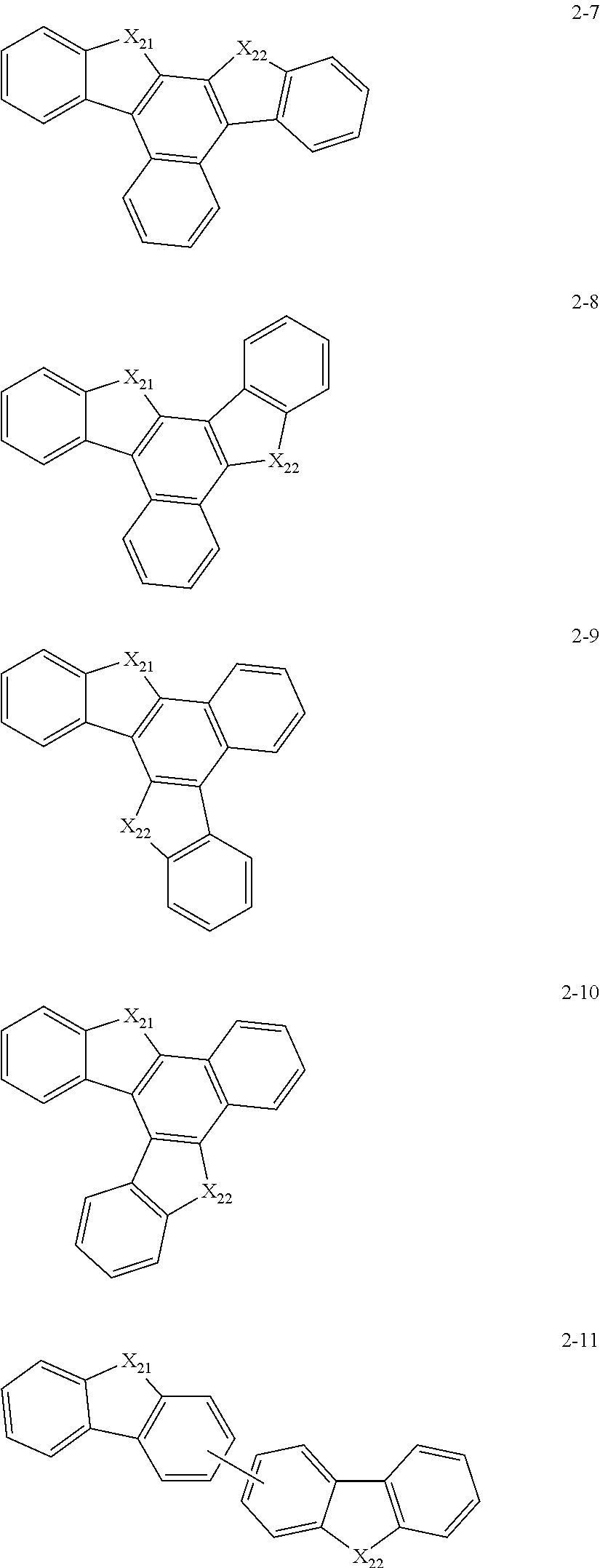
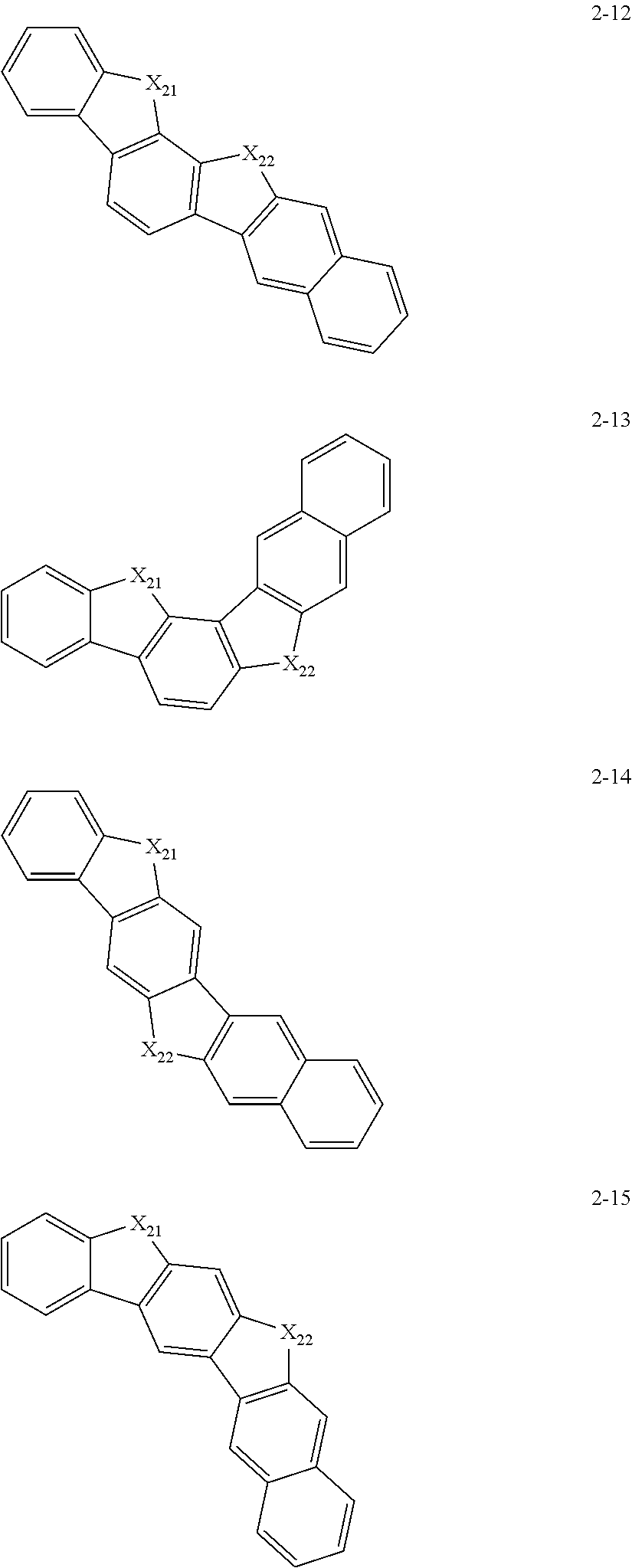
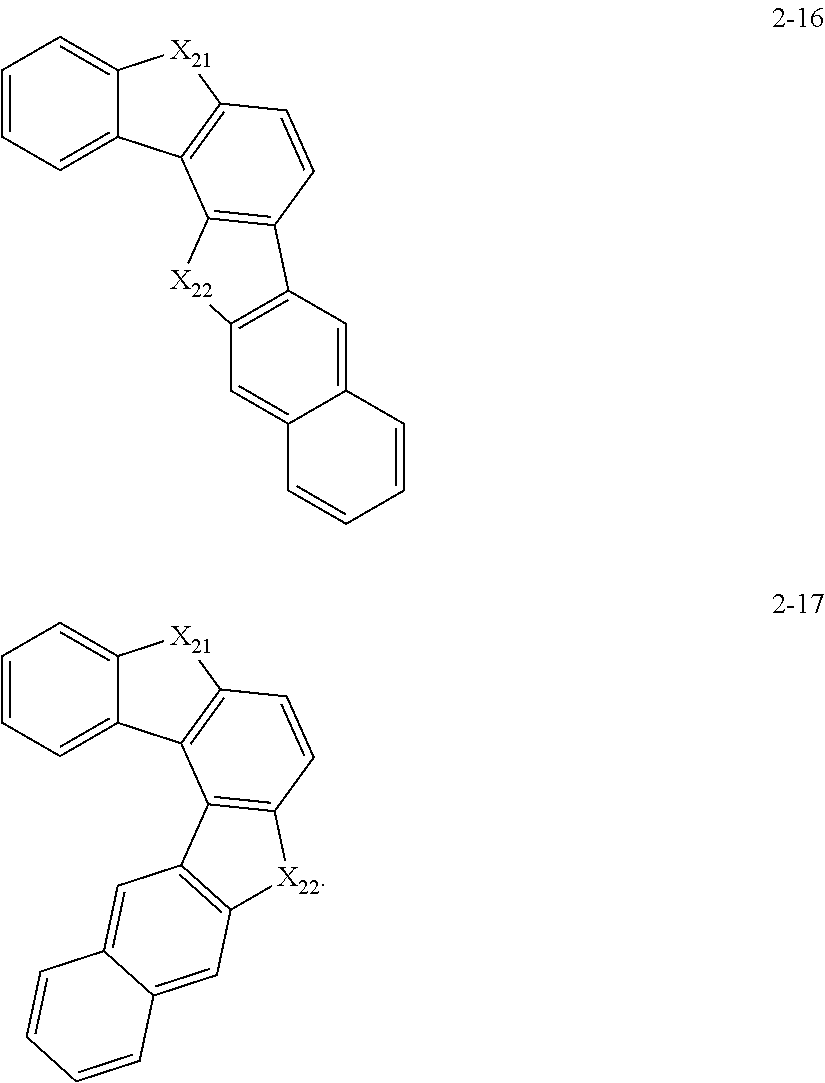
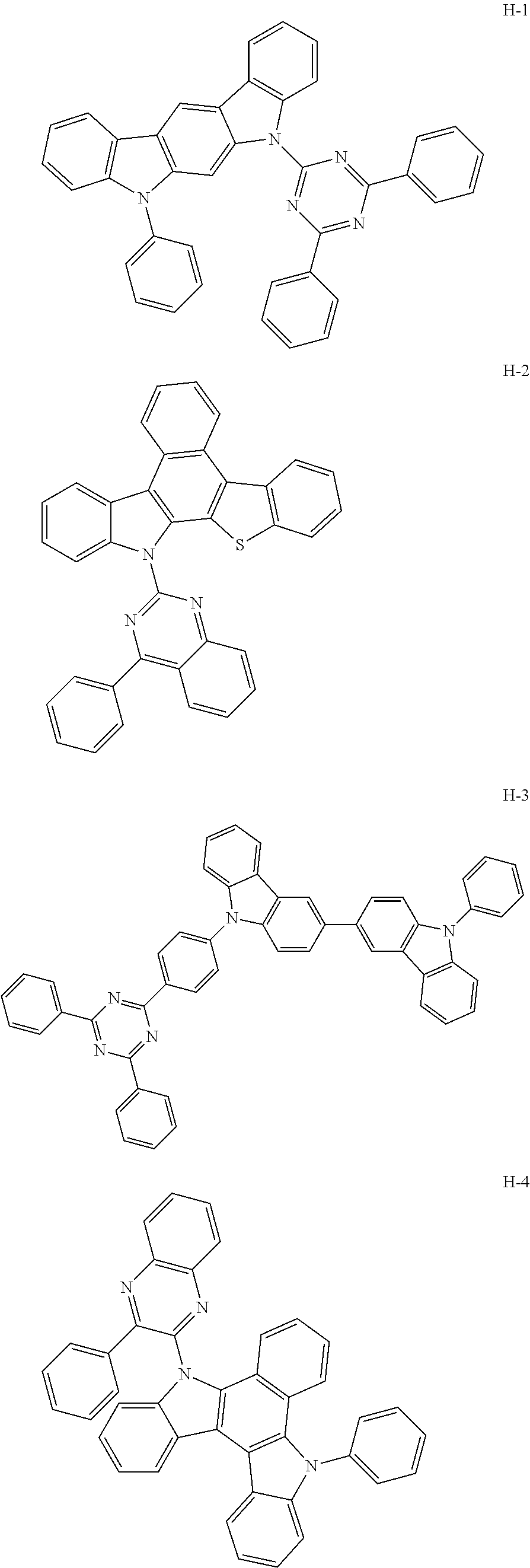
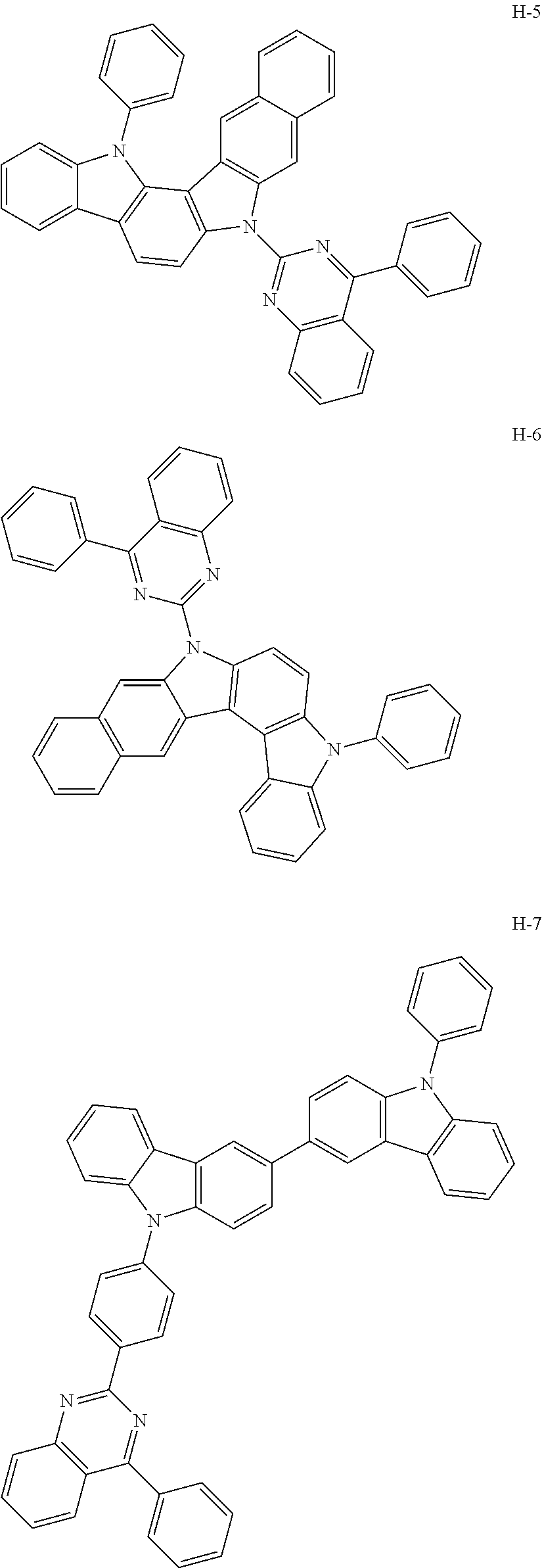
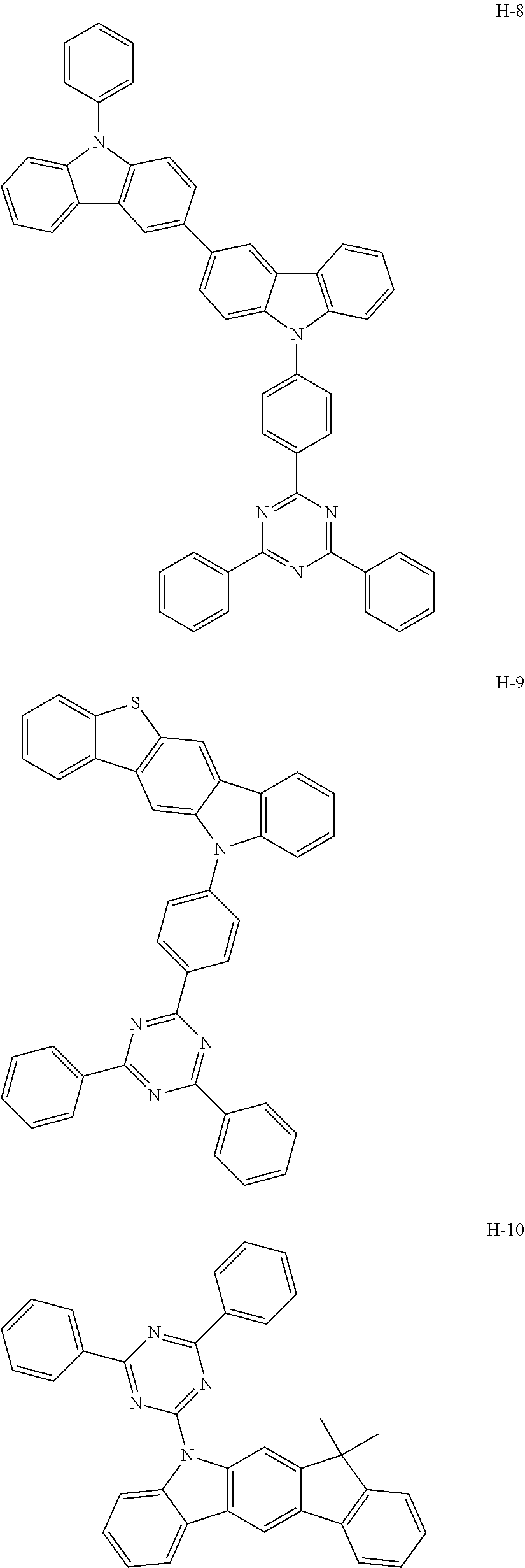
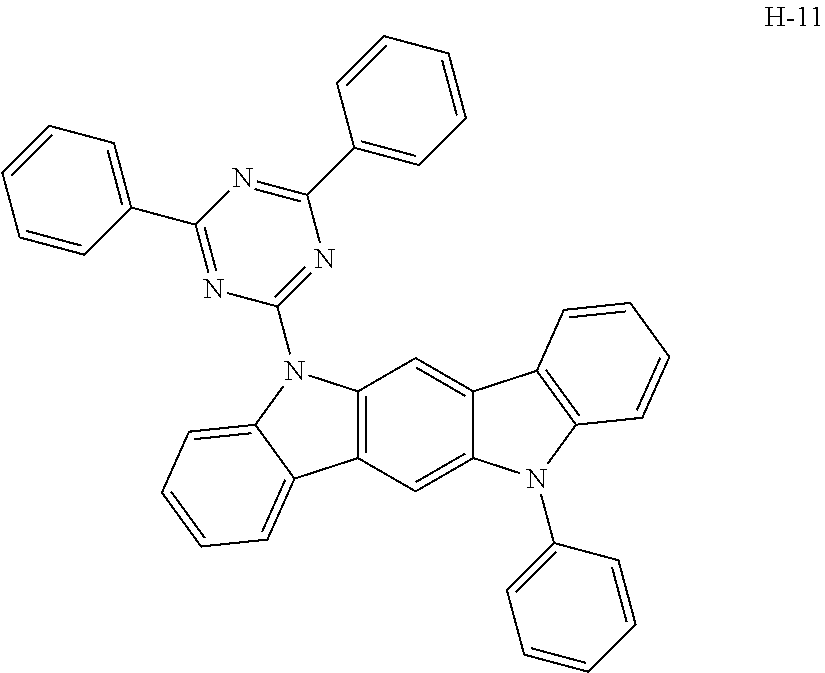
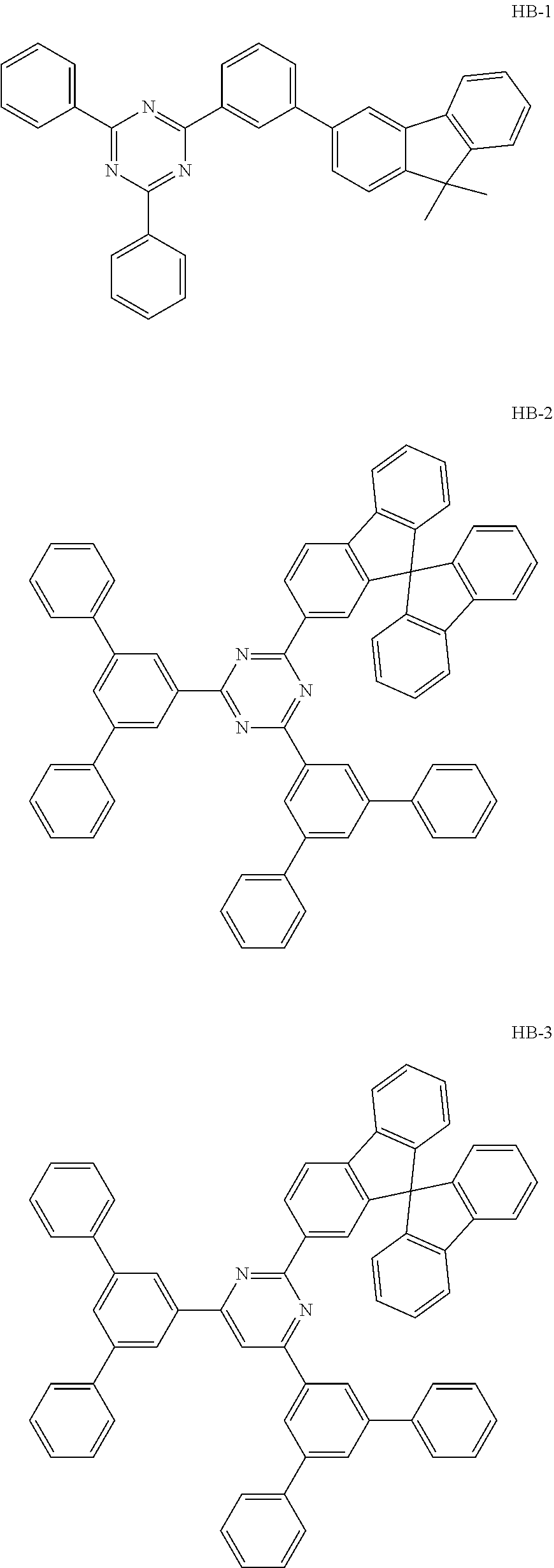
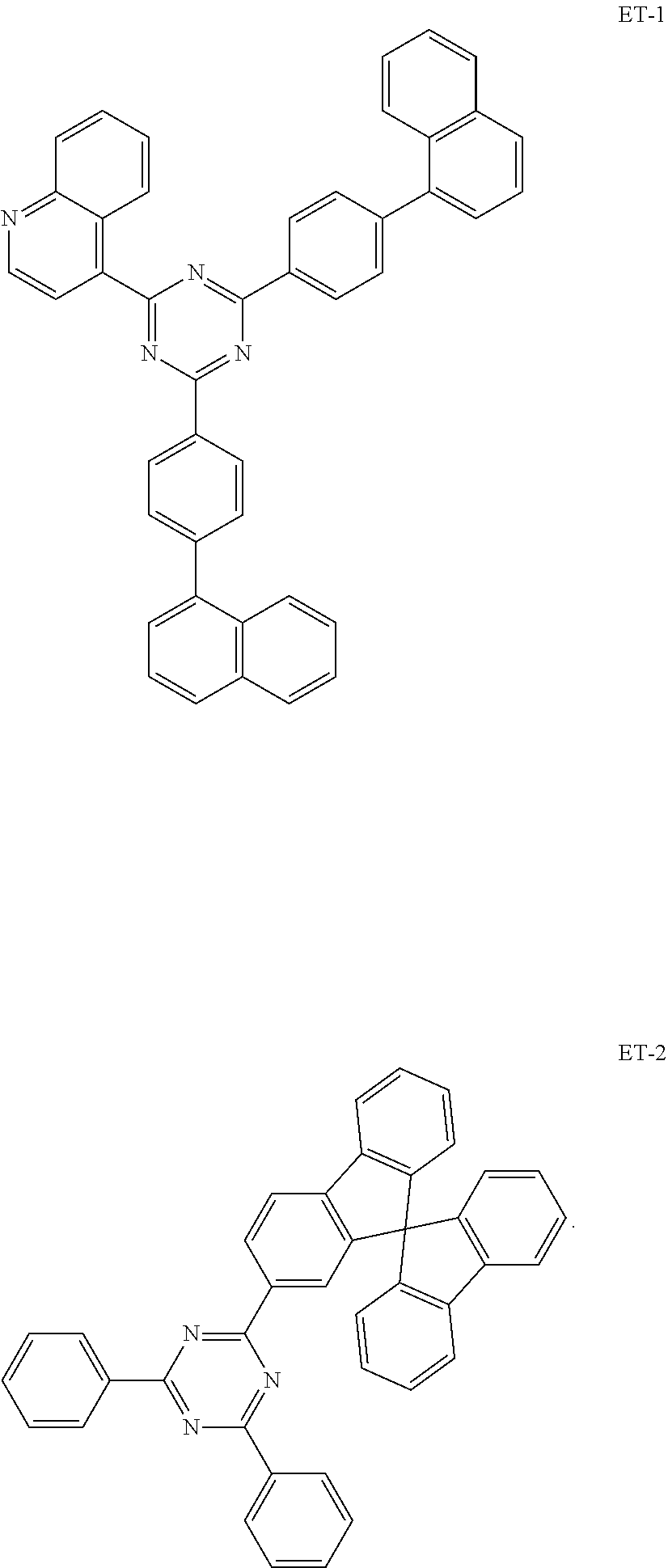
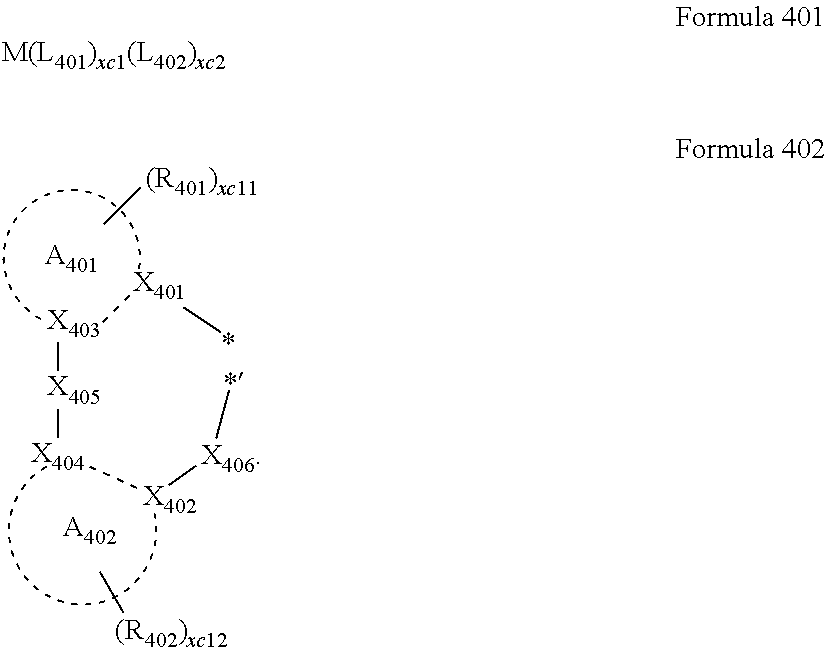

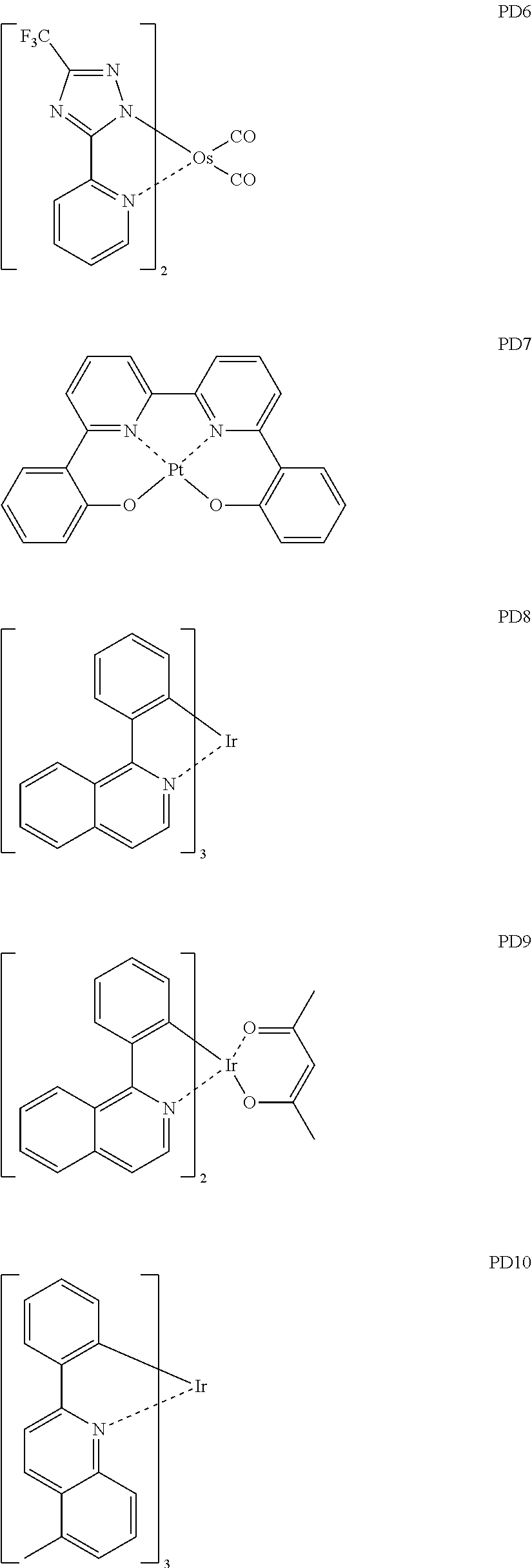



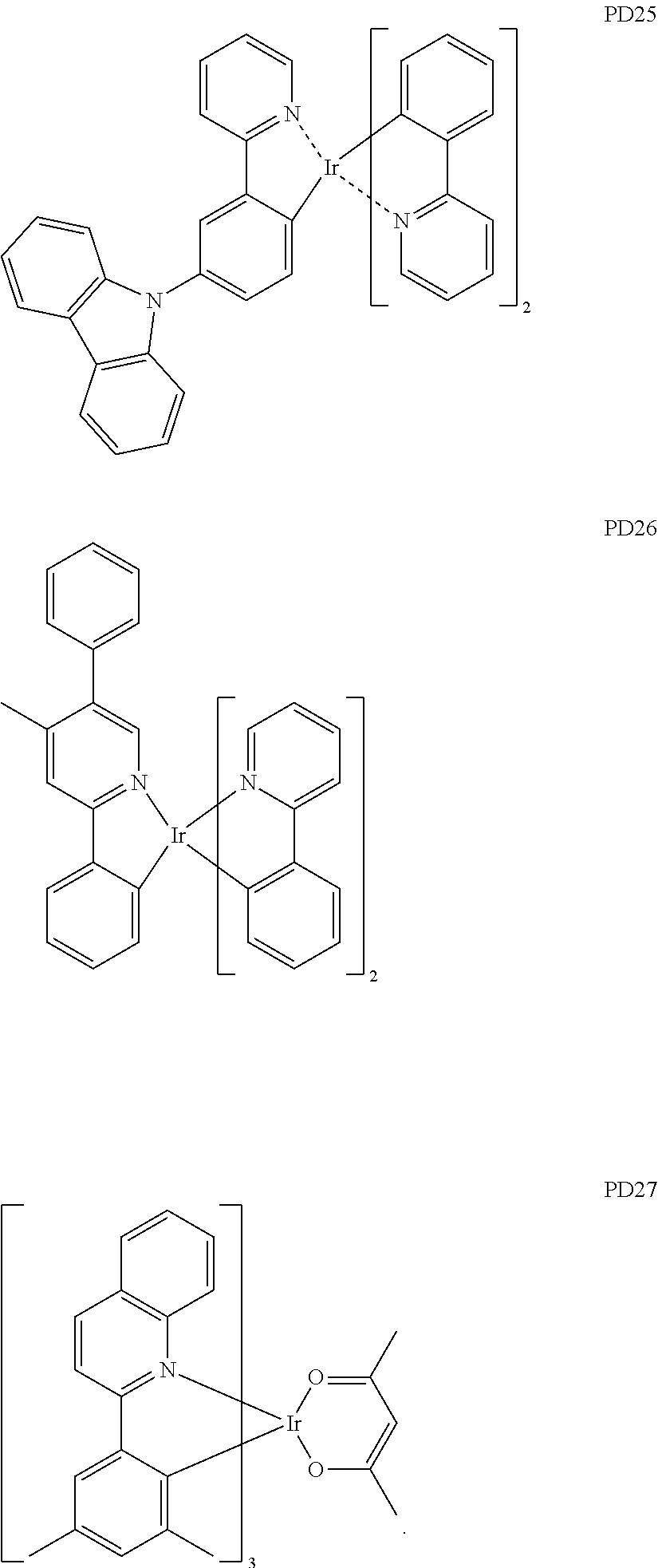

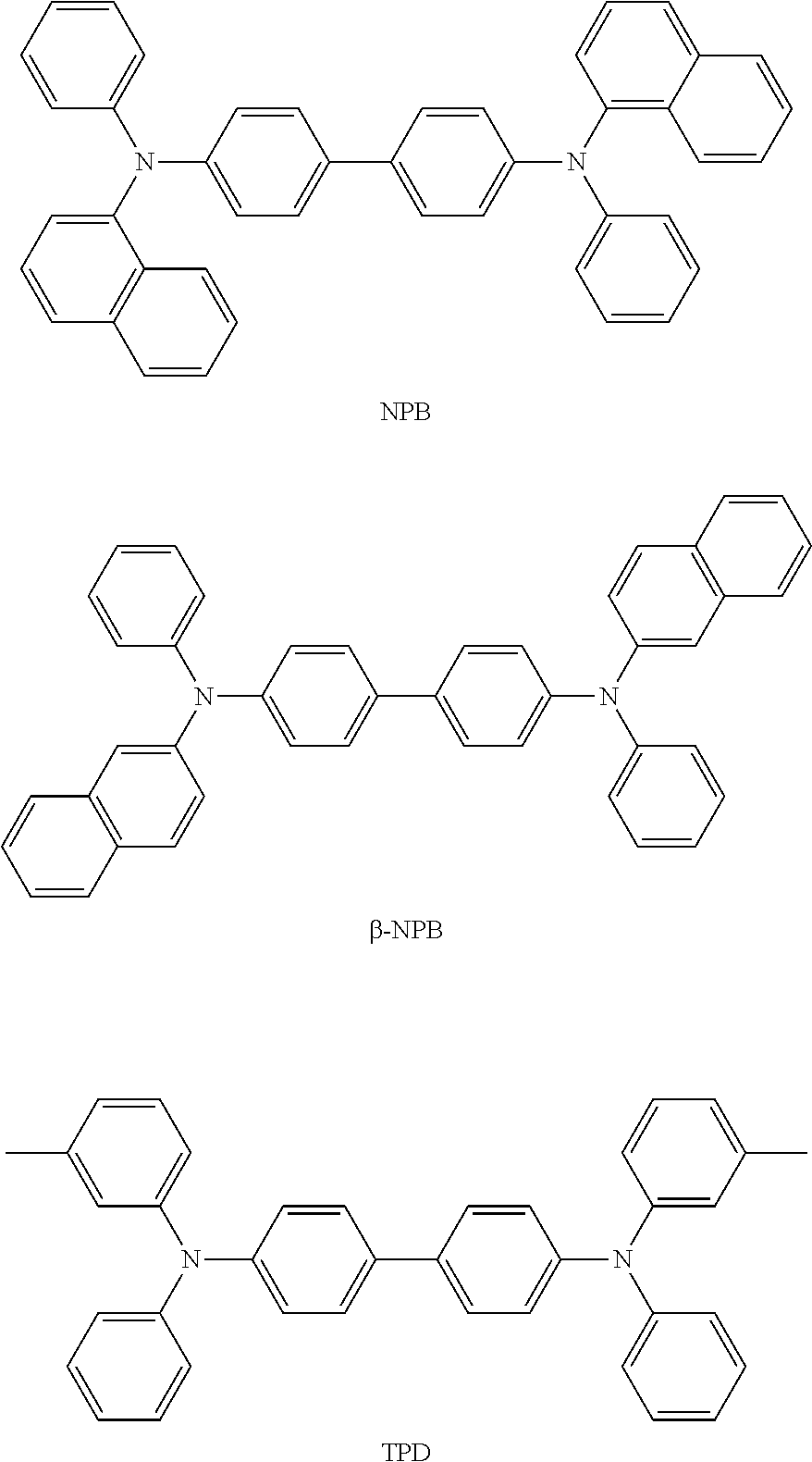
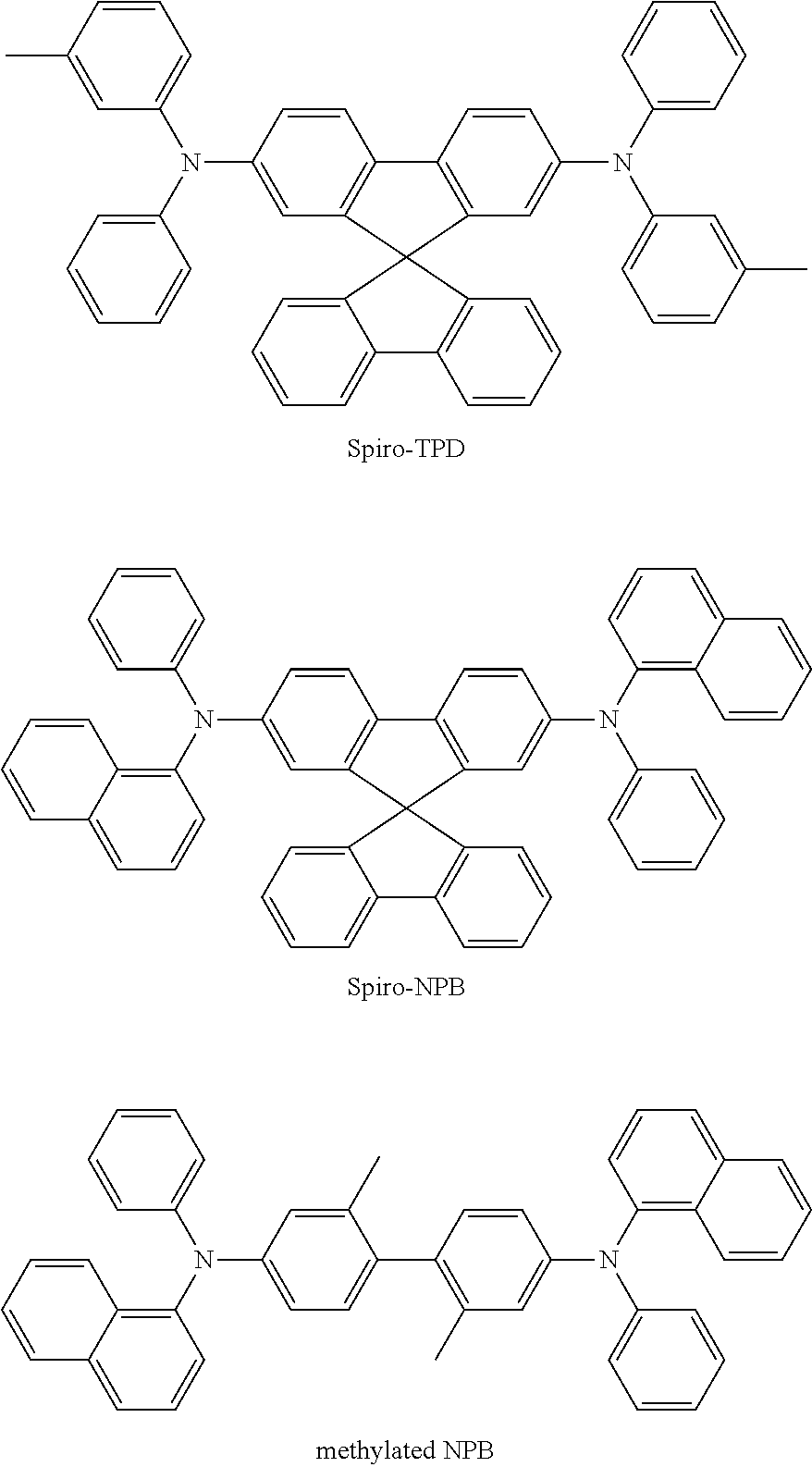
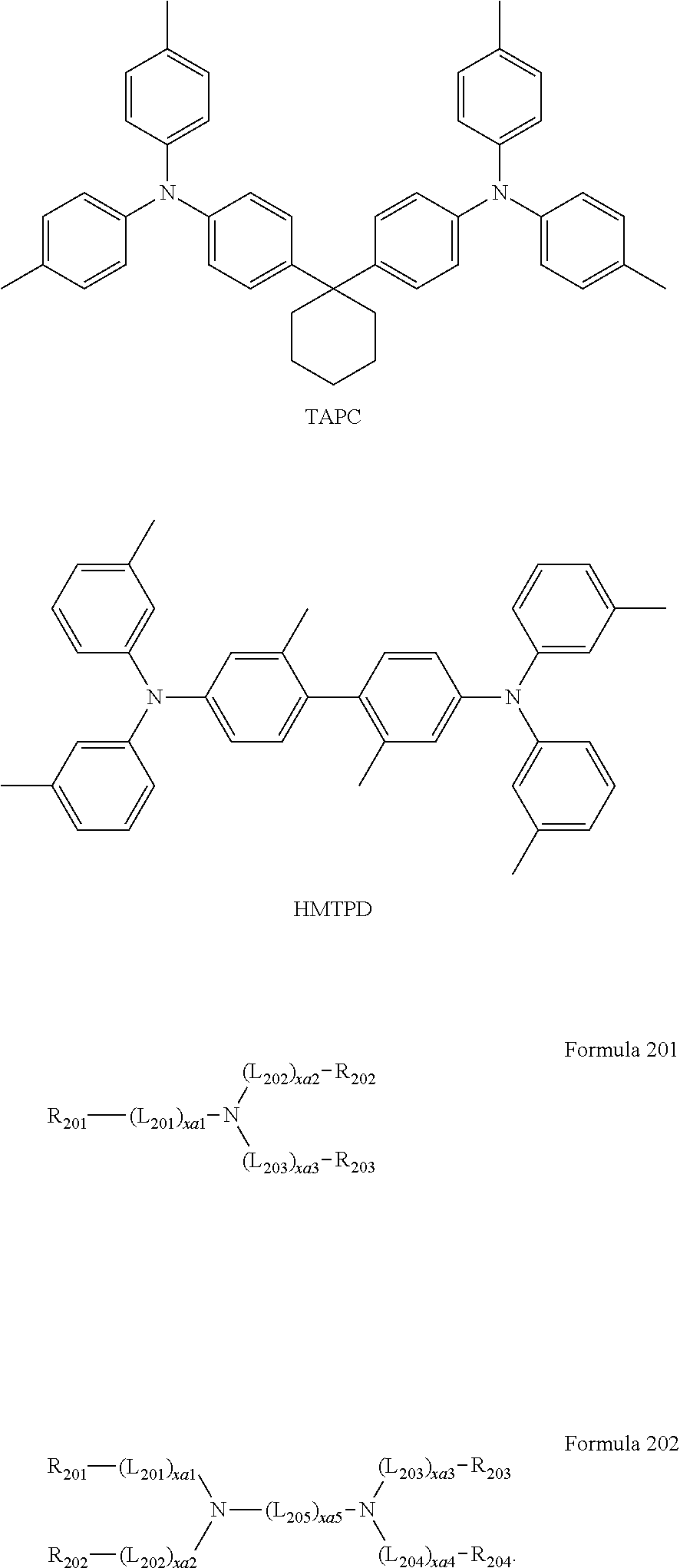
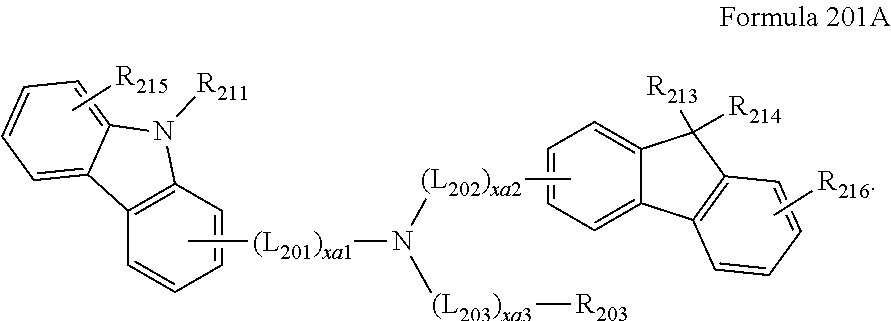
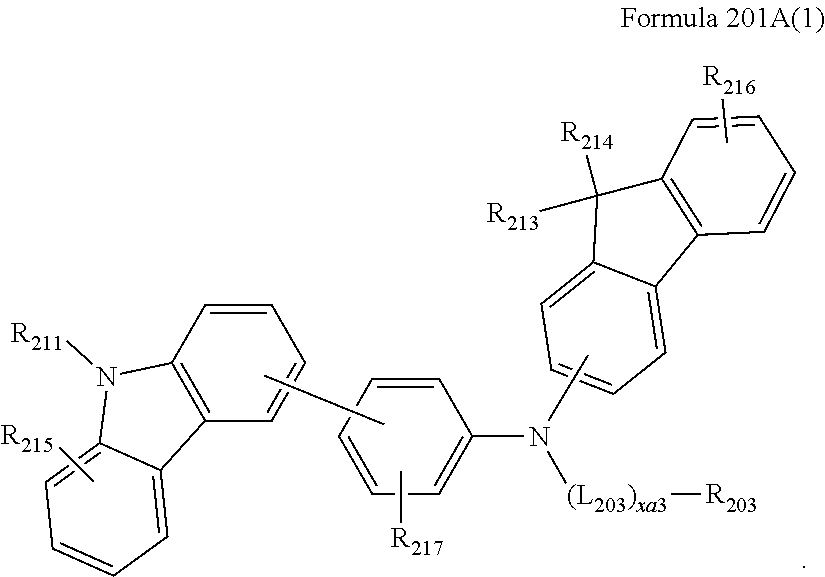
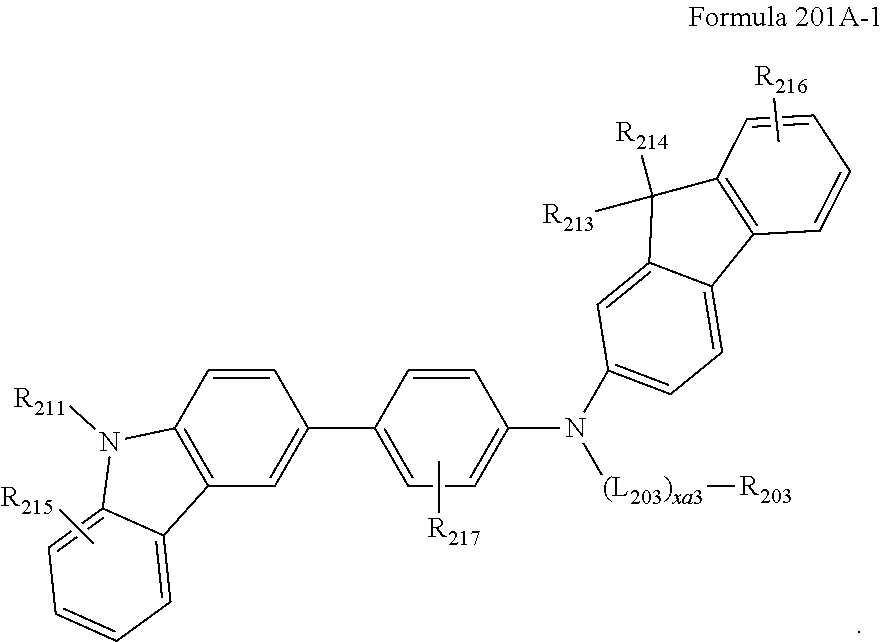

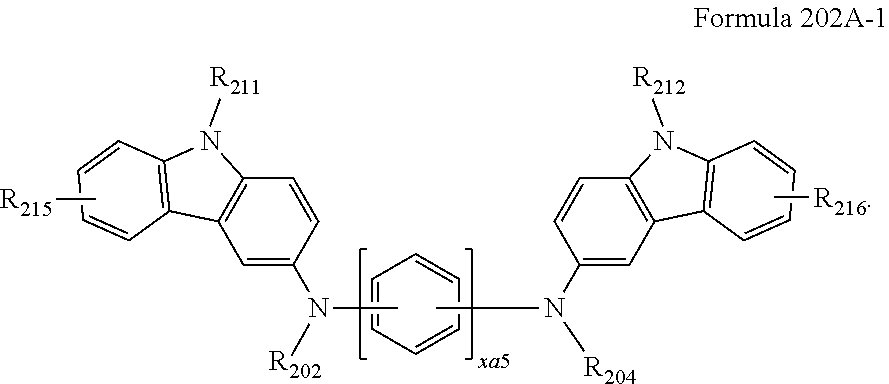
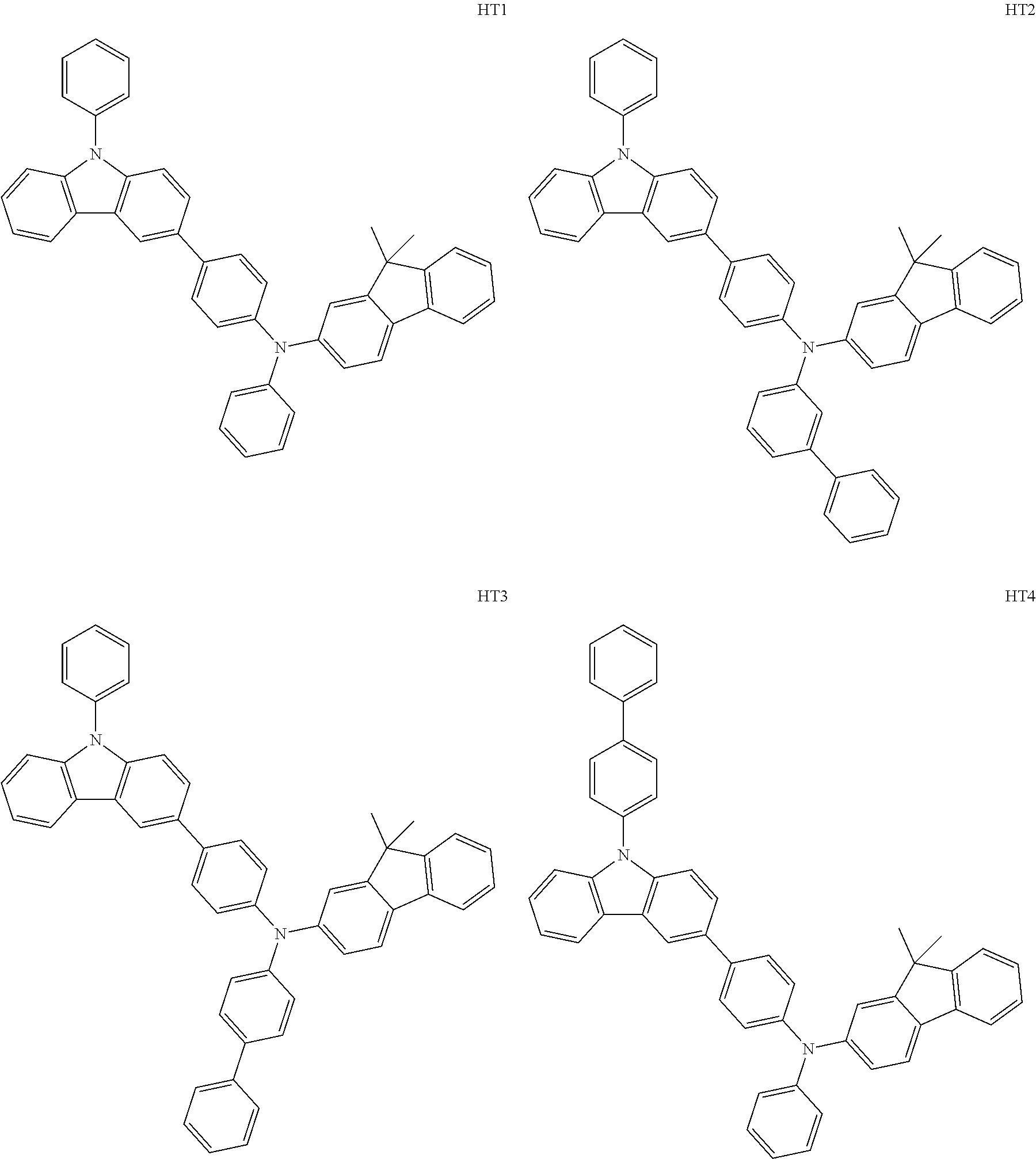
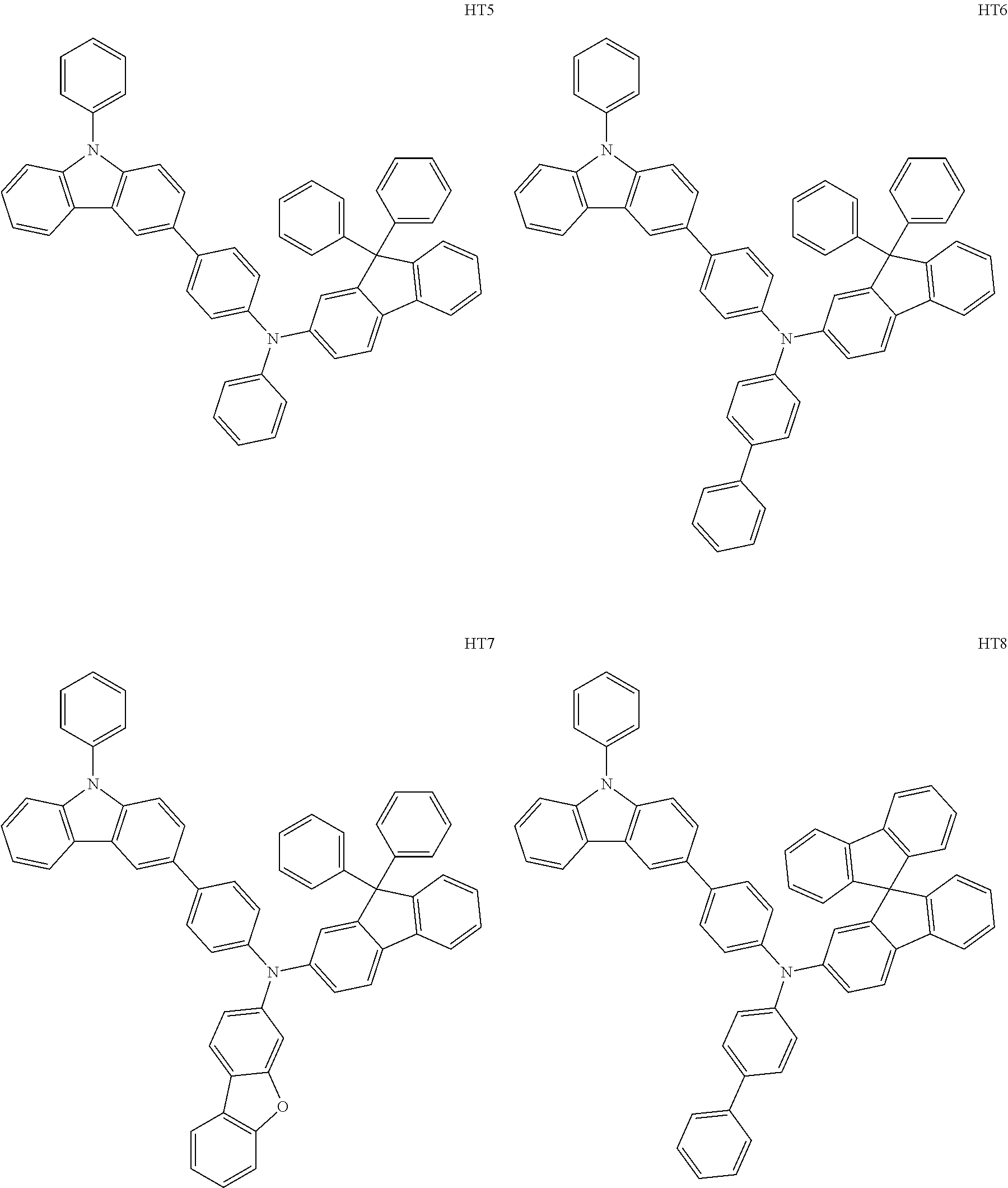
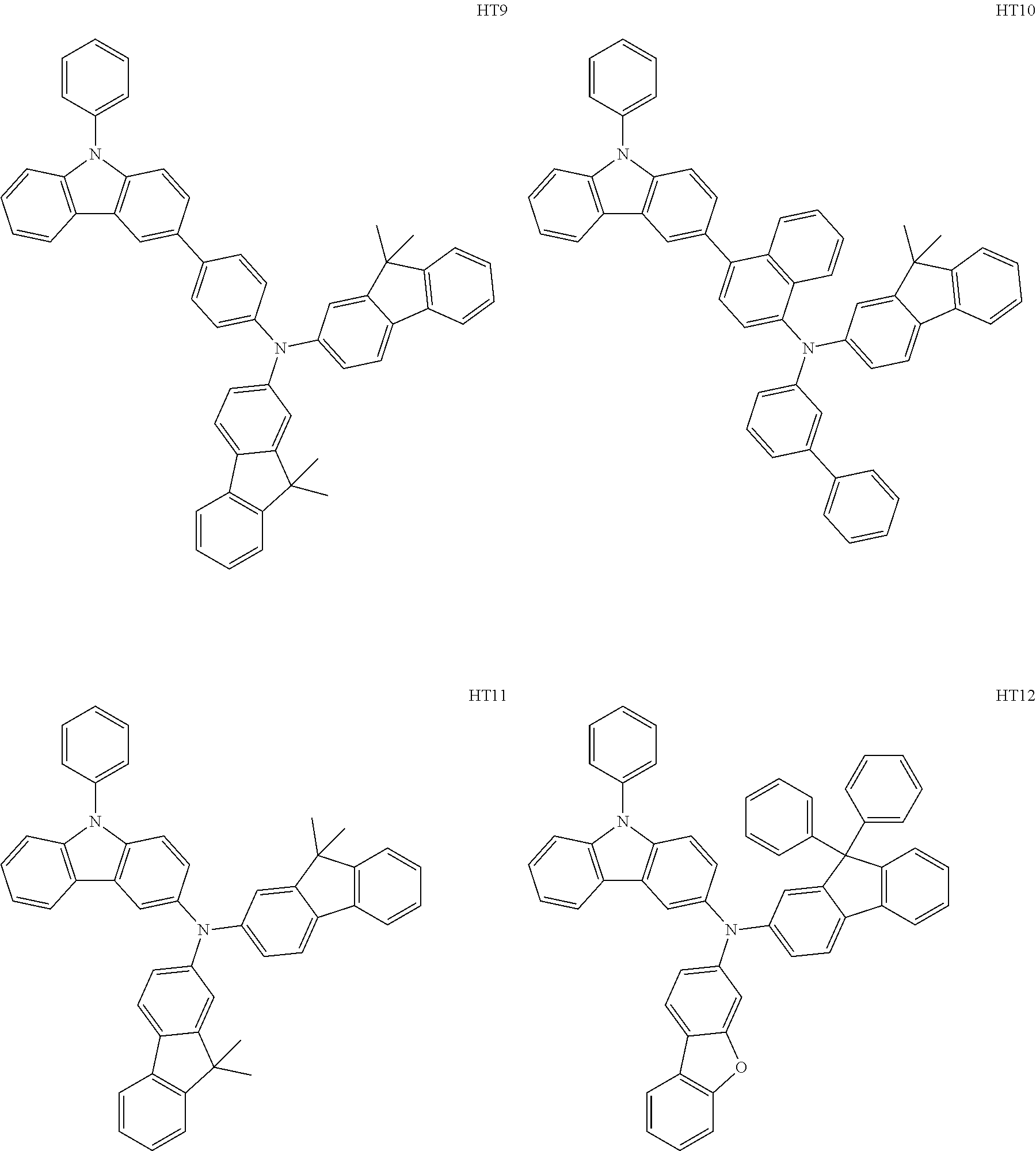
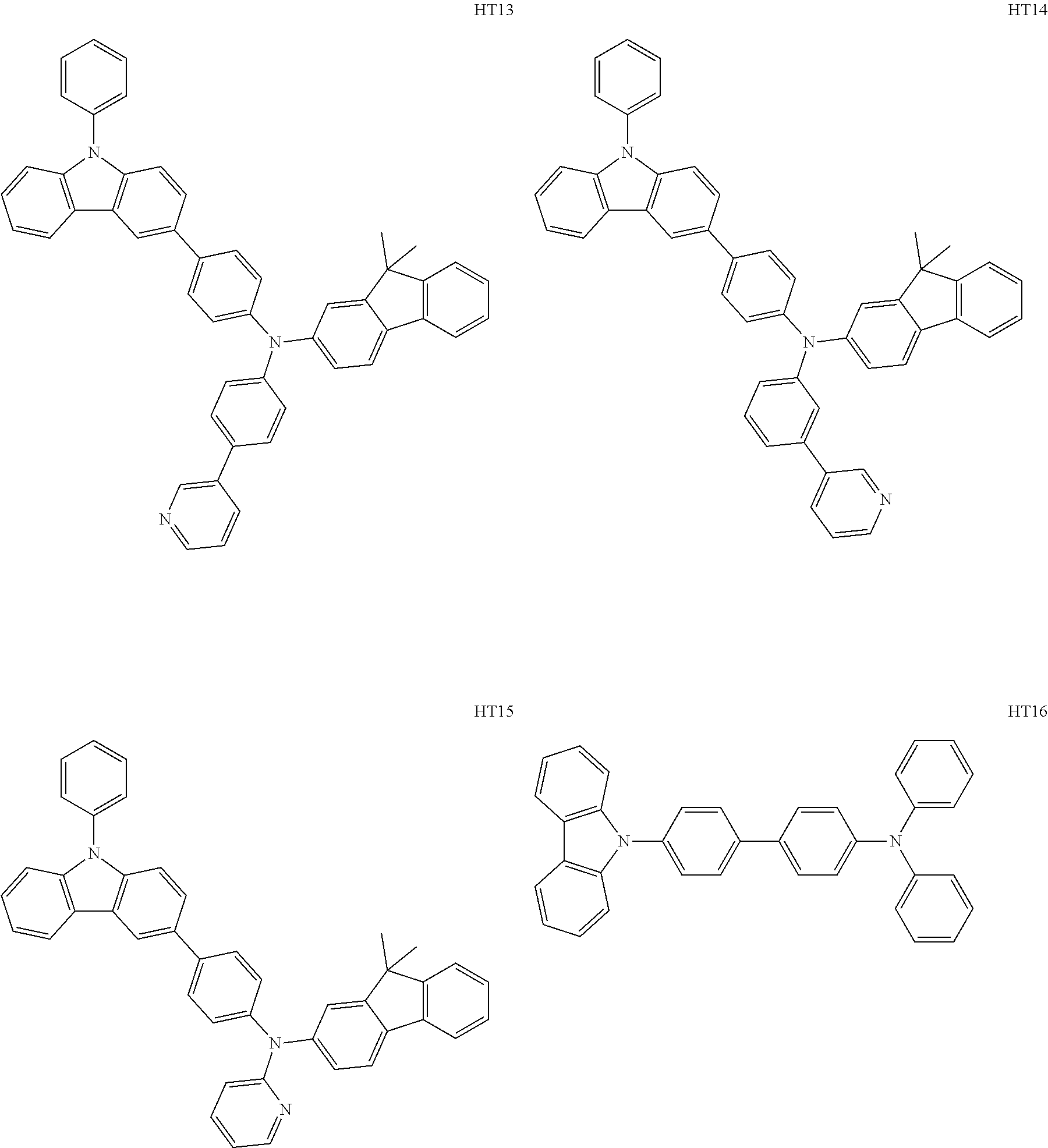
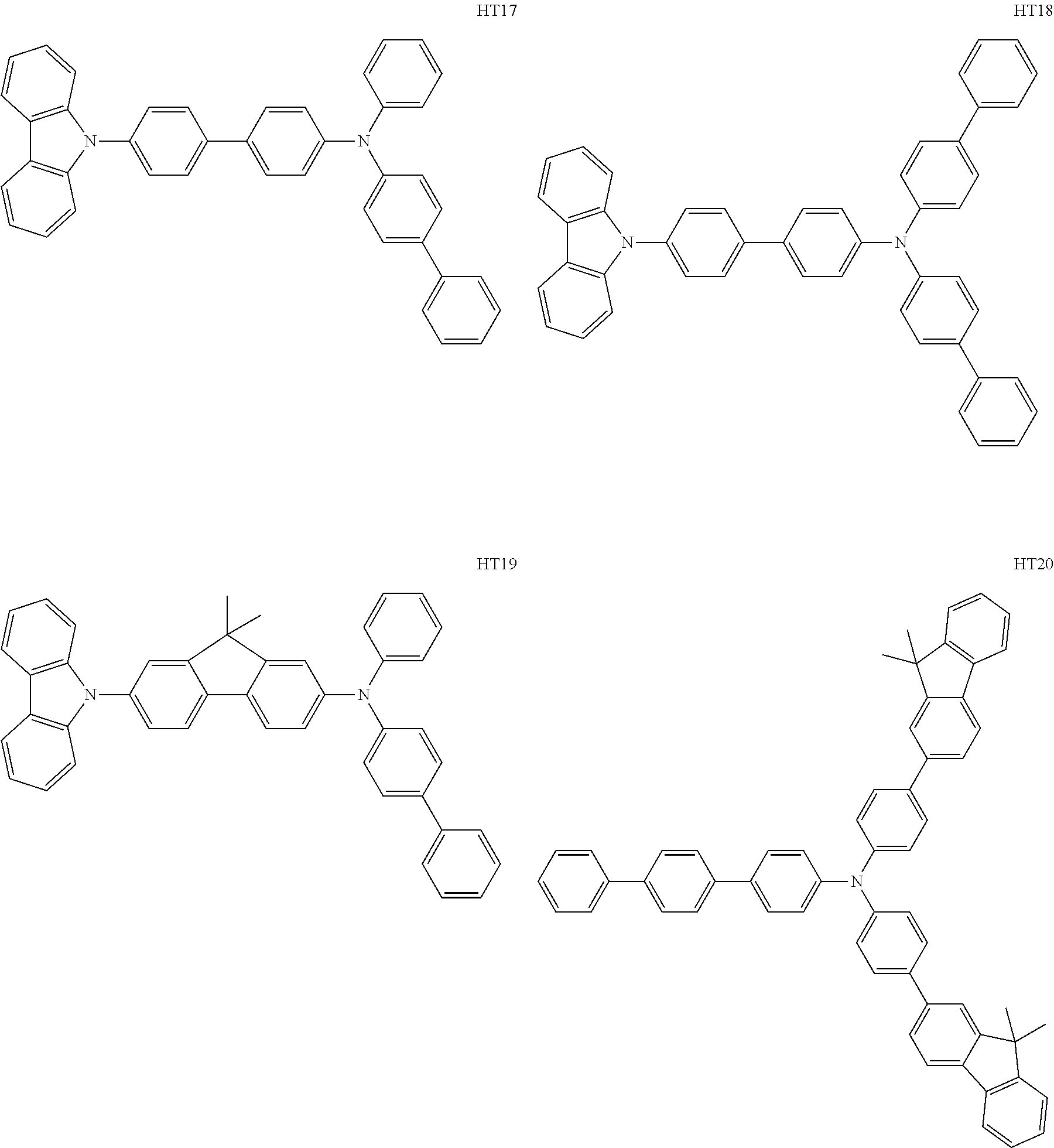
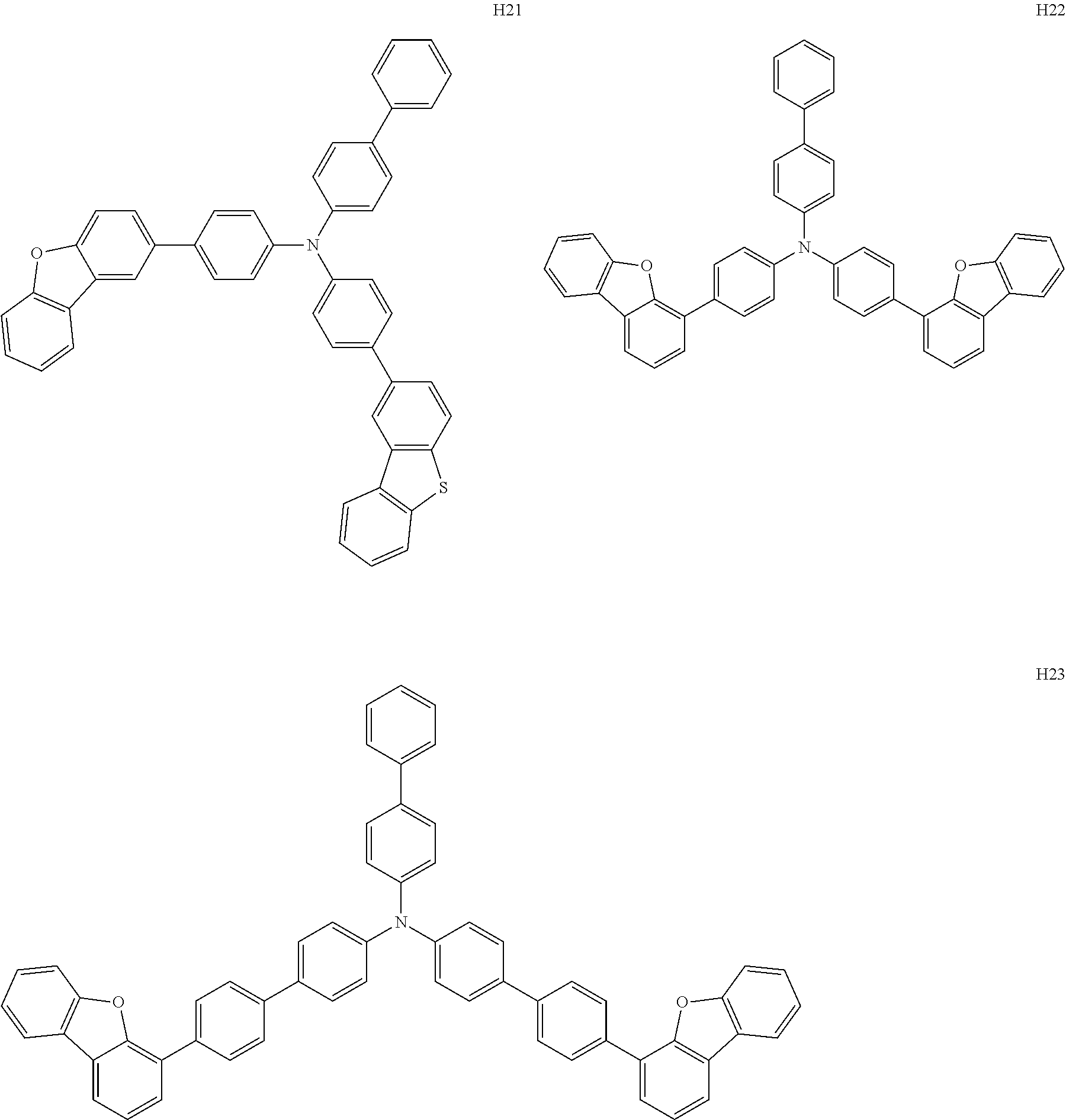
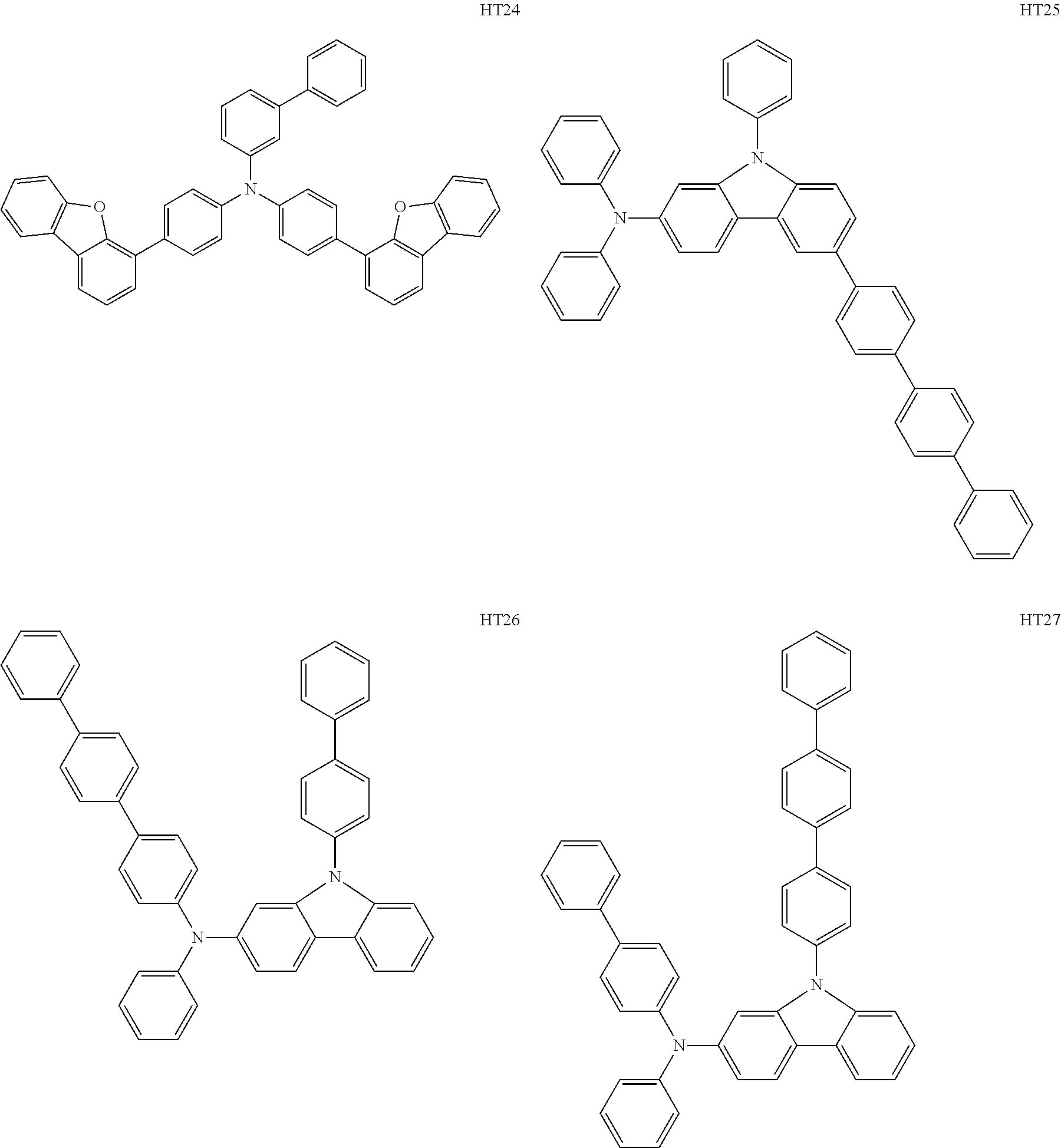
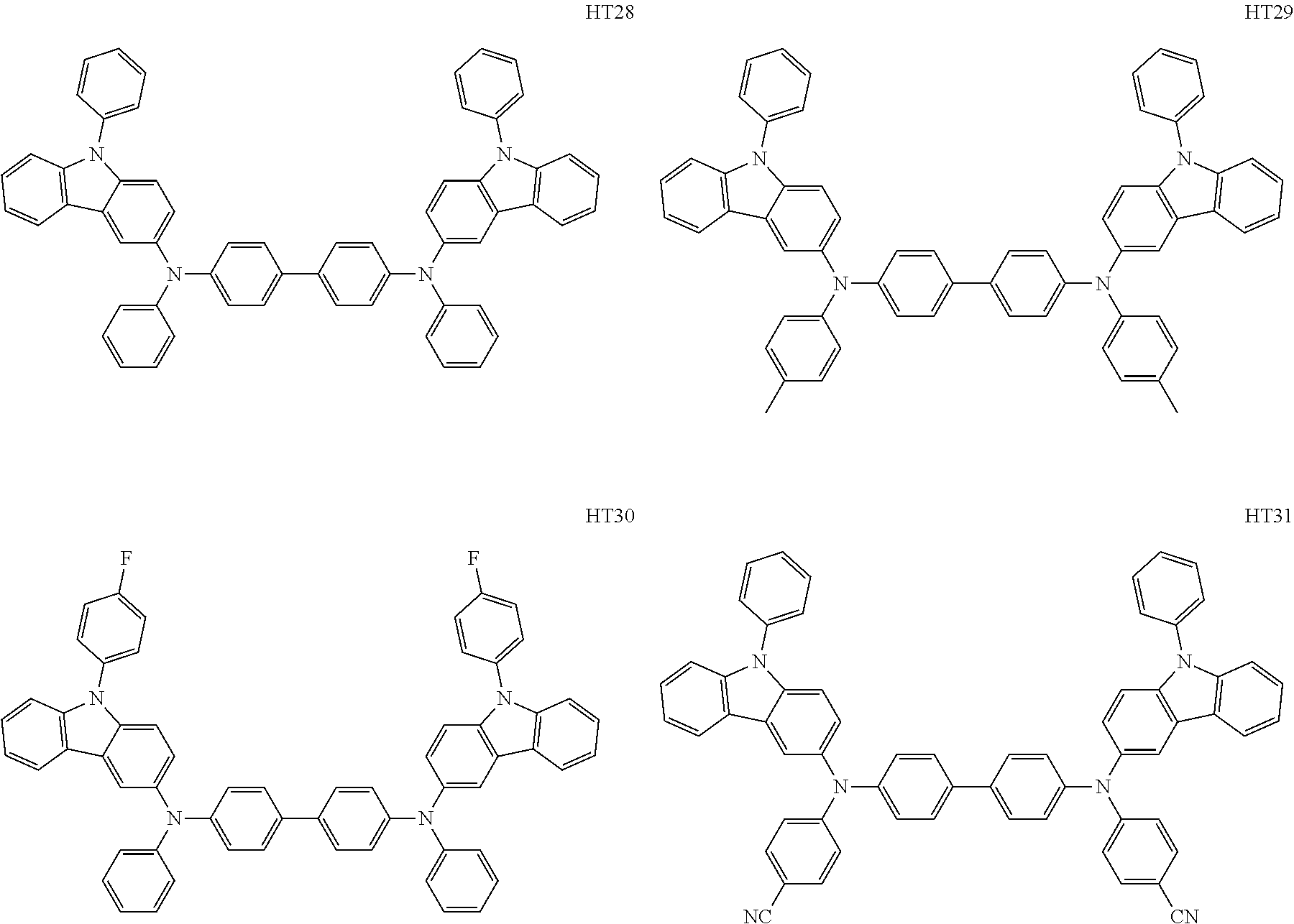
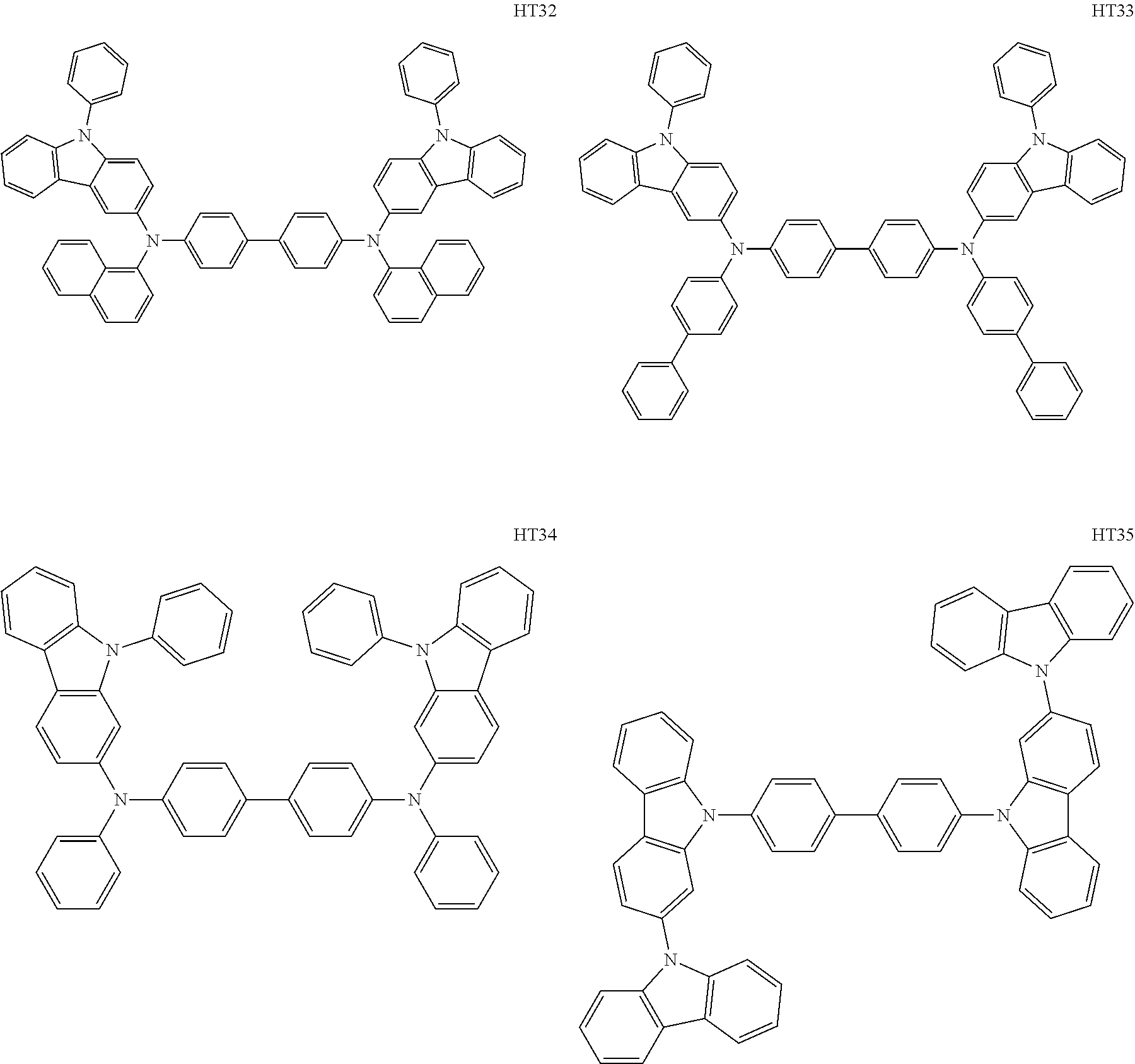
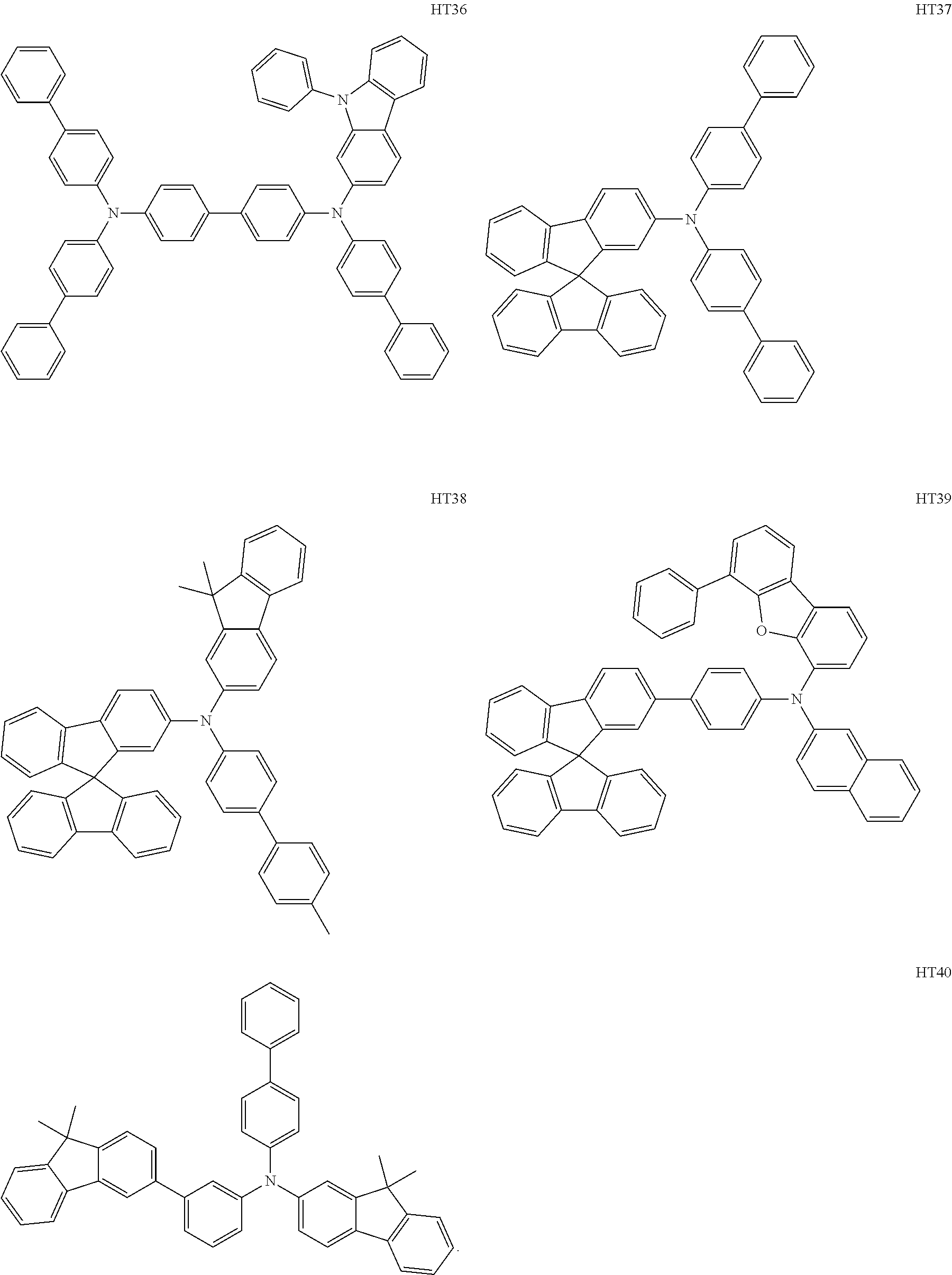
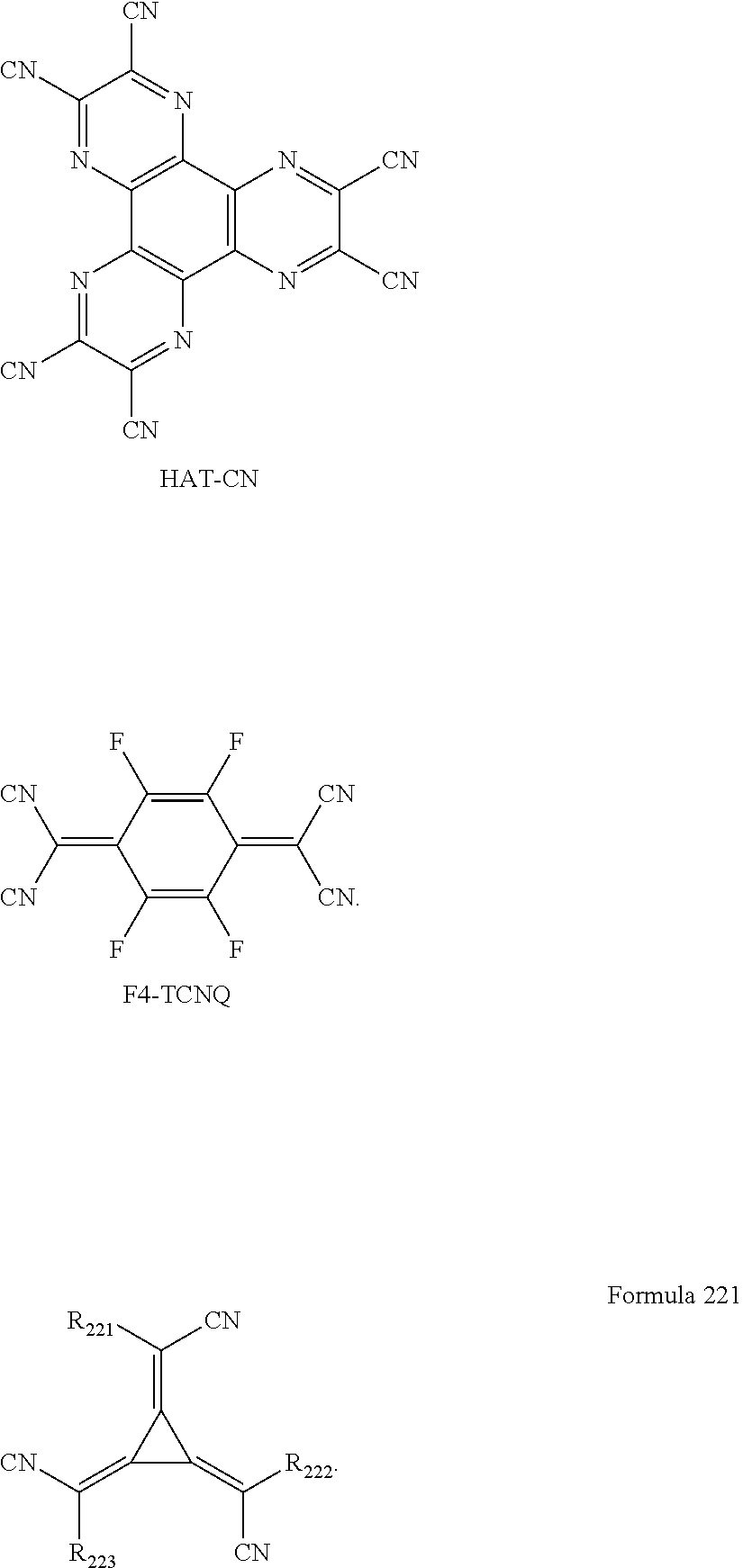
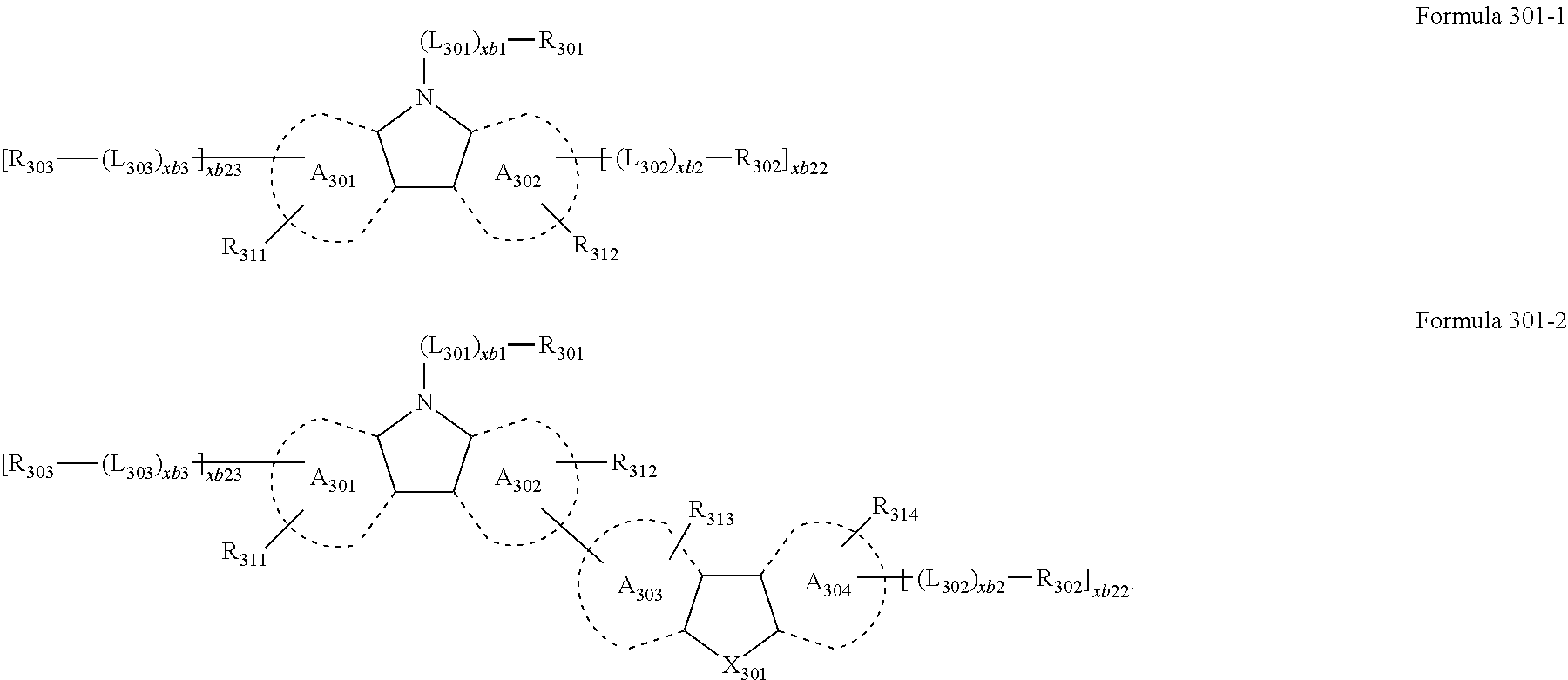
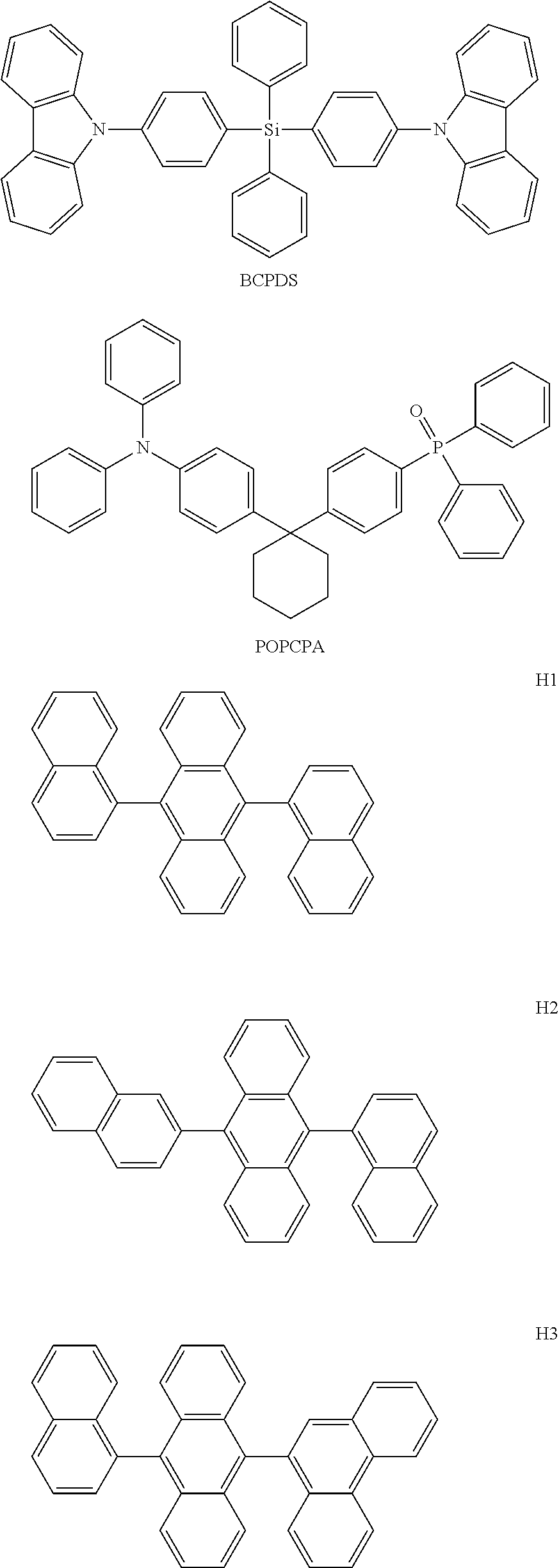
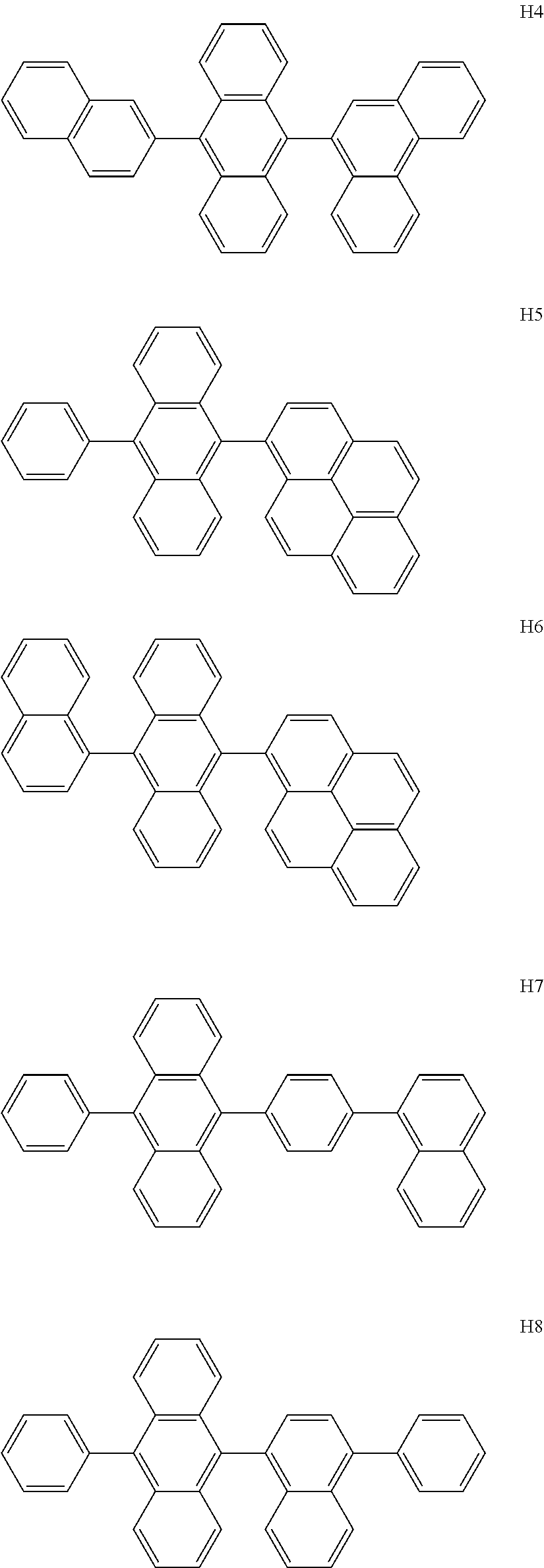
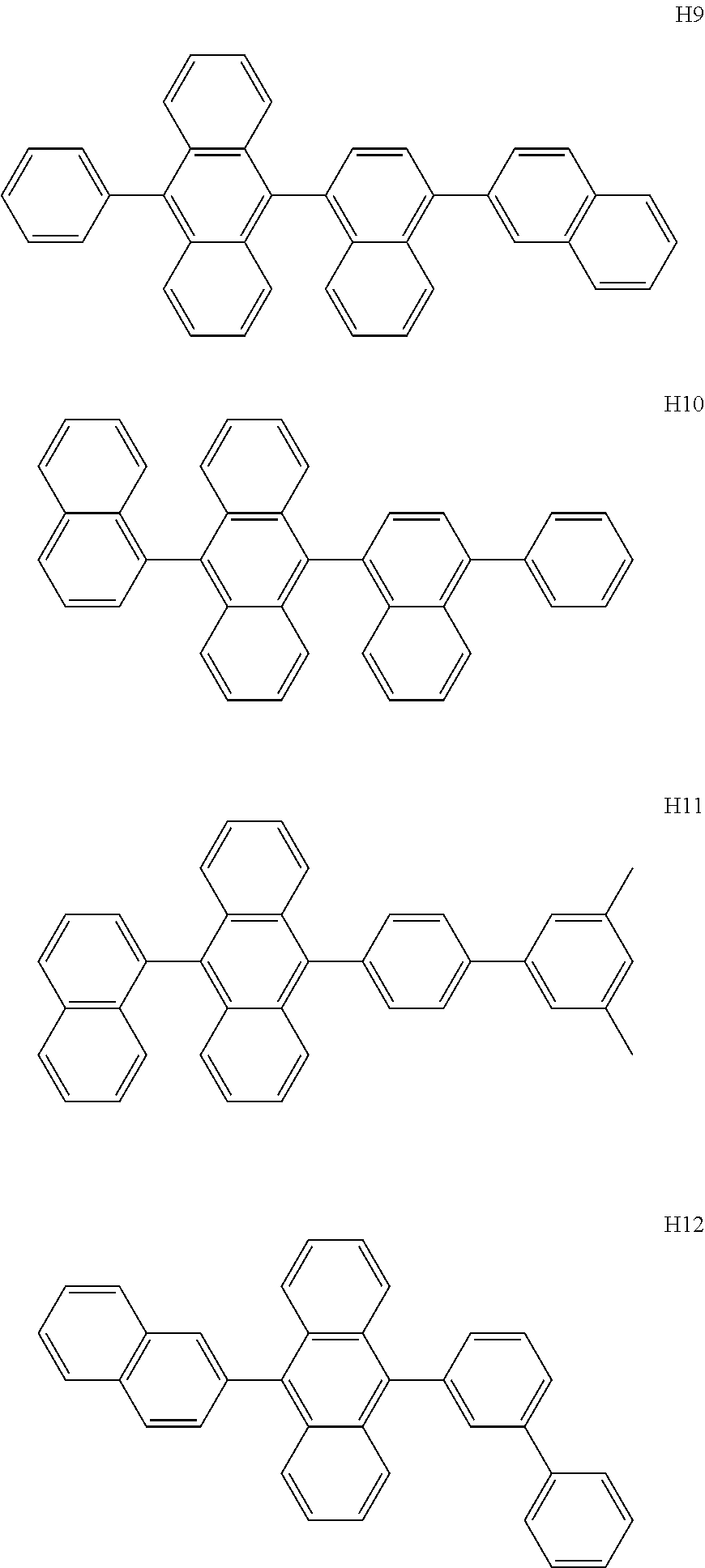
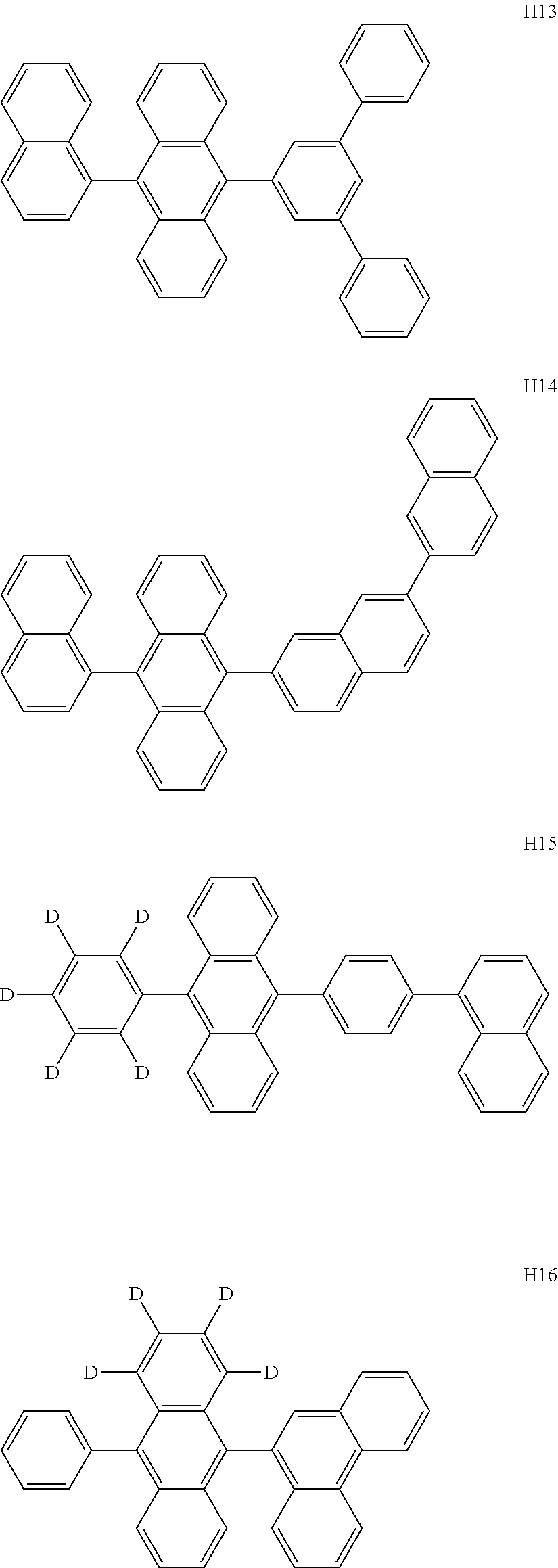



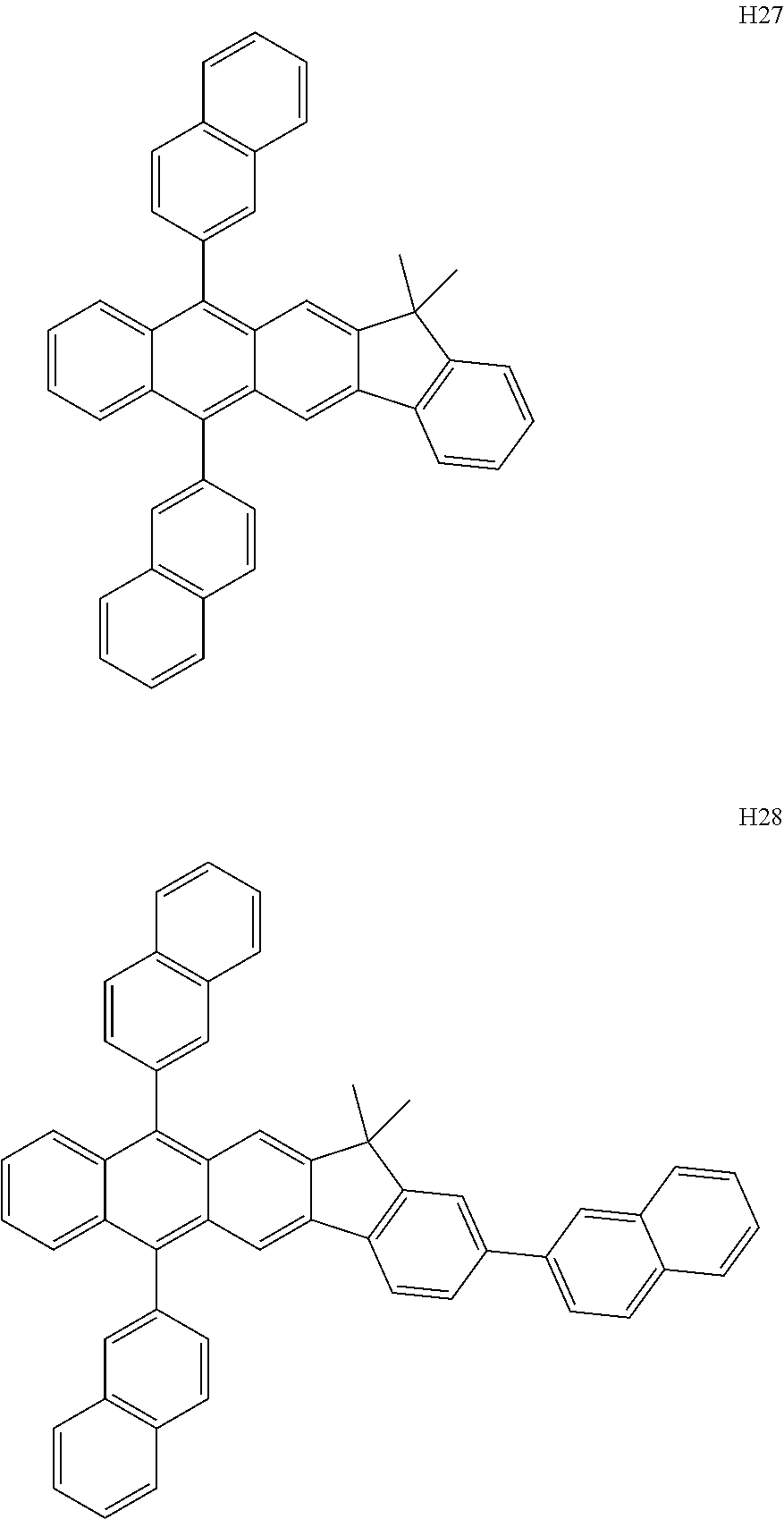

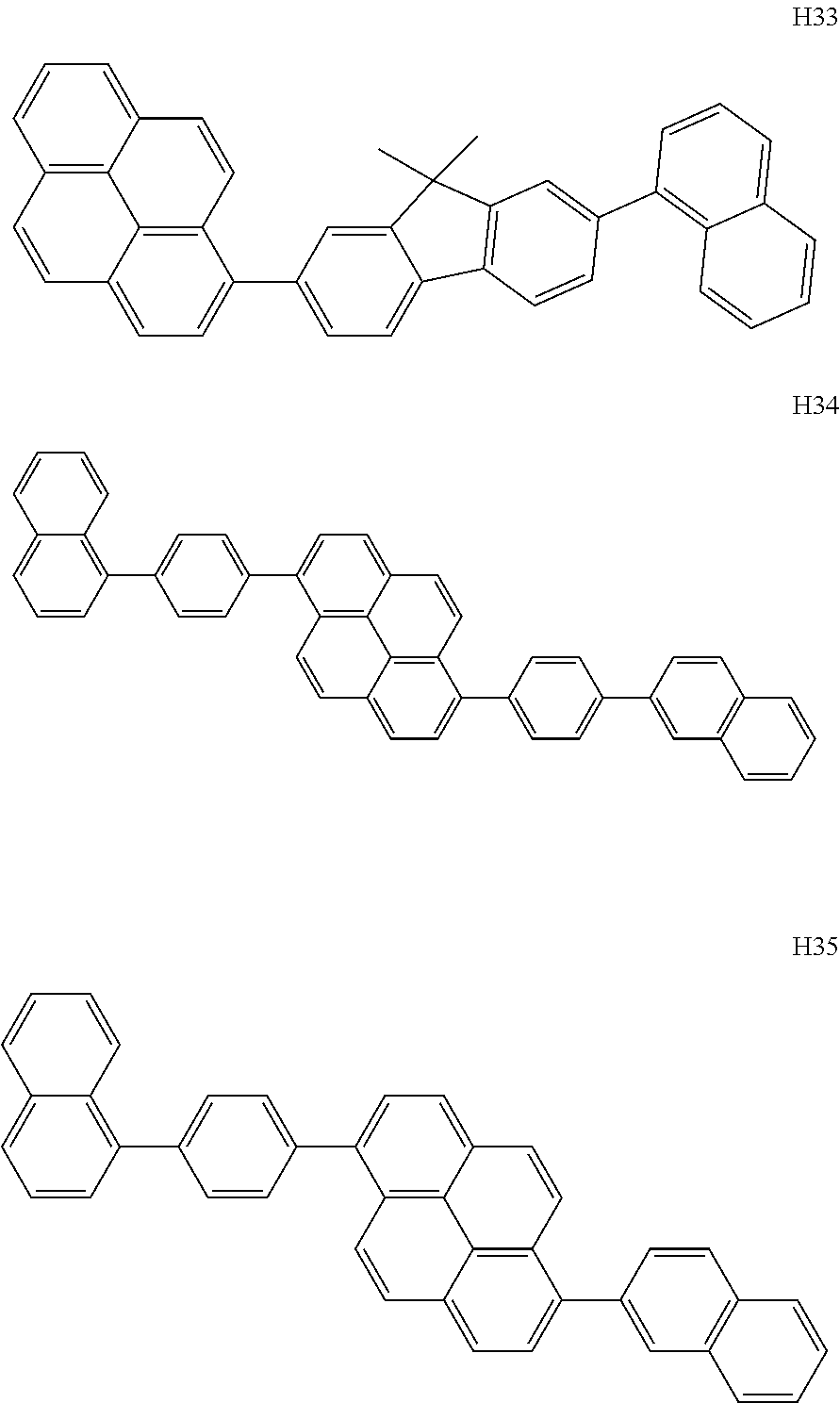



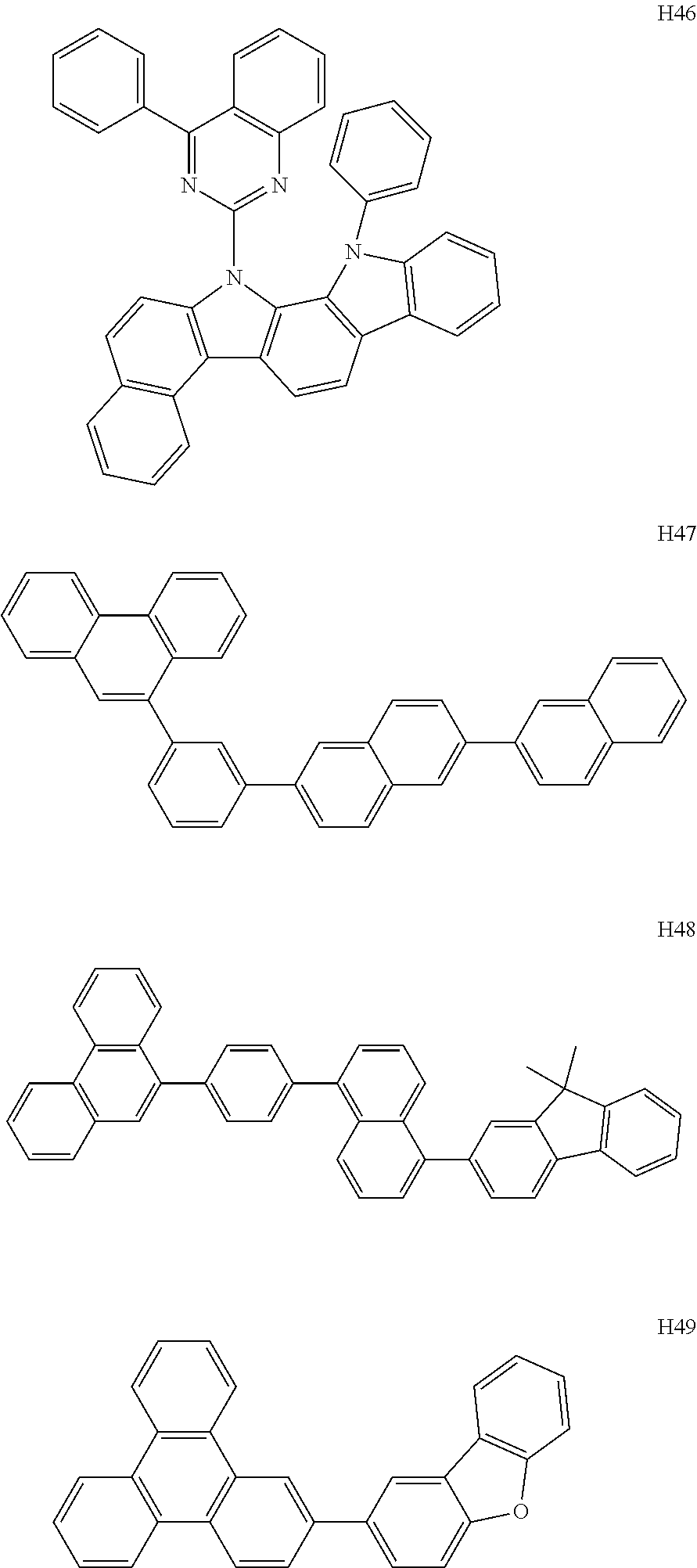

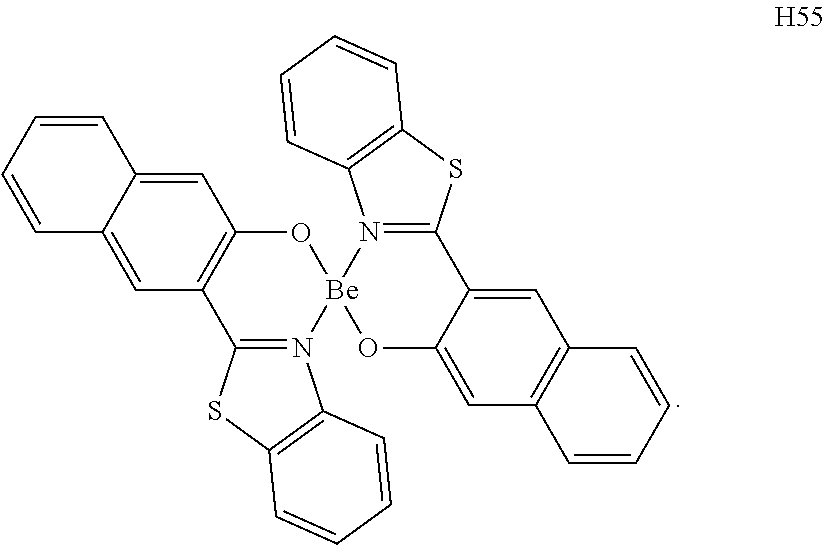



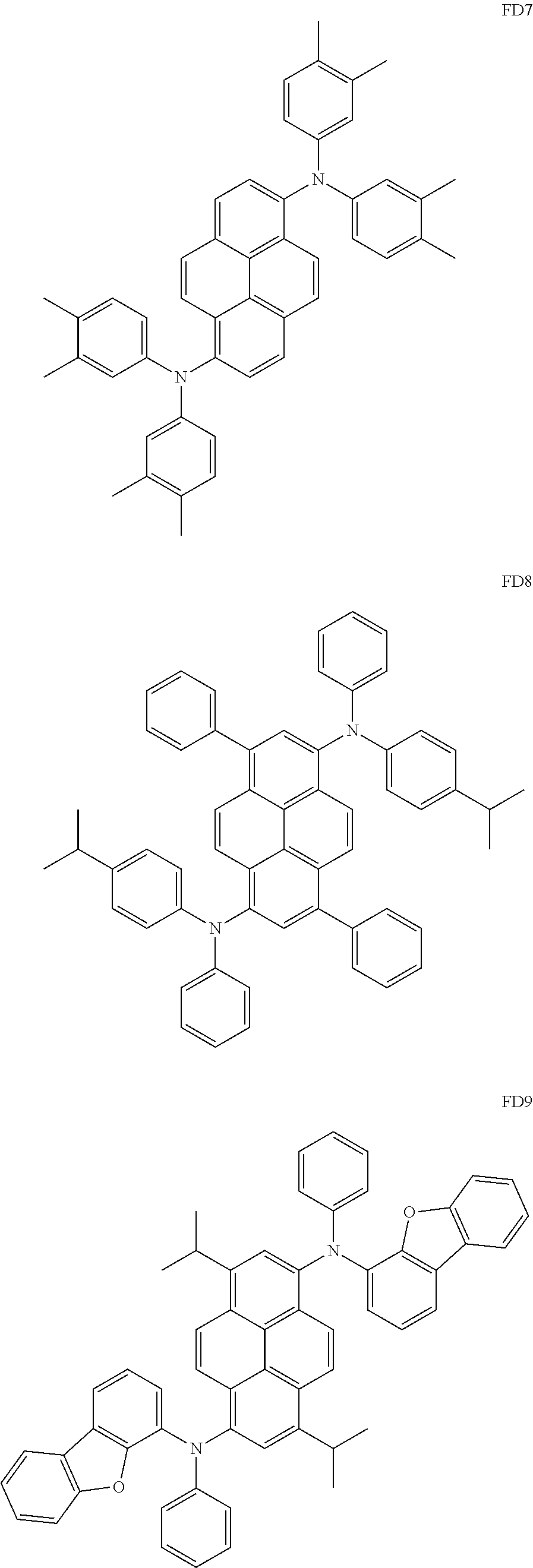

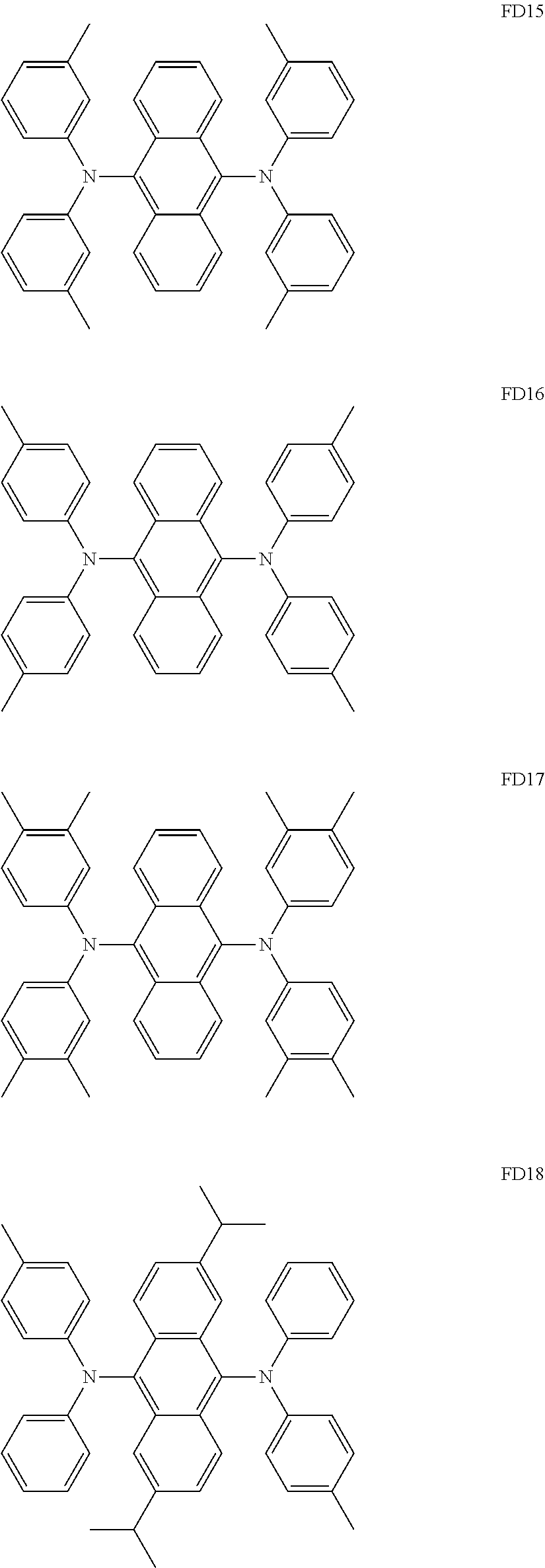
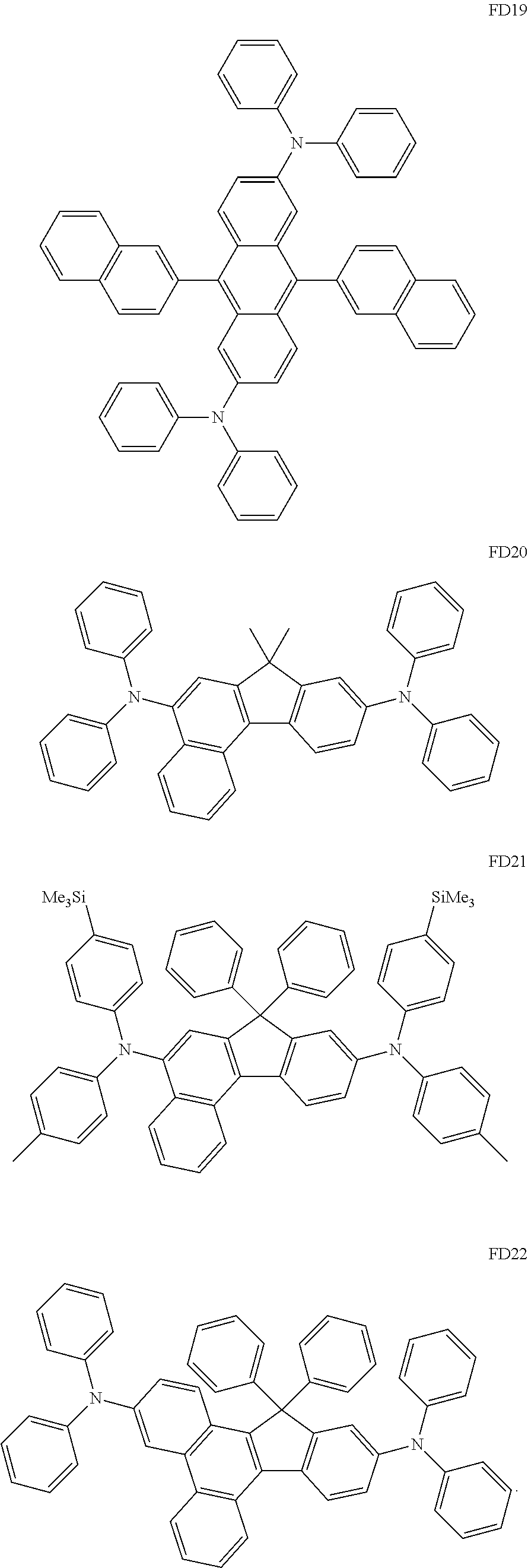
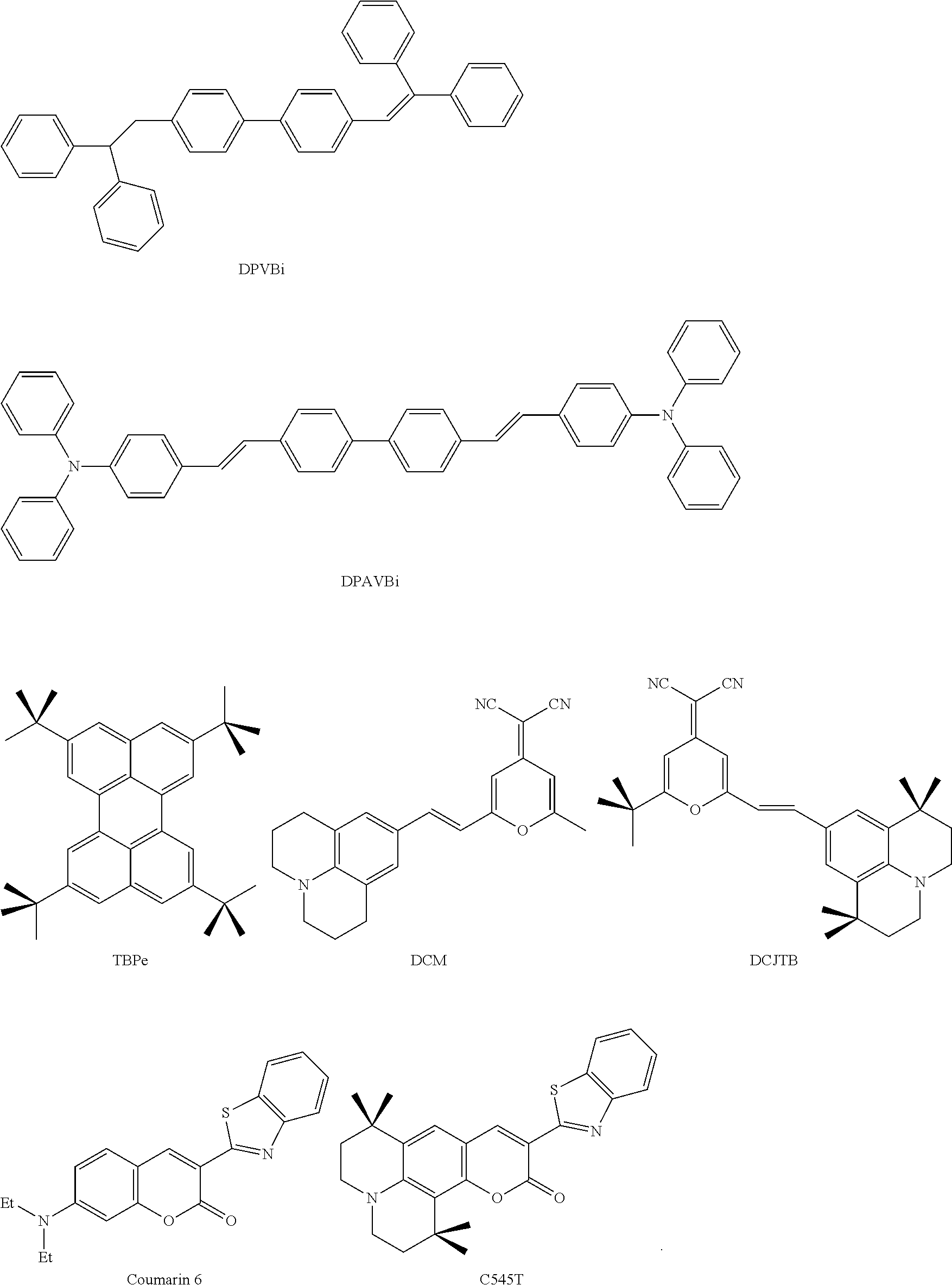
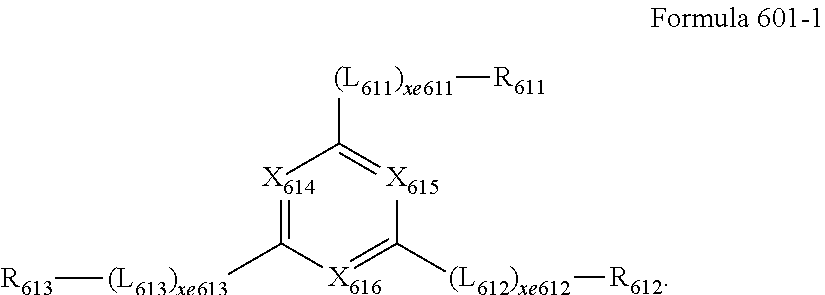







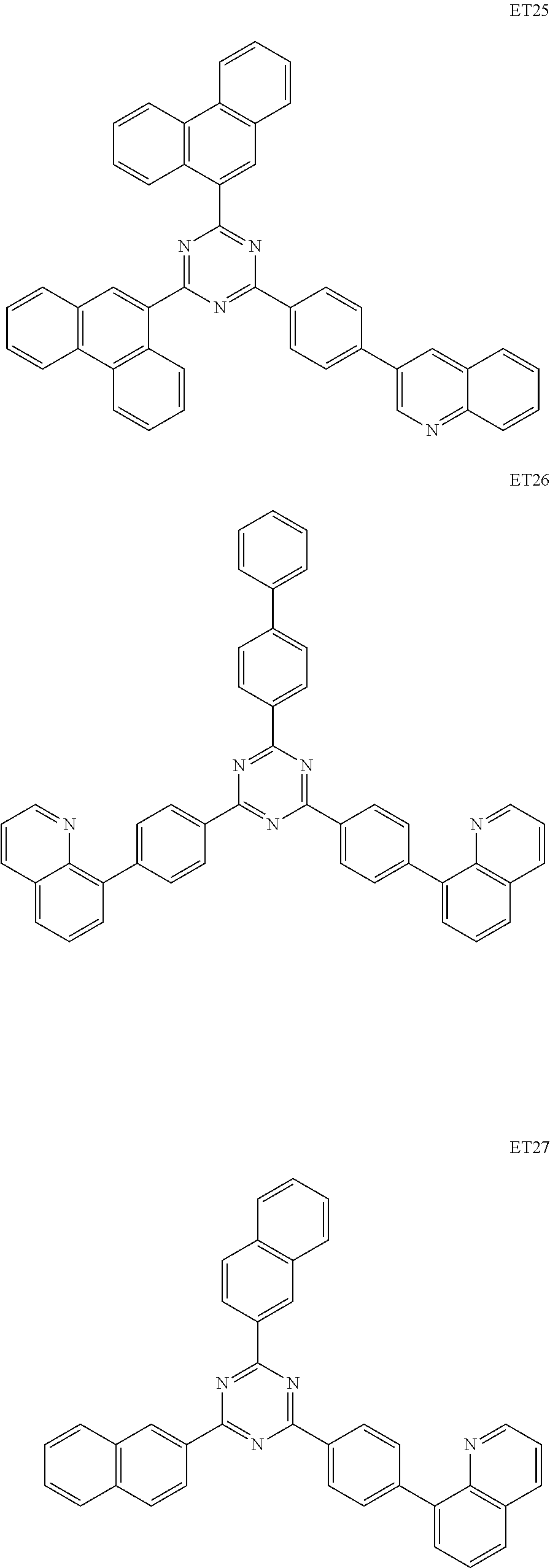

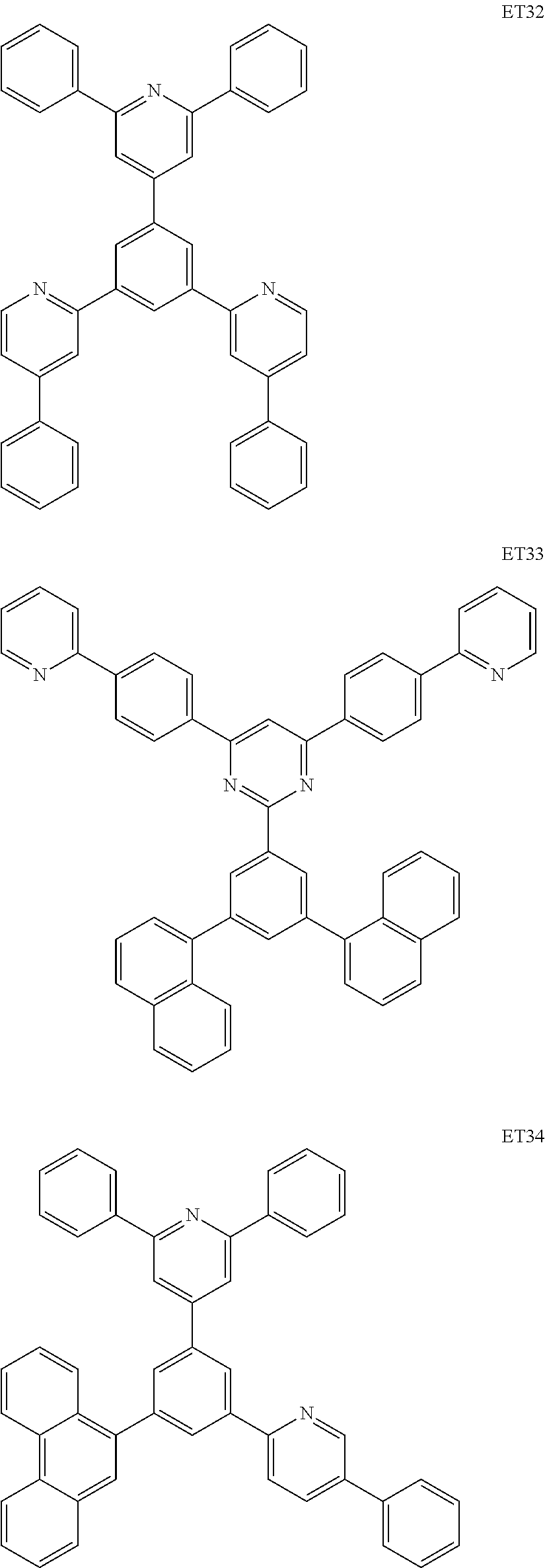
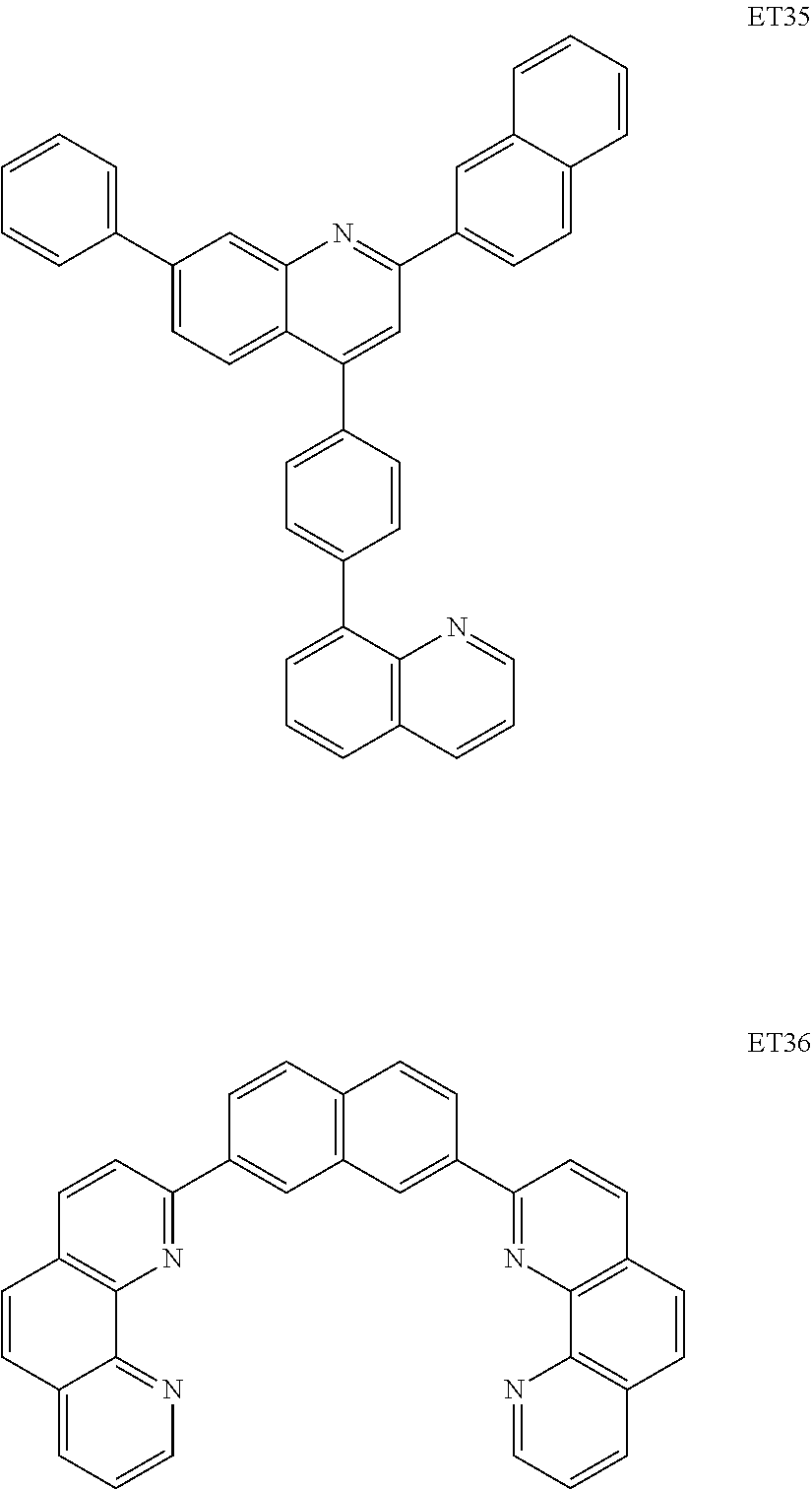

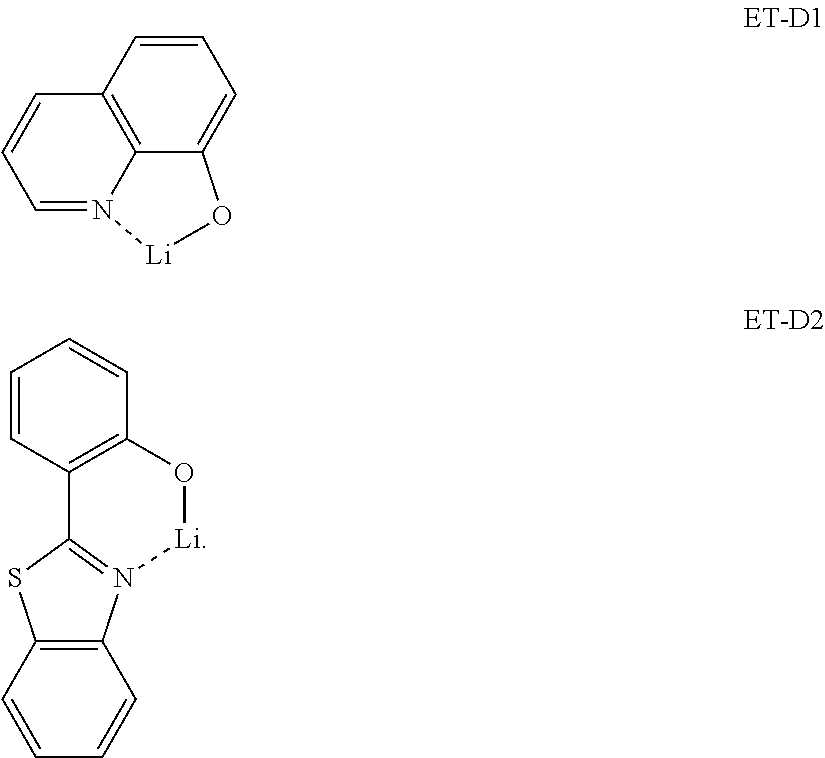

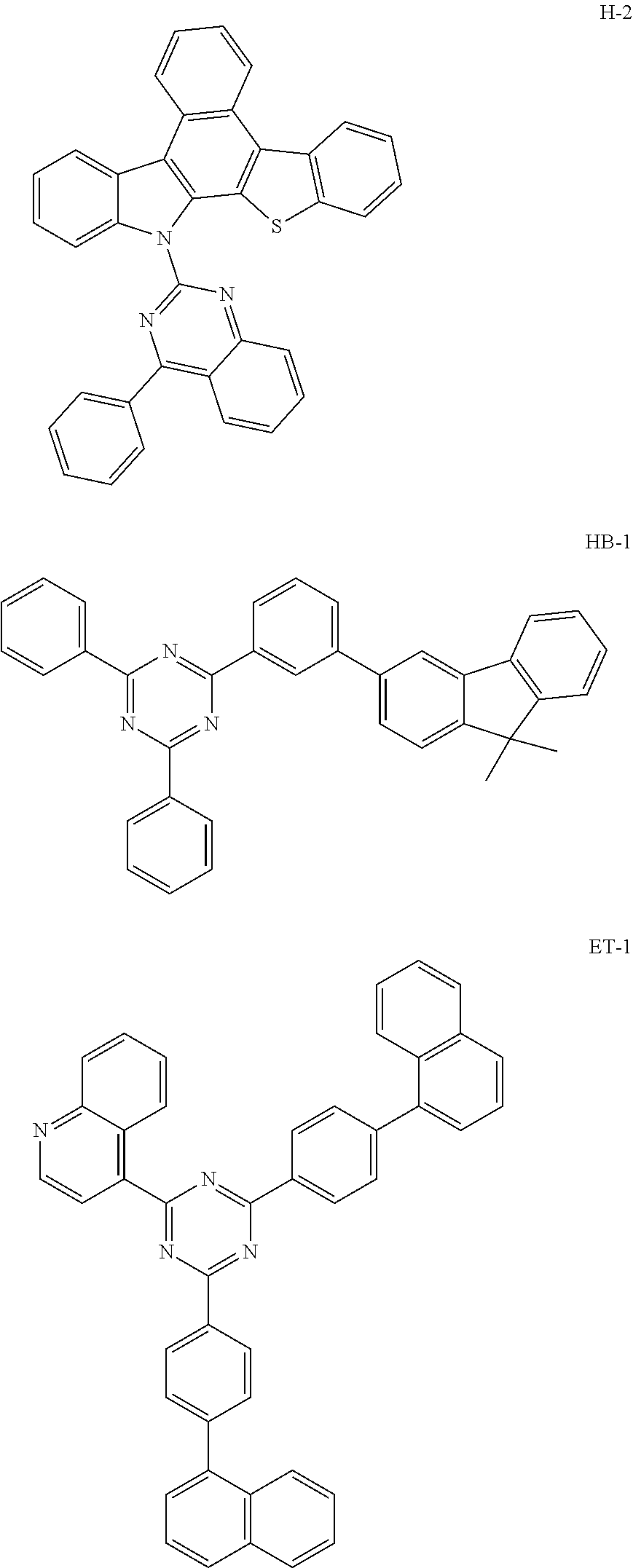
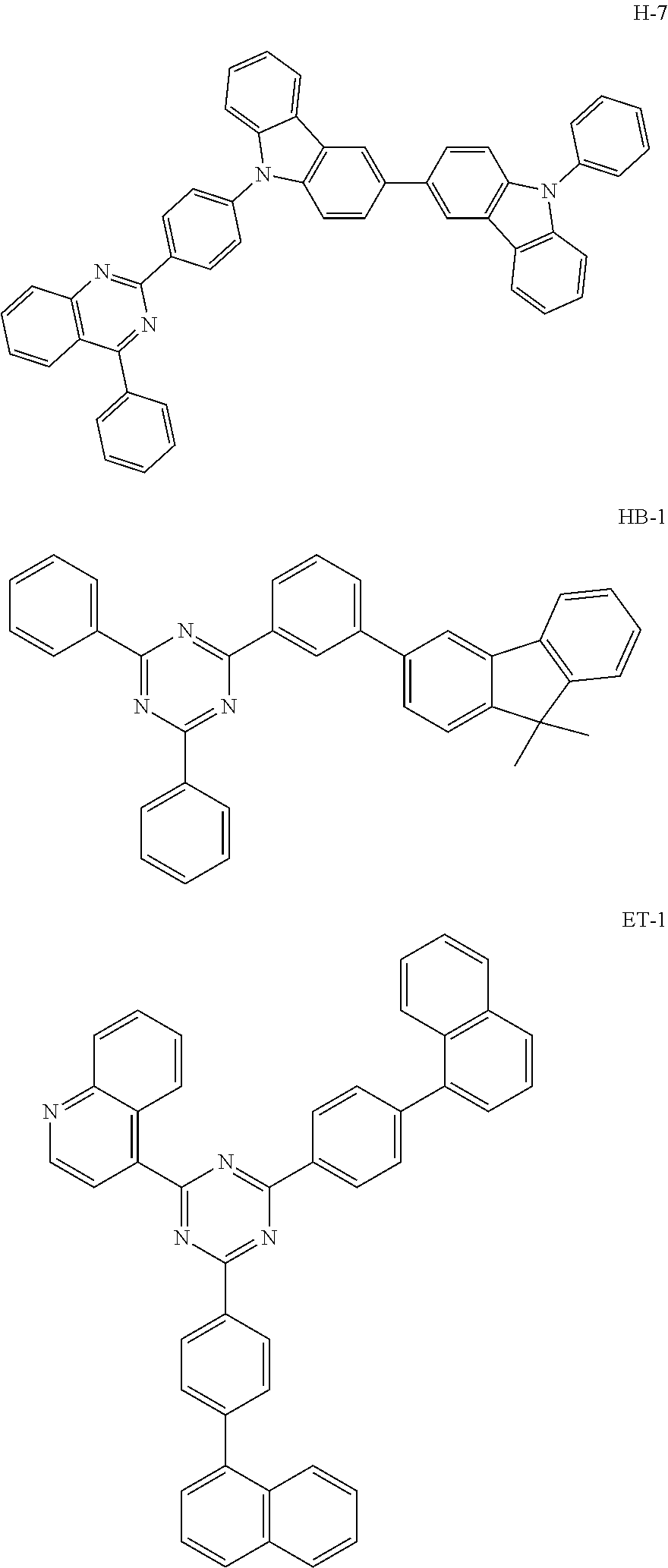

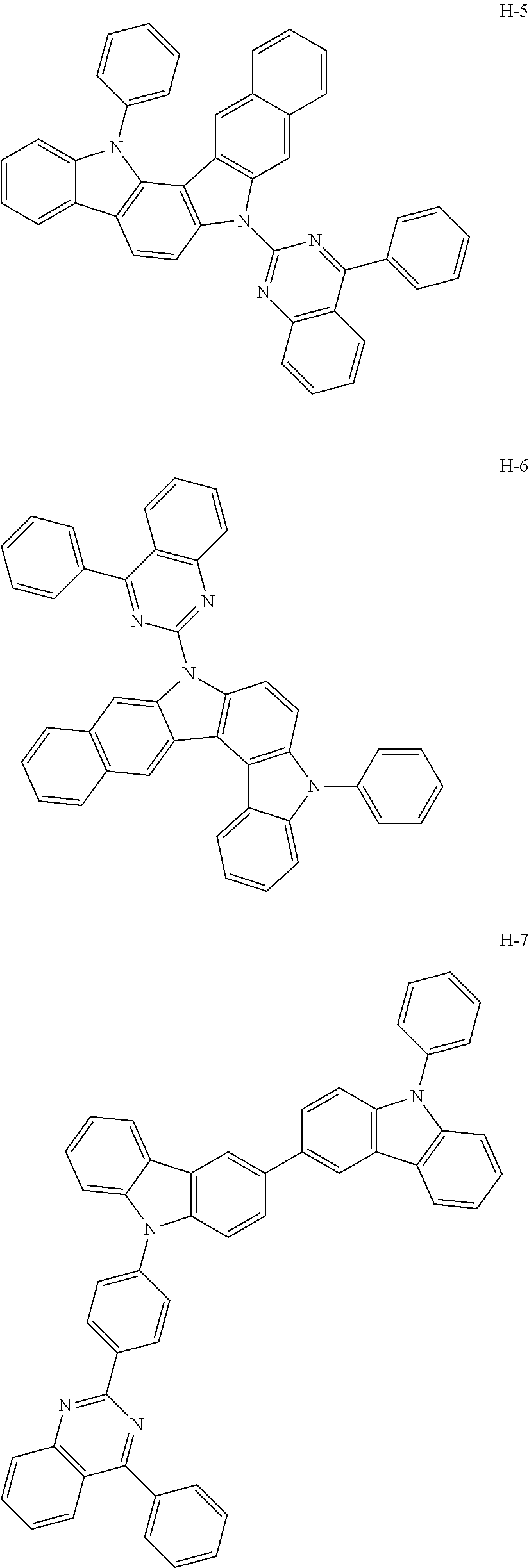



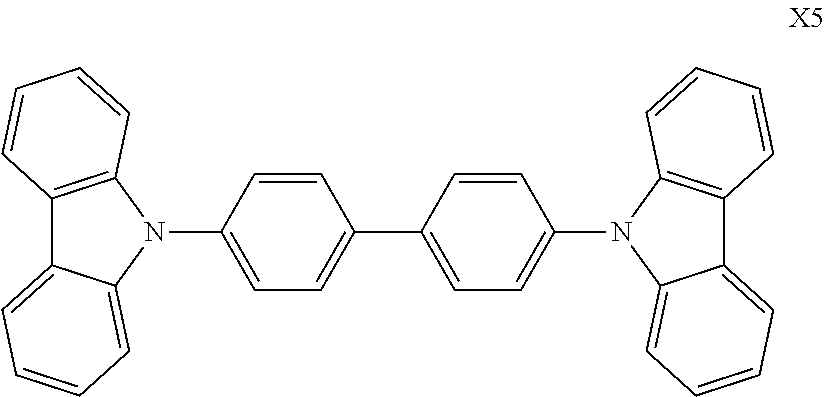
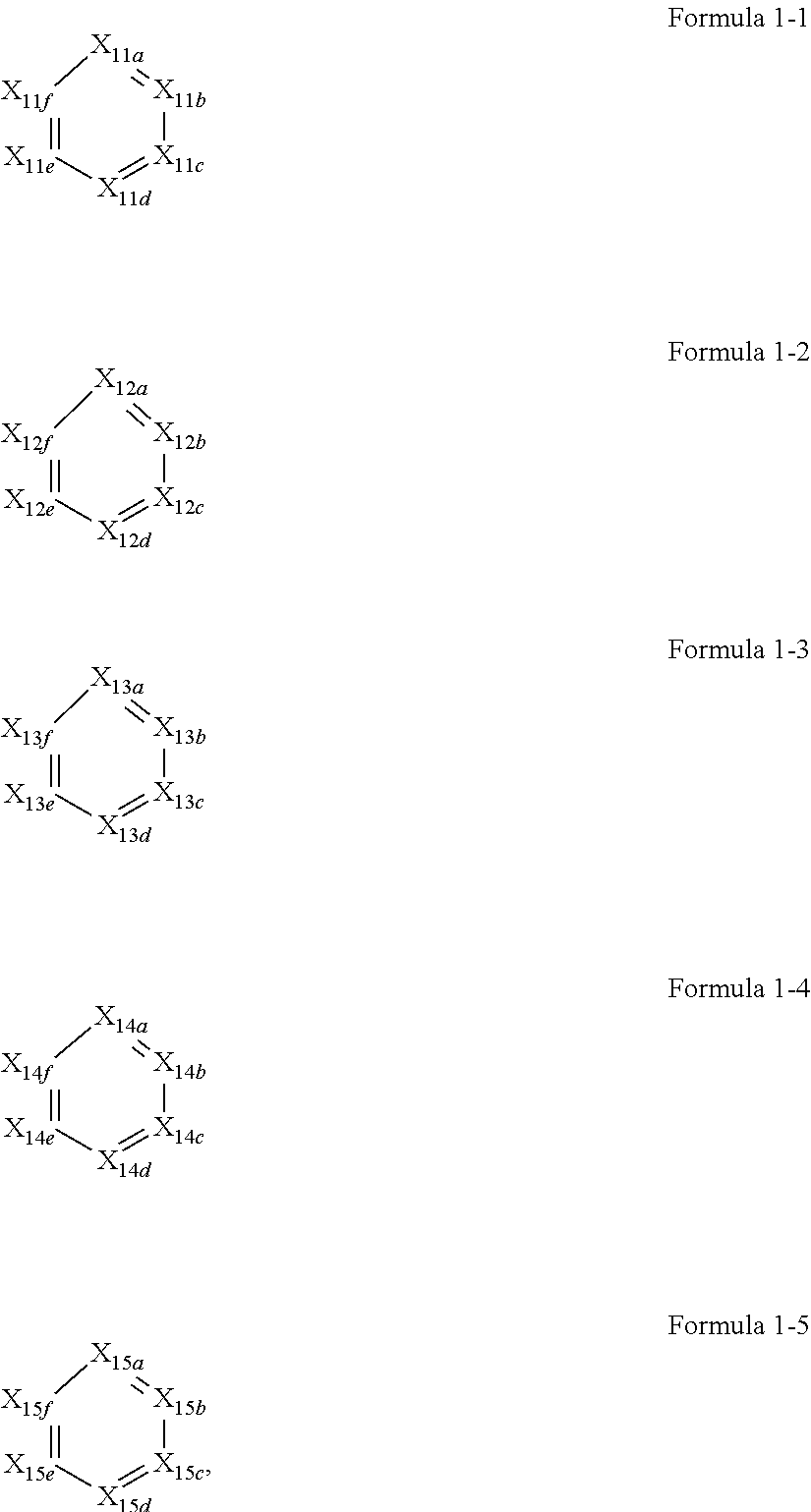


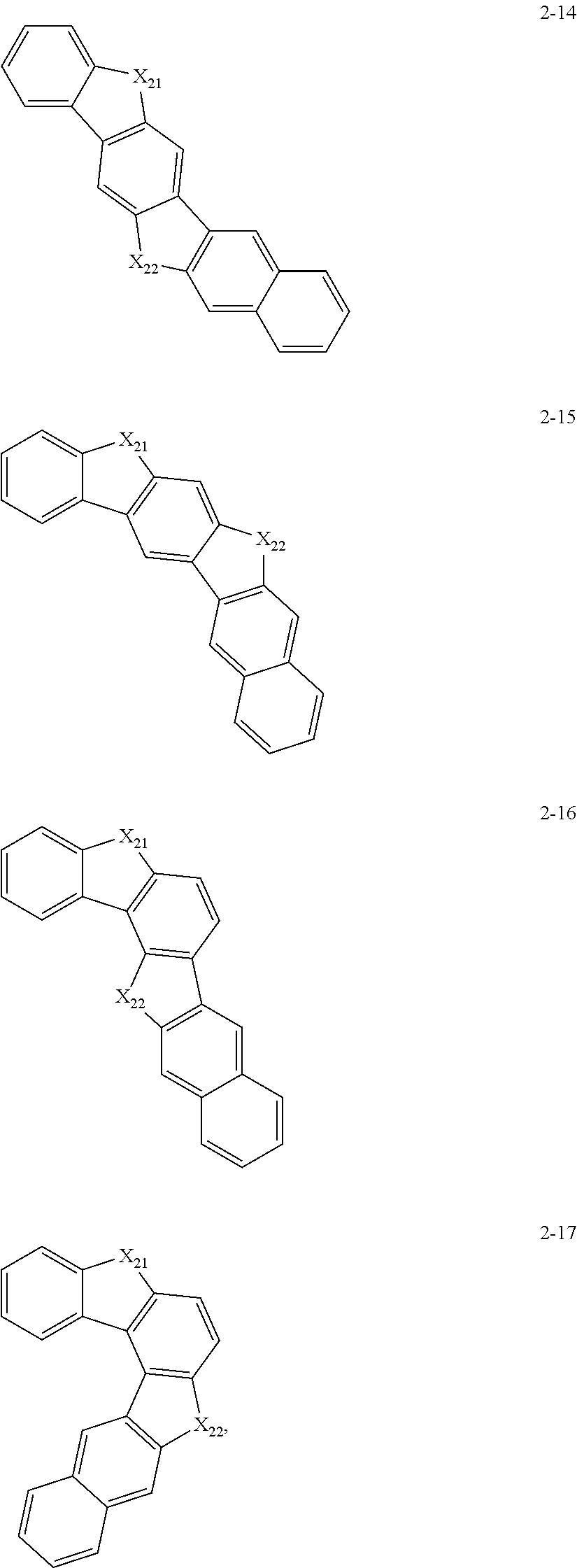


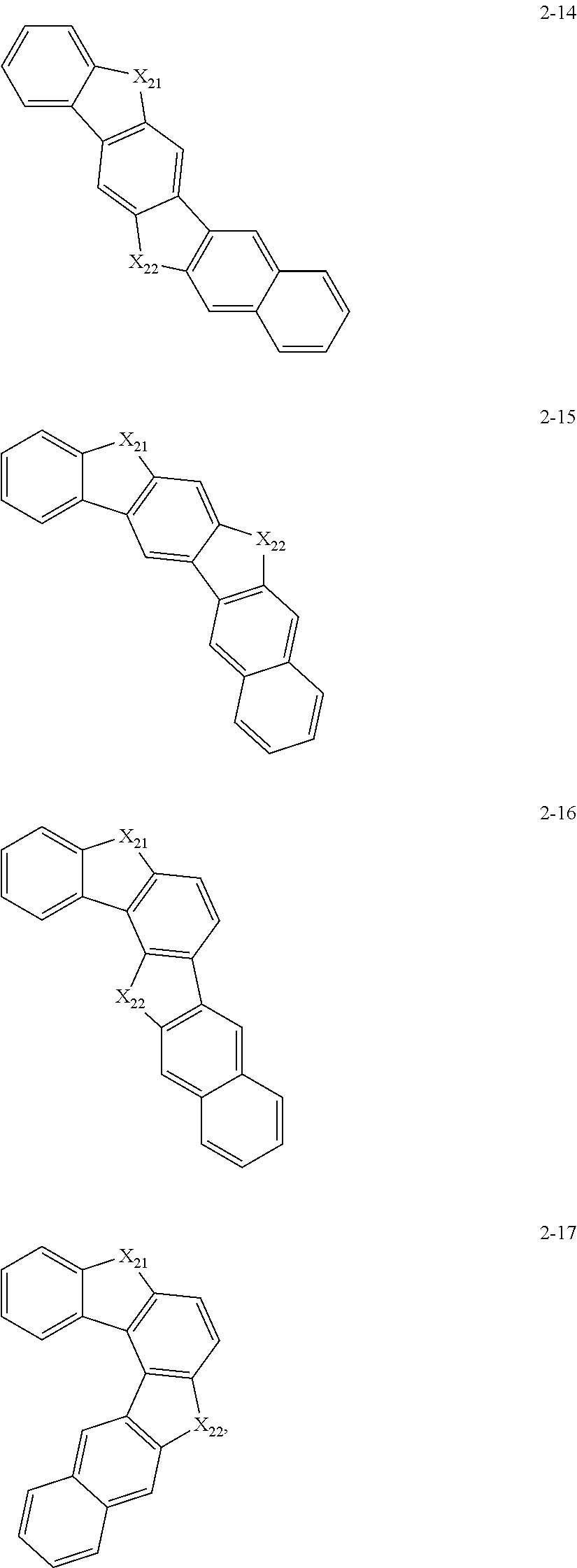

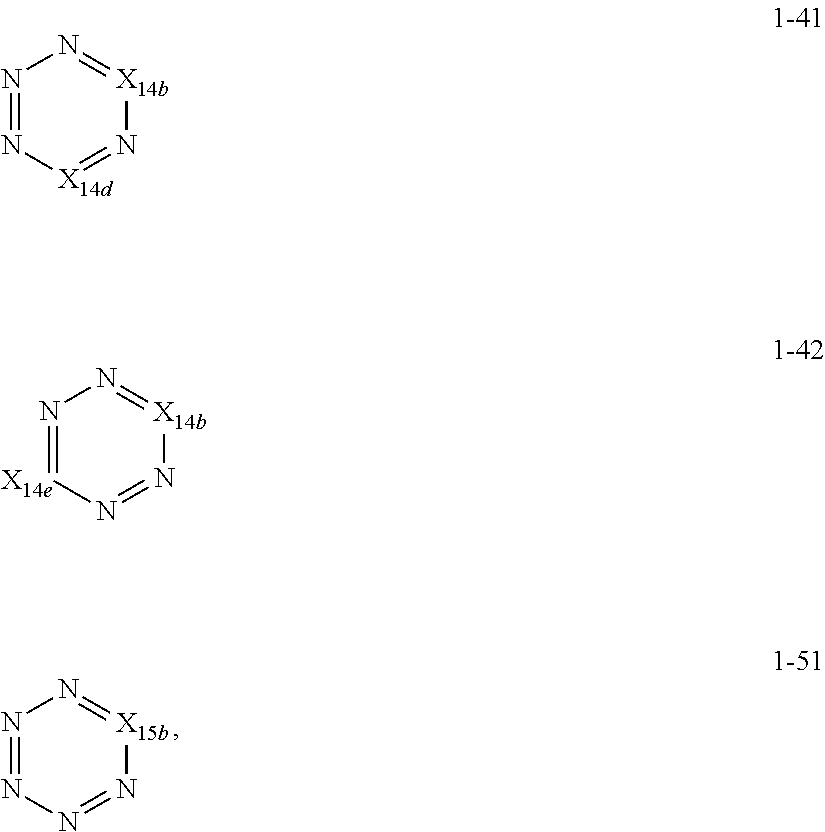


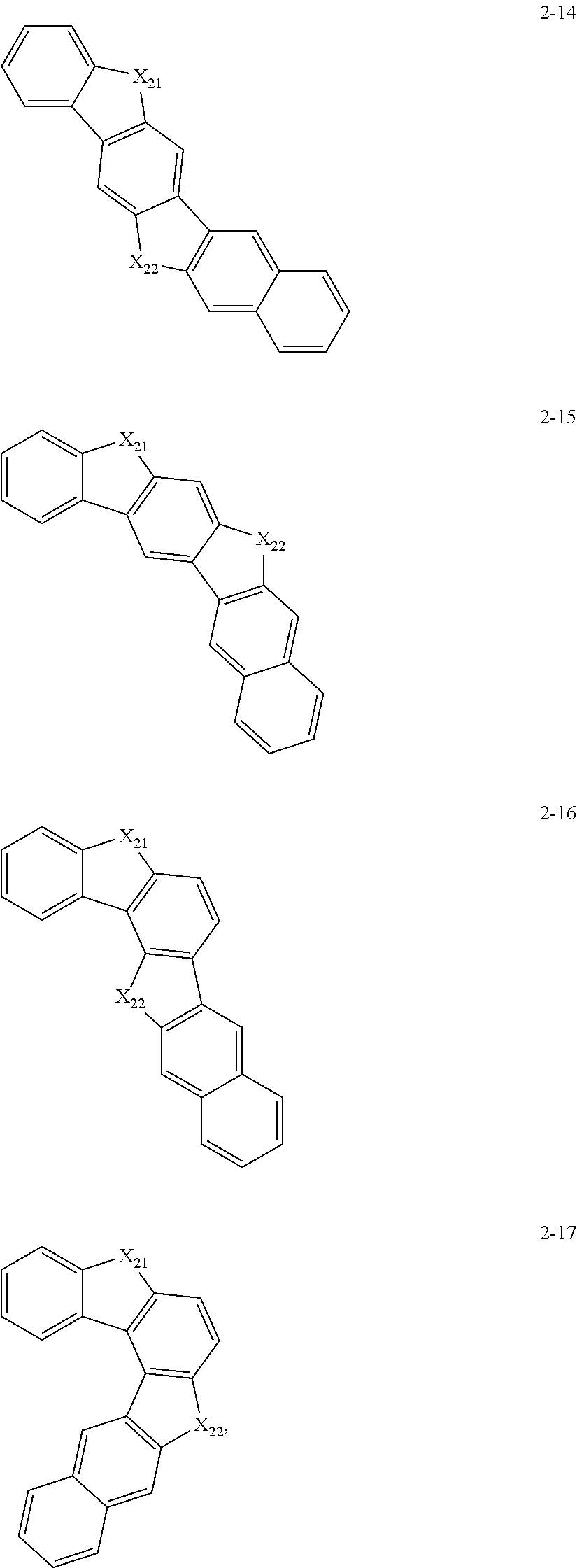

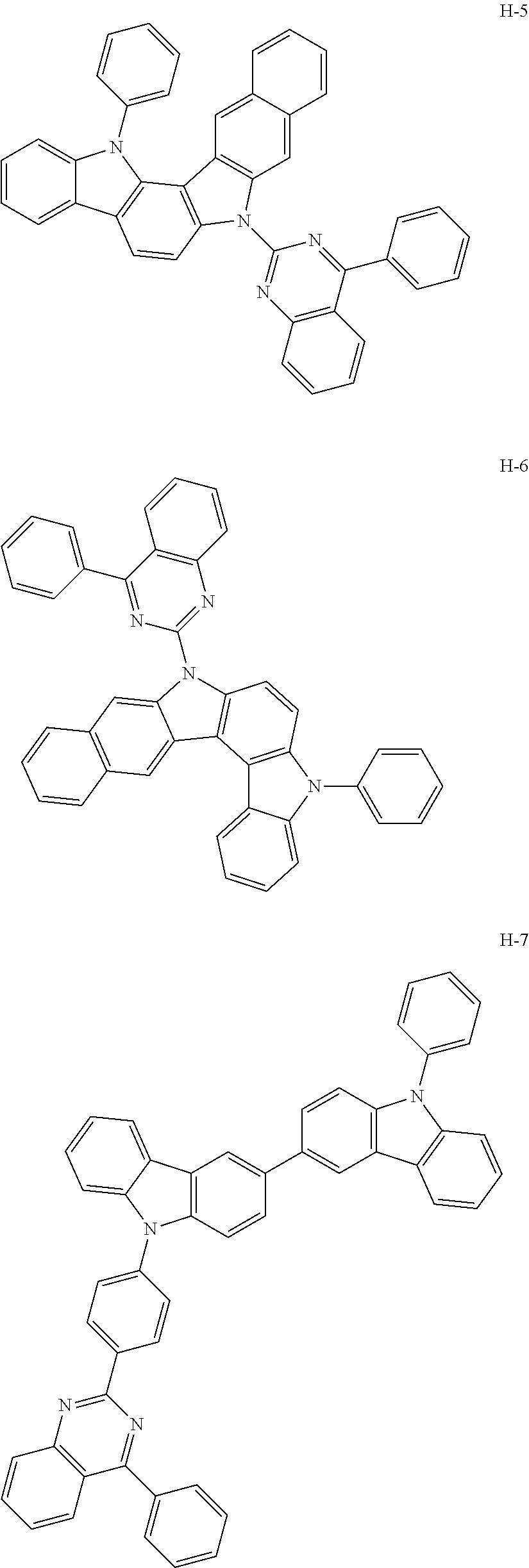


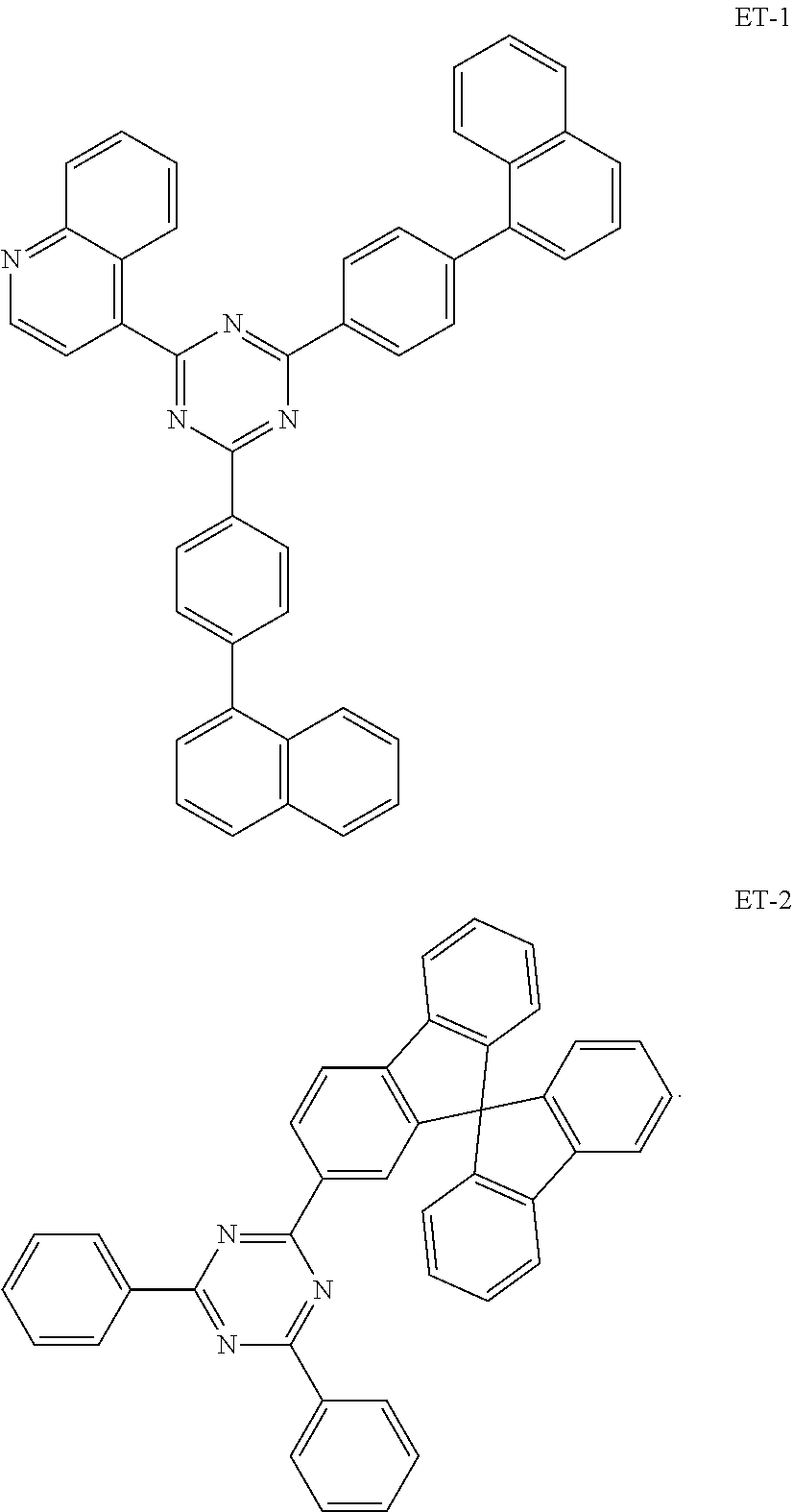
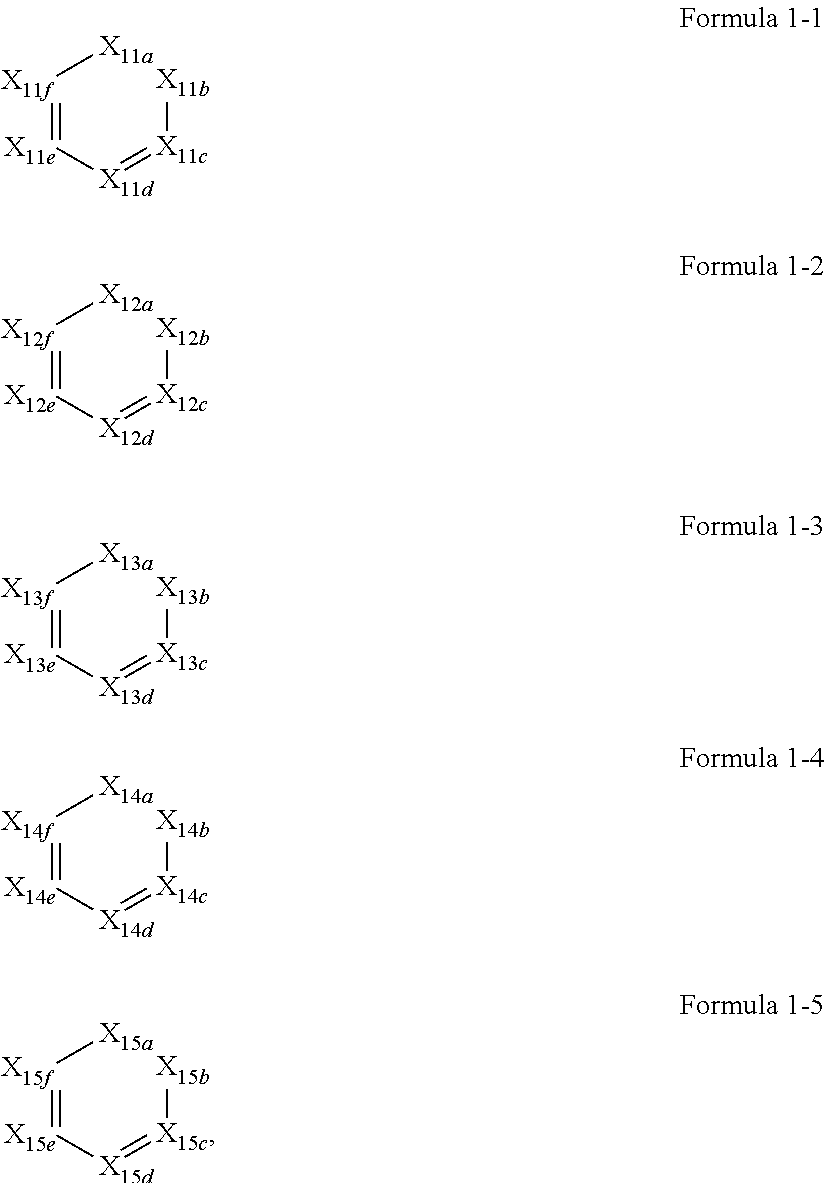
D00000
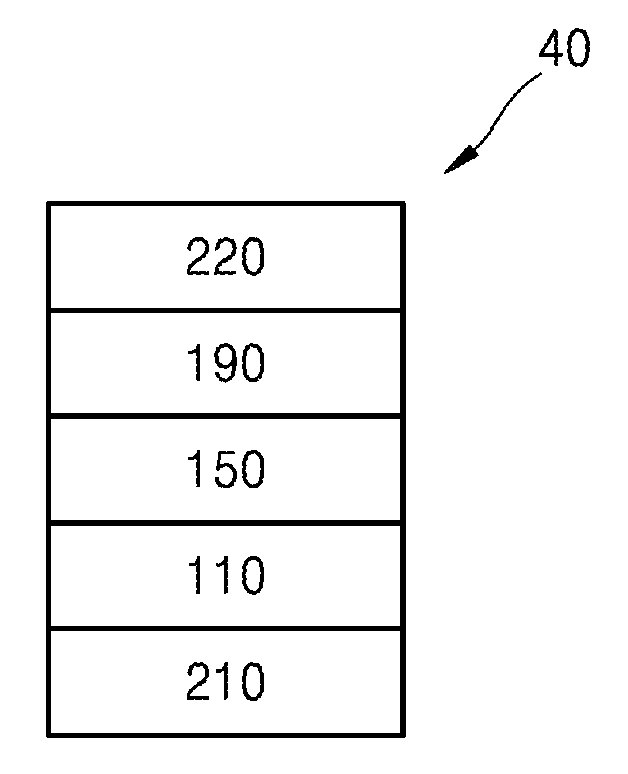
D00001

D00002

XML
uspto.report is an independent third-party trademark research tool that is not affiliated, endorsed, or sponsored by the United States Patent and Trademark Office (USPTO) or any other governmental organization. The information provided by uspto.report is based on publicly available data at the time of writing and is intended for informational purposes only.
While we strive to provide accurate and up-to-date information, we do not guarantee the accuracy, completeness, reliability, or suitability of the information displayed on this site. The use of this site is at your own risk. Any reliance you place on such information is therefore strictly at your own risk.
All official trademark data, including owner information, should be verified by visiting the official USPTO website at www.uspto.gov. This site is not intended to replace professional legal advice and should not be used as a substitute for consulting with a legal professional who is knowledgeable about trademark law.